接着 Tomcat 源码解析一容器加载-大寂灭指(上),我们继续分析 。
再来看fixDocBase()方法的另外一种情况。

那什么时候会进入上图中箭头指向的代码呢?

我相信此时再来理解,就方便了。但是看到这里,大家有没有发现一个小问题,假如就按上图的配置,HelloServlet的doGet()方法中打印张三。
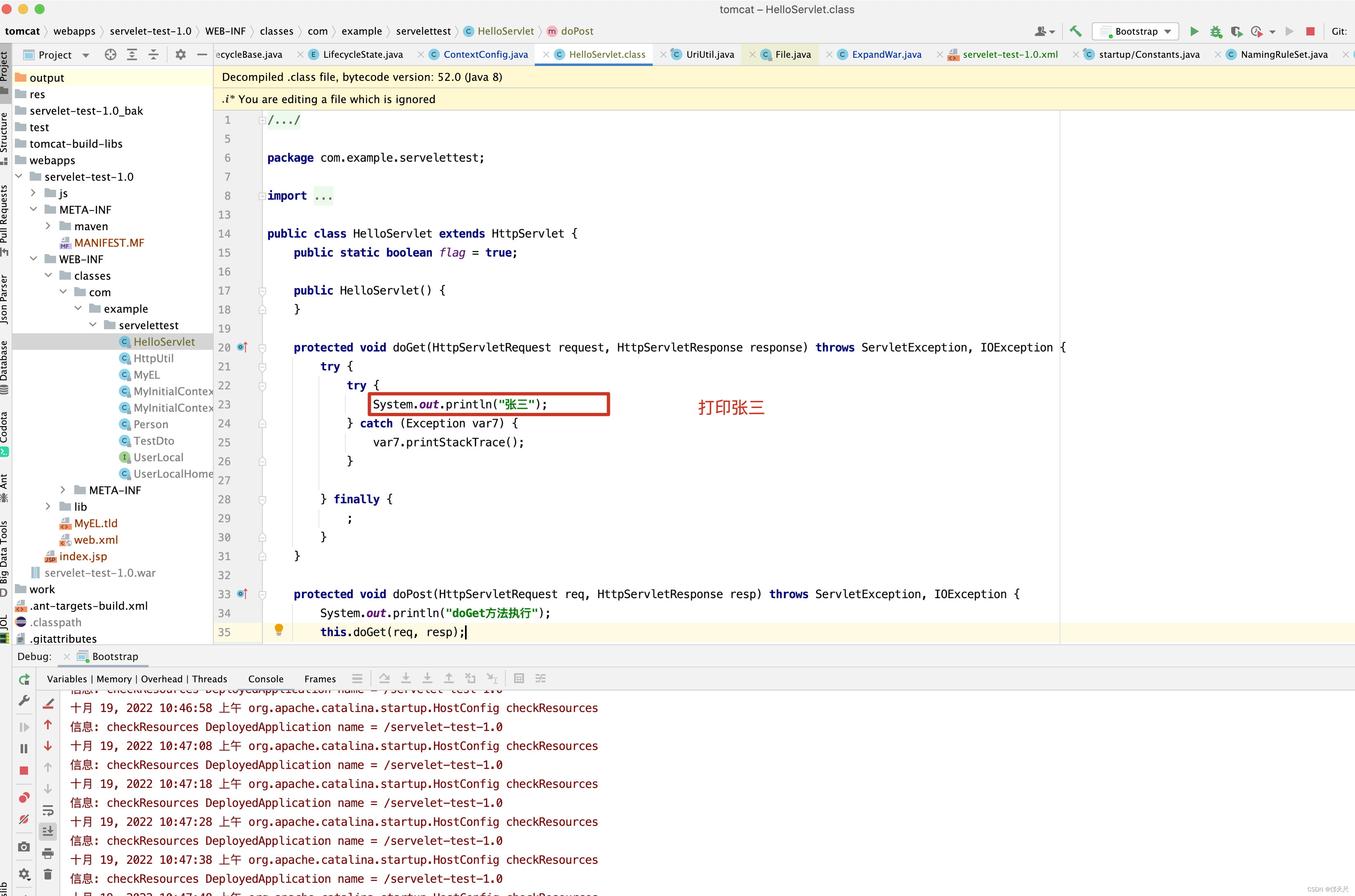
此时在代码中将张三改成李四。
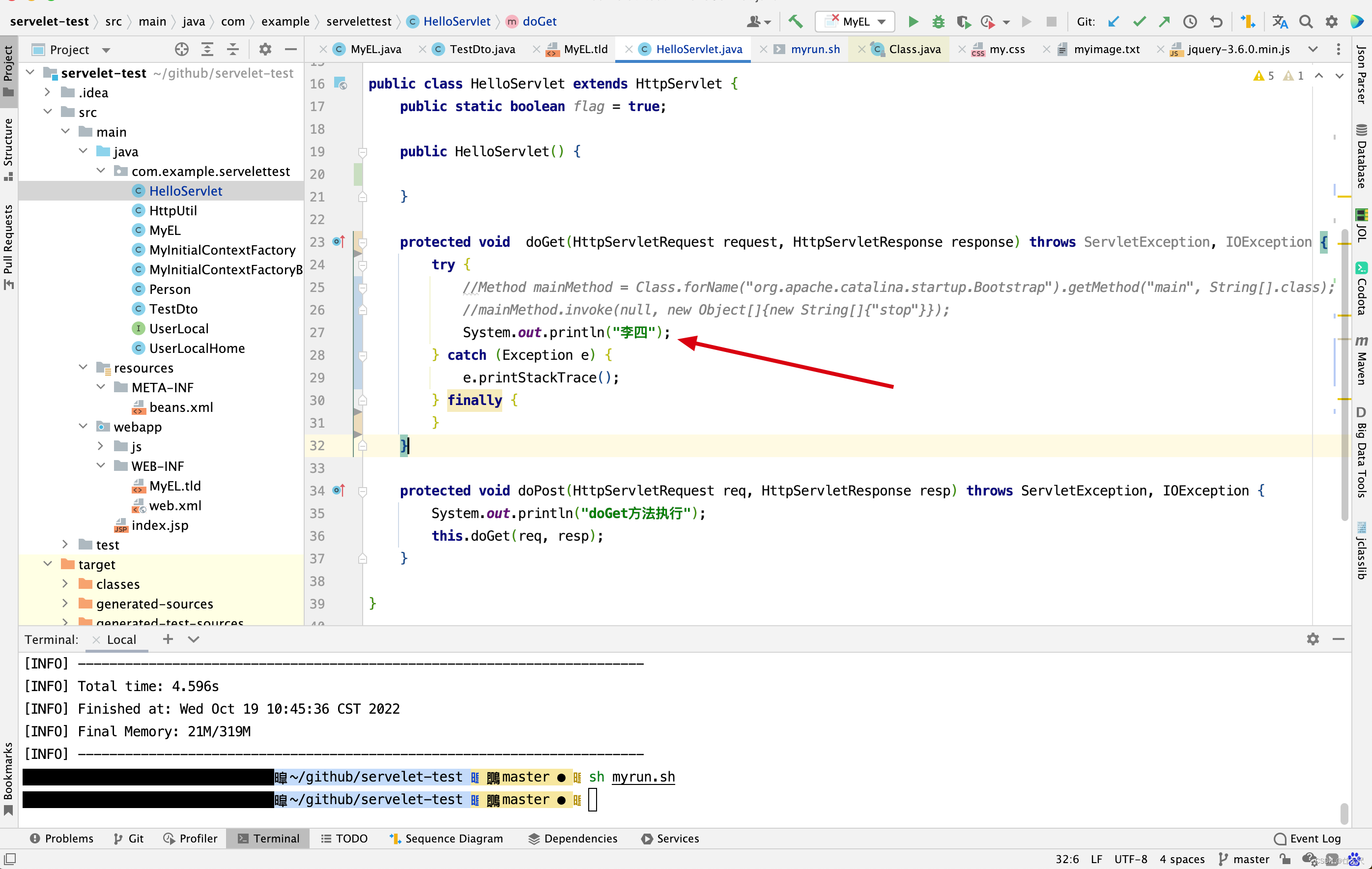
停止tomcat,再将catalina.base/webapps/下的war给替换掉,再启动tomcat。
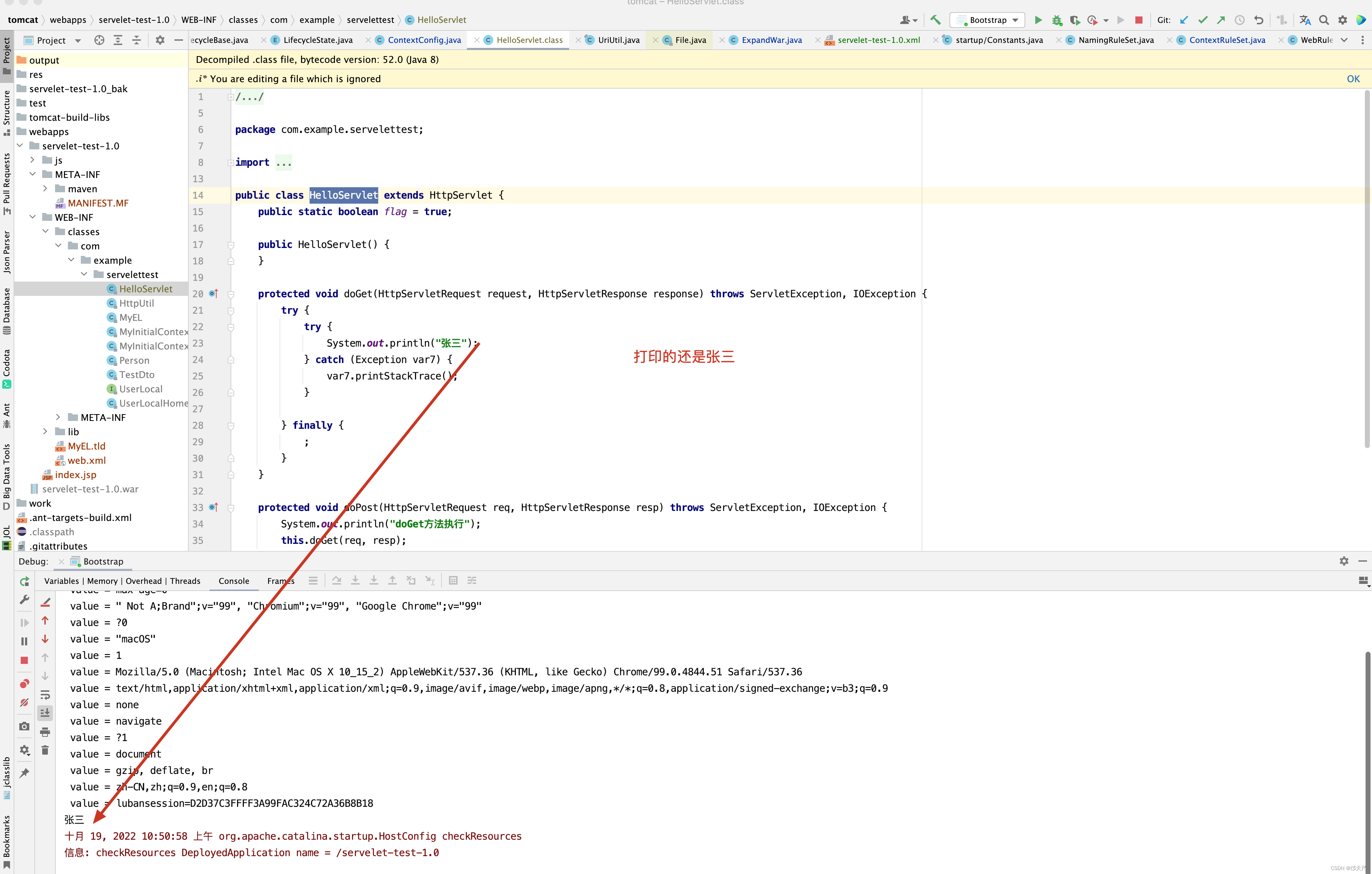
打印的还是张三,发现原因没有,就是fixDocBase()方法中的else逻辑判断,如果catalina.base/conf/[EngineName]/[HostName]/[ContextName].xml指向的<Context/> 标签指向的是一个目录,而非war包,此时如果目录存在,则不会再去解压war包了,因此在布署项目时,尽量将war包对应的目录给删除掉,再替换掉原来的war包。 当然有小伙伴可能也会发现奇怪的现象,比如先将war包给替换掉,过一会再停掉tomcat,再启动tomcat,发现新的war包生效,这是为什么呢?原因在于tomcat热布署,当tomcat检测到war包的最后修改时间不是系统之前存储的时候,证明war被修改了,此时,后台会删除掉原来的目录,再重新布署war包,因此你会发现,有个时候,不删除war包对应的目录,新代码依然生效。建议尽量不要这么做,如果热布署代码每隔10秒就运行一次,但是还没有等到热布署代码运行,此时你就将tomcat给停掉了,新代码依然不会生效。
有人会想,如果指向的是一个war包,而不是一个目录时,会不会就自动解压了呢?遗憾的告诉你,也不行,tomcat为了提升性能,当检测到目录已经存在,则不进行解压操作。
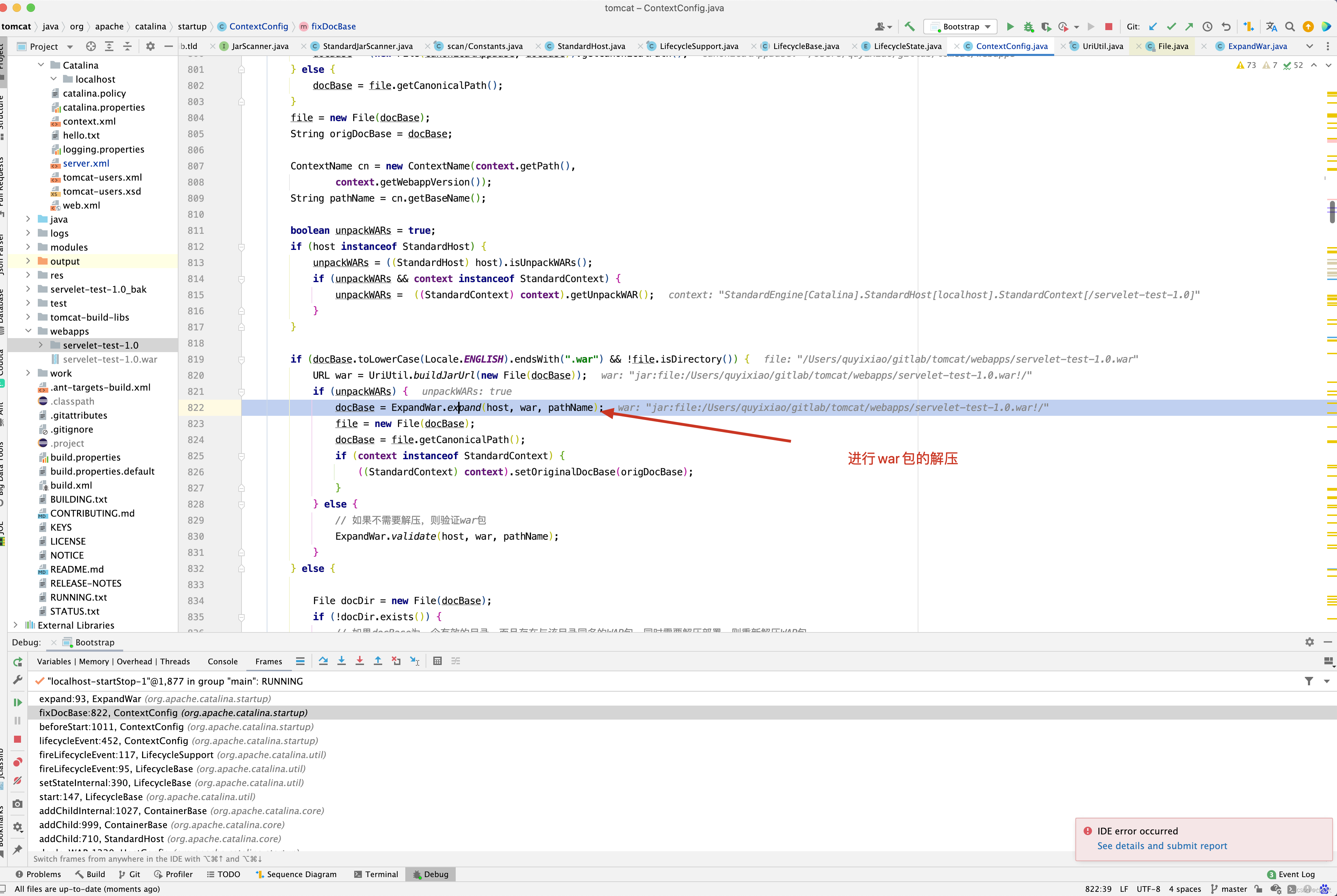
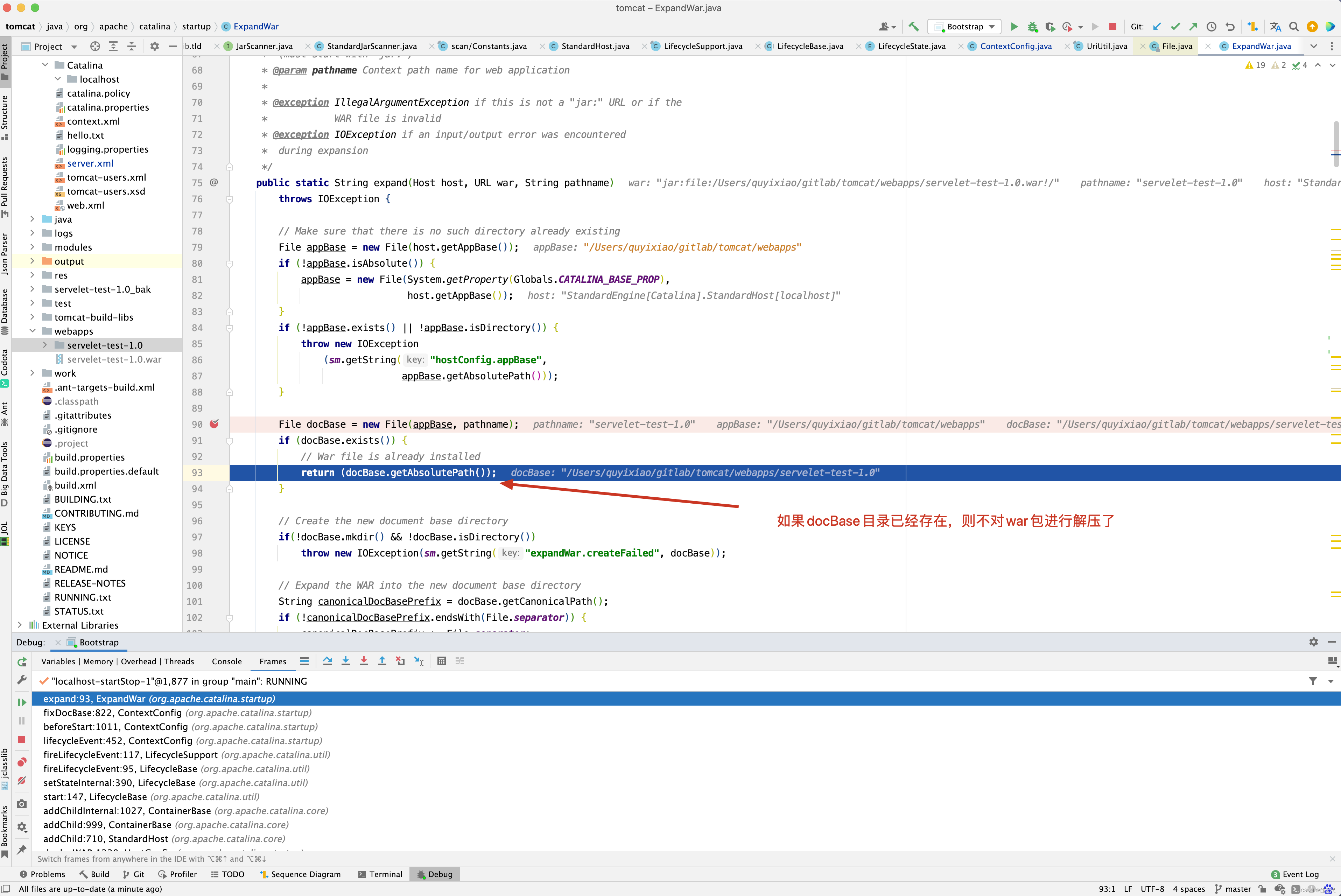
所以建议在进行WAR包重新布署时,将WAR包对应的目录删除掉吧。
接下来看antiLocking()方法的实现。
【背景】Tomcat应用更新时,把新的WAR包放到webapps目录下,Tomcat就会自动把原来的同名webapp删除,并把WAR包解压,运行新的 webapps。
但是,有时候Tomcat并不能把旧的webapp完全删除,通常会留下WEB-INF/lib下的某个jar包,必须关闭Tomcat才能删除,这就导致自动部署失败。将Web应用项目根据部署次数重命名并复制到%CATALIN_HOME%/temp临时目录下(例如第一次部署就是1-myTomcat.war),并把Context对象的docBase 指向临时目录下的Web项目,这样每次重新热部署都有一个新的应用名, 就算原来应用的某些Jar包被锁定也不会导致部署失败。具体解决方法是在元素中增加一个属性antiResourceLocking=“true” antiJARLocking=“true”,默认是"false"。这样就可以热部署了。
protected void antiLocking() { if ((context instanceof StandardContext) // 当Context的antiResourceLocking属性为true时,Tomcat会将当前的Web应用目录复制到临时文件夹下,以避免对原目录资源加锁。 && ((StandardContext) context).getAntiResourceLocking()) { // 1 根据Host的appBase以及Context 的docBase计算docBase的绝对路径 Host host = (Host) context.getParent(); String appBase = host.getAppBase(); String docBase = context.getDocBase(); if (docBase == null) return; originalDocBase = docBase; File docBaseFile = new File(docBase); if (!docBaseFile.isAbsolute()) { File file = new File(appBase); if (!file.isAbsolute()) { file = new File(getBaseDir(), appBase); } docBaseFile = new File(file, docBase); } String path = context.getPath(); if (path == null) { return; } ContextName cn = new ContextName(path, context.getWebappVersion()); docBase = cn.getBaseName(); // 2. 计算临时文件夹的Web应用根目录或WAR包名 // 2.1 Web目录:${Context生命周期内的部署次数}-${目录名} // 2.2 WAR包:${Context生命周期内部署次数}-${WAR包名} if (originalDocBase.toLowerCase(Locale.ENGLISH).endsWith(".war")) { antiLockingDocBase = new File( System.getProperty("java.io.tmpdir"), deploymentCount++ + "-" + docBase + ".war"); } else { antiLockingDocBase = new File( System.getProperty("java.io.tmpdir"), deploymentCount++ + "-" + docBase); } antiLockingDocBase = antiLockingDocBase.getAbsoluteFile(); if (log.isDebugEnabled()) log.debug("Anti locking context[" + context.getName() + "] setting docBase to " + antiLockingDocBase.getPath()); // Cleanup just in case an old deployment is lying around ExpandWar.delete(antiLockingDocBase); // 3. 复制Web目录或者WAR包到临时目录 if (ExpandWar.copy(docBaseFile, antiLockingDocBase)) { // 4. 将Context 的docBase更新为临时目录下的Web应用目录或者WAR包路径 context.setDocBase(antiLockingDocBase.getPath()); } // 通过上面的讲解我们知道,无论是AFTER_INIT_EVNT还是BEFORE_START_EVENT处理,仍然属于启动前准备工作,以确保Context // 相关属性的准确性,而真正创建Wrapper的则是CONFIGURE_START_EVENT事件 } }
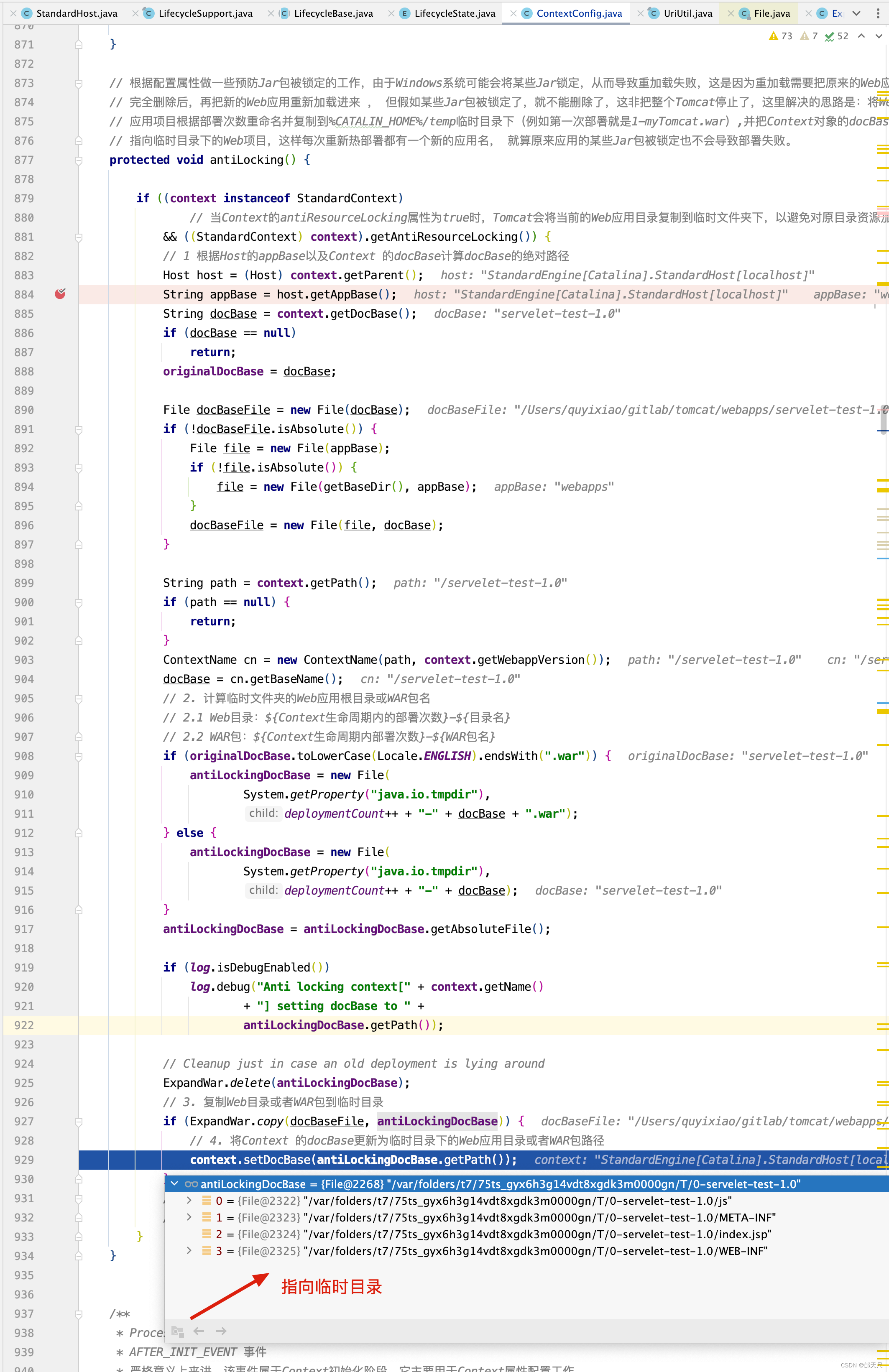
将目录拷贝到/var/folders/t7/75ts_gyx6h3g14vdt8xgdk3m0000gn/T临时目录下,当然每次热布署后。

当antiResourceLocking设置为true的时候,Tomcat不会锁定应用下的任何文件。那Tomcat是怎么做到这一点的呢?
在Tomcat的架构里,应用也是一个级别的容器,对应的接口是Context;各级容器本身都具备生命周期,而且配置了多个生命周期监听器来监听容器不同的生命周期过程。Tomcat在初始化的时候,给Context增加了一个生命周期监听器org.apache.catalina.startup.ContextConfig;然后在Context真正开始启动之前,会有一个BEFORE_START_EVENT状态,ContextConfig监听到这个状态的事件后,就会针对antiResourceLocking进行处理。
总结一下,就是如果应用的antiResourceLocking属性设置为true,就将应用的doc base移到临时目录下,让Tomca不会占用webapps下的文件。Tomcat里java.io.tmpdir默认指向Tomcat的temp目录。
【副作用】
从上面的分析来看,antiResourceLocking为true有几个副作用:
- 会延长应用的启动时间,因为多了临时目录的清理和往临时目录拷贝应用内容的操作;a
- 如果不知道这个属性的原理,修改webapps下应用的JSP,那就不会动态重加载到新的页面内容了,因为应用的doc base已经不再在webapps下了;
- 停止Tomcat的时候,临时目录下实际的doc base会被删掉,
结合第二条和第三条,如果要修改应用的JSP,那必须将改动同时拷贝到两个目录下(原始doc base和临时目录下的doc base)。
所以Tomcat里这个属性缺省为false。在使用Tomcat 6.0.24之前的版本时,如果要用这个属性解决文件被锁的问题,三思而行。

before_start事件触发了ContextConfig的beforeStart()方法调用,已经分析完了,接下来进入StandardContext的startInternal()方法 。
protected synchronized void startInternal() throws LifecycleException {
if(log.isDebugEnabled())
log.debug("Starting " + getBaseName());
// Send j2ee.state.starting notification
if (this.getObjectName() != null) {
Notification notification = new Notification("j2ee.state.starting",
this.getObjectName(), sequenceNumber.getAndIncrement());
broadcaster.sendNotification(notification);
}
setConfigured(false);
boolean ok = true;
// Currently this is effectively a NO-OP but needs to be called to
// ensure the NamingResources follows the correct lifecycle
if (namingResources != null) {
namingResources.start();
}
// Add missing components as necessary
if (webappResources == null) { // (1) Required by Loader
if (log.isDebugEnabled())
log.debug("Configuring default Resources");
try {
// 设置Context的资源
// 赋值webappResources属性
// docBase地址
String docBase = getDocBase();
if (docBase == null) {
setResources(new EmptyDirContext());
} else if (docBase.endsWith(".war")
&& !(new File(getBasePath())).isDirectory()) {
// war包
setResources(new WARDirContext());
} else {
// 文件目录, WARDirContext处理不同的是 ,WARDirContext 需要对.war 包进行解压,然后才能获取对应的文件内容,而FileDir可以直接获取文件内容
setResources(new FileDirContext());
}
} catch (IllegalArgumentException e) {
log.error(sm.getString("standardContext.resourcesInit"), e);
ok = false;
}
}
if (ok) {
// 关于resouce资源设置这一块的代码
// tomcat为什么这样做,这涉及到Tomcat的jndi相关的内容了。
// 之前写了一篇博客tomcat 关于jndi的源码 。Tomcat 源码解析一JNDI
// 有兴趣可以去看一下
if (!resourcesStart()) {
throw new LifecycleException("Error in resourceStart()");
}
}
// 如果在Context节点下配置了Loader节点,那么就会在解析配置文件的时候就会初始化Loader,比如:
// <Context path="/ServletDemo" docBase="C:\Users\周瑜\IdeaProjects\ServletDemo\target\ServletDemo" addWebinfClassesResources="true">
// <Loader/>
// </Context>
// 如果没有配,则生成一个WebappLoader
if (getLoader() == null) {
// Webapp类加载器的父类加载器为Host的ParentClassLoader,最终就是Catalina类的类加载器,其实就是CommonClassLoader
WebappLoader webappLoader = new WebappLoader(getParentClassLoader());
webappLoader.setDelegate(getDelegate());
setLoader(webappLoader);
}
// Initialize character set mapper
// 设置CharsetMapper,CharsetMapperDefault.properties
// 如果StandardContext没有,则反射创建一个org.apache.catalina.util.CharsetMapper对象
getCharsetMapper();
// Post work directory
// 创建work目录,比如work\Catalina\localhost\ServletDemo
postWorkDirectory();
// Validate required extensions
boolean dependencyCheck = true;
try {
// 验证MANIFEST.MF文件是否正确
dependencyCheck = ExtensionValidator.validateApplication
(getResources(), this);
} catch (IOException ioe) {
log.error(sm.getString("standardContext.extensionValidationError"), ioe);
dependencyCheck = false;
}
if (!dependencyCheck) {
// do not make application available if dependency check fails
ok = false;
}
// Reading the "catalina.useNaming" environment variable
String useNamingProperty = System.getProperty("catalina.useNaming");
if ((useNamingProperty != null)
&& (useNamingProperty.equals("false"))) {
useNaming = false;
}
// 添加NamingContextListener 监听器
if (ok && isUseNaming()) {
if (getNamingContextListener() == null) {
// NamingContextListener 监听器在Context 容器启动时(startInternal()方法)时添加
// 实际上,Tomcat 要完成命名目录接口需要另外一个NamingContextListener 监听器组件协同,这两个组件都属于Context 容器,
// 当Web 应用初始化时,此监听器会创建JNDI 的命名上下文及其资源绑定,以此完成Tomcat 对JNDI的支持。
// 关于NamingContextListener 之前在 Tomcat 源码解析一JNDI 博客中做了详细的分析,这里就不深入了
NamingContextListener ncl = new NamingContextListener();
ncl.setName(getNamingContextName());
ncl.setExceptionOnFailedWrite(getJndiExceptionOnFailedWrite());
addLifecycleListener(ncl);
setNamingContextListener(ncl);
}
}
// Standard container startup
if (log.isDebugEnabled())
log.debug("Processing standard container startup");
// Binding thread
// 将当前线程的类加载器设置为WebClassLoader,记录一下当前线程的classloader
ClassLoader oldCCL = bindThread();
try {
if (ok) {
// Start our subordinate components, if any
Loader loader = getLoaderInternal(); // 获取Context的类加载器
if ((loader != null) && (loader instanceof Lifecycle))
((Lifecycle) loader).start(); // 启动类加载器,包括初始话DirContext
// since the loader just started, the webapp classloader is now
// created.
// By calling unbindThread and bindThread in a row, we setup the
// current Thread CCL to be the webapp classloader
unbindThread(oldCCL);
oldCCL = bindThread();
// Initialize logger again. Other components might have used it
// too early, so it should be reset.
logger = null;
getLogger();
Cluster cluster = getClusterInternal();
if ((cluster != null) && (cluster instanceof Lifecycle))
((Lifecycle) cluster).start();
Realm realm = getRealmInternal();
if ((realm != null) && (realm instanceof Lifecycle))
((Lifecycle) realm).start();
DirContext resources = getResourcesInternal();
if ((resources != null) && (resources instanceof Lifecycle))
((Lifecycle) resources).start();
// Notify our interested LifecycleListeners
// 这里会发布一个CONFIGURE_START_EVENT事件,虽然是事件,但其实并不是异步,ContextConfig会接收到此事件
fireLifecycleEvent
(Lifecycle.CONFIGURE_START_EVENT, null); // web.xml
// Start our child containers, if not already started
// Context下是Wrapper,这些Wrapper是什么时候添加进Context中的?就是上面的CONFIGURE_START_EVENT事件触发的
// 如果Wrapper不可用就启动,默认情况下是已经启动了的。
for (Container child : findChildren()) {
if (!child.getState().isAvailable()) {
child.start();
}
}
// Start the Valves in our pipeline (including the basic),
// if any
// 启动pipeline
if (pipeline instanceof Lifecycle) {
((Lifecycle) pipeline).start();
}
// Acquire clustered manager
Manager contextManager = null;
Manager manager = getManagerInternal();
if (manager == null) {
if (log.isDebugEnabled()) {
log.debug(sm.getString("standardContext.cluster.noManager",
Boolean.valueOf((getCluster() != null)),
Boolean.valueOf(distributable)));
}
if ( (getCluster() != null) && distributable) {
try {
contextManager = getCluster().createManager(getName());
} catch (Exception ex) {
log.error("standardContext.clusterFail", ex);
ok = false;
}
} else {
contextManager = new StandardManager();
}
manager = contextManager;
}
// Configure default manager if none was specified
if (contextManager != null) {
if (log.isDebugEnabled()) {
log.debug(sm.getString("standardContext.manager",
contextManager.getClass().getName()));
}
setManager(contextManager);
}
if (manager!=null && (getCluster() != null) && distributable) {
//let the cluster know that there is a context that is distributable
//and that it has its own manager
getCluster().registerManager(manager);
}
}
} finally {
// Unbinding thread
unbindThread(oldCCL);
}
if (!getConfigured()) {
log.error(sm.getString("standardContext.configurationFail"));
ok = false;
}
// We put the resources into the servlet context
if (ok)
getServletContext().setAttribute
(Globals.RESOURCES_ATTR, getResources());
// Initialize associated mapper
mapper.setContext(getPath(), welcomeFiles, getResources());
// Binding thread
oldCCL = bindThread();
if (ok ) {
if (getInstanceManager() == null) {
javax.naming.Context context = null;
if (isUseNaming() && getNamingContextListener() != null) {
context = getNamingContextListener().getEnvContext();
}
Map<String, Map<String, String>> injectionMap = buildInjectionMap(
getIgnoreAnnotations() ? new NamingResources(): getNamingResources());
setInstanceManager(new DefaultInstanceManager(context,
injectionMap, this, this.getClass().getClassLoader()));
getServletContext().setAttribute(
InstanceManager.class.getName(), getInstanceManager());
}
}
try {
// Create context attributes that will be required
if (ok) {
getServletContext().setAttribute(
JarScanner.class.getName(), getJarScanner());
}
// Set up the context init params
mergeParameters();
// Call ServletContainerInitializers
for (Map.Entry<ServletContainerInitializer, Set<Class<?>>> entry :
initializers.entrySet()) {
try {
// Context容器启动时就会分别调用每个ServletContainerInitializer的onStartup()方法,将感兴趣的类作为参数传入
entry.getKey().onStartup(entry.getValue(),
getServletContext());
} catch (ServletException e) {
log.error(sm.getString("standardContext.sciFail"), e);
ok = false;
break;
}
}
// Configure and call application event listeners
if (ok) {
if (!listenerStart()) {
log.error(sm.getString("standardContext.listenerFail"));
ok = false;
}
}
try {
// Start manager
Manager manager = getManagerInternal();
if ((manager != null) && (manager instanceof Lifecycle)) {
((Lifecycle) getManager()).start();
}
} catch(Exception e) {
log.error(sm.getString("standardContext.managerFail"), e);
ok = false;
}
// Configure and call application filters
if (ok) {
if (!filterStart()) {
log.error(sm.getString("standardContext.filterFail"));
ok = false;
}
}
// Load and initialize all "load on startup" servlets
if (ok) {
if (!loadOnStartup(findChildren())){
log.error(sm.getString("standardContext.servletFail"));
ok = false;
}
}
// Start ContainerBackgroundProcessor thread
super.threadStart();
} finally {
// Unbinding thread
unbindThread(oldCCL);
}
// Set available status depending upon startup success
if (ok) {
if (log.isDebugEnabled())
log.debug("Starting completed");
} else {
log.error(sm.getString("standardContext.startFailed", getName()));
}
startTime=System.currentTimeMillis();
// Send j2ee.state.running notification
if (ok && (this.getObjectName() != null)) {
Notification notification =
new Notification("j2ee.state.running", this.getObjectName(),
sequenceNumber.getAndIncrement());
broadcaster.sendNotification(notification);
}
// Close all JARs right away to avoid always opening a peak number
// of files on startup
if (getLoader() instanceof WebappLoader) {
((WebappLoader) getLoader()).closeJARs(true);
}
// Reinitializing if something went wrong
if (!ok) {
setState(LifecycleState.FAILED);
} else {
setState(LifecycleState.STARTING);
}
}
创建工作目录。
private void postWorkDirectory() { // Acquire (or calculate) the work directory path String workDir = getWorkDir(); if (workDir == null || workDir.length() == 0) { // Retrieve our parent (normally a host) name String hostName = null; String engineName = null; String hostWorkDir = null; Container parentHost = getParent(); if (parentHost != null) { // 获取hostName hostName = parentHost.getName(); if (parentHost instanceof StandardHost) { // 获取Host的workDir目录 hostWorkDir = ((StandardHost)parentHost).getWorkDir(); } // 获取Host的父亲节点,那肯定是StandardEngine Container parentEngine = parentHost.getParent(); if (parentEngine != null) { // 获取引擎名称 engineName = parentEngine.getName(); } } // 如果hostName和engineName都为空,则用_下划线替代 if ((hostName == null) || (hostName.length() < 1)) hostName = "_"; if ((engineName == null) || (engineName.length() < 1)) engineName = "_"; // 获取StandardContext名称 String temp = getName(); if (temp.startsWith("/")) temp = temp.substring(1); temp = temp.replace('/', '_'); temp = temp.replace('\\', '_'); if (temp.length() < 1) temp = "_"; if (hostWorkDir != null ) { workDir = hostWorkDir + File.separator + temp; } else { // 如果没有设置Host的workDir // 则workDir是 work/[EngineName]/[HostName]/[ContextName] workDir = "work" + File.separator + engineName + File.separator + hostName + File.separator + temp; } setWorkDir(workDir); } // Create this directory if necessary File dir = new File(workDir); // 如果dir不是绝对路径,则加上前缀catalina.base if (!dir.isAbsolute()) { File catalinaHome = engineBase(); String catalinaHomePath = null; try { catalinaHomePath = catalinaHome.getCanonicalPath(); dir = new File(catalinaHomePath, workDir); } catch (IOException e) { log.warn(sm.getString("standardContext.workCreateException", workDir, catalinaHomePath, getName()), e); } } if (!dir.mkdirs() && !dir.isDirectory()) { log.warn(sm.getString("standardContext.workCreateFail", dir, getName())); } // Set the appropriate servlet context attribute if (context == null) { getServletContext(); } context.setAttribute("javax.servlet.context.tempdir", dir); context.setAttributeReadOnly("javax.servlet.context.tempdir"); }
如果Host设置了workDir目录,则StandardContext的工作目录为workDir/ContextName ,但如果Host没有设置工作目录,则dir为catalina.base/work/[EngineName]/[HostName]/[ContextName] ,如下图所示 。
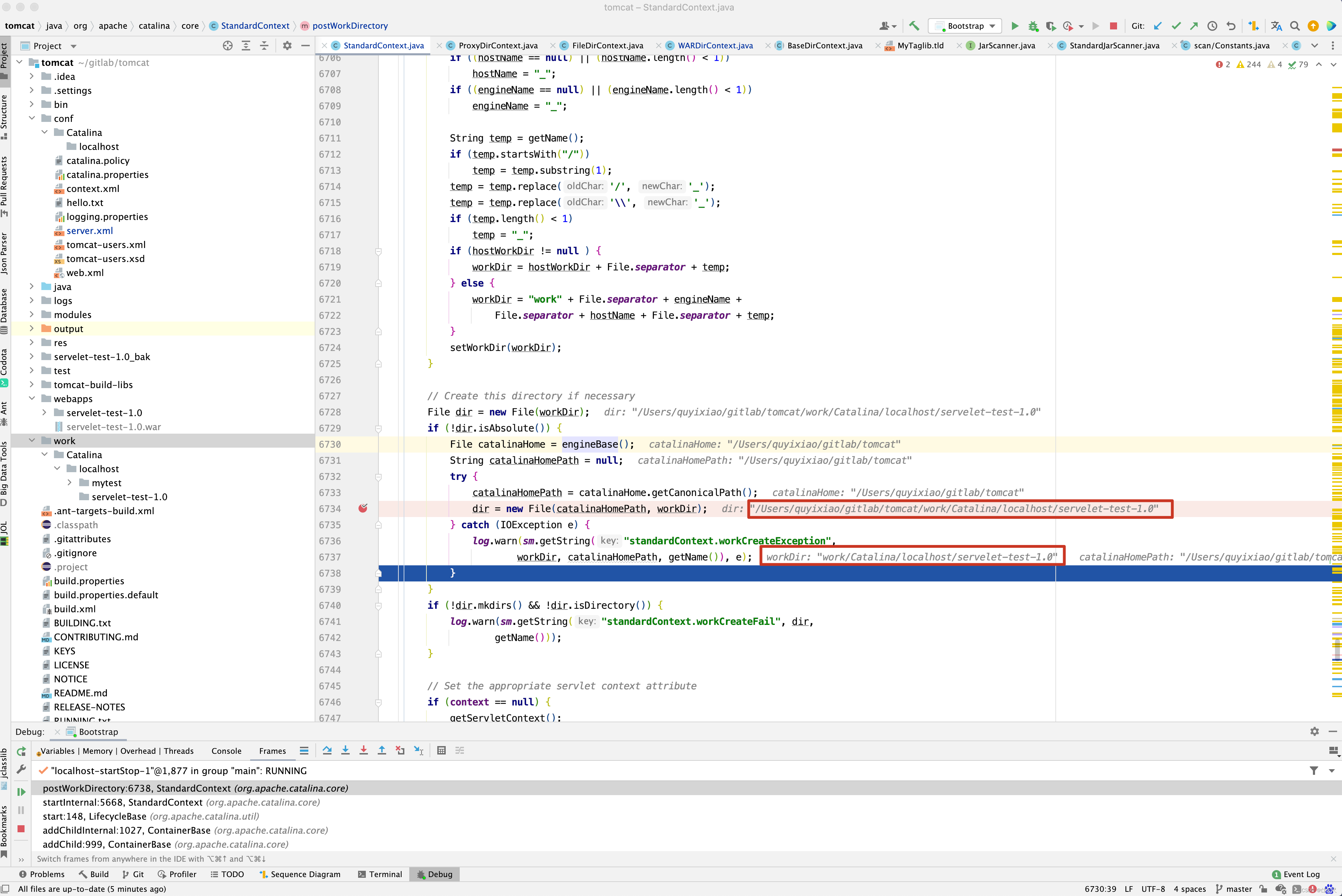
为什么我要讲这个工作目录呢?
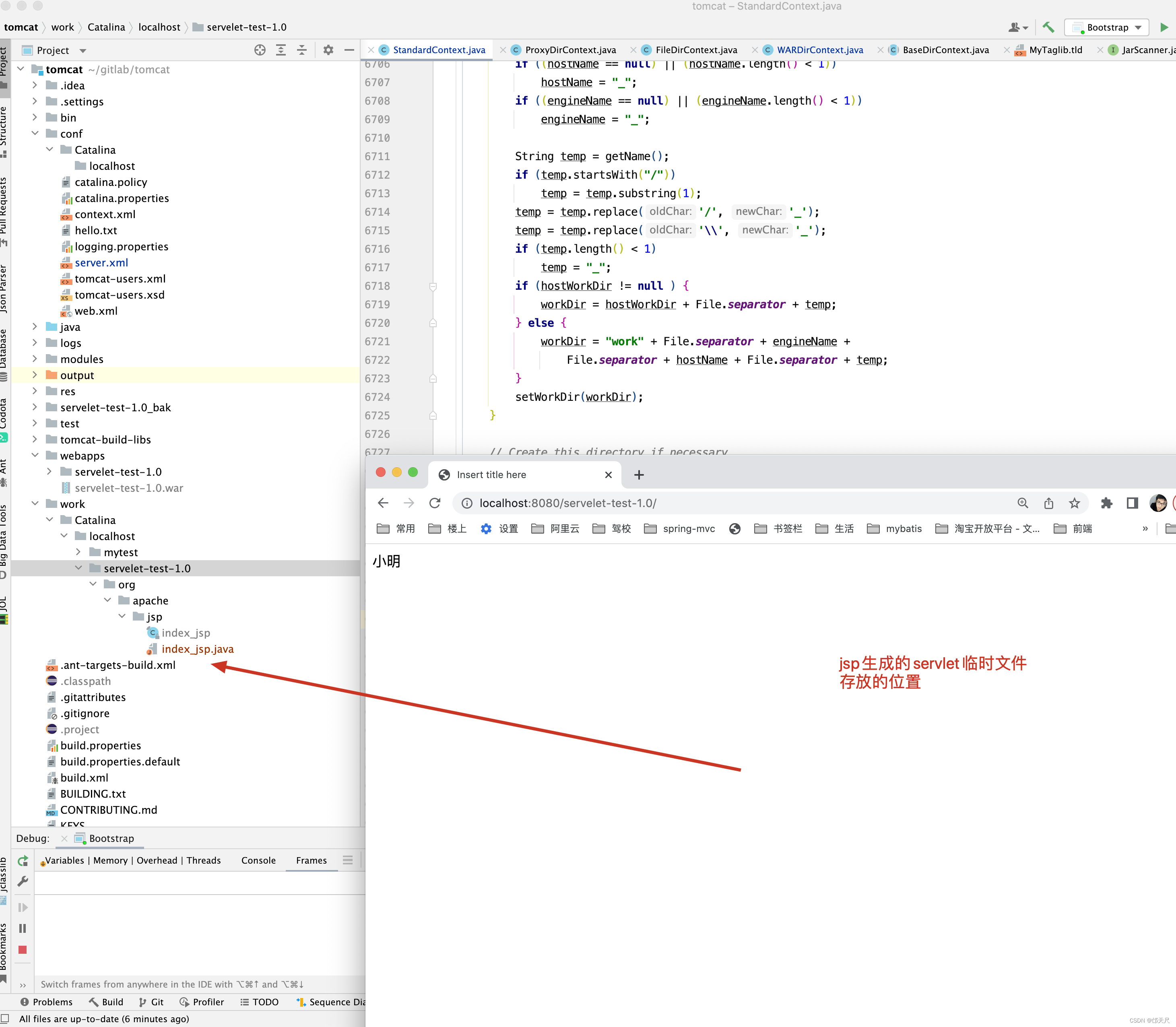
一个重要的应用就是当访问jsp文件时,jsp文件会生成xxx_jsp.java文件,而这个文件存放在工作目录下。
我相信上面有一行ExtensionValidator.validateApplication (getResources(), this);这行代码很容易被人遗漏。好像执行与不执行对tomcat启动没有什么影响,真的吗?先看源码,再来举例子。
public static synchronized boolean validateApplication( DirContext dirContext, Context context) throws IOException { String appName = context.getName(); ArrayList<ManifestResource> appManifestResources = new ArrayList<ManifestResource>(); // If the application context is null it does not exist and // therefore is not valid if (dirContext == null) return false; // Find the Manifest for the Web Application InputStream inputStream = null; try { // 通过JNDI查找/META-INF目录下的MANIFEST.MF文件 // 如果存在,则构建ManifestResource 保存到appManifestResources中 NamingEnumeration<Binding> wne = dirContext.listBindings("/META-INF/"); Binding binding = wne.nextElement(); if (binding.getName().toUpperCase(Locale.ENGLISH).equals("MANIFEST.MF")) { Resource resource = (Resource)dirContext.lookup ("/META-INF/" + binding.getName()); inputStream = resource.streamContent(); Manifest manifest = new Manifest(inputStream); inputStream.close(); inputStream = null; ManifestResource mre = new ManifestResource (sm.getString("extensionValidator.web-application-manifest"), manifest, ManifestResource.WAR); appManifestResources.add(mre); } } catch (NamingException nex) { // Application does not contain a MANIFEST.MF file } catch (NoSuchElementException nse) { // Application does not contain a MANIFEST.MF file } finally { if (inputStream != null) { try { inputStream.close(); } catch (Throwable t) { ExceptionUtils.handleThrowable(t); } } } // Locate the Manifests for all bundled JARs NamingEnumeration<Binding> ne = null; // Primarily used for error reporting String jarName = null; try { // 遍历当前Context目录下WEB-INF/lib/文件夹下的所有jar包 // 看jar包下是否存在 META-INF/MANIFEST.MF ,如果存在,则构建 // ManifestResource 对象,添加到appManifestResources下 ne = dirContext.listBindings("WEB-INF/lib/"); while ((ne != null) && ne.hasMoreElements()) { Binding binding = ne.nextElement(); jarName = binding.getName(); if (!jarName.toLowerCase(Locale.ENGLISH).endsWith(".jar")) { continue; } Object obj = dirContext.lookup("/WEB-INF/lib/" + jarName); if (!(obj instanceof Resource)) { // Probably a directory named xxx.jar - ignore it continue; } Resource resource = (Resource) obj; inputStream = resource.streamContent(); Manifest jmanifest = getManifest(inputStream); // 如果jar包下存在META-INF/MANIFEST.MF ,则创建ManifestResource if (jmanifest != null) { ManifestResource mre = new ManifestResource(jarName, jmanifest, ManifestResource.APPLICATION); appManifestResources.add(mre); } } } catch (NamingException nex) { // Jump out of the check for this application because it // has no resources } catch (IOException ioe) { throw new IOException("Jar: " + jarName, ioe); } finally { if (inputStream != null) { try { inputStream.close(); } catch (Throwable t) { ExceptionUtils.handleThrowable(t); } } } return validateManifestResources(appName, appManifestResources); } private static Manifest getManifest(InputStream inStream) throws IOException { Manifest manifest = null; JarInputStream jin = null; try { jin = new JarInputStream(inStream); // jar包下的META-INF/MANIFEST.MF是否存在 manifest = jin.getManifest(); jin.close(); jin = null; } finally { if (jin != null) { try { jin.close(); } catch (Throwable t) { ExceptionUtils.handleThrowable(t); } } } return manifest; } public JarInputStream(InputStream in, boolean verify) throws IOException { super(in); this.doVerify = verify; // This implementation assumes the META-INF/MANIFEST.MF entry // should be either the first or the second entry (when preceded // by the dir META-INF/). It skips the META-INF/ and then // "consumes" the MANIFEST.MF to initialize the Manifest object. JarEntry e = (JarEntry)super.getNextEntry(); if (e != null && e.getName().equalsIgnoreCase("META-INF/")) e = (JarEntry)super.getNextEntry(); first = checkManifest(e); } private JarEntry checkManifest(JarEntry e) throws IOException { if (e != null && "META-INF/MANIFEST.MF".equalsIgnoreCase(e.getName())) { man = new Manifest(); byte bytes[] = getBytes(new BufferedInputStream(this)); man.read(new ByteArrayInputStream(bytes)); closeEntry(); if (doVerify) { jv = new JarVerifier(bytes); mev = new ManifestEntryVerifier(man); } return (JarEntry)super.getNextEntry(); } return e; } public Manifest getManifest() { return man; }
其实validateApplication()代码写了那么多,只是将/META-INF/MANIFEST.MF文件以及WEB-INF/lib下的所有jar包中的/META-INF/MANIFEST.MF构建成ManifestResource添加到appManifestResources中。
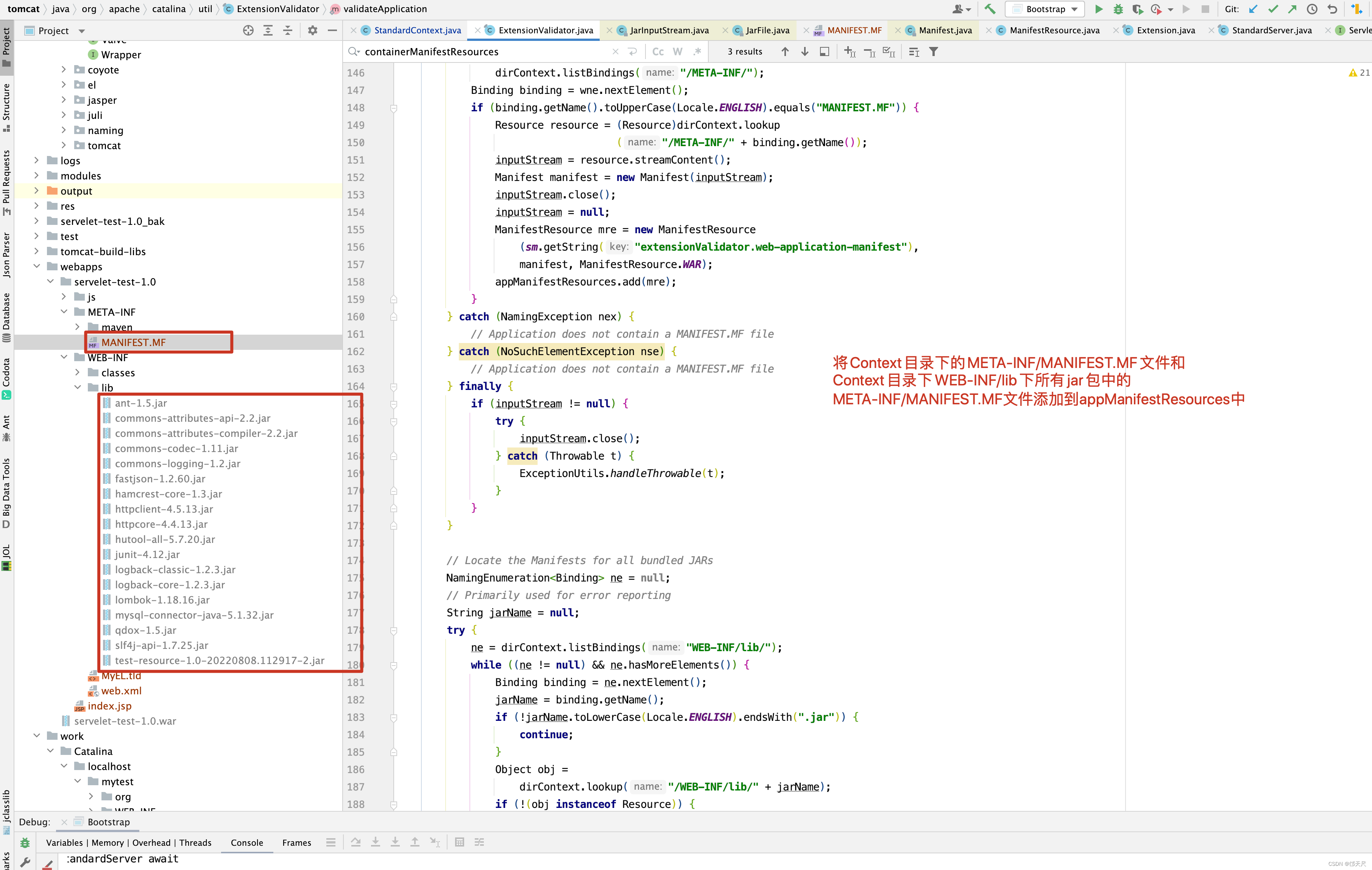
当然ManifestResource构建函数中做了哪些事情呢?
public ManifestResource(String resourceName, Manifest manifest, int resourceType) { this.resourceName = resourceName; this.resourceType = resourceType; processManifest(manifest); } private void processManifest(Manifest manifest) { availableExtensions = getAvailableExtensions(manifest); requiredExtensions = getRequiredExtensions(manifest); } private ArrayList<Extension> getRequiredExtensions(Manifest manifest) { Attributes attributes = manifest.getMainAttributes(); String names = attributes.getValue("Extension-List"); if (names == null) return null; ArrayList<Extension> extensionList = new ArrayList<Extension>(); names += " "; while (true) { int space = names.indexOf(' '); if (space < 0) break; String name = names.substring(0, space).trim(); names = names.substring(space + 1); String value = attributes.getValue(name + "-Extension-Name"); if (value == null) continue; Extension extension = new Extension(); extension.setExtensionName(value); extension.setImplementationURL (attributes.getValue(name + "-Implementation-URL")); extension.setImplementationVendorId (attributes.getValue(name + "-Implementation-Vendor-Id")); String version = attributes.getValue(name + "-Implementation-Version"); extension.setImplementationVersion(version); extension.setSpecificationVersion (attributes.getValue(name + "-Specification-Version")); extensionList.add(extension); } return extensionList; }
写这么多,只为分析ManifestResource的requiredExtensions属性由来,因为后面的验证需要用requiredExtensions属性,requiredExtensions来源于MANIFEST.MF的Extension-List属性,先来看一个拥有Extension-List的MANIFEST.MF文件,在网上寻寻觅觅可参考 关于spring中commons-attributes-compiler.jar的使用问题 博客 ,发现commons-attributes-compiler.jar在使用过程中就有MANIFEST.MF引起的问题,先来看看commons-attributes-compiler.jar的MANIFEST.MF文件 。
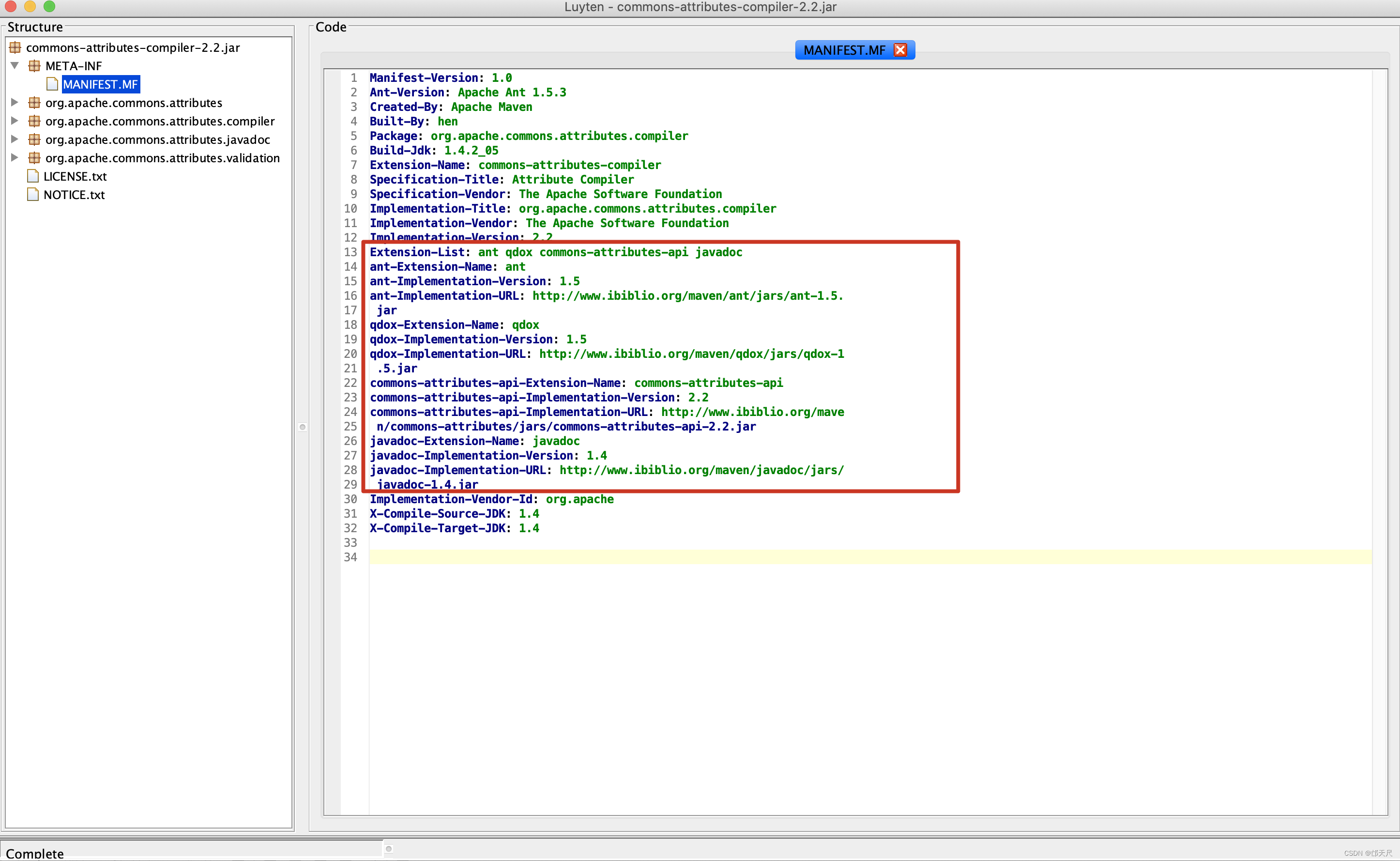

同理可以得到availableExtensions的值 。如下图所示 。
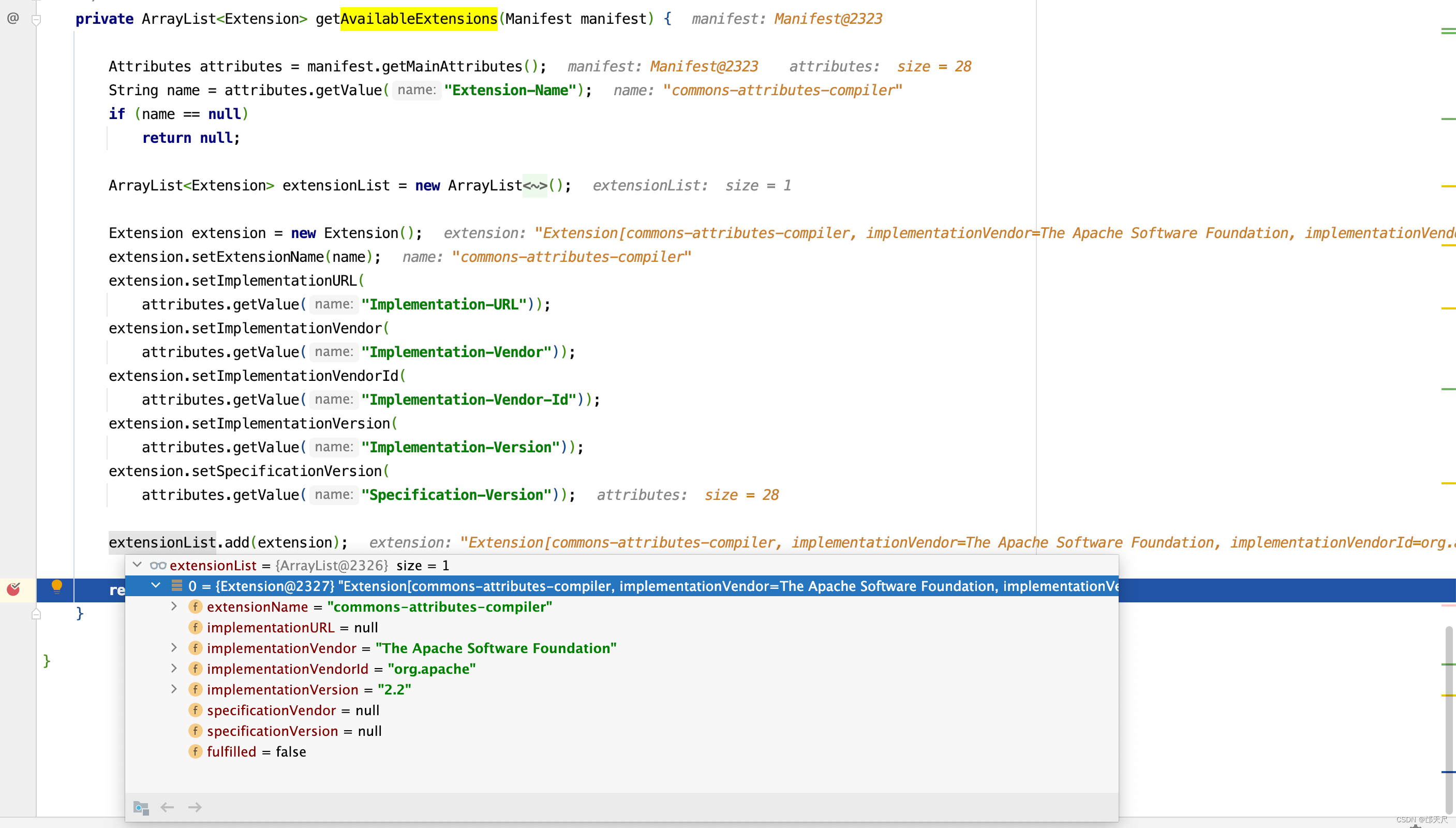
现在总知道requiredExtensions的由来了吧。 既然万事具备了,我们进入validateManifestResources()方法 。
private static boolean validateManifestResources(String appName, ArrayList<ManifestResource> resources) { boolean passes = true; int failureCount = 0; ArrayList<Extension> availableExtensions = null; Iterator<ManifestResource> it = resources.iterator(); while (it.hasNext()) { ManifestResource mre = it.next(); ArrayList<Extension> requiredList = mre.getRequiredExtensions(); if (requiredList == null) { continue; } // build the list of available extensions if necessary if (availableExtensions == null) { availableExtensions = buildAvailableExtensionsList(resources); } // load the container level resource map if it has not been built // yet if (containerAvailableExtensions == null) { containerAvailableExtensions = buildAvailableExtensionsList(containerManifestResources); } // iterate through the list of required extensions Iterator<Extension> rit = requiredList.iterator(); while (rit.hasNext()) { boolean found = false; Extension requiredExt = rit.next(); // check the application itself for the extension if (availableExtensions != null) { Iterator<Extension> ait = availableExtensions.iterator(); while (ait.hasNext()) { Extension targetExt = ait.next(); if (targetExt.isCompatibleWith(requiredExt)) { requiredExt.setFulfilled(true); found = true; break; } } } // check the container level list for the extension if (!found && containerAvailableExtensions != null) { Iterator<Extension> cit = containerAvailableExtensions.iterator(); while (cit.hasNext()) { Extension targetExt = cit.next(); if (targetExt.isCompatibleWith(requiredExt)) { requiredExt.setFulfilled(true); found = true; break; } } } if (!found) { // Failure log.info(sm.getString( "extensionValidator.extension-not-found-error", appName, mre.getResourceName(), requiredExt.getExtensionName())); passes = false; failureCount++; } } } if (!passes) { log.info(sm.getString( "extensionValidator.extension-validation-error", appName, failureCount + "")); } return passes; }
在分析源码之前,还要准备一个变量,就是containerAvailableExtensions从何而来,在代码中寻寻觅觅,最终在addSystemResource()方法中看到了containerManifestResources.add(mre); 代码,在这个方法中打一个断点 。


综合上述,containerAvailableExtensions来源于System.getProperty(“java.class.path”), System.getProperty(“java.ext.dirs”), 以及StandardServer启动过程中,大家可能好奇最后一张图中的/Users/quyixiao/gitlab/tomcat/tomcat-build-libs/ant-1.9.8.jar 包在哪里配置的呢?
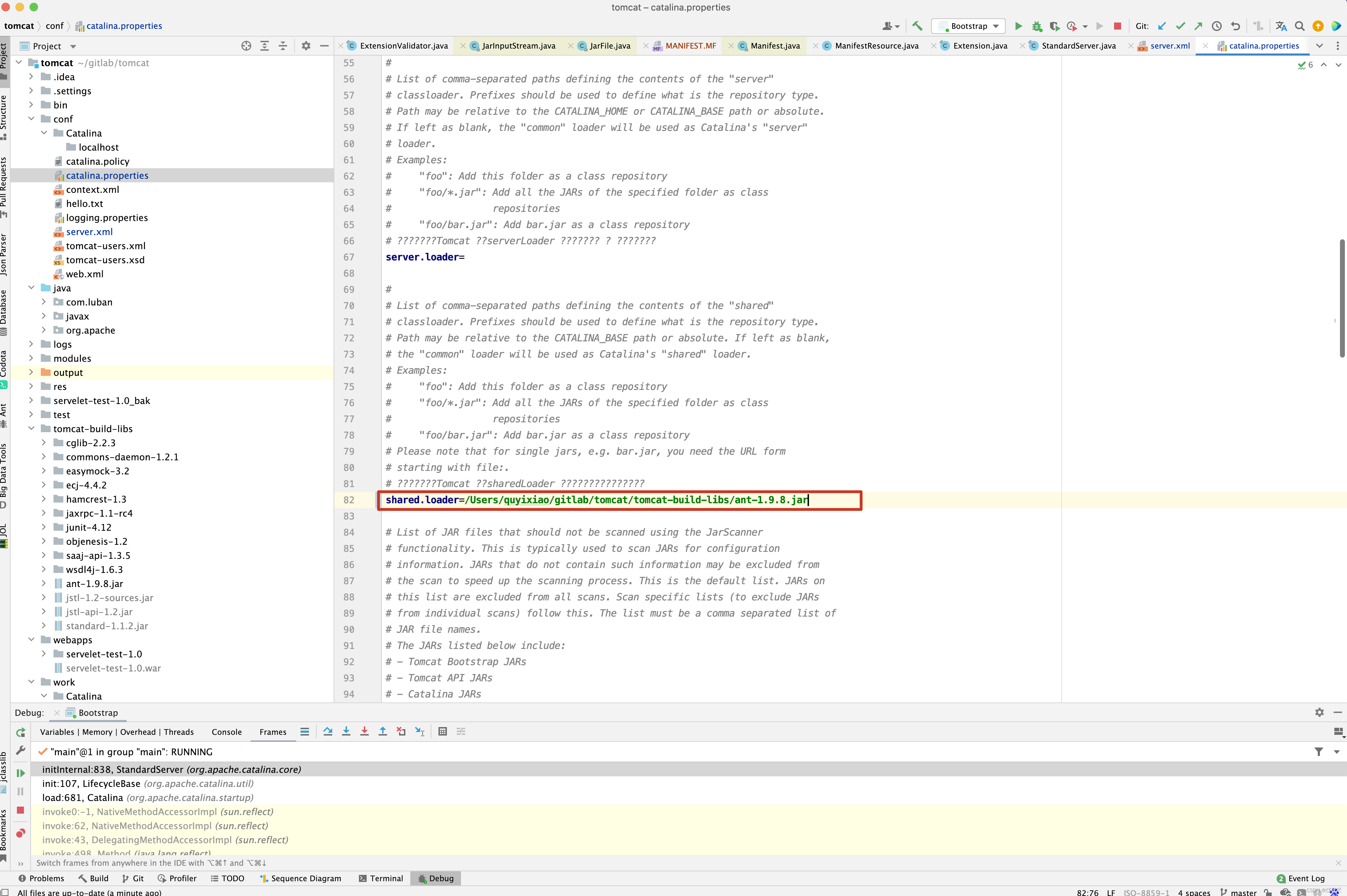
其实在catalina.base/conf/catalina.properties的shared.loader=/Users/quyixiao/gitlab/tomcat/tomcat-build-libs/ant-1.9.8.jar属性中配置即可。
我们继续分析 validateManifestResources()方法,还是以commons-attributes-compiler.jar包为例。
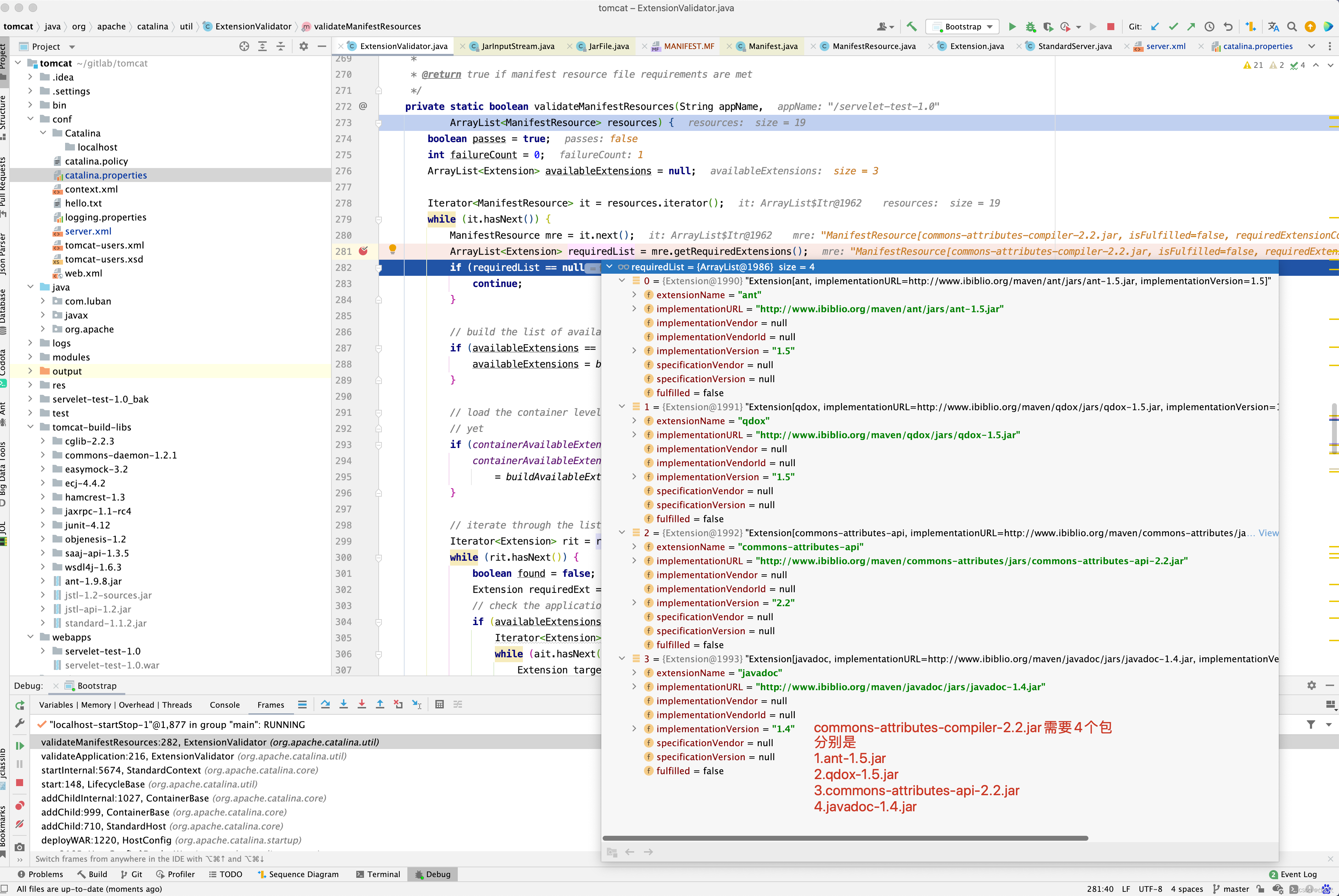
但resources下可用的只有3个包。commons-attributes-api-2.2.jar , commons-attributes-compiler-2.2.jar, qdox-1.5.jar
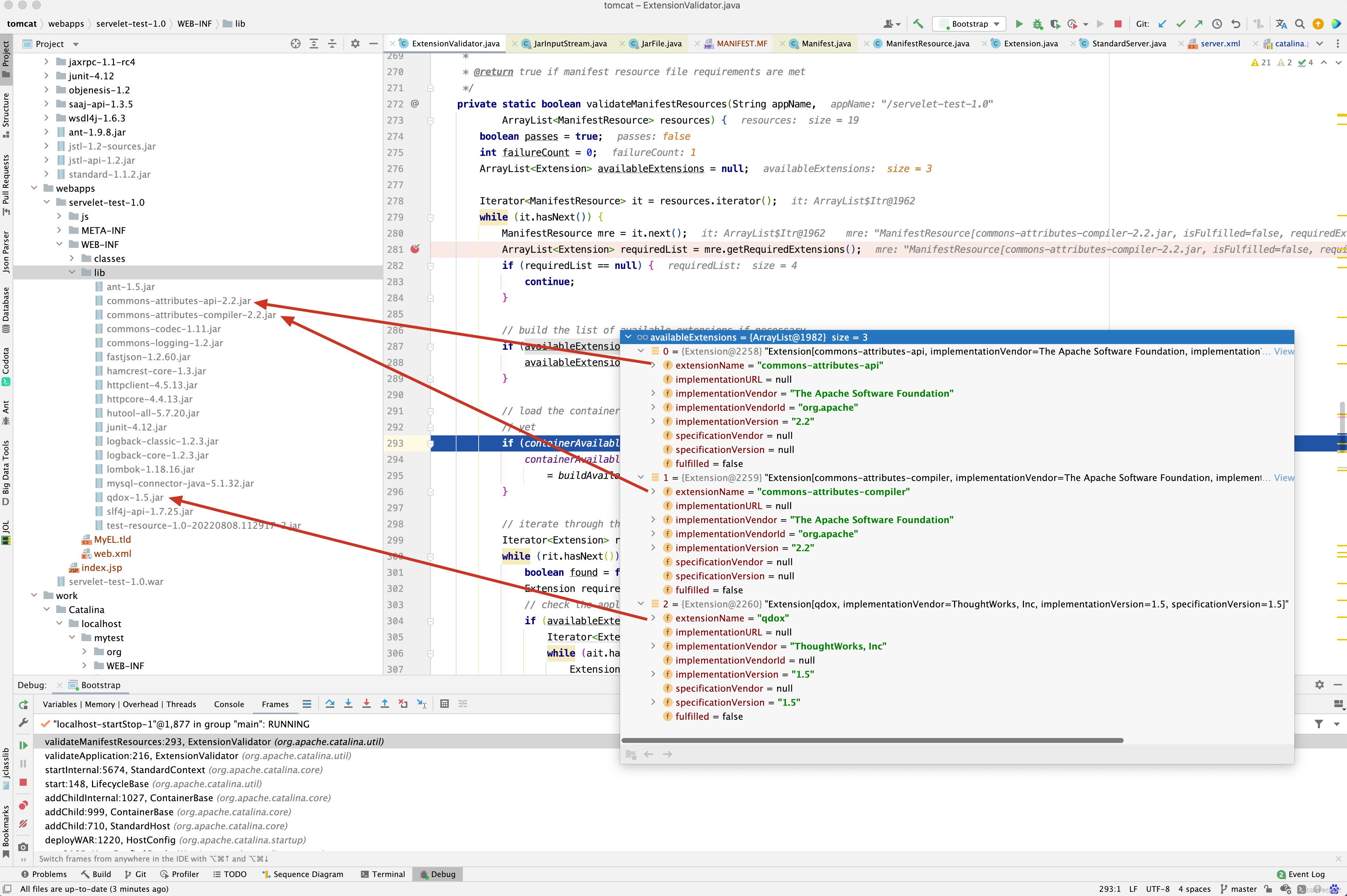
显然少了javadoc-1.4.jar和ant-1.5.jar两个包。 再来看全局的containerAvailableExtensions是否有这两个依赖呢?

遗憾的是,这9个包中,并没有javadoc-1.4.jar和ant-1.5.jar这两个包。
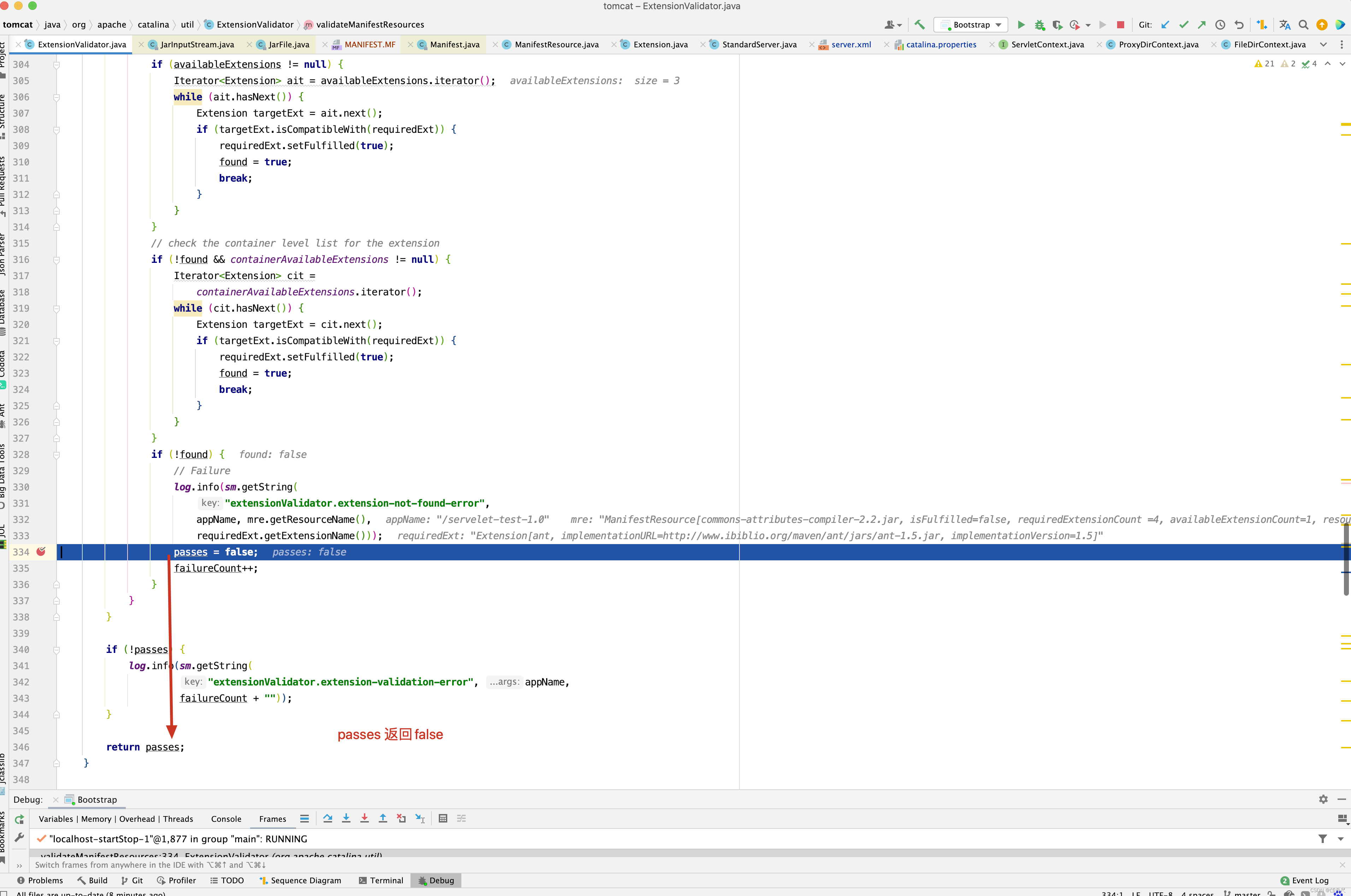
最终passes为false,如果passes为false,会导致tomcat启动失败。当然还有一个方法需要分析,就是如何判断依赖是否存在呢?请看如下方法 。
public boolean isCompatibleWith(Extension required) { // Extension Name must match if (extensionName == null) return (false); if (!extensionName.equals(required.getExtensionName())) return (false); // If specified, available specification version must be >= required if (required.getSpecificationVersion() != null) { if (!isNewer(specificationVersion, required.getSpecificationVersion())) return (false); } // If specified, Implementation Vendor ID must match if (required.getImplementationVendorId() != null) { if (implementationVendorId == null) return (false); if (!implementationVendorId.equals(required .getImplementationVendorId())) return (false); } // If specified, Implementation version must be >= required if (required.getImplementationVersion() != null) { if (!isNewer(implementationVersion, required.getImplementationVersion())) return (false); } // This available optional package satisfies the requirements return (true); }
这个方法是什么意思呢?如commons-attributes-compiler-2.2.jar要求
commons-attributes-api-Extension-Name: commons-attributes-api
commons-attributes-api-Implementation-Version: 2.2
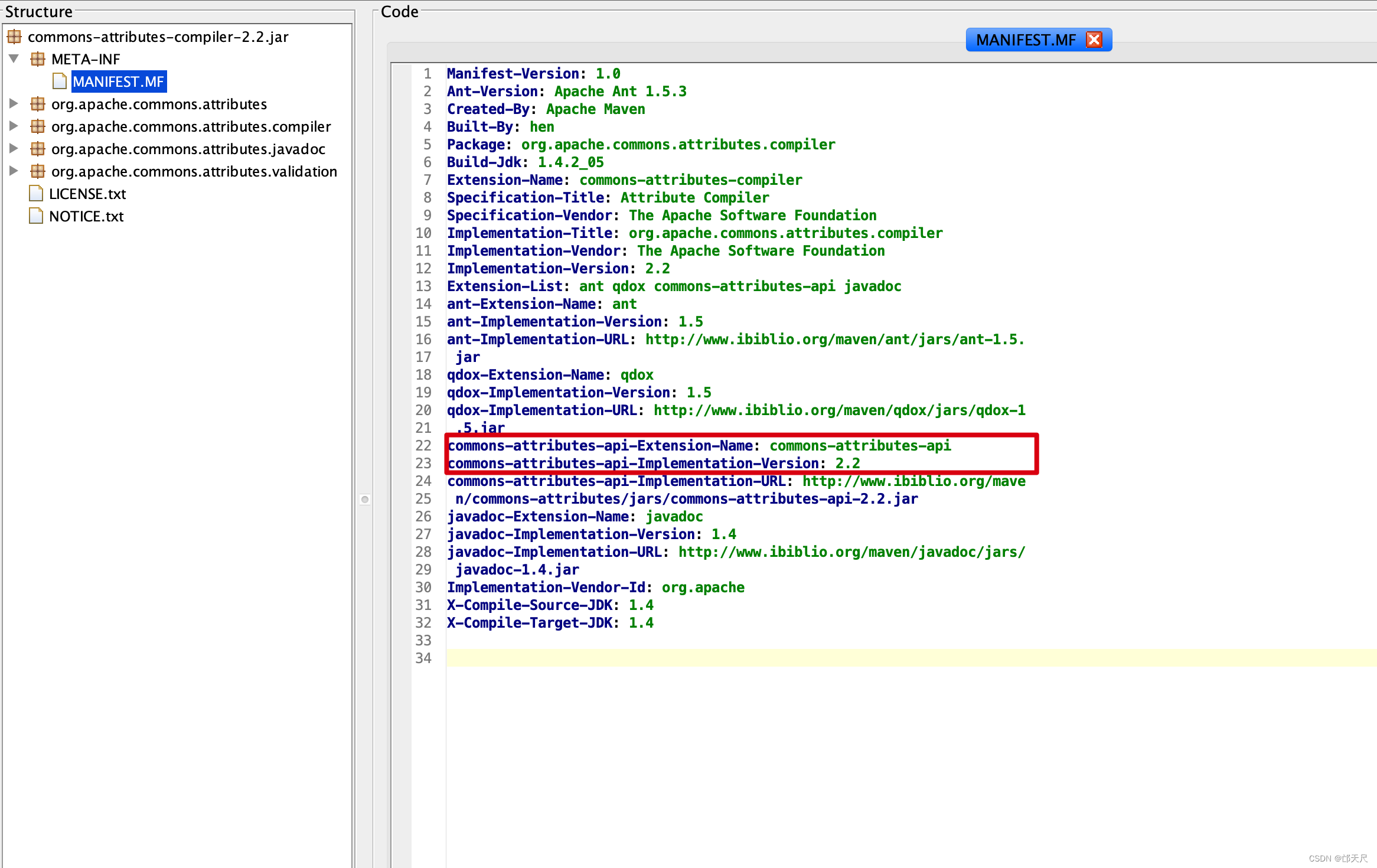
那么会到commons-attributes-api-2.2.jar找名称为commons-attributes-api并且版本是2.2的,即使名称相同,但版本不是2.2 也表示找到不依赖。
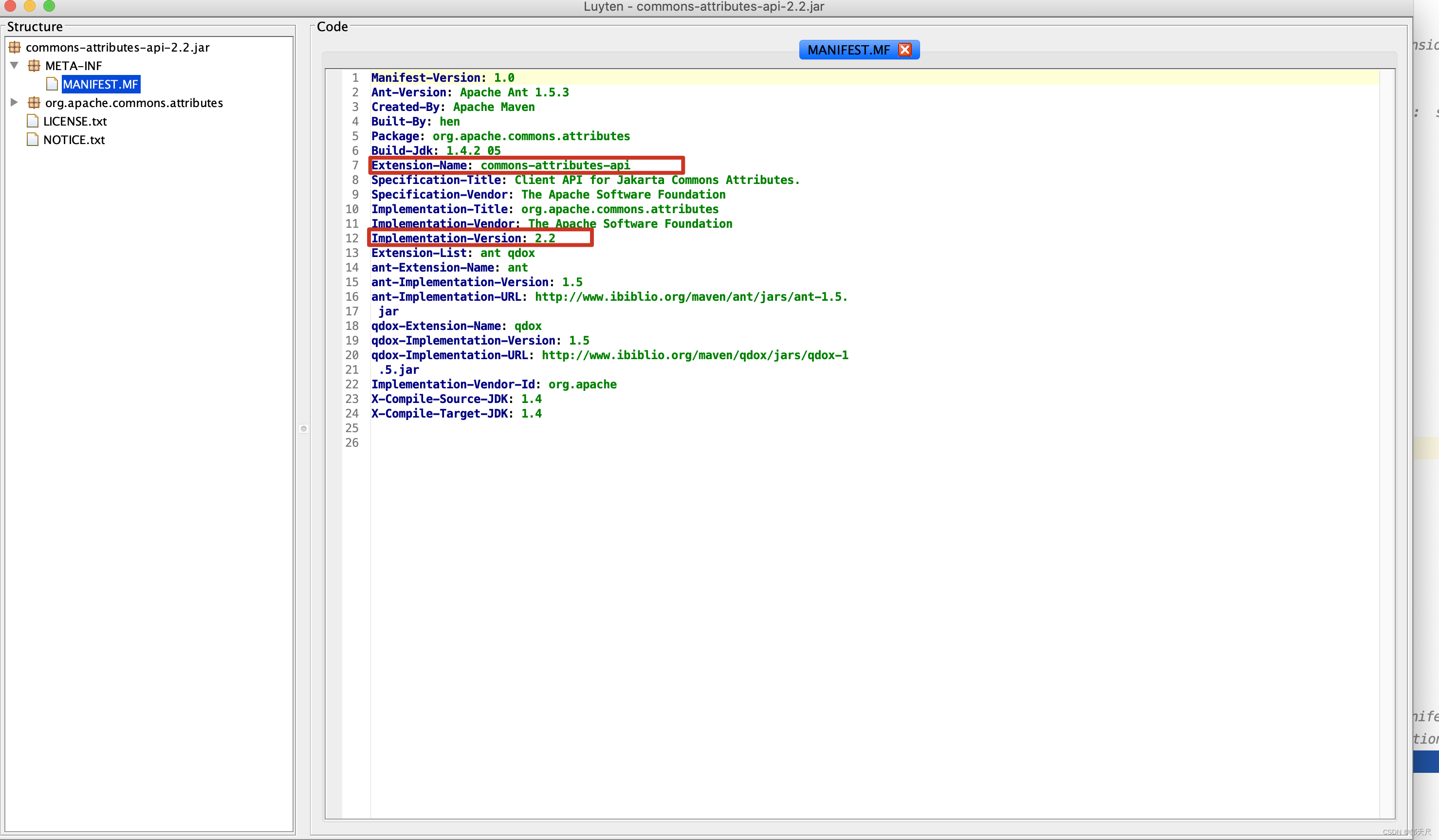
当然,最严格的会对Extension-Name,Implementation-Version, Implementation-Vendor-Id ,specification-Version 4个参数进行较验。

ExtensionValidator.validateApplication (getResources(), this); 这一行代码的主要作用就是检测MANIFST.MF文件中Extension-List中配置的依赖在其他的jar包是否存在 ,如本例中commons-attributes-compiler.jar的MANIFST.MF依赖ant-1.5.jar , qdx-1.5.jar , common-attributes-api-2.2.jar , javadoc-1.4.jar 4个包,但从系统类加载器目录下,扩展类加载器目录下,以及tomcat的shared.loader目录以及WEB-INF/lib目录下所有的jar包只能找到common-attributes-api-2.2.jar和qdx-1.5.jar。依赖的jar包存在并不是存在这个jar包即可,而是要求这个包有MANIFST.MF 文件,并且其对应的Extension-Name,Implementation-Version, Implementation-Vendor-Id ,specification-Version 4 个属性和请求依赖的Extension-List配置依赖的属性一样。这才算依赖成功, 只要有一个包依赖不存在,则会导致tomcat启动失败。
Web应用载入器-WebAppLoader
每个Web 应用都有各自的Class类和Jar包,一般来说,在Tomcat 启动时要准备好相应的类加载器,包括加载策略及Class文件的查找,方便后面对Web应用实例化Servlet对象时通过类加载器加载相关的类, 因为每个WEb应用不仅要达到资源的互相隔离,还要能支持重加载,所以这里需要为每个Web应用安排不同的类加载器对象加载,重加载时可直接将旧的类加载器对象丢弃而使用新的。
StandardContext使用一个继承了Loader接口的WebappLoader作为Web应用的类加载器, 作为Tomcat与Web应用的类加载器实现,它能检测是否有Web项目的Class被更改, 然后自动重加载,每个Web应用对应的WebappLoader,每个WebappLoader互相隔离,各自包含的类互相不可见。
如图9.7所示 , WebappLoader的核心工作其实交给其内部WebappClassLoader,它才是真正的完成类加载工作的加载器, 它是一个自定义的类加载器, WebappClassLoader继承了URLClassLoader,只需要把/WEB-INF/lib和/WEB-INF/classes目录下的类和Jar包以URL形式添加到URLClassLoader中即可, 后面就可以使用该类加载器对类进行加载 。

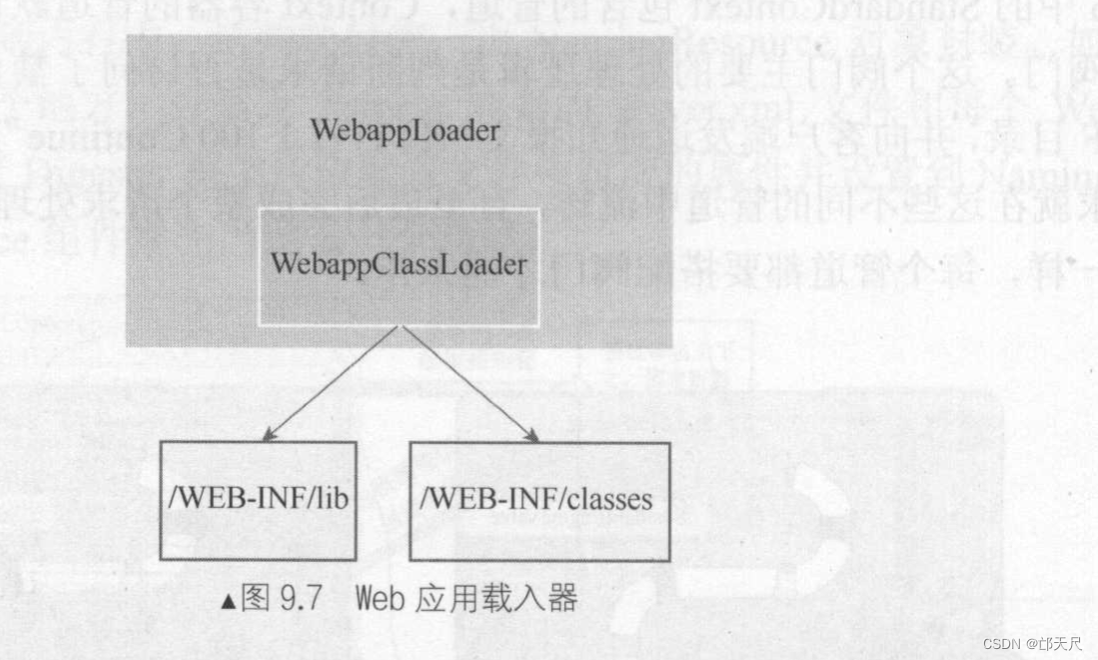
WebappClassLoader类加载器是如何达到互相隔离和实现重加载的呢?
WebappClassLoader并没有遵循双亲委派机制,而是按自己的策略顺序加载类。根据委托标识,加载分为两种方式 。
- 当委托标识delegate为false时, WebappClassLoader类加载器首先尝试从本地缓存中查找该类,然后用System类加载器尝试加载类,接着由自己尝试加载类,最后才由父类加载器(Common)尝试加载,所以它的搜索目录顺序是<JAVA_HOME>/jre/lib-><JAVA_HOME>/jre/lib/ext->CLASSPATH->/WEB-INF/classes->/WEB-INF/lib->$CATALINA_BASE/lib和 $CATALINA_HOME/lib 。
- 当委托标识delegate为true时,WebappClassLoader类加载器首先尝试从本地缓存中查找加载该类, 然后用System类加载器尝试加载类,接着由父类加载器(Common)尝试加载类,最后才由自己尝试加载,所以此时它的搜索的目录顺序是<JAVA_HOME>/jre/lib-><JAVA_HOME/jre/lib/ext->CLASSPATH->$CATALINA_BASE/lib 和$ CATALINA_HOME ->WEB-INF/classes ->WEB-INF/lib。
图9.8 是WebappClassLoader 和其他类加载器关系结构图,可以看出,对于公共资源可以共享,而属于Web应用的资源则通过类加载器进行隔离 , 对于重加载的实现, 也比较清晰,只需要重新实例化一个WebappClassLoader对象并把原来的WebappLoader中旧的置换掉即可完成重加载功能,置换掉的将被GC回收。
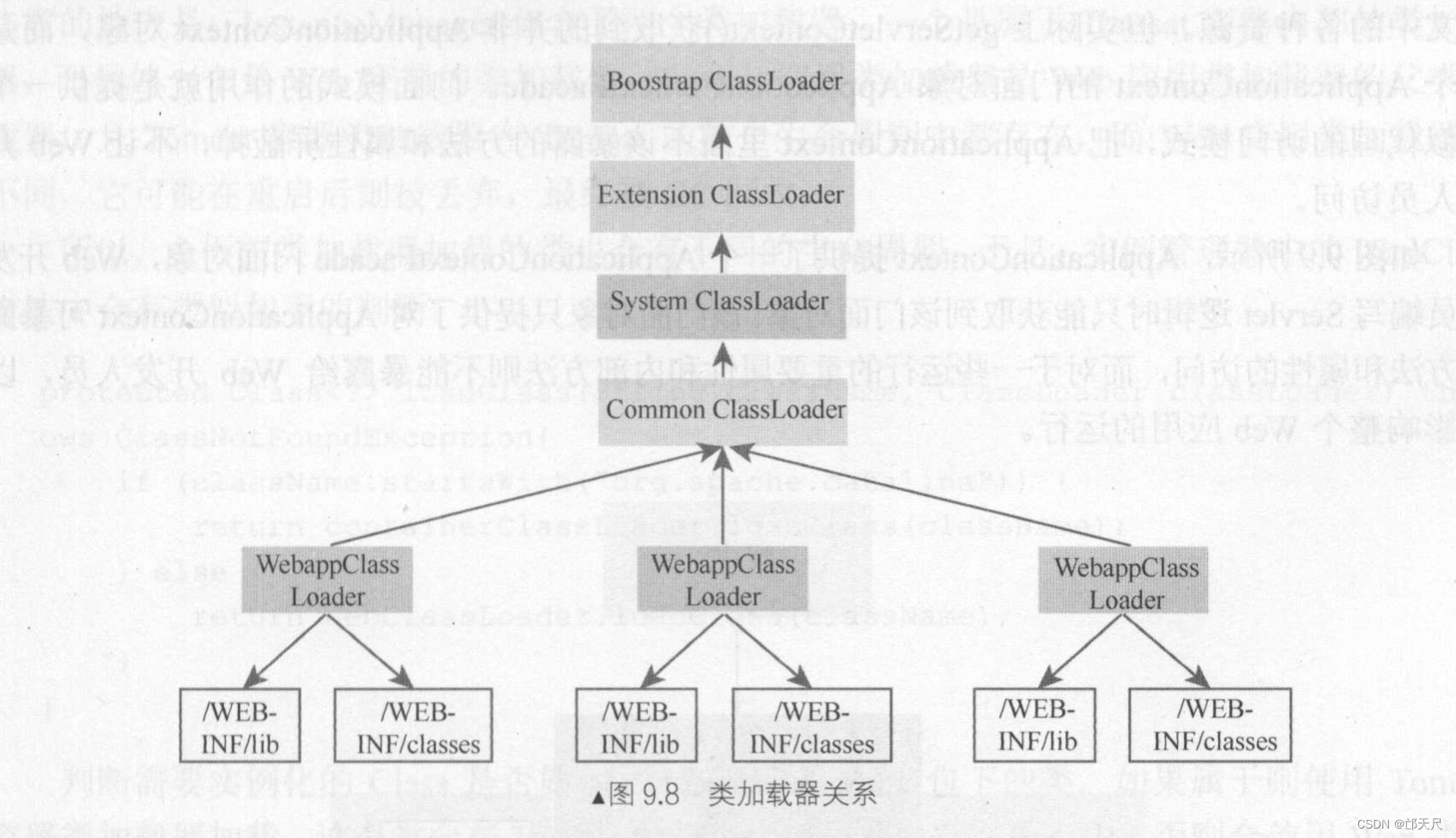
protected synchronized void startInternal() throws LifecycleException {
// 如果没有配,则生成一个WebappLoader
if (getLoader() == null) {
// Webapp类加载器的父类加载器为Host的ParentClassLoader,最终就是Catalina类的类加载器,其实就是CommonClassLoader
WebappLoader webappLoader = new WebappLoader(getParentClassLoader());
<Host name="localhost" appBase="webapps"
unpackWARs="true" autoDeploy="true" copyXML="true" deployIgnore="[1][3-9][0-9]{9}">
<Context path="/servelet-test-1.0" docBase="servelet-test-1.0" delegate="true" >
<ResourceLink global="jdbc/mysql" name="jdbc/mysql" type="javax.sql.DataSource" />
</Context>
// 可以通过Context标签中配置delegate="true|false"对delegate属性修改,默认 delegate为false
webappLoader.setDelegate(getDelegate());
// 设置StandardContext的webappLoader
setLoader(webappLoader);
}
try {
if (ok) {
// Start our subordinate components, if any
Loader loader = getLoaderInternal(); // 获取Context的类加载器
if ((loader != null) && (loader instanceof Lifecycle))
((Lifecycle) loader).start(); // 启动类加载器,包括初始话DirContext
} finally {
}
...
}
先来看parentClassLoader的获取
public ClassLoader getParentClassLoader() { if (parentClassLoader != null) return (parentClassLoader); if (getPrivileged()) { return this.getClass().getClassLoader(); } else if (parent != null) { return (parent.getParentClassLoader()); } return (ClassLoader.getSystemClassLoader()); }
如果StandardContext的parentClassLoader为空,则从其父亲StandardHost的parentClassLoader中获取,那StandardHost的parentClassLoader又是从哪里来的呢?在代码中寻寻觅觅,找到了setParentClassLoader()方法 ,在其中打断点 。
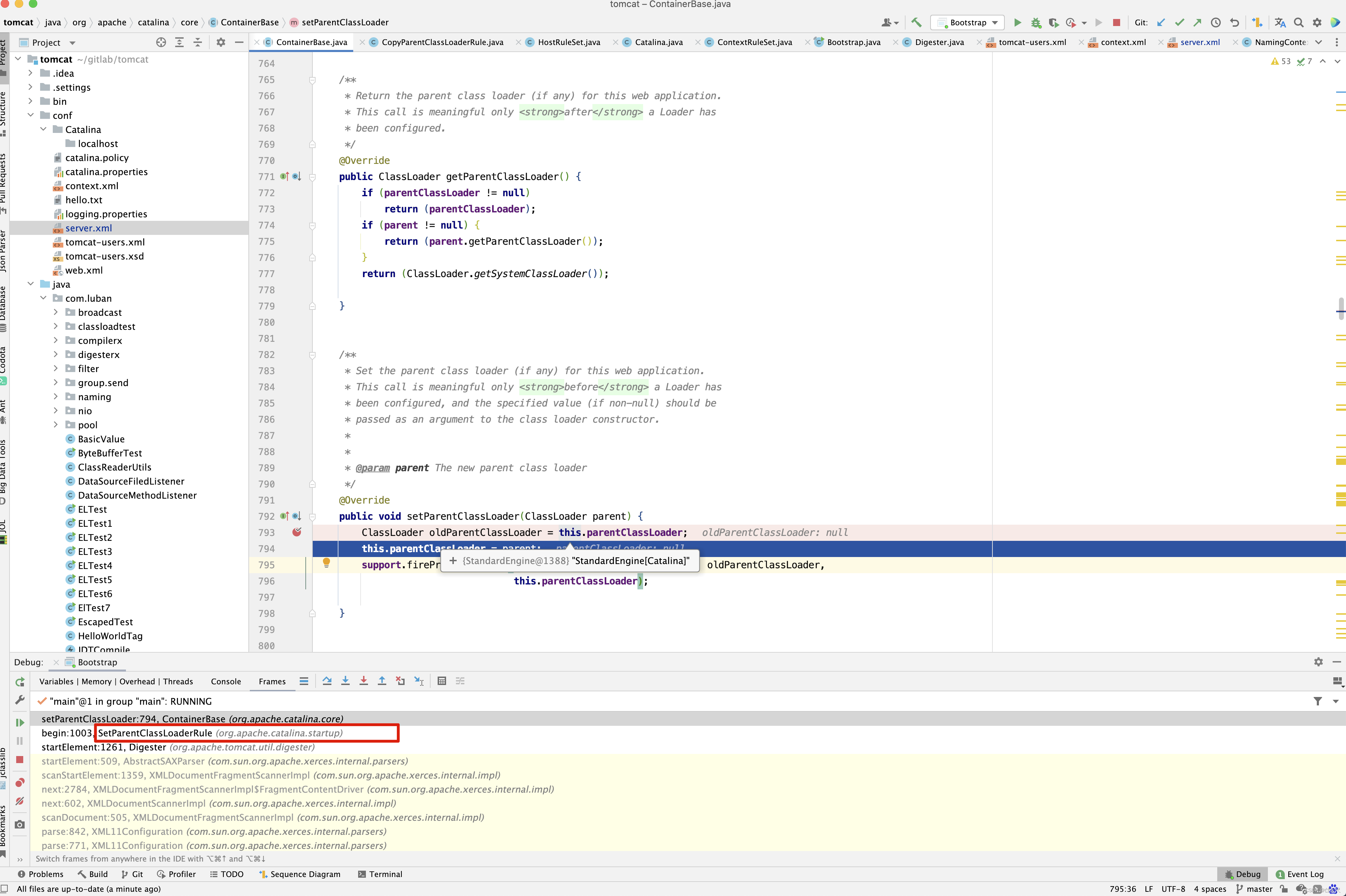
StandardEngine的parentClassLoader是在解析server.xml时的<Engine /> 时,执行SetParentClassLoaderRule规则得来的。

而Catalina中parentClassLoader = Catalina.class.getClassLoader() ,明白了StandardEngine的parentClassLoader由来 ,接下来看StandardHost的parentClassLoader由来 。 继续在原来的setParentClassLoader()方法中打断点 。
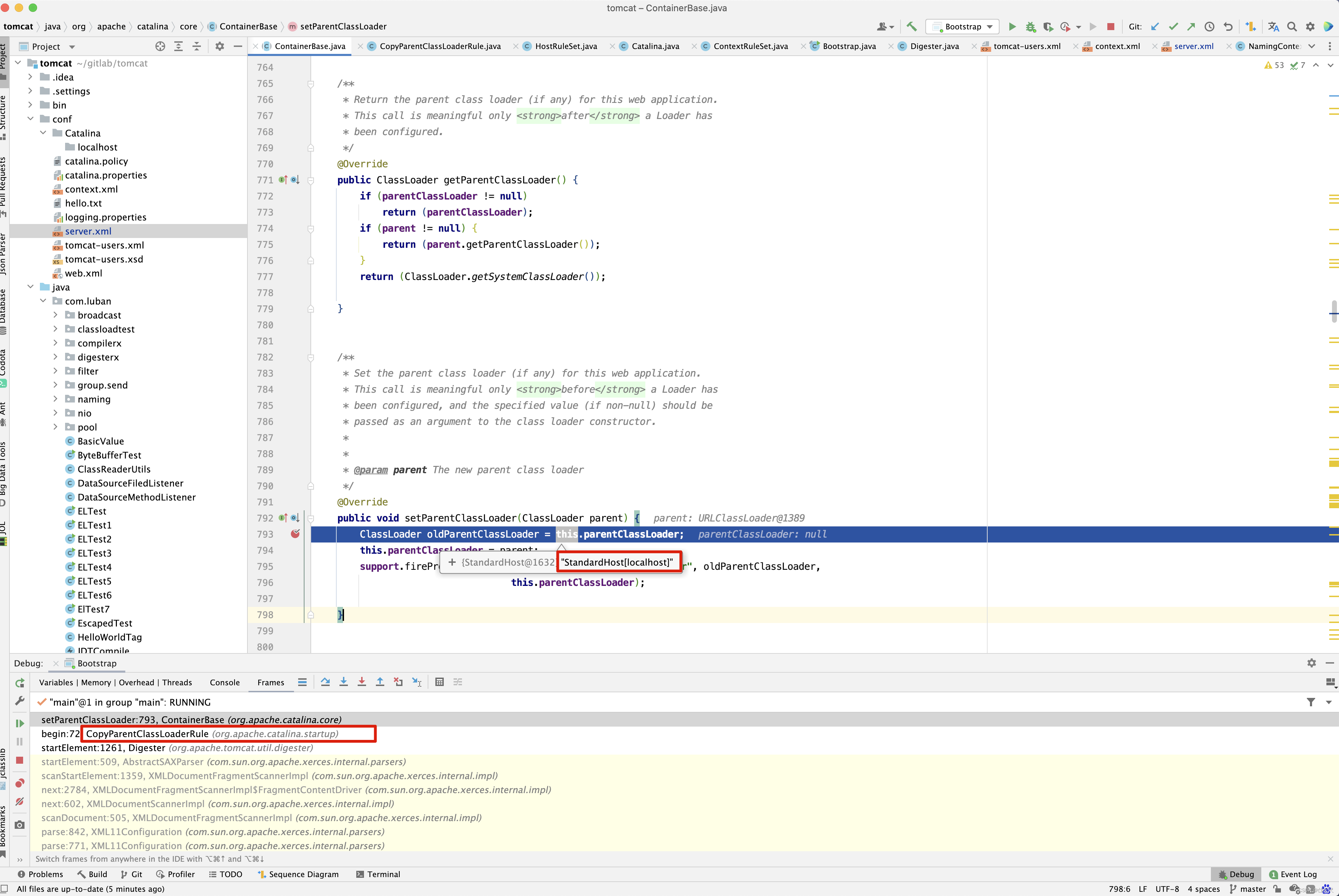
也是来源于conf/server.xml的解析,而解析规则是HostRuleSet
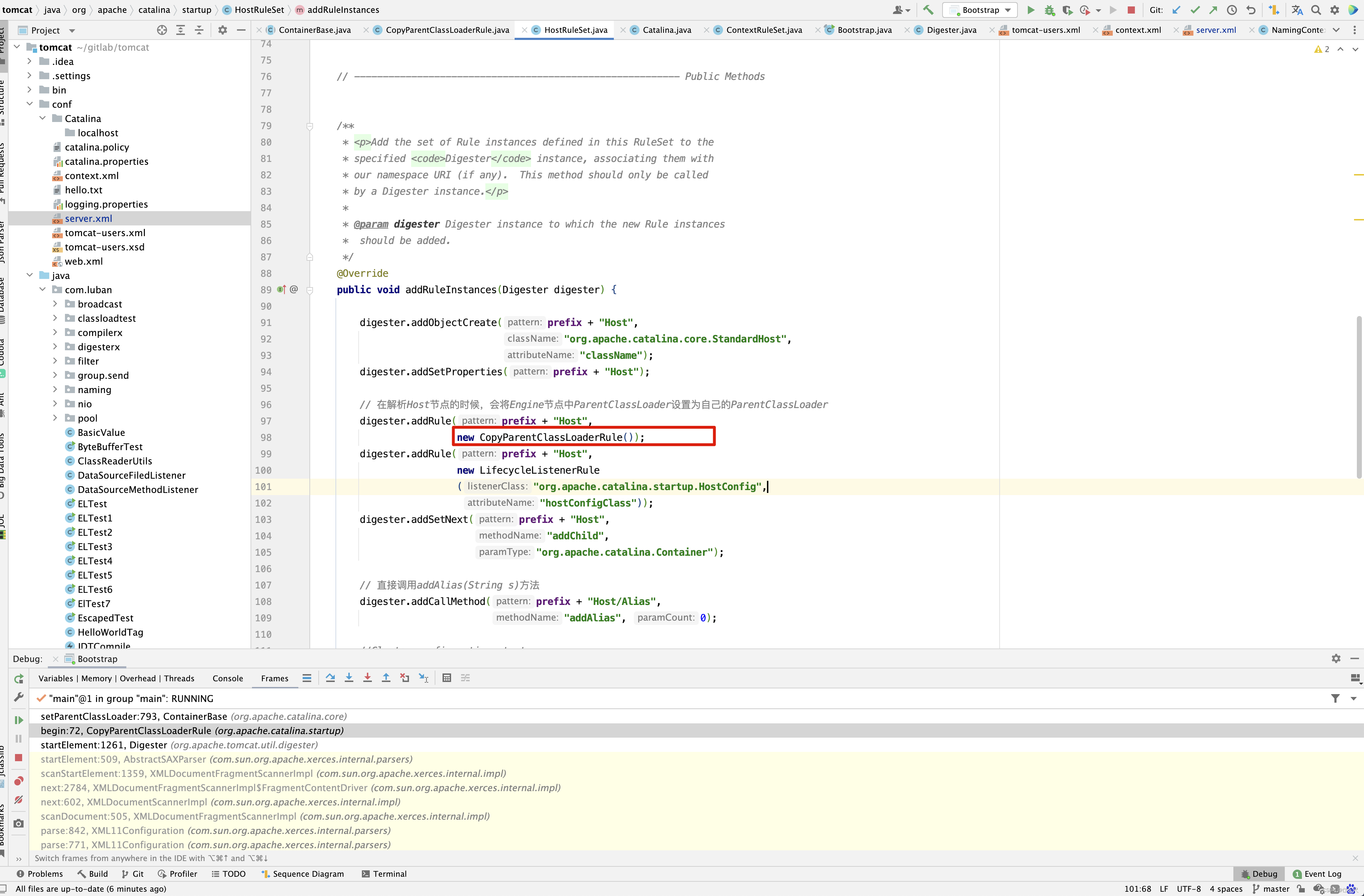
因此在解析conf/server.xml时, 当解析到<Host />时。 会走CopyParentClassLoaderRule规则 。
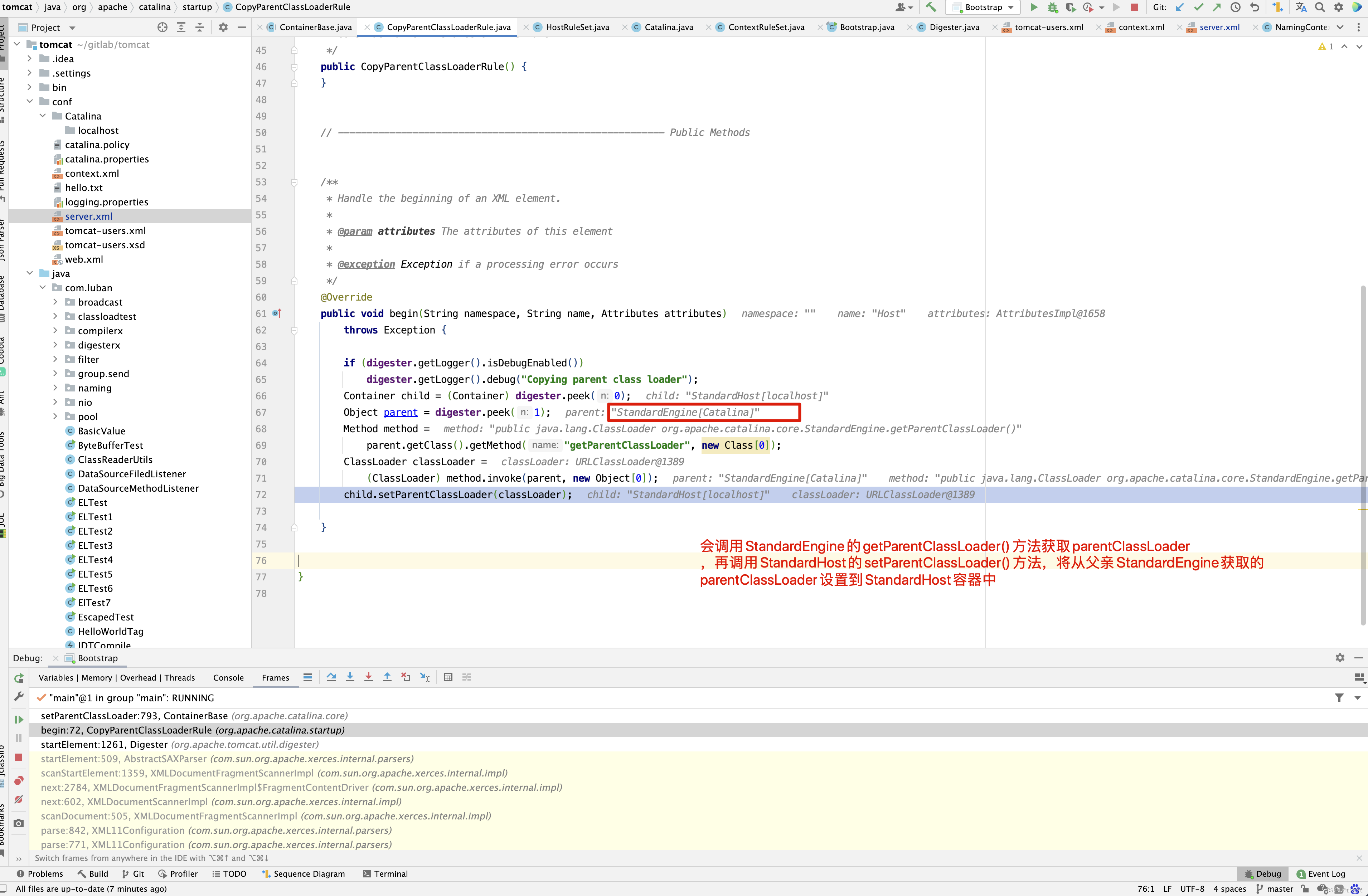
在解析到<Host /> 标签时,会执行CopyParentClassLoaderRule规则,CopyParentClassLoaderRule会将父亲StandardEngine的parentClassLoader设置到StandardHost的parentClassLoader属性中 。
那我们具体看一下Catalina.class.getClassLoader() 是什么。
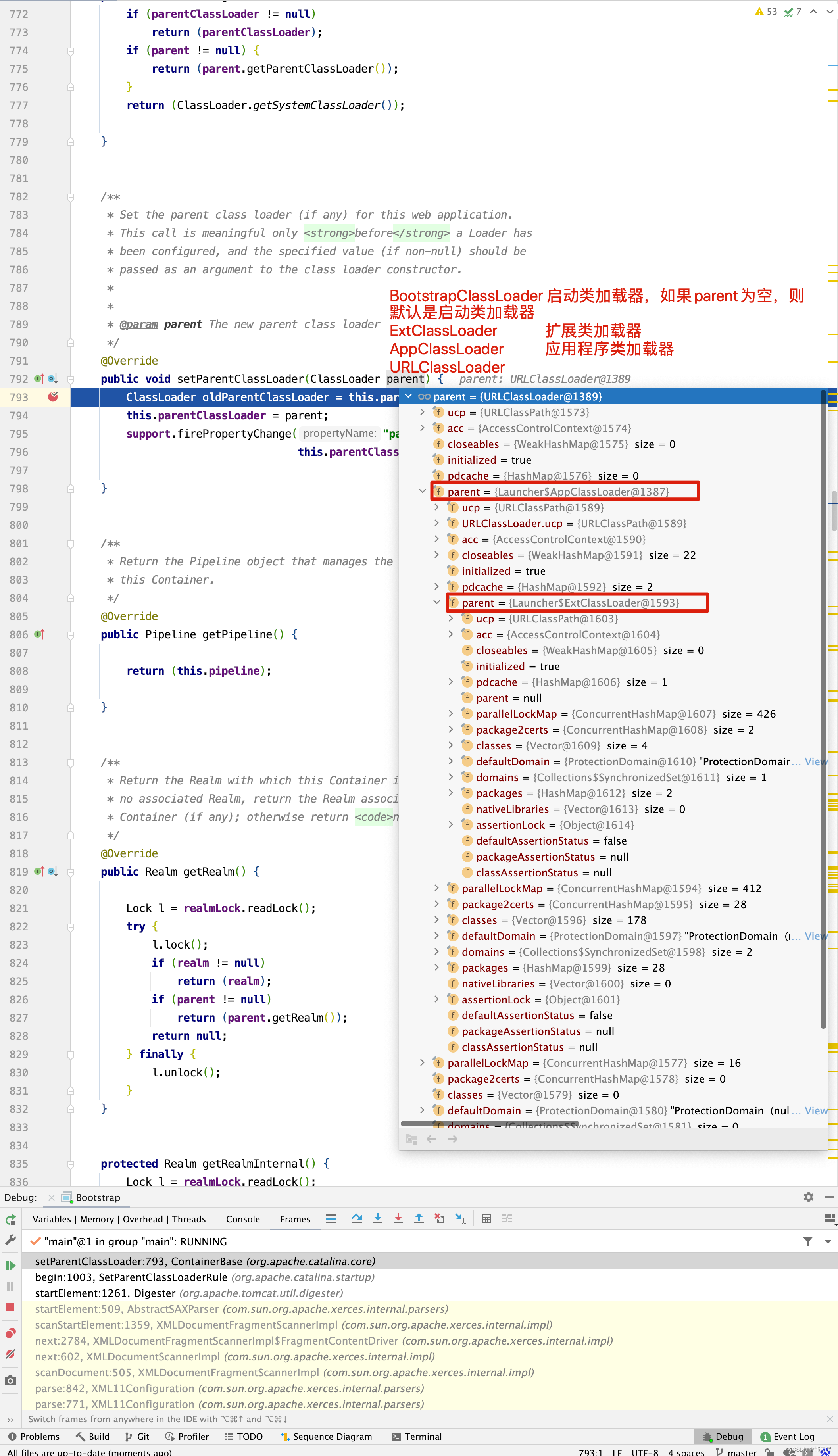
接下来看StandardContext的parentClassLoader来源,如果parentClassLoader为空,则从parent.getParentClassLoader()来,而StandardContext的parent为StandardHost。
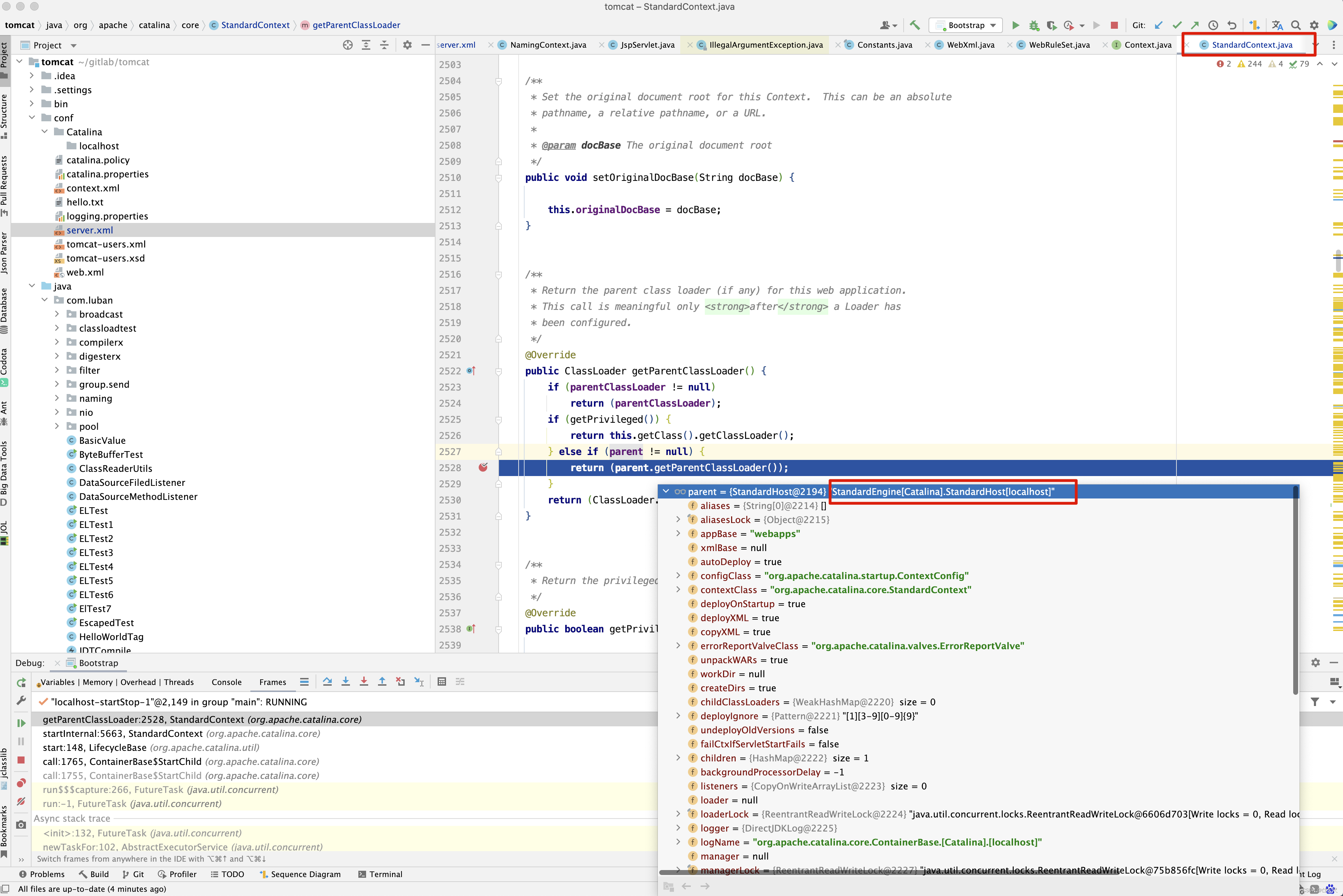
最终StandardContext的parentClassLoader加载器来源于StandardHost的parentClassLoader类加载器。
看setLoader()方法如何实现。
public void setLoader(Loader loader) { // 使用写锁,在同一个时间只能支持某一个线程来设置loader Lock writeLock = loaderLock.writeLock(); writeLock.lock(); Loader oldLoader = null; try { // Change components if necessary oldLoader = this.loader; if (oldLoader == loader) return; this.loader = loader; // Stop the old component if necessary // 把老的loader停止掉 if (getState().isAvailable() && (oldLoader != null) && (oldLoader instanceof Lifecycle)) { try { ((Lifecycle) oldLoader).stop(); } catch (LifecycleException e) { log.error("ContainerBase.setLoader: stop: ", e); } } // Start the new component if necessary // 设置loader对应的容器,启动loader if (loader != null) loader.setContainer(this); // 如果StandardContext的生命周期状态不是start ,after_start ,和before_stop 状态,则不启动loader if (getState().isAvailable() && (loader != null) && (loader instanceof Lifecycle)) { try { ((Lifecycle) loader).start(); } catch (LifecycleException e) { log.error("ContainerBase.setLoader: start: ", e); } } } finally { writeLock.unlock(); } // Report this property change to interested listeners // 发布属性改变事件 support.firePropertyChange("loader", oldLoader, loader); }
如果存在旧的loader,并且旧的loader和新的loader不相等,则停止旧的loader。

接下来看loader的start()方法,因为loader同样实现了Lifecycle接口,因此也会调用生命周期方法。
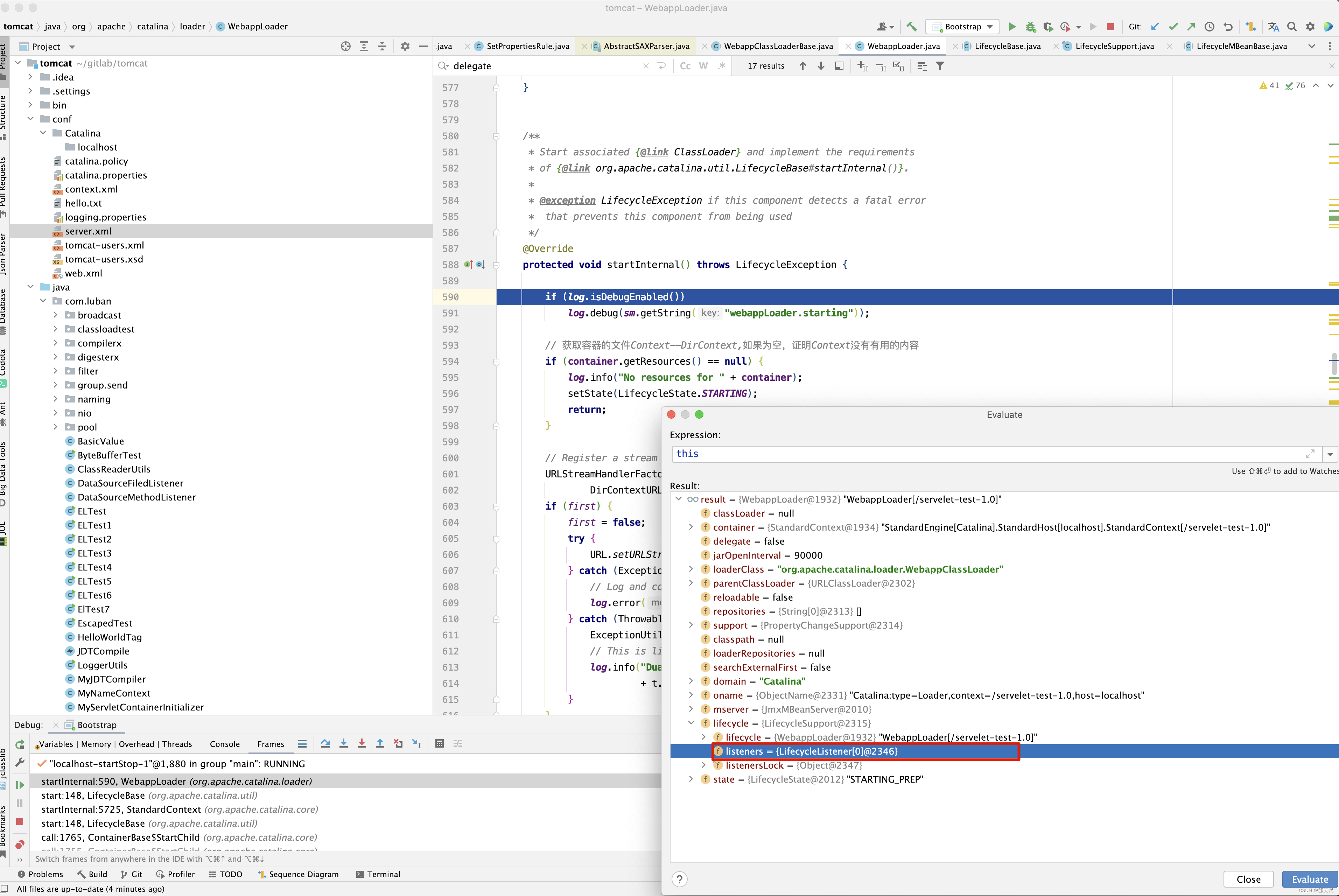
但是庆幸的是WebappLoader没有生命周期监听器,因此省去了很多麻烦 , 直接进入WebappLoader的startInternal()方法 。
protected void startInternal() throws LifecycleException {
if (log.isDebugEnabled())
log.debug(sm.getString("webappLoader.starting"));
// 获取容器的文件Context--DirContext,如果为空,证明Context没有有用的内容
if (container.getResources() == null) {
log.info("No resources for " + container);
setState(LifecycleState.STARTING);
return;
}
// Register a stream handler factory for the JNDI protocol
URLStreamHandlerFactory streamHandlerFactory =
DirContextURLStreamHandlerFactory.getInstance();
if (first) {
// first的作用,保证一个StandardContext的streamHandlerFactory只被设置一次
first = false;
try {
URL.setURLStreamHandlerFactory(streamHandlerFactory);
} catch (Exception e) {
// Log and continue anyway, this is not critical
log.error("Error registering jndi stream handler", e);
} catch (Throwable t) {
ExceptionUtils.handleThrowable(t);
// This is likely a dual registration
log.info("Dual registration of jndi stream handler: "
+ t.getMessage());
}
}
// Construct a class loader based on our current repositories list
try {
classLoader = createClassLoader(); // 创建一个WebappClassLoader
classLoader.setJarOpenInterval(this.jarOpenInterval);
classLoader.setResources(container.getResources());
// 1. 当委托标识delegate 为false时,WebappClassLoader 类加载器首先尝试从本地缓存中查找加载该类,然后用System类加载器尝试加载类。
// 接着由自己的尝试加载类,最后才是由父类加载器(Common)器尝试加载,所以此时它搜索的目录顺序是<JAVA_HOME>/jre/lib -> <JAVA_HOME/jre/lib/ext
// -> CLASSPATH->/WEB-INF/classes -> /WEB-INF/lib -> $CATALINA_BASE/lib 和 CATALINA_HOME/lib
// 2 当委托标识delegate为true时,WebappClassLoader 类加载器首先尝试从本地缓存中查找加载该类,然后用System类加载器尝试加载类,接着由父类 加载器
// (Common)尝试加载类,最后才由自己的尝试加载,所以此时它的搜索目录顺序为<JAVA_HOME>/jre/lib-><JAVA_HOME>/jre/lib/ext -> CLASSPATH
// ->$CATALINA_BASE/lib 和$CATALINA_HOME/lib -> /WEB-INF/classes->/WEB-INF/lib
classLoader.setDelegate(this.delegate);
classLoader.setSearchExternalFirst(searchExternalFirst);
if (container instanceof StandardContext) {
classLoader.setAntiJARLocking(
((StandardContext) container).getAntiJARLocking());
classLoader.setClearReferencesRmiTargets(
((StandardContext) container).getClearReferencesRmiTargets());
classLoader.setClearReferencesStatic(
((StandardContext) container).getClearReferencesStatic());
classLoader.setClearReferencesStopThreads(
((StandardContext) container).getClearReferencesStopThreads());
classLoader.setClearReferencesStopTimerThreads(
((StandardContext) container).getClearReferencesStopTimerThreads());
classLoader.setClearReferencesHttpClientKeepAliveThread(
((StandardContext) container).getClearReferencesHttpClientKeepAliveThread());
classLoader.setClearReferencesObjectStreamClassCaches(
((StandardContext) container).getClearReferencesObjectStreamClassCaches());
classLoader.setClearReferencesThreadLocals(
((StandardContext) container).getClearReferencesThreadLocals());
}
for (int i = 0; i < repositories.length; i++) {
classLoader.addRepository(repositories[i]);
}
// Configure our repositories
setRepositories(); // 将/WEB-INF/classes和/WEB-INF/lib目录添加到WebappClassLoader的Repository中,以后将从Repository中寻找并加载类
setClassPath(); // 设置当前加载器的classpath,应该是只有在jsp中用到
setPermissions();
((Lifecycle) classLoader).start(); // 调用WebappClassLoaderBase.start(),赋值webInfClassesCodeBase属性,这个属性不知道哪里会用到,表示web-inf/classes目录
// Binding the Webapp class loader to the directory context
// 类加载器与DirContext的一个映射关系
DirContextURLStreamHandler.bind(classLoader,
this.container.getResources());
// 注册jmx
StandardContext ctx=(StandardContext)container;
String contextName = ctx.getName();
if (!contextName.startsWith("/")) {
contextName = "/" + contextName;
}
ObjectName cloname = new ObjectName
(MBeanUtils.getDomain(ctx) + ":type=WebappClassLoader,context="
+ contextName + ",host=" + ctx.getParent().getName());
Registry.getRegistry(null, null)
.registerComponent(classLoader, cloname, null);
} catch (Throwable t) {
t = ExceptionUtils.unwrapInvocationTargetException(t);
ExceptionUtils.handleThrowable(t);
log.error( "LifecycleException ", t );
throw new LifecycleException("start: ", t);
}
// 设置StandardContext的生命周期状态为启动中
setState(LifecycleState.STARTING);
}
private WebappClassLoaderBase createClassLoader()
throws Exception {
// 创建一个类加载器WebappClassLoader
Class<?> clazz = Class.forName(loaderClass);
WebappClassLoaderBase classLoader = null;
if (parentClassLoader == null) {
// 父加载器为容器的父加载器
parentClassLoader = container.getParentClassLoader();
}
// 下面的代码相当于 classLoader = new WebappClassLoader(parentClassLoader);
Class<?>[] argTypes = { ClassLoader.class };
Object[] args = { parentClassLoader };
Constructor<?> constr = clazz.getConstructor(argTypes);
classLoader = (WebappClassLoaderBase) constr.newInstance(args);
return classLoader;
}
接下来看setRepositories()方法实现。
private void setRepositories() throws IOException { // 如果非StandardContext,则不设置 if (!(container instanceof Context)) return; ServletContext servletContext = ((Context) container).getServletContext(); if (servletContext == null) return; loaderRepositories=new ArrayList<String>(); // Loading the work directory ,工作目录 File workDir = (File) servletContext.getAttribute("javax.servlet.context.tempdir"); if (workDir == null) { log.info("No work dir for " + servletContext); } if( log.isDebugEnabled() && workDir != null) log.debug(sm.getString("webappLoader.deploy", workDir.getAbsolutePath())); // 设置类加载器的工作目录 // /Users/quyixiao/gitlab/tomcat/work/Catalina/localhost/servelet-test-1.0 classLoader.setWorkDir(workDir); // 获取Context对应的文件目录DirContext DirContext resources = container.getResources(); // Setting up the class repository (/WEB-INF/classes), if it exists String classesPath = "/WEB-INF/classes"; DirContext classes = null; try { // 从文件目录DirContext查找"/WEB-INF/classes"文件目录 Object object = resources.lookup(classesPath); if (object instanceof DirContext) { classes = (DirContext) object; } } catch(NamingException e) { // Silent catch: it's valid that no /WEB-INF/classes collection // exists } if (classes != null) { File classRepository = null; String absoluteClassesPath = servletContext.getRealPath(classesPath); // 如果是一个绝对路径 if (absoluteClassesPath != null) { classRepository = new File(absoluteClassesPath); } else { classRepository = new File(workDir, classesPath); if (!classRepository.mkdirs() && !classRepository.isDirectory()) { throw new IOException( sm.getString("webappLoader.mkdirFailure")); } if (!copyDir(classes, classRepository)) { throw new IOException( sm.getString("webappLoader.copyFailure")); } } if(log.isDebugEnabled()) log.debug(sm.getString("webappLoader.classDeploy", classesPath, classRepository.getAbsolutePath())); // Adding the repository to the class loader // 将"/WEB-INF/classes"目录添加到类加载器仓库中 classLoader.addRepository(classesPath + "/", classRepository); /** * Repositories that are set in the loader, for JMX. * 存了/WEB-INF/classes路径 * 存了/WEB-INF/lib目录下的所有jar包的路径 */ loaderRepositories.add(classesPath + "/" ); } // Setting up the JAR repository (/WEB-INF/lib), if it exists String libPath = "/WEB-INF/lib"; // 设置类加载器的jar包路径 classLoader.setJarPath(libPath); DirContext libDir = null; // Looking up directory /WEB-INF/lib in the context try { Object object = resources.lookup(libPath); if (object instanceof DirContext) libDir = (DirContext) object; } catch(NamingException e) { // Silent catch: it's valid that no /WEB-INF/lib collection // exists } if (libDir != null) { boolean copyJars = false; String absoluteLibPath = servletContext.getRealPath(libPath); File destDir = null; // /Users/quyixiao/gitlab/tomcat/webapps/servelet-test-1.0/WEB-INF/lib // 如果是绝对路径 if (absoluteLibPath != null) { destDir = new File(absoluteLibPath); } else { copyJars = true; destDir = new File(workDir, libPath); if (!destDir.mkdirs() && !destDir.isDirectory()) { throw new IOException( sm.getString("webappLoader.mkdirFailure")); } } // Looking up directory /WEB-INF/lib in the context NamingEnumeration<NameClassPair> enumeration = null; try { enumeration = libDir.list(""); } catch (NamingException e) { IOException ioe = new IOException(sm.getString( "webappLoader.namingFailure", libPath)); ioe.initCause(e); throw ioe; } // 便利"/WEB-INF/lib"目录下的jar包 while (enumeration.hasMoreElements()) { NameClassPair ncPair = enumeration.nextElement(); String filename = libPath + "/" + ncPair.getName(); if (!filename.endsWith(".jar")) continue; // Copy JAR in the work directory, always (the JAR file // would get locked otherwise, which would make it // impossible to update it or remove it at runtime) // 如 /Users/quyixiao/gitlab/tomcat/webapps/servelet-test-1.0/WEB-INF/lib/commons-codec-1.11.jar File destFile = new File(destDir, ncPair.getName()); if( log.isDebugEnabled()) log.debug(sm.getString("webappLoader.jarDeploy", filename, destFile.getAbsolutePath())); // Bug 45403 - Explicitly call lookup() on the name to check // that the resource is readable. We cannot use resources // returned by listBindings(), because that lists all of them, // but does not perform the necessary checks on each. Object obj = null; try { obj = libDir.lookup(ncPair.getName()); } catch (NamingException e) { IOException ioe = new IOException(sm.getString( "webappLoader.namingFailure", filename)); ioe.initCause(e); throw ioe; } if (!(obj instanceof Resource)) continue; Resource jarResource = (Resource) obj; if (copyJars) { // 将jar包一个个复制到工作目录下,如果复制失败,则抛出异常 if (!copy(jarResource.streamContent(), new FileOutputStream(destFile))) { throw new IOException( sm.getString("webappLoader.copyFailure")); } } try { JarFile jarFile = JreCompat.getInstance().jarFileNewInstance(destFile); // 把jar添加到类加载器中 classLoader.addJar(filename, jarFile, destFile); } catch (Exception ex) { // Catch the exception if there is an empty jar file // Should ignore and continue loading other jar files // in the dir } loaderRepositories.add( filename ); } } } /** * 添加一个资源到仓库中,类加载器能在这些资源中寻找类并进行加载 * repository表示资源的名字,比如一个目录路径、jar包文件路径、zip文件路径 * 其实这个方法只有一个地方调用了,传入进来的是repository=/WEB-INF/classes/, file为/WEB-INF/classes/的绝对路径file */ synchronized void addRepository(String repository, File file) { // Note : There should be only one (of course), but I think we should // keep this a bit generic if (repository == null) return; if (log.isDebugEnabled()) log.debug("addRepository(" + repository + ")"); int i; // Add this repository to our internal list // 将资源路径添加到repositories数组中 String[] result = new String[repositories.length + 1]; for (i = 0; i < repositories.length; i++) { result[i] = repositories[i]; } result[repositories.length] = repository; repositories = result; // Add the file to the list // 将资源文件或目录添加到files数组中 File[] result2 = new File[files.length + 1]; for (i = 0; i < files.length; i++) { result2[i] = files[i]; } result2[files.length] = file; files = result2; }
setRepositories()方法没有什么技术含量,细心一点就可以看明白 ,但需要注意调用setRepositories()方法后classLoader和WebappLoader的属性值如下 
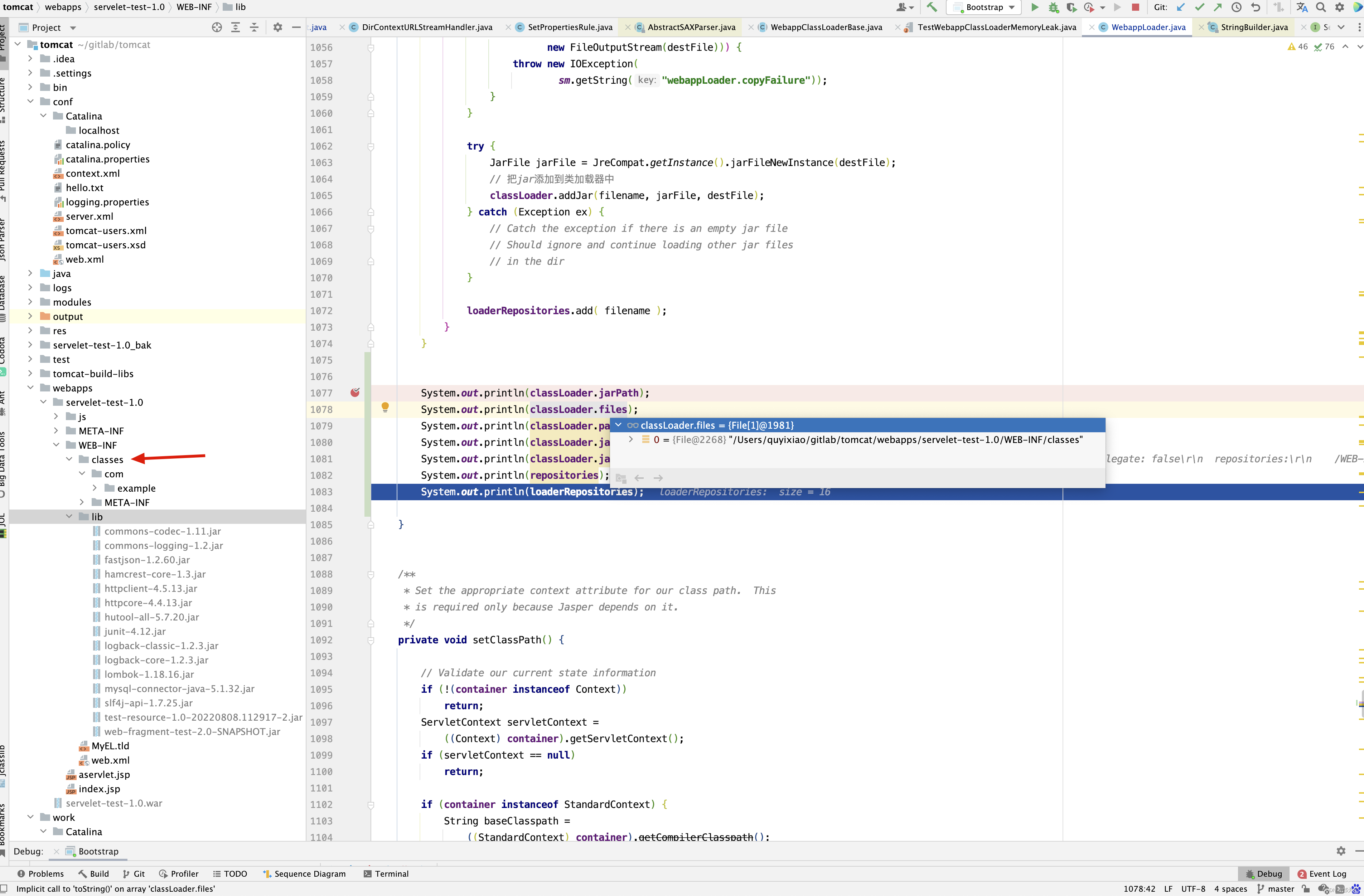
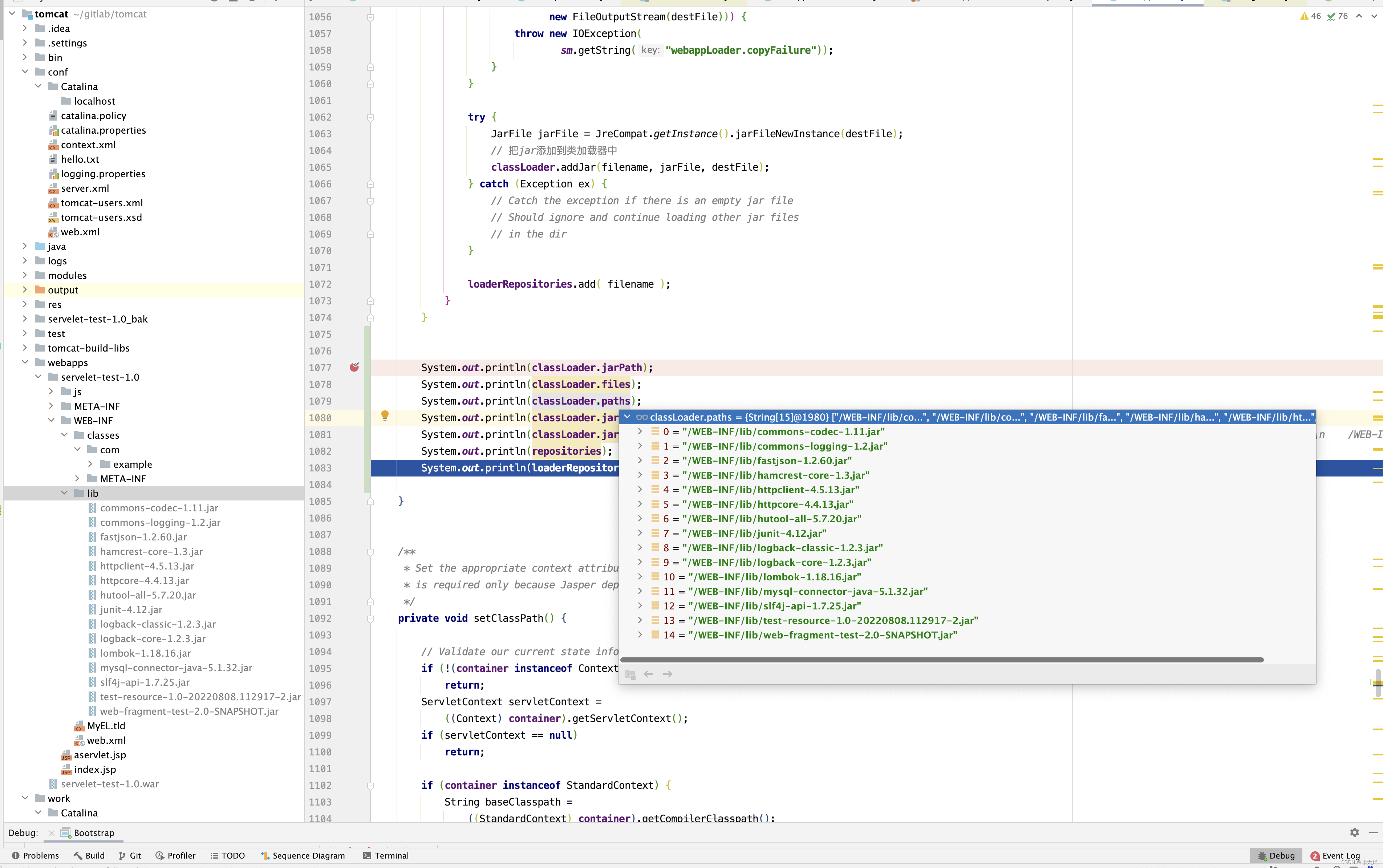
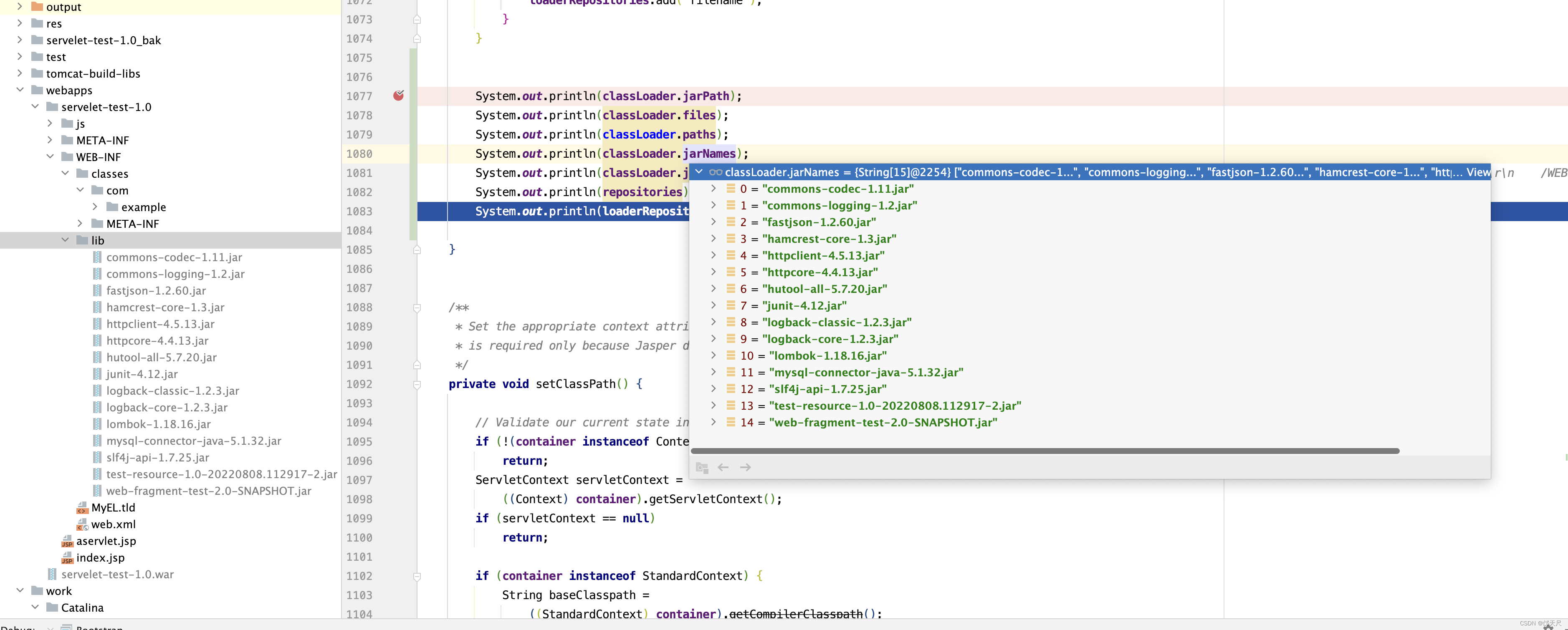


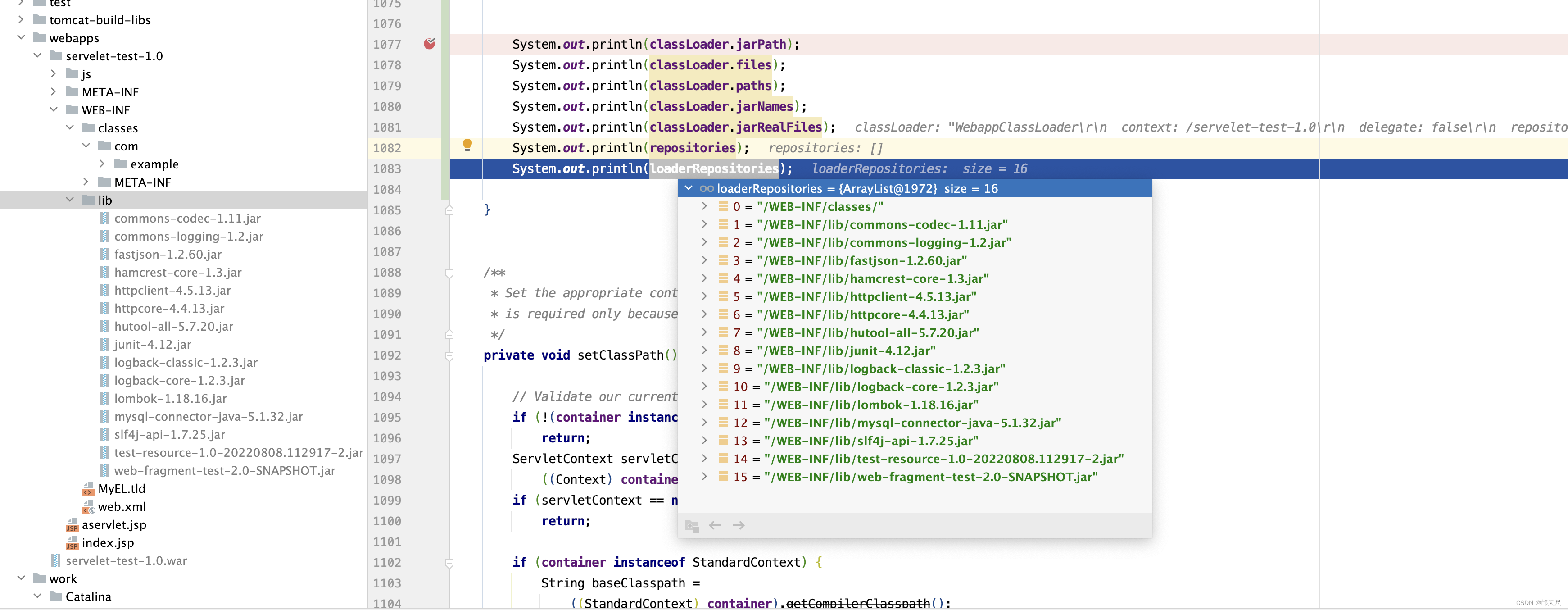
接下来看setClassPath()方法 。
private void setClassPath(){ // Validate our current state information if (!(container instanceof Context)) return; ServletContext servletContext = ((Context) container).getServletContext(); if (servletContext == null) return; if (container instanceof StandardContext) { String baseClasspath = ((StandardContext) container).getCompilerClasspath(); if (baseClasspath != null) { servletContext.setAttribute(Globals.CLASS_PATH_ATTR, baseClasspath); return; } } StringBuilder classpath = new StringBuilder(); // Assemble the class path information from our class loader chain ClassLoader loader = getClassLoader(); // 如果委托给父类,则直接从父类加载器开始组装classpath链,然后把本应用的类加载器中的资源放在最后 if (delegate && loader != null) { // Skip the webapp loader for now as delegation is enabled loader = loader.getParent(); } // 如果delegate为false,WebappClassLoader类加载器首先尝试从本地缓存中查找该类,然后用System类加载器尝试加载类, // 接着由自己尝试加载类,最后才由父类加载器(Common)尝试加载,所以它的搜索目录顺序是 // /jre/lib->/jre/lib/ext->CLASSPATH->/WEB-INF/classes->/WEB-INF/lib-> // $CATALINA_BASE/lib和 $CATALINA_HOME/lib 。 while (loader != null) { if (!buildClassPath(servletContext, classpath, loader)) { break; } loader = loader.getParent(); } if (delegate) { // Delegation was enabled, go back and add the webapp paths loader = getClassLoader(); if (loader != null) { buildClassPath(servletContext, classpath, loader); } } this.classpath=classpath.toString(); // Store the assembled class path as a servlet context attribute servletContext.setAttribute(Globals.CLASS_PATH_ATTR, classpath.toString()); } private boolean buildClassPath(ServletContext servletContext, StringBuilder classpath, ClassLoader loader) { if (loader instanceof URLClassLoader) { URL repositories[] = ((URLClassLoader) loader).getURLs(); for (int i = 0; i < repositories.length; i++) { String repository = repositories[i].toString(); if (repository.startsWith("file://")) repository = UDecoder.URLDecode(repository.substring(7)); else if (repository.startsWith("file:")) repository = UDecoder.URLDecode(repository.substring(5)); else if (repository.startsWith("jndi:")) repository = servletContext.getRealPath(repository.substring(5)); else continue; if (repository == null) continue; if (classpath.length() > 0) classpath.append(File.pathSeparator); classpath.append(repository); } } else if (loader == ClassLoader.getSystemClassLoader()){ // Java 9 onwards. The internal class loaders no longer extend // URLCLassLoader String cp = System.getProperty("java.class.path"); if (cp != null && cp.length() > 0) { if (classpath.length() > 0) { classpath.append(File.pathSeparator); } classpath.append(cp); } return false; } else { log.info( "Unknown loader " + loader + " " + loader.getClass()); return false; } return true; }
重点关注this.classpath=classpath.toString();代码的内容,delegate=false的classpath在左测,delegate=true的classpath在右侧。
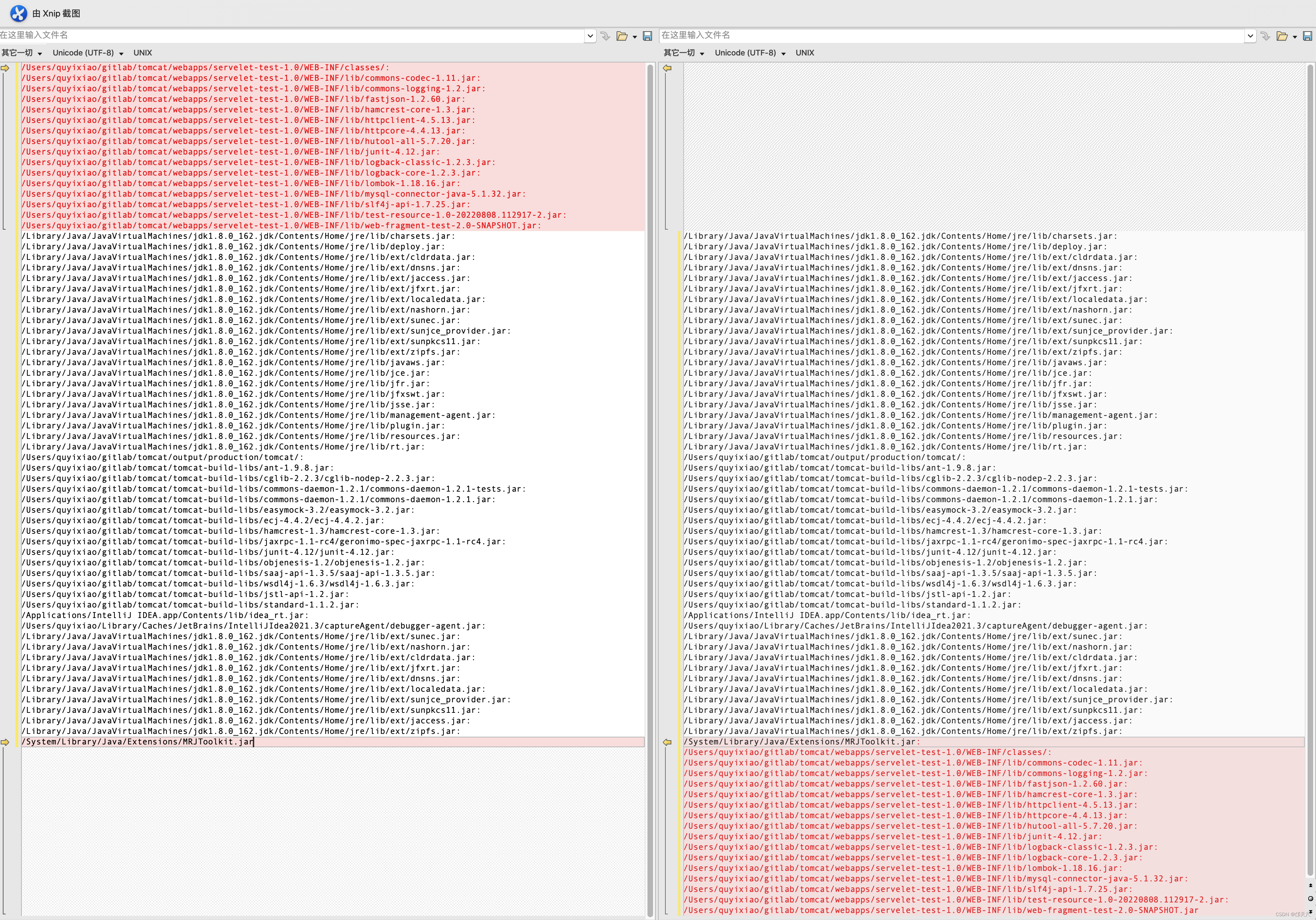
大家现在终于理解delegate="true|false"的实际影响了吧,这部分内容 :
/Users/quyixiao/gitlab/tomcat/webapps/servelet-test-1.0/WEB-INF/classes/:
/Users/quyixiao/gitlab/tomcat/webapps/servelet-test-1.0/WEB-INF/lib/commons-codec-1.11.jar:
/Users/quyixiao/gitlab/tomcat/webapps/servelet-test-1.0/WEB-INF/lib/commons-logging-1.2.jar:
/Users/quyixiao/gitlab/tomcat/webapps/servelet-test-1.0/WEB-INF/lib/fastjson-1.2.60.jar:
/Users/quyixiao/gitlab/tomcat/webapps/servelet-test-1.0/WEB-INF/lib/hamcrest-core-1.3.jar:
/Users/quyixiao/gitlab/tomcat/webapps/servelet-test-1.0/WEB-INF/lib/httpclient-4.5.13.jar:
/Users/quyixiao/gitlab/tomcat/webapps/servelet-test-1.0/WEB-INF/lib/httpcore-4.4.13.jar:
/Users/quyixiao/gitlab/tomcat/webapps/servelet-test-1.0/WEB-INF/lib/hutool-all-5.7.20.jar:
/Users/quyixiao/gitlab/tomcat/webapps/servelet-test-1.0/WEB-INF/lib/junit-4.12.jar:
/Users/quyixiao/gitlab/tomcat/webapps/servelet-test-1.0/WEB-INF/lib/logback-classic-1.2.3.jar:
/Users/quyixiao/gitlab/tomcat/webapps/servelet-test-1.0/WEB-INF/lib/logback-core-1.2.3.jar:
/Users/quyixiao/gitlab/tomcat/webapps/servelet-test-1.0/WEB-INF/lib/lombok-1.18.16.jar:
/Users/quyixiao/gitlab/tomcat/webapps/servelet-test-1.0/WEB-INF/lib/mysql-connector-java-5.1.32.jar:
/Users/quyixiao/gitlab/tomcat/webapps/servelet-test-1.0/WEB-INF/lib/slf4j-api-1.7.25.jar:
/Users/quyixiao/gitlab/tomcat/webapps/servelet-test-1.0/WEB-INF/lib/test-resource-1.0-20220808.112917-2.jar:
/Users/quyixiao/gitlab/tomcat/webapps/servelet-test-1.0/WEB-INF/lib/web-fragment-test-2.0-SNAPSHOT.jar:
一个在classpath的开头,一个在classpath的结尾 。
最终来看将StandardContext注册到jmx的代码 。
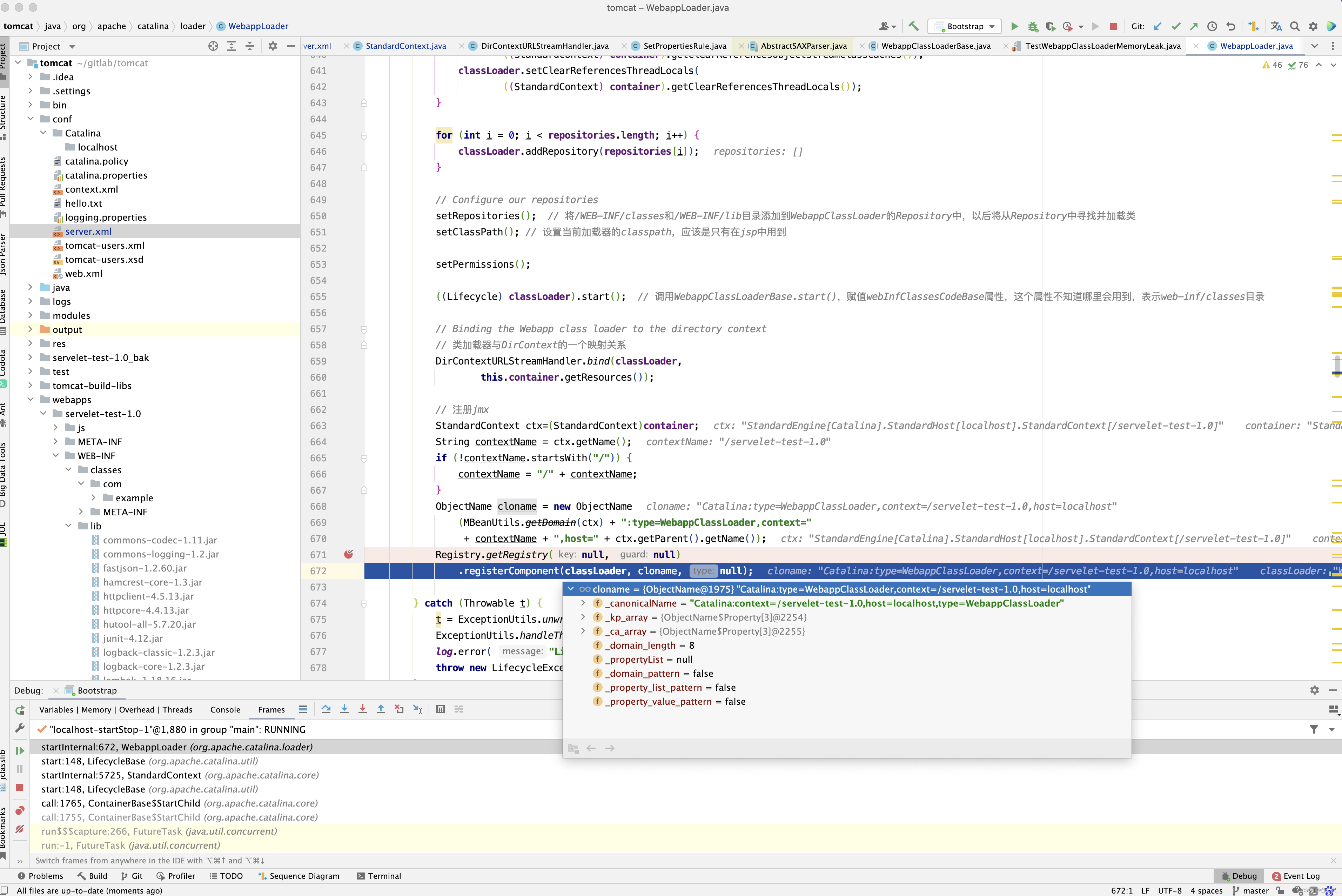
为什么要将StandardContext注册到jmx中呢?实际上是方便管理,在控制台输入jconsole,先看看StandardHost 的相关属性和操作
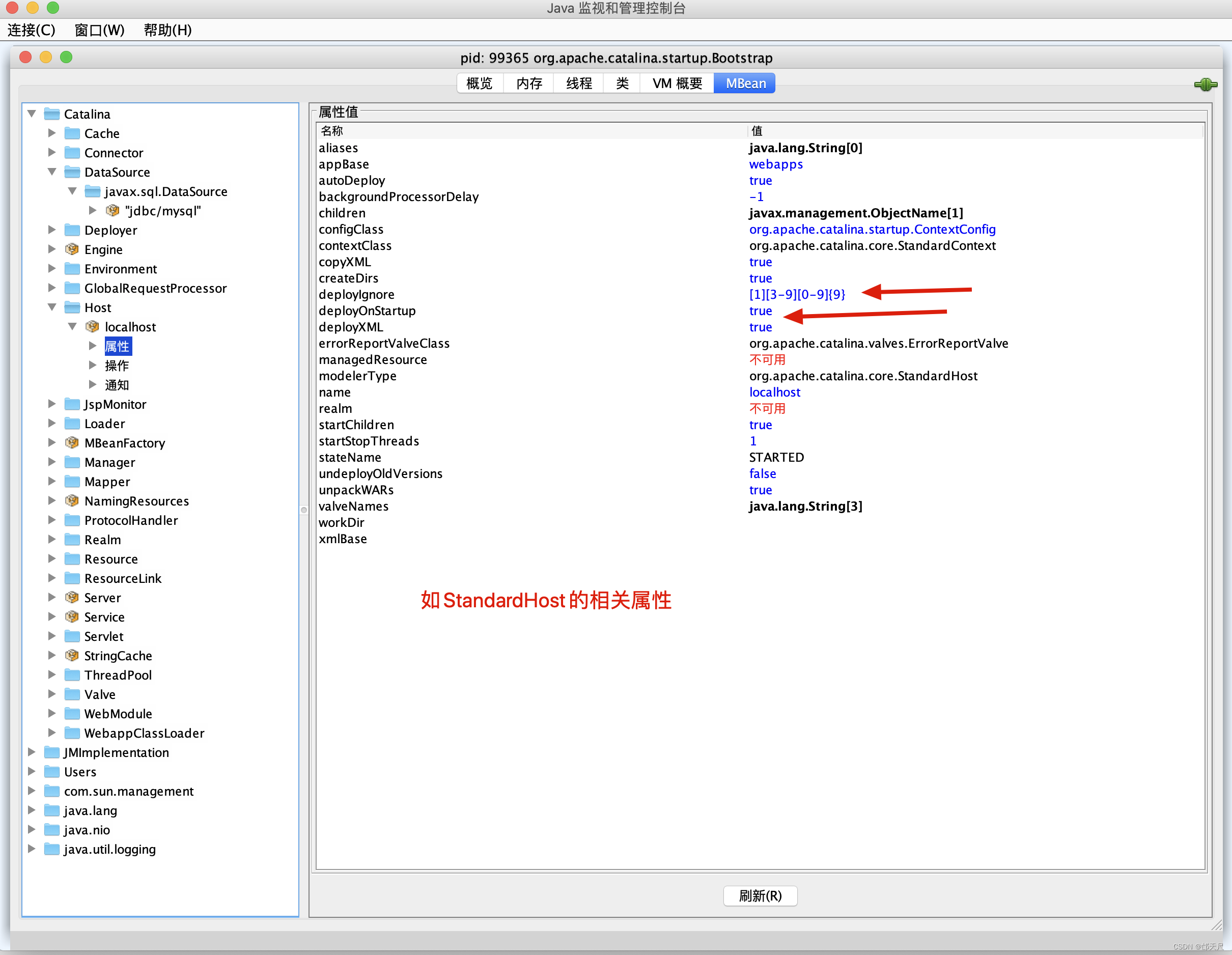

再看看StandardContext的相关属性。

除了这里,还有哪个地方也可以将对象注册到jmx呢?
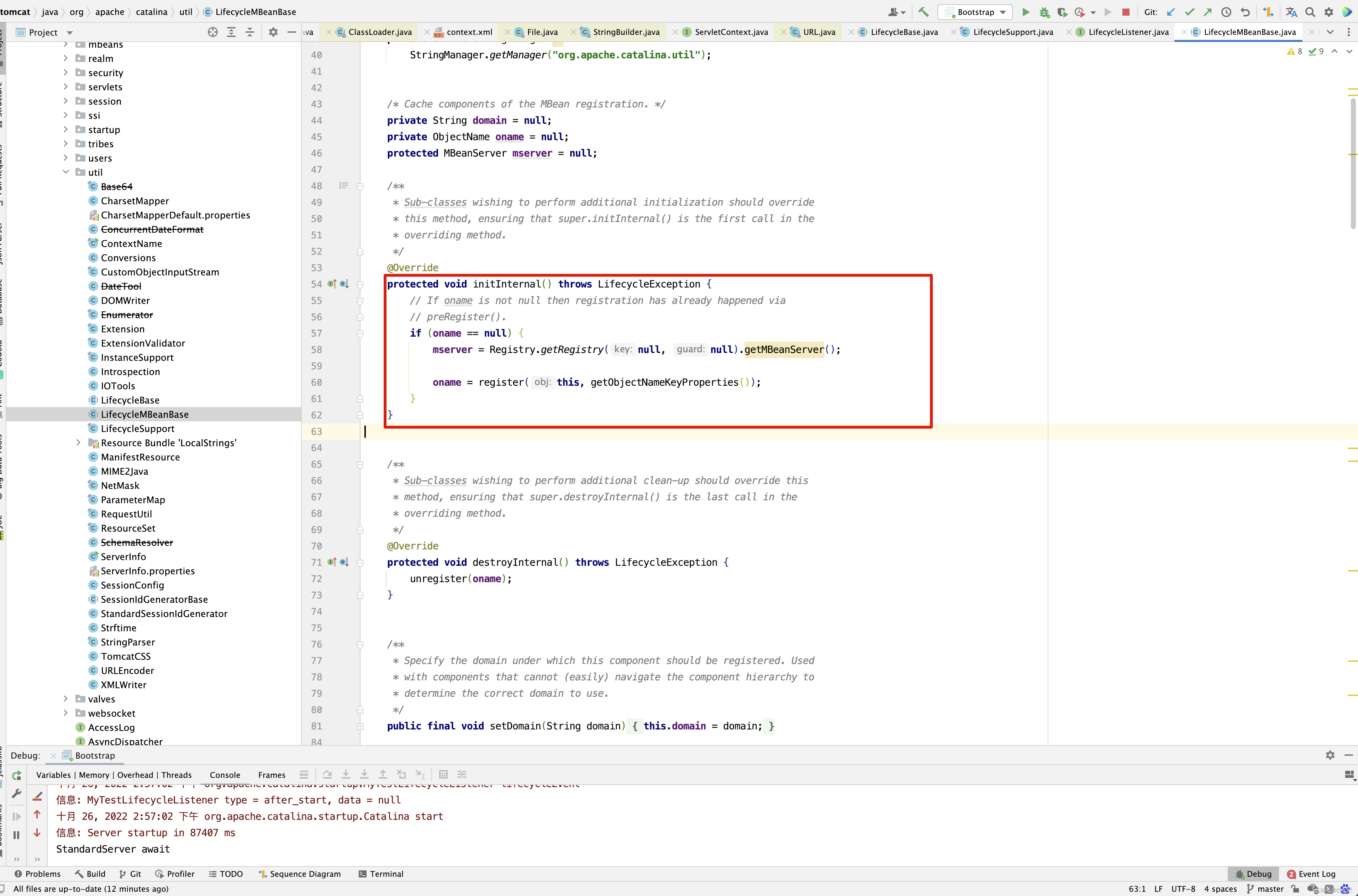
所以有个时候,大家看到这一块代码不知道什么意思,当对象注册到jmx后,我们可以在jconsole界面中对其属性进行修改,方法调用。
关于集群这一块的知识,先放一边吧。太过于复杂了,这里就不深入,接着我们进入fireLifecycleEvent(Lifecycle.CONFIGURE_START_EVENT, null); 这一行代码 。 这里会发送configure_start事件 。

StandardContext中目前有3个监听器对configure_start做监听的。
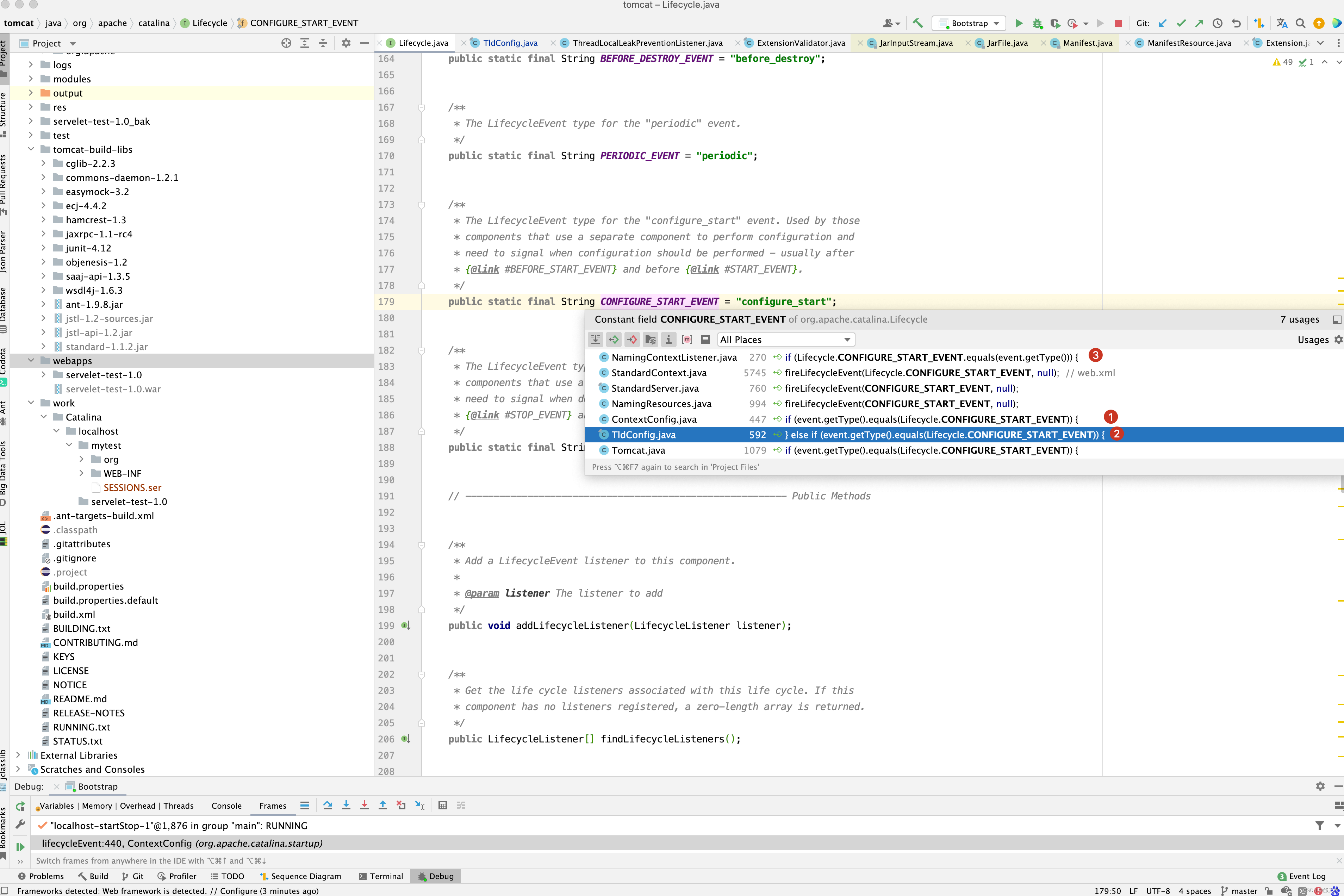
先来看ContextConfig对configure_start事件处理。

configureStart()
进入configureStart()方法 。
protected synchronized void configureStart() { // Called from StandardContext.start() if (log.isDebugEnabled()) log.debug(sm.getString("contextConfig.start")); if (log.isDebugEnabled()) { log.debug(sm.getString("contextConfig.xmlSettings", context.getName(), Boolean.valueOf(context.getXmlValidation()), Boolean.valueOf(context.getXmlNamespaceAware()))); } // 根据web.xml文件对Context进行配置 webConfig(); // 如果StandardContext的ignoreAnnotations为false,则解析应用程序注解配置,添加相关的JNDI资源引用 if (!context.getIgnoreAnnotations()) { applicationAnnotationsConfig(); } if (ok) { validateSecurityRoles(); } // Configure an authenticator if we need one // 用户验证配置 if (ok) authenticatorConfig(); // Dump the contents of this pipeline if requested if ((log.isDebugEnabled()) && (context instanceof ContainerBase)) { log.debug("Pipeline Configuration:"); Pipeline pipeline = ((ContainerBase) context).getPipeline(); Valve valves[] = null; if (pipeline != null) valves = pipeline.getValves(); if (valves != null) { for (int i = 0; i < valves.length; i++) { log.debug(" " + valves[i].getInfo()); } } } // Make our application available if no problems were encountered // Context已经配置成功,可以使用了 if (ok) context.setConfigured(true); else { log.error(sm.getString("contextConfig.unavailable")); context.setConfigured(false); } }
- 先来看webConfig() 方法的实现。
protected void webConfig() { Set<WebXml> defaults = new HashSet<WebXml>(); // 1. 解析默认的配置,生成WebXml对象(Tomcat使用该对象表示web.xml的解析结果),先解析容器级别的配置,然后再解析Host级别的配置。 // 这样对于同名的配置,Host级别将覆盖容器级别,为了便于后续过程描述,我们暂且称为 "默认WebXml",为了提升性能,ContextConfig // 对默认的WebXml进行了缓存,以避免重复解析 defaults.add(getDefaultWebXmlFragment()); WebXml webXml = createWebXml(); // Parse context level web.xml // 2. 解析web.xml文件,如果StandardContext的altDDName不为空,则将该属性指向文件作为web.xml,否则使用默认的路径,即WEB-INF/web.xml // 解析结果同样为WebXml对象(此时创建的对象主为主WebXml),其他的解析结果要合并到该对象上来,暂时将其称为主WebXml InputSource contextWebXml = getContextWebXmlSource(); // 解析默认WEB-INF/web.xml parseWebXml(contextWebXml, webXml, false); ServletContext sContext = context.getServletContext(); // Ordering is important here // Step 1. Identify all the JARs packaged with the application // If the JARs have a web-fragment.xml it will be parsed at this // point. // 3. 扫描Web应用所有的Jar包,如果包含META-INF/web-fragment.xml,则解析文件并创建WebXml对象,暂时将其称为片断WebXml Map<String,WebXml> fragments = processJarsForWebFragments(webXml); // Step 2. Order the fragments. Set<WebXml> orderedFragments = null; // 4. 将web-fragment.xml创建的WebXml对象按照Servlet规范进行排序,同时将排序结果对应的JAR文件名列表设置到ServletContext属性中 // 属性名为javax.servlet.context.orderedLibs,该排序非常重要,因为这决定了Filter等执行顺序 。 // 【注意】:尽管Servlet规范定义了web-fragment.xml的排序(绝对排序和相对排序),但是为了降低各个模块的耦合度,Web应用在定义web-fragment.xml // 时应尽量保证相对独立性,减少相互间的依赖,将产生依赖过多的配置尝试放到web.xml中 orderedFragments = WebXml.orderWebFragments(webXml, fragments, sContext); // Step 3. Look for ServletContainerInitializer implementations // 处理ServletContainerInitializers if (ok) { // 5.查找ServletContainerInitializer实现,并创建实例,查找范围分为两部分。 // 5.1 Web应用下的包,如果javax.servlet.context.orderedLibs不为空,仅搜索该属性包含的包,否则搜索WEB-INF/lib下所有的包 // 5.2 容器包:搜索所有的包 // Tomcat返回查找结果列表时,确保Web应用的顺序的容器后,因此容器中实现将先加载 。 // 6. 根据ServletContainerInitializer查询结果以及javax.servlet.annotation.HandleTypes 注解配置,初始化typeInitializerMap和 // initializerClassMap 两个映射(主要用于后续注解检测),前者表示类对应ServletContainerInitializer集合,而后者表示每个 // ServletContainerInitializer 对应的类的集合,具体类由javax.servlet.annotation.HandleTypes注解指定。 processServletContainerInitializers(); } // 7. 当主WebXml 的metadataComplete为false,或者typeInitializerMap不为空时 if (!webXml.isMetadataComplete() || typeInitializerMap.size() > 0) { // Steps 4 & 5. // 检测javax.servlet.annotation.HandlesTypes注解 // 当WebXml的metadataComplete为false, 查找javax.servlet.annotation.WebServlet ,javax.servlet.annotation.WebFilter // javax.servlet.annotation.WebListener注解配置, 将其合并到WebXml // 处理JAR包内的注解,只处理包含web-fragment.xml的JAR,对于JAR包中的每个类做如下处理。 // 检测javax.servlet.annotation.HandlesTypes注解 // 当 "主WebXml"和片段"WebXml"的metadataComplete均为false,查找javax.servlet.annotation.WebServlet,javax.servlet.annotation.WebFilter // javax.servlet.annotation.WebListener注解配置,将其合并到"片段WebXml" processClasses(webXml, orderedFragments); } if (!webXml.isMetadataComplete()) { // Step 6. Merge web-fragment.xml files into the main web.xml // file. if (ok) { // 如果"主WebXml"的metadataComple为false, 将所有的片段WebXml按照排序合并到"WebXml"中 ok = webXml.merge(orderedFragments); } // Step 7. Apply global defaults // Have to merge defaults before JSP conversion since defaults // provide JSP servlet definition. // 9 将默认的"WebXml" 合并到"主WebXml"中 webXml.merge(defaults); // Step 8. Convert explicitly mentioned jsps to servlets if (ok) { // 配置JspServlet,对于当前Web应用中JspFile属性不为空的Servlet,将其servletClass设置为org.apache.jsper.servlet.JspServlet // (Tomcat提供了JSP引擎),将JspFile设置为Servlet初始化参数,同时将名称 "jsp" 的Servlet(见conf/web.xml) 的初始化参数也 // 复制到该Servlet中 convertJsps(webXml); } // Step 9. Apply merged web.xml to Context if (ok) { // 使用"主WebXml"配置当前StandardContext ,包括Servlet,Filter,Listener 等Servlet 规范中支持的组件,对于ServletContext // 层级对象,直接由StandardContext维护,对于Servlet,则创建StandardWrapper子对象,并添加StandardContext实例。 webXml.configureContext(context); } } else { webXml.merge(defaults); // 默认情况下, defaults就是conf/web.xml文件对应的WebXml对象 convertJsps(webXml); // 将jsp转化为Servlet webXml.configureContext(context); // 根据webxml配置context,比如把定义的servlet转化为wrapper,然后添加到StandardContext中,还包括很多其他的 } // Step 9a. Make the merged web.xml available to other // components, specifically Jasper, to save those components // from having to re-generate it. // TODO Use a ServletContainerInitializer for Jasper // 将合并后的WebXml保存到ServletContext属性中,便于后续处理复用,属性名为org.apache.tomcat.util.scan.MergeWebXml String mergedWebXml = webXml.toXml(); sContext.setAttribute( org.apache.tomcat.util.scan.Constants.MERGED_WEB_XML, mergedWebXml); if (context.getLogEffectiveWebXml()) { log.info("web.xml:\n" + mergedWebXml); } // Always need to look for static resources // Step 10. Look for static resources packaged in JARs if (ok) { // Spec does not define an order. // Use ordered JARs followed by remaining JARs Set<WebXml> resourceJars = new LinkedHashSet<WebXml>(); for (WebXml fragment : orderedFragments) { // resourceJars.add(fragment); } for (WebXml fragment : fragments.values()) { if (!resourceJars.contains(fragment)) { resourceJars.add(fragment); } } // 查找JAR 包的"META-INF/resource/"下的静态资源,并添加到StandardContext中 processResourceJARs(resourceJars); // See also StandardContext.resourcesStart() for // WEB-INF/classes/META-INF/resources configuration } // Step 11. Apply the ServletContainerInitializer config to the // context if (ok) { // 将ServletContainerInitializer 扫描结果添加到StandardContext,以便StandardContext启动时使用 for (Map.Entry<ServletContainerInitializer, Set<Class<?>>> entry : initializerClassMap.entrySet()) { if (entry.getValue().isEmpty()) { context.addServletContainerInitializer( entry.getKey(), null); } else { context.addServletContainerInitializer( entry.getKey(), entry.getValue()); } } } // 至此,StandardContext 在正式启动StandardWrapper子对象之前,完成了Web 应用容器的初始化,包括Servlet规范中的各类组件,注解 // 以及可编程方式的支持 // 应用程序注解配置 // 当StandardContext 的ignoreAnnotations 为false时,Tomcat 支持读取如下接口的Java命名服务注解配置,添加相关的JNDI 引用,以便 // 在实例化相关的接口时,进行JNDI 资源依赖注入 . // 支持读取接口如下 : // Web应用程序监听器 // javax.servlet.ServletContextAttributeListener // javax.servlet.ServletRequestListener // javax.servlet.http.HttpSessionAttributeListener // javax.servlet.http.HttpSessionListener // javax.servlet.ServletContextListener // javax.servlet.Filter // javax.servlet. Servlet // 支持读取注解包括注解,属性注解,方法注解,具体注解如下 // 类:javax.annotion.Resource ,javax.annotation.Resources // 属性和方法:javax.annotation.Resource }
应用程序的web.xml优先于主机级别或全局级别的根据配置创建Wrapper(Servlet),Filter,ServletContextListener等,完成Web容器的初始化,除了解析Web应用目录下的Web.xml外,还包括Tomcat默认配置,web-fragment.xml ,ServletContainerInitializer,以及相关的XML文件的排序和合并。
来看看获取默认的WebXml实现。
private WebXml getDefaultWebXmlFragment() { // Host should never be null Host host = (Host) context.getParent(); // 从缓存里面获取WebXml对象 DefaultWebXmlCacheEntry entry = hostWebXmlCache.get(host); // 获取全局范围内的web.xml文件InputSource,在默认情况下就是取catalina.base目录下的conf/web.xml文件 // 如 file:/Users/quyixiao/gitlab/tomcat/conf/web.xml InputSource globalWebXml = getGlobalWebXmlSource(); // 获取Host范围内的web.xml文件InputSource,在默认情况下就是取catalina.base目录下的conf/engine名字/host名字/web.xml.default // 如 file:/Users/quyixiao/gitlab/tomcat/conf/Catalina/localhost/web.xml/default InputSource hostWebXml = getHostWebXmlSource(); long globalTimeStamp = 0; long hostTimeStamp = 0; // 寻找globalWebXml文件的最近修改时间 if (globalWebXml != null) { URLConnection uc = null; try { URL url = new URL(globalWebXml.getSystemId()); uc = url.openConnection(); globalTimeStamp = uc.getLastModified(); } catch (IOException e) { globalTimeStamp = -1; } finally { if (uc != null) { try { uc.getInputStream().close(); } catch (IOException e) { ExceptionUtils.handleThrowable(e); globalTimeStamp = -1; } } } } // 寻找hostWebXml文件的最近修改时间 if (hostWebXml != null) { URLConnection uc = null; try { URL url = new URL(hostWebXml.getSystemId()); uc = url.openConnection(); hostTimeStamp = uc.getLastModified(); } catch (IOException e) { hostTimeStamp = -1; } finally { if (uc != null) { try { uc.getInputStream().close(); } catch (IOException e) { ExceptionUtils.handleThrowable(e); hostTimeStamp = -1; } } } } // 如果发现找出来的webxml文件和缓存中的webxml文件最近的修改时间相等, // 就代表没有修改过,那么直接返回缓存中的WebXml对象 if (entry != null && entry.getGlobalTimeStamp() == globalTimeStamp && entry.getHostTimeStamp() == hostTimeStamp) { InputSourceUtil.close(globalWebXml); InputSourceUtil.close(hostWebXml); return entry.getWebXml(); } // Parsing global web.xml is relatively expensive. Use a sync block to // make sure it only happens once. Use the pipeline since a lock will // already be held on the host by another thread // 这里用到了双重较验锁 // 解析web.xml文件比较耗时。使用同步块确保只会执行一次。为什么用host.getPipeline()作为锁? // 使用管道,因为另一个线程已在主机上持有锁 synchronized (host.getPipeline()) { // 再一次判断是不是可以直接返回缓存中的WebXML对象,这里使用的是双重判断检查 entry = hostWebXmlCache.get(host); if (entry != null && entry.getGlobalTimeStamp() == globalTimeStamp && entry.getHostTimeStamp() == hostTimeStamp) { return entry.getWebXml(); } // 解析web.xml为WebXml对象 WebXml webXmlDefaultFragment = createWebXml(); webXmlDefaultFragment.setOverridable(true); // Set to distributable else every app will be prevented from being // distributable when the default fragment is merged with the main // web.xml webXmlDefaultFragment.setDistributable(true); // When merging, the default welcome files are only used if the app has // not defined any welcomes files. webXmlDefaultFragment.setAlwaysAddWelcomeFiles(false); // Parse global web.xml if present if (globalWebXml == null) { // This is unusual enough to log log.info(sm.getString("contextConfig.defaultMissing")); } else { parseWebXml(globalWebXml, webXmlDefaultFragment, false); } // Parse host level web.xml if present // Additive apart from welcome pages webXmlDefaultFragment.setReplaceWelcomeFiles(true); parseWebXml(hostWebXml, webXmlDefaultFragment, false); // Don't update the cache if an error occurs if (globalTimeStamp != -1 && hostTimeStamp != -1) { entry = new DefaultWebXmlCacheEntry(webXmlDefaultFragment, globalTimeStamp, hostTimeStamp); hostWebXmlCache.put(host, entry); } return webXmlDefaultFragment; } }
查找全局webxml文件的流程:
- 先确定查找的目录
- 再确定查找的文件名
确定查找目录:
- 如果在Engine上配置了baseDir属性,那么将直接在属性对应的目录下查找
- 如果在Engine上没有配置baseDir属性,那么将在catalina.base所对应的目录下查找
- 如果catalina.base为空,那么将在catalina.home所对应的目录下查找
查找并不是直接找目录下的web.xml文件,而是:
- 如果Context配置了defaultWebXml属性,那么将查找该属性所对应的文件,前提是该属性配置的是相对路径
- 如果Context配置的defaultWebXml属性是绝对路径,那么将直接取该绝对路径所对应的文件
- 如果Context没有配置defaultWebXml属性,那么将查找conf/web.xml
但上面有一行加粗代码需要注意( synchronized (host.getPipeline()) ), 为什么使用StandardHost的管道加锁,而不是使用Host加锁呢, 注释(
// Parsing global web.xml is relatively expensive. Use a sync block to
// make sure it only happens once. Use the pipeline since a lock will
// already be held on the host by another thread)上说有另外一个线程已经使用了Host加锁,到底又是哪个线程呢? 带着疑问,在代码中寻寻觅觅 。
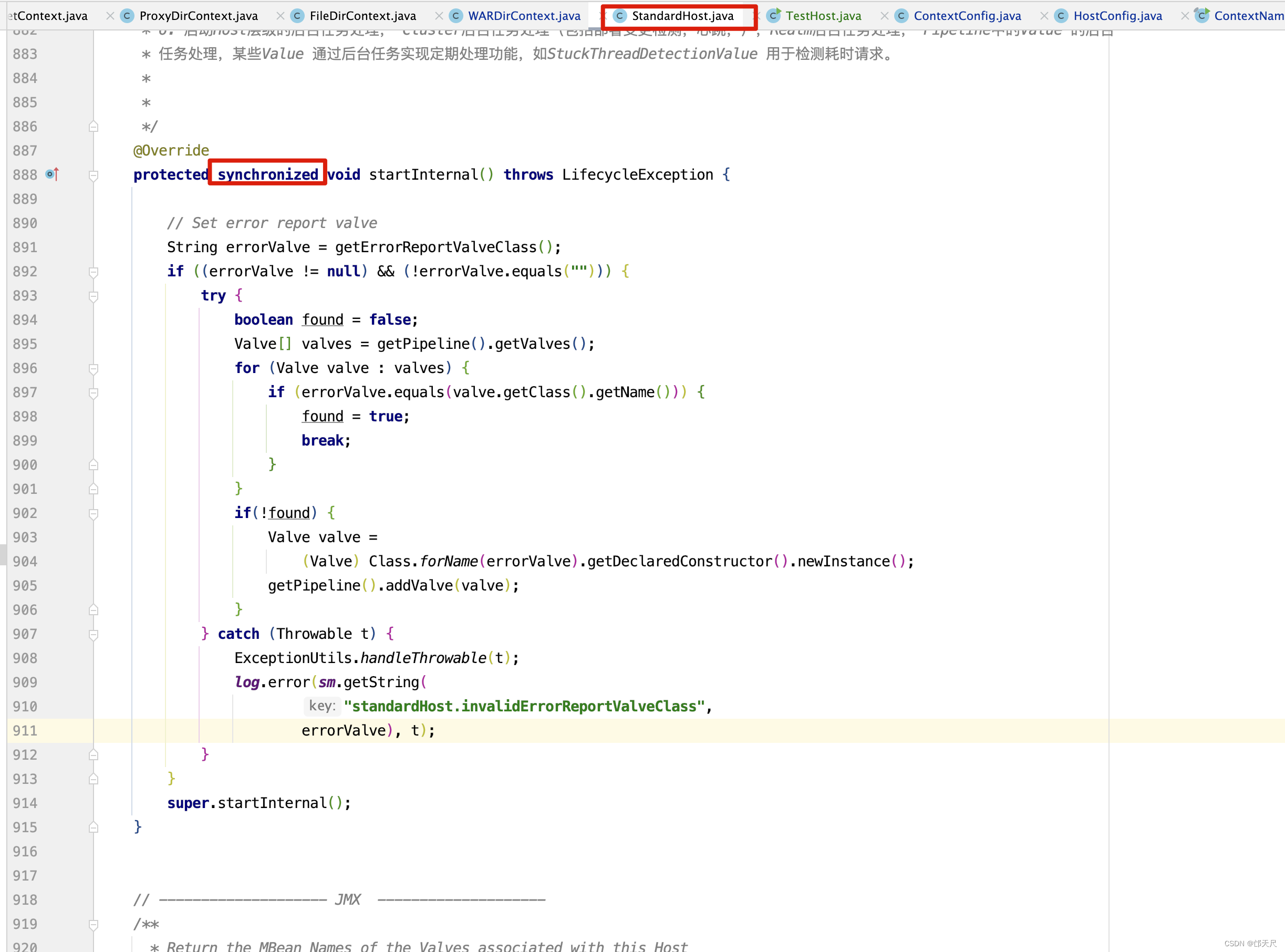
看到没有,StandardHost启动时,就已经对自身加锁了,因为启动StandardContext是一个耗时操作,因此也是用线程池来启动,这样就可以模拟StandardHost和StandardContext启动来做一个实验 。 请看如下例子
public class TestStandardHost {
protected synchronized void startInternal() {
Object obj = this;
new Thread(new Runnable() {
@Override
public void run() {
synchronized (obj){
System.out.println("1");
}
}
}).start();
try {
Thread.sleep(3000);
System.out.println("2");
} catch (InterruptedException e) {
e.printStackTrace();
}
}
public static void main(String[] args) {
TestStandardHost testHost = new TestStandardHost();
testHost.startInternal();
}
}
大家猜猜,结果会输出什么?肯定是
2
1
大家现在应该明白为什么这里解析web.xml时使用host.getPipeline()作为加锁对象了吧,因为解析全局的web.xml本来是StandardContext之间的事情,没有必要和主线程StandardHost所在线程抢锁操作,而每一个容器都有唯一一个StandardPipeline与之对应 ,因此用StandardPipeline作为加锁条件再合适不过。
接下来看全局WebXml资源获取的方法
protected InputSource getGlobalWebXmlSource() { // 首先获取Context上有没有指定defaultWebXml // 如果没有,则获取conf/web.xml目录下的文件 // 将文件转化为InputSource,后续会解析xml // Is a default web.xml specified for the Context? if (defaultWebXml == null && context instanceof StandardContext) { defaultWebXml = ((StandardContext) context).getDefaultWebXml(); } // Set the default if we don't have any overrides if (defaultWebXml == null) getDefaultWebXml(); // Is it explicitly suppressed, e.g. in embedded environment? if (""org/apache/catalina/startup/NO_DEFAULT_XML"".equals(defaultWebXml)) { return null; } return getWebXmlSource(defaultWebXml, getBaseDir()); } public String getDefaultWebXml() { // 如果defaultWebXml为空,则设置为默认的conf/web.xml if( defaultWebXml == null ) { defaultWebXml="conf/web.xml"; } return (this.defaultWebXml); }
接下来,看HostWebXml的获取 。
protected InputSource getHostWebXmlSource() { File hostConfigBase = getHostConfigBase(); if (!hostConfigBase.exists()) return null; // 获取hostConfigBase下的web.xml.default return getWebXmlSource("web.xml.default", hostConfigBase.getPath()); }
getHostConfigBase() 总结
- 如果Host上配置了xmlBase属性,并且该属性是绝对路径的话,将直接把该路径下的web.xml.default文件返回
- 如果Host上配置的xmlBase属性是相对路径,那么将把getBaseDir()+xmlBase路径下的web.xml.default文件返回
- 如果Host上没有配置xmlBase属性,那么将把getBaseDir() + “/conf” + engine名字 + “/” + host名字路径下的web.xml.default文件返回
protected File getHostConfigBase() { File file = null; Container container = context; Host host = null; Engine engine = null; // 赋值host和engine while (container != null) { if (container instanceof Host) { host = (Host)container; } if (container instanceof Engine) { engine = (Engine)container; } container = container.getParent(); } // 如果host配置了xmlBase if (host != null && host.getXmlBase()!=null) { String xmlBase = host.getXmlBase(); file = new File(xmlBase); if (!file.isAbsolute()) file = new File(getBaseDir(), xmlBase); } else { StringBuilder result = new StringBuilder(); if (engine != null) { result.append(engine.getName()).append('/'); } if (host != null) { result.append(host.getName()).append('/'); } // 如果host没有配置xmlBase,那么则获取getBaseDir()下conf目录下的--engine名字+"/"+host名字--的配置文件 file = new File (getConfigBase(), result.toString()); } try { // 返回绝对路径 return file.getCanonicalFile(); } catch (IOException e) { return file; } } protected File getConfigBase() { File configBase = new File(getBaseDir(), "conf"); if (!configBase.exists()) { return null; } return configBase; } // 先获取Engine上配置的baseDir // 如果Engine上没有配置baseDir,那么则获取环境变量catalina.base所指定的路径 // 如果catalina.base没有指定路径,那么则获取环境变量catalina.home所指定的路径 protected String getBaseDir() { Container engineC=context.getParent().getParent(); if( engineC instanceof StandardEngine ) { // 注意getBaseDir()方法内的实现 return ((StandardEngine)engineC).getBaseDir(); } return System.getProperty("catalina.base"); }
确定Host配置文件基本路径----就是我要找某个配置文件时,要从这个目录下去找
步骤如下:
- 如果Host上配置了xmlBase属性,并且该属性是绝对路径的话,将直接以该路径作为基本路径
- 如果Host上配置的xmlBase属性是相对路径,那么将以getBaseDir()+xmlBase做为基本路径
- 如果Host上没有配置xmlBase属性,那么将以getBaseDir() + “/conf” + engine名字 + “/” + host名字作为基本路径
接下来看, parseWebXml()的实现。
protected void parseWebXml(InputSource source, WebXml dest, boolean fragment) { if (source == null) return; XmlErrorHandler handler = new XmlErrorHandler(); Digester digester; WebRuleSet ruleSet; //fragment为false,则对web.xml解析 // 如果fragment为true,则对web-fragment.xml解析 if (fragment) { digester = webFragmentDigester; ruleSet = webFragmentRuleSet; } else { digester = webDigester; ruleSet = webRuleSet; } // 将解析的值封装到WebXml中 digester.push(dest); digester.setErrorHandler(handler); if(log.isDebugEnabled()) { log.debug(sm.getString("contextConfig.applicationStart", source.getSystemId())); } try { digester.parse(source); if (handler.getWarnings().size() > 0 || handler.getErrors().size() > 0) { ok = false; handler.logFindings(log, source.getSystemId()); } } catch (SAXParseException e) { log.error(sm.getString("contextConfig.applicationParse", source.getSystemId()), e); log.error(sm.getString("contextConfig.applicationPosition", "" + e.getLineNumber(), "" + e.getColumnNumber())); ok = false; } catch (Exception e) { log.error(sm.getString("contextConfig.applicationParse", source.getSystemId()), e); ok = false; } finally { digester.reset(); ruleSet.recycle(); InputSourceUtil.close(source); } }
看Context 的 WebXml获取
protected InputSource getContextWebXmlSource() { InputStream stream = null; InputSource source = null; URL url = null; String altDDName = null; // Open the application web.xml file, if it exists ServletContext servletContext = context.getServletContext(); try { if (servletContext != null) { altDDName = (String)servletContext.getAttribute("org.apache.catalina.deploy.alt_dd"); if (altDDName != null) { try { stream = new FileInputStream(altDDName); url = new File(altDDName).toURI().toURL(); } catch (FileNotFoundException e) { log.error(sm.getString("contextConfig.altDDNotFound", altDDName)); } catch (MalformedURLException e) { log.error(sm.getString("contextConfig.applicationUrl")); } } else { //一个 Tomcat 部署必须有一个主机如果该上下文使用 ContextConfig 来配置。原 因如下: //ContextConfig 需要应用文件 web.xml 的位置,它在它的 applicationConfig 方 法中尝试打开该文件,下面是该方法的片段: stream = servletContext.getResourceAsStream ("/WEB-INF/web.xml"); try { url = servletContext.getResource( "/WEB-INF/web.xml"); } catch (MalformedURLException e) { log.error(sm.getString("contextConfig.applicationUrl")); } } } if (stream == null || url == null) { if (log.isDebugEnabled()) { log.debug(sm.getString("contextConfig.applicationMissing") + " " + context); } } else { source = new InputSource(url.toExternalForm()); source.setByteStream(stream); } } finally { if (source == null && stream != null) { try { stream.close(); } catch (IOException e) { // Ignore } } } return source; }
上面这个方法的逻辑很简单,就是看ServletContext中是否有org.apache.catalina.deploy.alt_dd属性,如果有,则取之,否则取项目目录下的/WEB-INF/web.xml文件,那ServletContext的org.apache.catalina.deploy.alt_dd这个属性又是从何而来呢?
public ServletContext getServletContext() { if (context == null) { context = new ApplicationContext(this); if (altDDName != null) context.setAttribute("org.apache.catalina.deploy.alt_dd",altDDName); } return (context.getFacade()); }
看到没有,最终来源于StandardContext的altDDName属性,因此可以在<Context />标签中配置此属性,从而来修改Context 的WebXml。
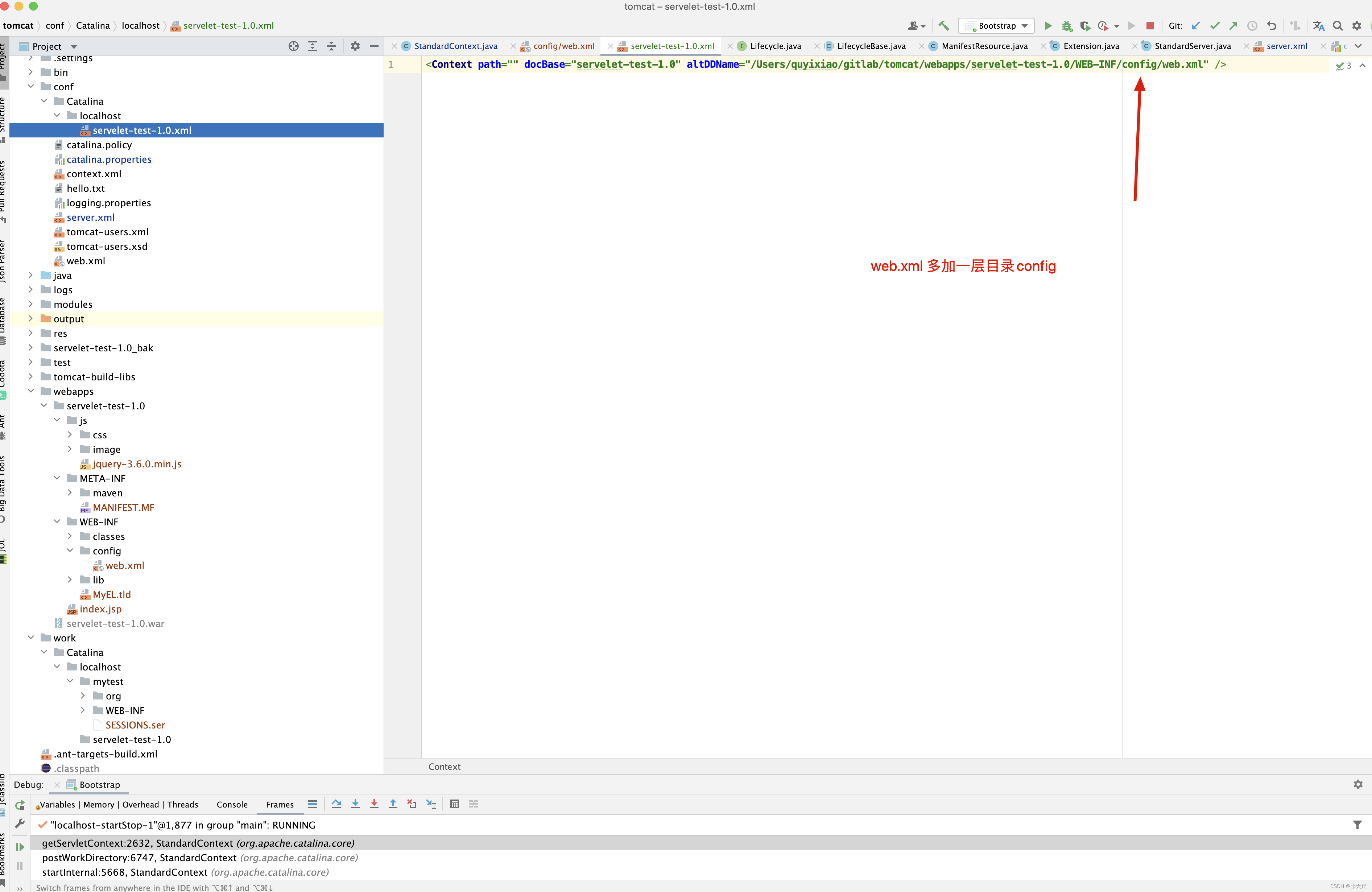
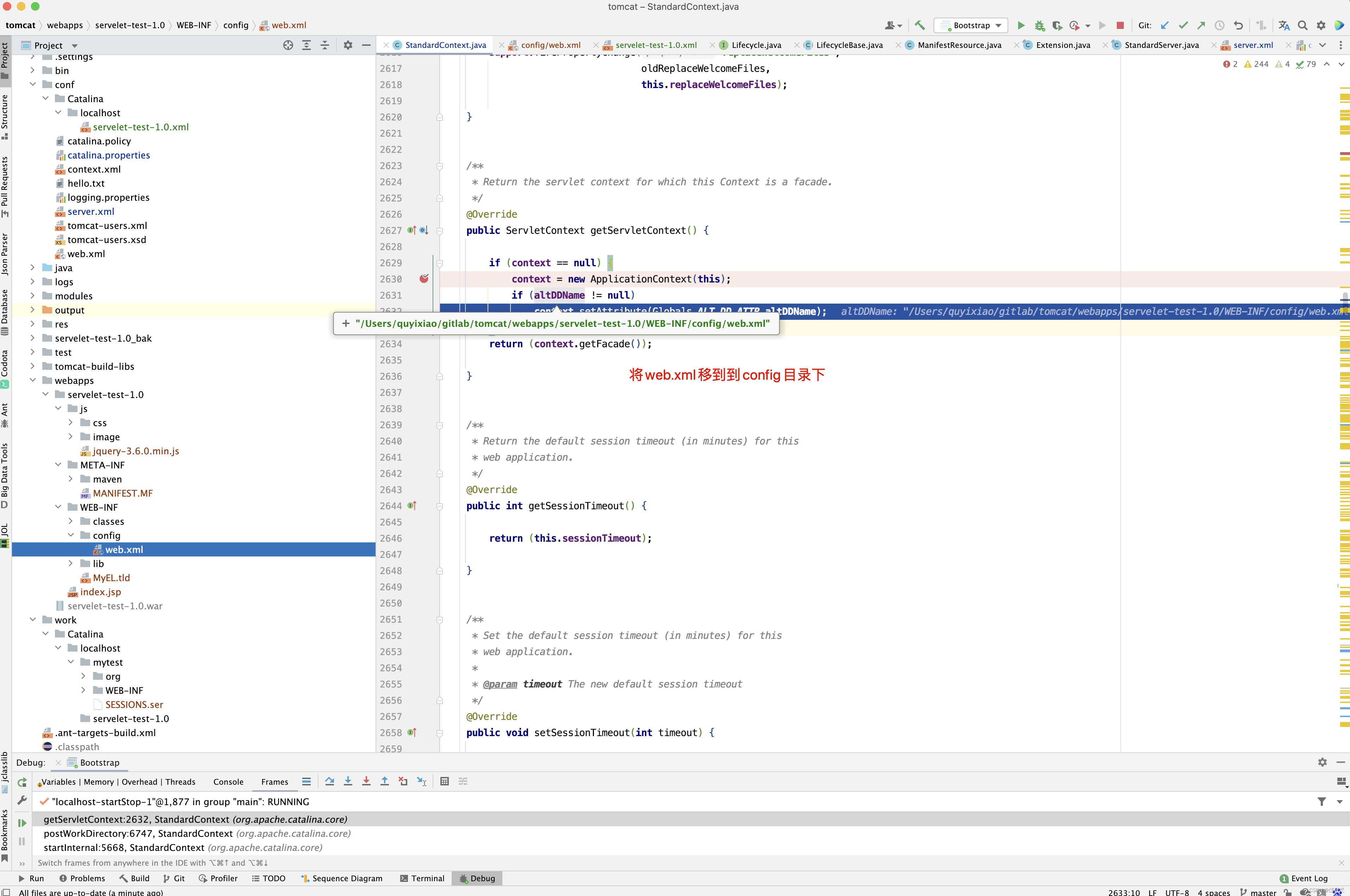
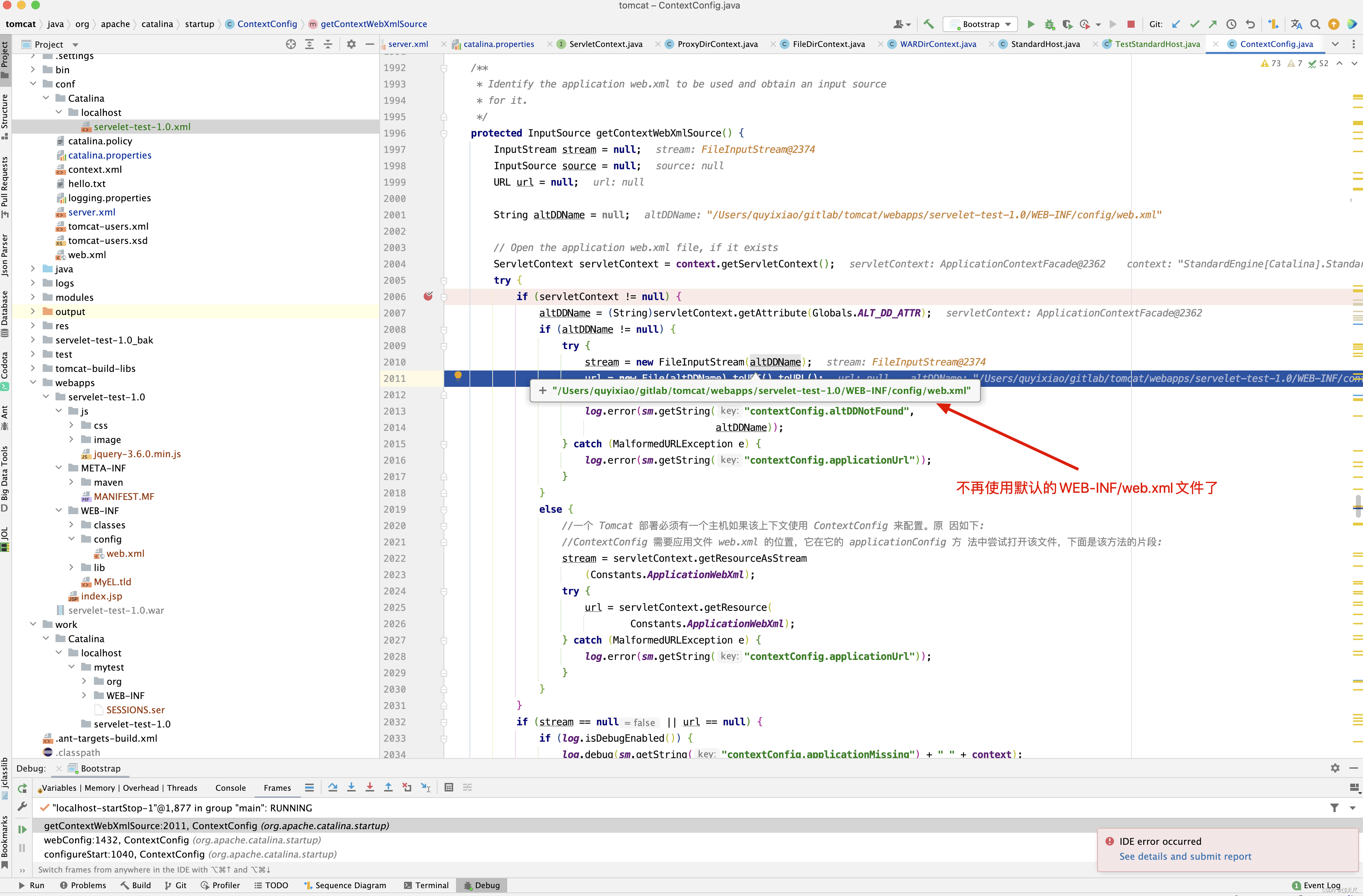
ServletContext的实现-ApplicationContext
在Servlet的规范中规定了一个ServletContext接口,它提供了Web应用所有的Servlet的视图, 通过它可以对某个Web应用的各种资源和功能进行访问 。
ServletContext接口包含了主要常见方法如下 :
- addFilter , 往Servlet上下文中添加Filter 。
- addListener ,往Servlet上下文中添加Listener。
- addServlet ,往Servlet上下文中添加servlet 。
- getAttribute , 从Servlet上下文中获取某个属性值 。
- setAttribute, 设置Servlet上下文中某个属性值 。
- removeAttribute ,从Servlet上下文中删除某个属性。
- setInitParameter , 设置Web应用配置的初始化值 。
- getInitParameter , 获取WEb应用配置的初始化值 。
- getResourceAsStream , 从Servlet上下文中获取某个资源流。
对于Tomcat 容器, Context 容器才是其运行时真正的环境,为了满足Servlet规范,它必须包含一个ServletContext接口的实现, 这个实现就是ApplicationContext ,ApplicationContext是ServletContext的标准实现, 用它来表示某个Web应用的运行环境,每个Tomcat 的Context 容器都会包含一个ApplicationContext 。
ApplicationContext对ServletContext接口的所有方法都进行了实现, 所以Web开发人员可以在Servlet中通过getServletContext()方法获得该上下文,进行再对上下文进行操作或获取上下文的各种资源 , 但实际上getServletContext()获取到的并非是ApplicationContext对象,而是一个ApplicationContext的门面对象ApplicationContextFacade , 门面模式的作用就是提供了一个类似于代理的访问模式,把ApplicationContext里面不该暴露的地方和属性屏蔽掉, 不让Web开发人员访问 。
如图9.9所示 ,ApplicationContext提供了一个ApplicationContextFacade的门面对象,Web开发人员编写Servlet逻辑时只能获取到该门面对象,该门面对象只提供了ApplicationContext可暴露的方法和属性访问,对于一些运行时重要属性和内部方法则不能给暴露给Web开发人员,以免影响整个Web应用的运行。
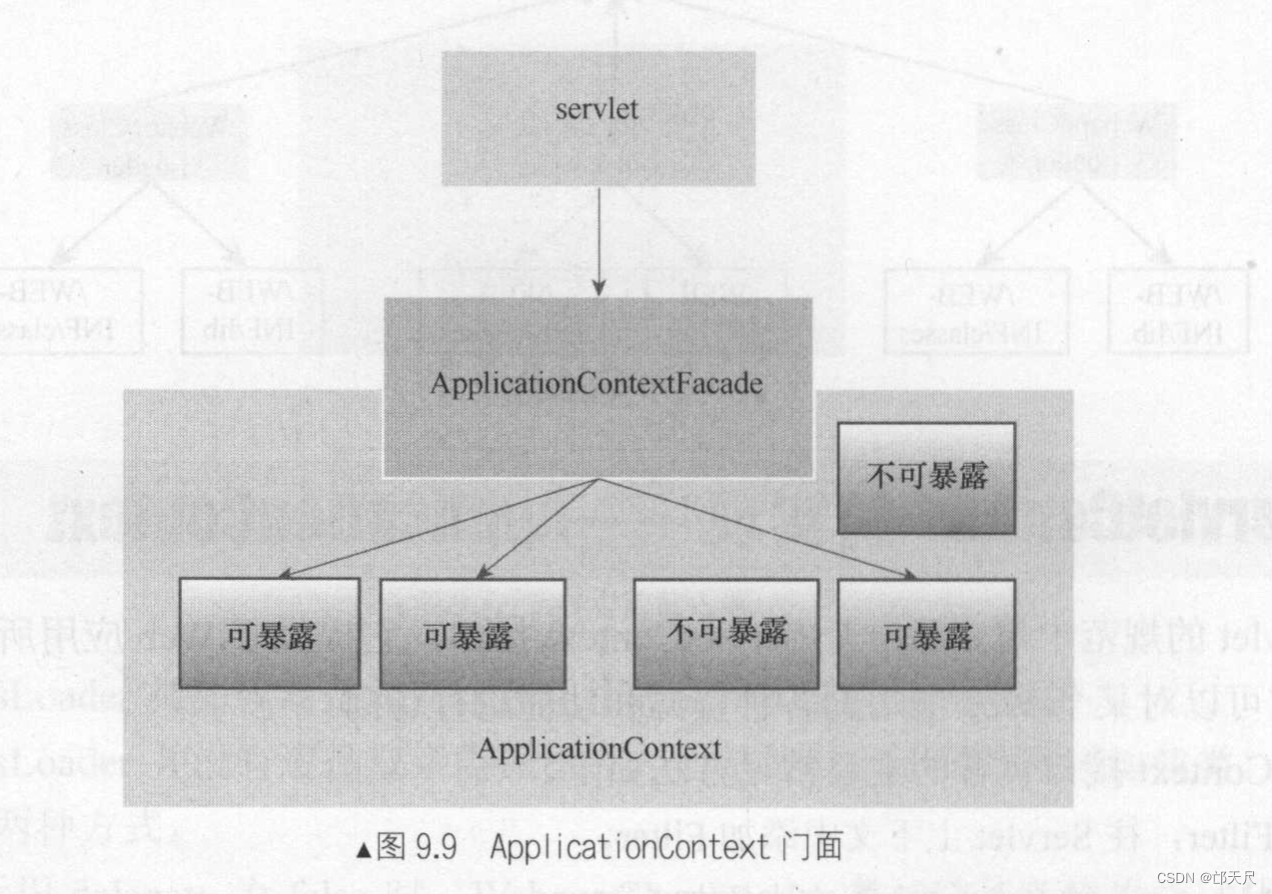
ApplicationContext的实现很大程序上依赖于Tomcat 的Context容器,它需要从Context容器中获取各种资源 , 如Servlet信息,Filter信息, 而像getResourceAsStream方法其实也获取Context容器里面 的某资源然后返回流。
所以总的来说,ApplicationContext 就是为了满足Servlet标准ServletContext接口而实现的一个类, 它按Servlet的规范要求提供了各种实现方法 。
接下来看从jar包中扫描web-fragment.xml实现。
protected Map<String,WebXml> processJarsForWebFragments(WebXml application) { // 默认值为StandardJarScanner JarScanner jarScanner = context.getJarScanner(); boolean parseRequired = true; Set<String> absoluteOrder = application.getAbsoluteOrdering(); if (absoluteOrder != null && absoluteOrder.isEmpty() && !context.getXmlValidation()) { // Skip parsing when there is an empty absolute ordering and // validation is not enabled parseRequired = false; } FragmentJarScannerCallback callback = new FragmentJarScannerCallback(parseRequired); jarScanner.scan(context.getServletContext(), context.getLoader().getClassLoader(), callback, pluggabilityJarsToSkip); return callback.getFragments(); }
进入StandardJarScanner的scan()方法 ,这里需要注意, callback是FragmentJarScannerCallback,因此在找到文件回调时,我们直接进入FragmentJarScannerCallback分析即可。
public void scan(ServletContext context, ClassLoader classloader, JarScannerCallback callback, Set<String> jarsToSkip) { if (log.isTraceEnabled()) { log.trace(sm.getString("jarScan.webinflibStart")); } final Set<String> ignoredJars; if (jarsToSkip == null) { // 默认取System.getProperty("tomcat.util.scan.DefaultJarScanner.jarsToSkip"); ignoredJars = defaultJarsToSkip; } else { ignoredJars = jarsToSkip; } // Scan WEB-INF/lib Set<String> dirList = context.getResourcePaths("/WEB-INF/lib/"); if (dirList != null) { for (String path : dirList) { if (path.endsWith(".jar") && !Matcher.matchName(ignoredJars, path.substring(path.lastIndexOf('/')+1))) { // Need to scan this JAR if (log.isDebugEnabled()) { log.debug(sm.getString("jarScan.webinflibJarScan", path)); } URL url = null; try { // File URLs are always faster to work with so use them // if available. String realPath = context.getRealPath(path); if (realPath == null) { url = context.getResource(path); } else { url = (new File(realPath)).toURI().toURL(); } process(callback, url); } catch (IOException e) { log.warn(sm.getString("jarScan.webinflibFail", url), e); } } else { if (log.isTraceEnabled()) { log.trace(sm.getString("jarScan.webinflibJarNoScan", path)); } } } } // Scan the classpath if (scanClassPath && classloader != null) { doScanClassPath(classloader, callback, ignoredJars); } } protected void doScanClassPath(ClassLoader classloader, JarScannerCallback callback, Set<String> ignoredJars) { if (log.isTraceEnabled()) { log.trace(sm.getString("jarScan.classloaderStart")); } ClassLoader loader = classloader; ClassLoader stopLoader = null; if (!scanBootstrapClassPath) { // Stop when we reach the bootstrap class loader stopLoader = ClassLoader.getSystemClassLoader().getParent(); } Set<URL> processedURLs = new HashSet<URL>(); while (loader != null && loader != stopLoader) { if (loader instanceof URLClassLoader) { URL[] urls = ((URLClassLoader) loader).getURLs(); for (int i=0; i<urls.length; i++) { // Extract the jarName if there is one to be found String jarName = getJarName(urls[i]); // Skip JARs known not to be interesting and JARs // in WEB-INF/lib we have already scanned if (jarName != null && !(Matcher.matchName(ignoredJars, jarName) || // 它将对Web 应用的WEB-INF/lib目录的Jar 包进行扫描,它支持声明忽略某些Jar包 // 同时它还支持classpath 下的jar 包进行扫描,然而,如果classpath 下的jar // 包与WEB-INF/lib 目录下的JAR包相同 。则会被忽略掉。 urls[i].toString().contains( "/WEB-INF/lib/" + jarName))) { if (log.isDebugEnabled()) { log.debug(sm.getString("jarScan.classloaderJarScan", urls[i])); } try { process(callback, urls[i]); // 如果jdk8和jdk9都有相同的包,优先使用jdk8 processedURLs.add(urls[i]); } catch (IOException ioe) { log.warn(sm.getString("jarScan.classloaderFail",urls[i]), ioe); } } else { if (log.isTraceEnabled()) { log.trace(sm.getString("jarScan.classloaderJarNoScan", urls[i])); } } } } loader = loader.getParent(); } // java9不考虑 if (JreCompat.isJre9Available()) { // The application and platform class loaders are not // instances of URLClassLoader. Use the class path in this // case. List<URL> urls = getClassPath(); // Also add any modules Deque<URL> modulePathUrls = new LinkedList<URL>(); JreCompat.getInstance().addBootModulePath(modulePathUrls); urls.addAll(modulePathUrls); // Process URLs for (URL url : urls) { if (!processedURLs.contains(url)) { // Avoid duplicates processedURLs.add(url); // Extract the jarName if there is one to be found String jarName = getJarName(url); if (jarName != null && Matcher.matchName(ignoredJars, jarName)) { continue; } try { process(callback, url); } catch (IOException ioe) { log.warn(sm.getString("jarScan.classloaderFail",url), ioe); } } } } }
其实上面的代码那么多,实现逻辑还是很简单的。 Tomcat 中的JarScanner 的标准实现为StandardJarScanner ,它将对Web 应用的WEB-INF/lib目录的Jar 包进行扫描,它支持声明忽略某些Jar包同时它还支持classpath 下的jar 包进行扫描,然而,如果classpath 下的jar 包与WEB-INF/lib 目录下的JAR包相同 。则会被忽略掉。扫描到的url都由process()方法处理,进入process()方法 。
protected void process(JarScannerCallback callback, URL url) throws IOException { if (log.isTraceEnabled()) { log.trace(sm.getString("jarScan.jarUrlStart", url)); } URLConnection conn = url.openConnection(); if (conn instanceof JarURLConnection) { callback.scan((JarURLConnection) conn); } else { String urlStr = url.toString(); if (urlStr.startsWith("file:") || urlStr.startsWith("jndi:") || urlStr.startsWith("http:") || urlStr.startsWith("https:")) { if (urlStr.endsWith(".jar")) { URL jarURL = UriUtil.buildJarUrl(urlStr); callback.scan((JarURLConnection) jarURL.openConnection()); } else { File f; try { f = new File(url.toURI()); if (f.isFile() && scanAllFiles) { // Treat this file as a JAR URL jarURL = UriUtil.buildJarUrl(f); callback.scan((JarURLConnection) jarURL.openConnection()); } else if (f.isDirectory() && scanAllDirectories) { File metainf = new File(f.getAbsoluteFile() + File.separator + "META-INF"); if (metainf.isDirectory()) { callback.scan(f); } } } catch (Throwable t) { ExceptionUtils.handleThrowable(t); // Wrap the exception and re-throw IOException ioe = new IOException(); ioe.initCause(t); throw ioe; } } } } }
上面scan方法分两种情况,一种是jar包,另外一种是文件目录,并且目录下有META-INF 也是一个目录 。
private class FragmentJarScannerCallback implements JarScannerCallback { private static final String FRAGMENT_LOCATION = "META-INF/web-fragment.xml"; @Override public void scan(JarURLConnection jarConn) throws IOException { URL url = jarConn.getURL(); URL resourceURL = jarConn.getJarFileURL(); Jar jar = null; InputStream is = null; WebXml fragment = new WebXml(); try { jar = JarFactory.newInstance(url); if (parseRequired || context.getXmlValidation()) { is = jar.getInputStream(FRAGMENT_LOCATION); } if (is == null) { // If there is no web-fragment.xml to process there is no // impact on distributable fragment.setDistributable(true); } else { InputSource source = new InputSource( "jar:" + resourceURL.toString() + "!/" + FRAGMENT_LOCATION); source.setByteStream(is); parseWebXml(source, fragment, true); } } finally { if (jar != null) { jar.close(); } addFragment(fragment, url); } } @Override public void scan(File file) throws IOException { InputStream stream = null; WebXml fragment = new WebXml(); try { File fragmentFile = new File(file, FRAGMENT_LOCATION); if (fragmentFile.isFile()) { stream = new FileInputStream(fragmentFile); InputSource source = new InputSource(fragmentFile.toURI().toURL().toString()); source.setByteStream(stream); parseWebXml(source, fragment, true); } else { // If there is no web.xml, normal folder no impact on // distributable fragment.setDistributable(true); } } finally { if (stream != null) { try { stream.close(); } catch (IOException e) { } } addFragment(fragment, file.toURI().toURL()); } } private void addFragment(WebXml fragment, URL url) { fragment.setURL(url); if (fragment.getName() == null) { fragment.setName(url.toString()); } fragment.setJarName(extractJarFileName(url)); if (fragments.containsKey(fragment.getName())) { // Duplicate. Mark the fragment that has already been found with // this name as having a duplicate so Tomcat can handle it // correctly when the fragments are being ordered. String duplicateName = fragment.getName(); fragments.get(duplicateName).setDuplicated(true); // Rename the current fragment so it doesn't clash fragment.setName(url.toString()); } fragments.put(fragment.getName(), fragment); } public Map<String,WebXml> getFragments() { return fragments; } }
JarScanner 在设计上采用了回调机制,每扫描到一个Jar包时都会调用回调对象进行处理,回调对象需要实现JarScannerCallBack 接口,此接口包含了scan(JarURLConnection urlConn) 和scan(File file) 两个方法,我们只需要将对Jar包处理的逻辑写入到这两个方法即可,JarScanner 在扫描到每个Jar 包后都会调用一次此方法,执行对该Jar 包的逻辑处理。
Jar 包扫描器为Context 容器的启动过程提供了方便的扫描Jar包的功能,它让开发过程中不必关注Web 应用Jar 包的搜索,而是专注于编写对Jar包中的TLD 文件和web-fragment.xml 文件的处理逻辑 。
接下来看扫描jar包下的web-fragment.xml生成的WebXml如何进行排序
public static Set<WebXml> orderWebFragments(WebXml application, Map<String,WebXml> fragments, ServletContext servletContext) { Set<WebXml> orderedFragments = new LinkedHashSet<WebXml>(); boolean absoluteOrdering = (application.getAbsoluteOrdering() != null); boolean orderingPresent = false; if (absoluteOrdering) { orderingPresent = true; // Only those fragments listed should be processed Set<String> requestedOrder = application.getAbsoluteOrdering(); for (String requestedName : requestedOrder) { if (WebXml.ORDER_OTHERS.equals(requestedName)) { // Add all fragments not named explicitly at this point for (Entry<String, WebXml> entry : fragments.entrySet()) { if (!requestedOrder.contains(entry.getKey())) { WebXml fragment = entry.getValue(); if (fragment != null) { orderedFragments.add(fragment); } } } } else { WebXml fragment = fragments.get(requestedName); if (fragment != null) { orderedFragments.add(fragment); } else { log.warn(sm.getString("webXml.wrongFragmentName",requestedName)); } } } } else { // Stage 0. Check there were no fragments with duplicate names // 如果有同名的fragment,则抛出异常 for (WebXml fragment : fragments.values()) { if (fragment.isDuplicated()) { throw new IllegalArgumentException( sm.getString("webXml.duplicateFragment", fragment.getName())); } } // Stage 1. Make all dependencies bi-directional - this makes the // next stage simpler. for (WebXml fragment : fragments.values()) { Iterator<String> before = fragment.getBeforeOrdering().iterator(); while (before.hasNext()) { orderingPresent = true; String beforeEntry = before.next(); if (!beforeEntry.equals(ORDER_OTHERS)) { WebXml beforeFragment = fragments.get(beforeEntry); if (beforeFragment == null) { before.remove(); } else { beforeFragment.addAfterOrdering(fragment.getName()); } } } Iterator<String> after = fragment.getAfterOrdering().iterator(); while (after.hasNext()) { orderingPresent = true; String afterEntry = after.next(); if (!afterEntry.equals(ORDER_OTHERS)) { WebXml afterFragment = fragments.get(afterEntry); if (afterFragment == null) { after.remove(); } else { afterFragment.addBeforeOrdering(fragment.getName()); } } } } // Stage 2. Make all fragments that are implicitly before/after // others explicitly so. This is iterative so the next // stage doesn't have to be. for (WebXml fragment : fragments.values()) { if (fragment.getBeforeOrdering().contains(ORDER_OTHERS)) { makeBeforeOthersExplicit(fragment.getAfterOrdering(), fragments); } if (fragment.getAfterOrdering().contains(ORDER_OTHERS)) { makeAfterOthersExplicit(fragment.getBeforeOrdering(), fragments); } } // Stage 3. Separate into three groups Set<WebXml> beforeSet = new HashSet<WebXml>(); Set<WebXml> othersSet = new HashSet<WebXml>(); Set<WebXml> afterSet = new HashSet<WebXml>(); for (WebXml fragment : fragments.values()) { if (fragment.getBeforeOrdering().contains(ORDER_OTHERS)) { beforeSet.add(fragment); fragment.getBeforeOrdering().remove(ORDER_OTHERS); } else if (fragment.getAfterOrdering().contains(ORDER_OTHERS)) { afterSet.add(fragment); fragment.getAfterOrdering().remove(ORDER_OTHERS); } else { othersSet.add(fragment); } } // Stage 4. Decouple the groups so the ordering requirements for // each fragment in the group only refer to other fragments // in the group. Ordering requirements outside the group // will be handled by processing the groups in order. // Note: Only after ordering requirements are considered. // This is OK because of the processing in stage 1. decoupleOtherGroups(beforeSet); decoupleOtherGroups(othersSet); decoupleOtherGroups(afterSet); // Stage 5. Order each group // Note: Only after ordering requirements are considered. // This is OK because of the processing in stage 1. orderFragments(orderedFragments, beforeSet); orderFragments(orderedFragments, othersSet); orderFragments(orderedFragments, afterSet); } // Avoid NPE when unit testing if (servletContext != null) { // Publish the ordered fragments List<String> orderedJarFileNames = null; if (orderingPresent) { orderedJarFileNames = new ArrayList<String>(); for (WebXml fragment: orderedFragments) { orderedJarFileNames.add(fragment.getJarName()); } } servletContext.setAttribute(ServletContext.ORDERED_LIBS, orderedJarFileNames); } return orderedFragments; }
orderWebFragments()方法确实复杂,与其说是源码,不如说是算法更加确切,因此这里就不再深入每一行源码的研究了,但找了一个测试类,有兴趣可以研究一下算法。
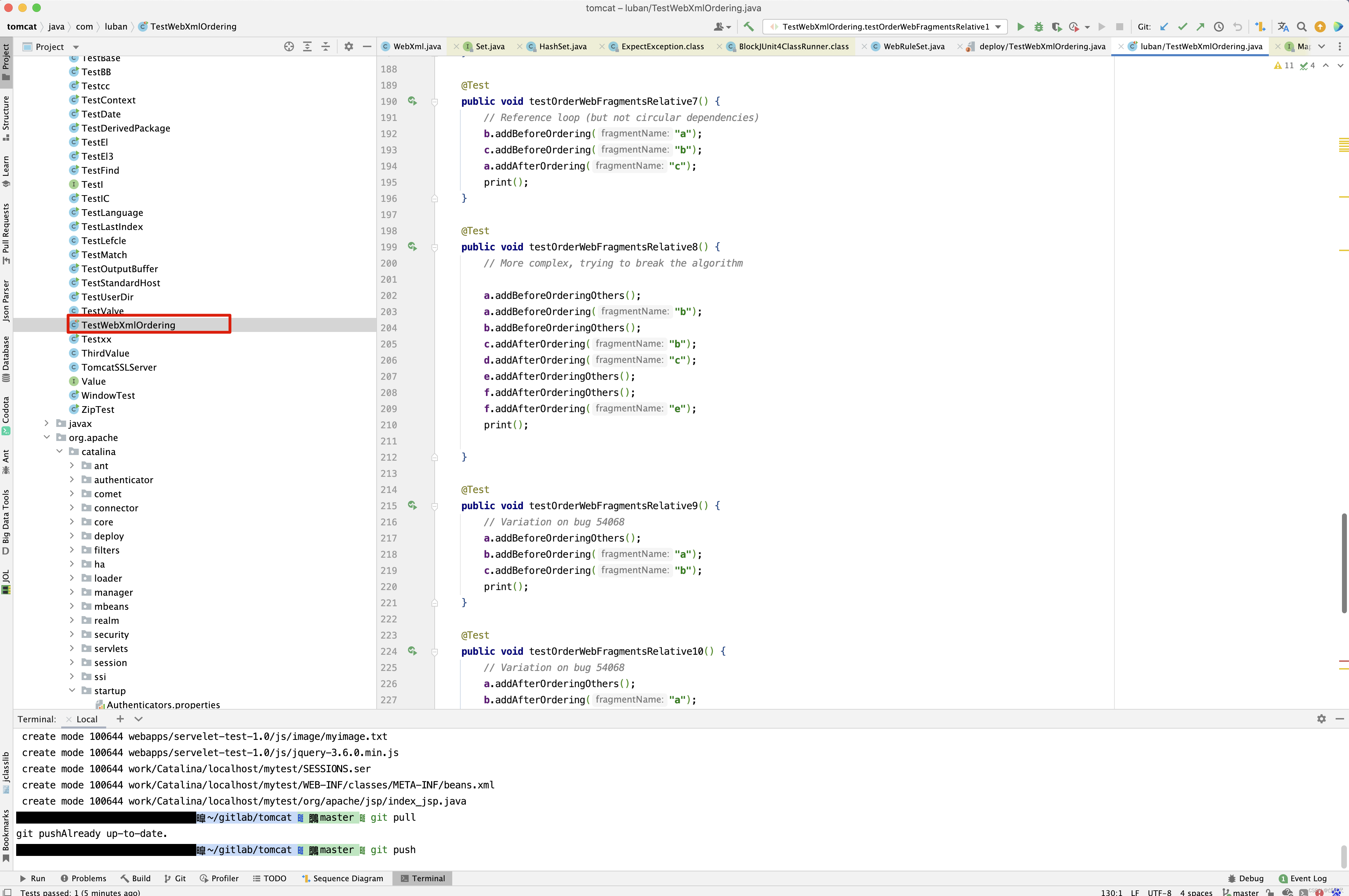
以testOrderWebFragmentsRelative8()为例。
@Before
public void setUp() {
app = new WebXml();
a = new WebXml();
a.setName("a");
b = new WebXml();
b.setName("b");
c = new WebXml();
c.setName("c");
d = new WebXml();
d.setName("d");
e = new WebXml();
e.setName("e");
f = new WebXml();
f.setName("f");
// Control the input order
fragments = new LinkedHashMap<String, WebXml>();
fragments.put("a", a);
fragments.put("b", b);
fragments.put("c", c);
fragments.put("d", d);
fragments.put("e", e);
fragments.put("f", f);
}
@Test
public void testOrderWebFragmentsRelative8() {
a.addBeforeOrderingOthers();
a.addBeforeOrdering("b");
b.addBeforeOrderingOthers();
c.addAfterOrdering("b");
d.addAfterOrdering("c");
e.addAfterOrderingOthers();
f.addAfterOrderingOthers();
f.addAfterOrdering("e");
print();
}
public void print() {
Set<WebXml> ordered = WebXml.orderWebFragments(app, fragments, null);
Iterator<WebXml> iter = ordered.iterator();
while (iter.hasNext()) {
WebXml webXml = iter.next();
System.out.println(webXml.getName());
}
}
向fragments中添加名称为a,b,c,d,e,f的WebXml,再测试testOrderWebFragmentsRelative8()方法 ,我们从语义上来理解最后fragments的顺序 。 a在其他WebXml前面,a 在b 的WebXml前面, b 在其他WebXml前面,c 要在b 的WebXml后面,d 要在c 的WebXml后面,e 在其他WebXml后面,f 要在e 的WebXml后面。最终得到顺序
a
b
c
d
e
f
大家可能对addBeforeOrderingOthers() , addBeforeOrdering() … 这些方法不熟悉,tomcat是什么时候调用了这些方法呢?还是看XML的解析规则 。
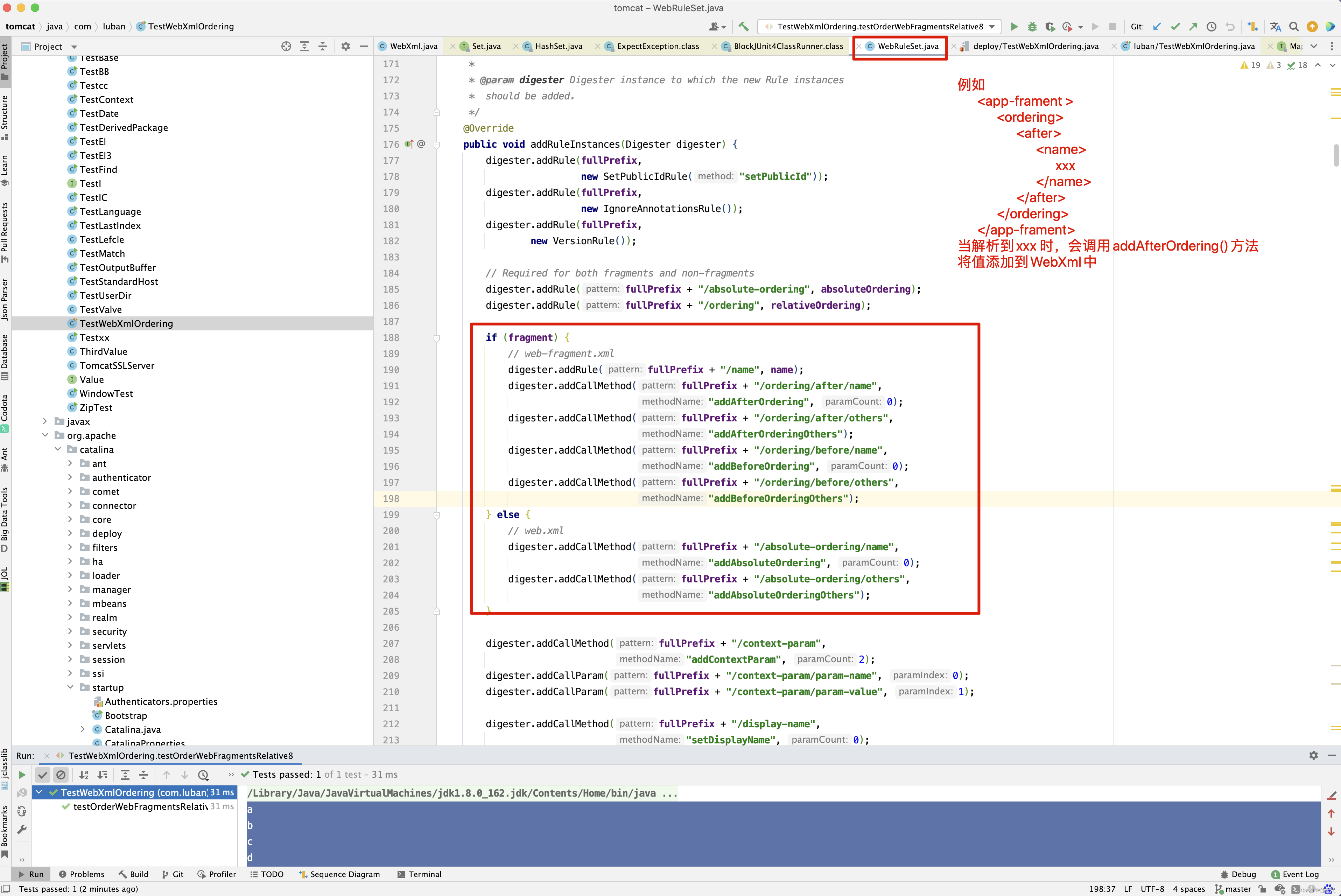
也就是说,我们可以在web.xml中配置,当前xml必须在哪个包的xml解析后面,或者当前xml在哪个包解析前面,或者在其他包的解析后面。建议还是去多测试一下TestWebXmlOrdering类,对其中的方法多打断点调试,才能理解WebFragments的排序规则。
ServletContainerInitializer 初始化器
在Web容器启动时为了让第三方组件机做一些初始化工作,例如,注册Servlet或者Filters等, Servlet 规范中通过ServletContainerInitializer实现些功能,每个框架要使用ServletContainerInitializer就必须对应Jar包的META-INF/services ,目录中创建一个名为javax.servlet.ServletContainerInitializer的文件,文件内容指定的具体的ServletContainerInitializer的实现类, 于是 ,当Web容器启动时,就会运行这个初始化器做一些组件内的初始化工作 。
一般伴随着ServletContainerInitialzer一起使用的还有HandlesTypes注解,通过HandlesTypes可以将感兴趣的一些类注入到ServletContainerInitializer的onStartup方法中作为参数传入。
Tomcat容器的ServletContainerInitializer机制,主要交由Context容器和ContextConfig监听器共同实现,ContextConfig监听器首先负责在容器启动时读取每个Web应用的WEB-INF/lib目录下包含的Jar包的META-INF/services/javax.servlet.ServletContainerInitializer,以及Web目录下的META-INF/services/javax.servlet.ServletContainerInitializer, 通过反射完成这些ServletContainerInitializer的实例化,然后再设置到 Context容器中, 最后,Context容器启动时就会分别调用每个ServletContainerInitializer的onStartup方法 ,并将感兴趣的类作为参数传入 。
基本的实现机制如图9.10所示,首先,通过ContextConfig 监听器遍历每个Jar包或Web根目录的META-INF/services/javax.server.ServletContainerInitializer文件,根据读到的类的路径实体化每个ServletContainerInitializer,然后再分别将实例化的ServletContainerInitializer设置到Context容器中, 最后,Context容器启动时分别调用所有的ServletContainerInitializer对象的onStartup方法 。

protected void processServletContainerInitializers() { List<ServletContainerInitializer> detectedScis; try { WebappServiceLoader<ServletContainerInitializer> loader = new WebappServiceLoader<ServletContainerInitializer>( context); // 1. Tomcat容器的ServletContainerInitializer机制,主要交由Context 容器和ContextConfig监听器共同实现, ContextConfig // 监听器首先负责在容器启动时读取每个Web应用的WEB-INF/lib目录下包含的Jar包的META-INF/lib/javax.servlet.ServletContainerInitializer // 2. 以及Web根目录下的META-INF/services/javax.servlet.ServletContainerInitializer ,通过反射完成这些ServletContainerInitializer // 的实例化,然后再设置到Context 容器中 detectedScis = loader.load(ServletContainerInitializer.class); } catch (IOException e) { log.error(sm.getString( "contextConfig.servletContainerInitializerFail", context.getName()), e); ok = false; return; } for (ServletContainerInitializer sci : detectedScis) { initializerClassMap.put(sci, new HashSet<Class<?>>()); HandlesTypes ht; try { ht = sci.getClass().getAnnotation(HandlesTypes.class); } catch (Exception e) { if (log.isDebugEnabled()) { log.info(sm.getString("contextConfig.sci.debug", sci.getClass().getName()), e); } else { log.info(sm.getString("contextConfig.sci.info", sci.getClass().getName())); } continue; } // 如果ServletContainerInitializer没有HandlesTypes注解,则 // 忽略掉 if (ht == null) { continue; } // 假如读出来的内容为com.seaboat.mytomcat.CustomServletContainerInitializer ,则通过反射实例化一个CustomServletContainerInitializer // 这里涉及到一个@HandlerTypes 注解的处理,被它标明的类需要作为参数传入 onStartup 方法中, 如下所示 // @HandlesTypes({HttpServlet.class,Filter.class}) // public class CustomServletContainerInitializer implements ServletContainerInitializer{ // public void onStartup(Set<Class<?>> classes, ServletContext servletContext) throws ServletException{ // for(Class c : classes ){ // System.out.println(c.getName()); // } // } // } // 其中@HandlesTypes 标明的HttpServlet和Filter两个Class被注入onStartup方法中,所以这个注解也需要在 ContextConfig监听器 // 中处理,前面已经介绍了注解的实现原理,由于有了编译器的协助,因此我们可以方便的通过ServletContainerInitializer 的Class // 对象获取到HandlesTypes对象,进而再获取到注解声明的类数组,下面就是代码的实现的地方 // 获取到HttpServlet和Filter的Class对象数组,后面的Context 容器调用了CustomServletContainerInitializer对象的onStartup // 方法时作为参数传入,至此,即完成了Servlet规范的ServeltContainerInitializer 初始化smsm。 Class<?>[] types = ht.value(); if (types == null) { continue; } for (Class<?> type : types) { if (type.isAnnotation()) { // @HandlerTypes 的values中有注解类型 handlesTypesAnnotations = true; } else { // @HandlerTypes 的values中有无注解类型 handlesTypesNonAnnotations = true; } Set<ServletContainerInitializer> scis = typeInitializerMap.get(type); if (scis == null) { scis = new HashSet<ServletContainerInitializer>(); typeInitializerMap.put(type, scis); } scis.add(sci); } } }
当读取到ClassLoader和WebappClassLoader中的META-INF/services/javax.servlet.ServletContainerInitializer文件内容,并将其中配置的类通过反射并存储于detectedScis中,此时关注ContextConfig中initializerClassMap和typeInitializerMap两个变量,initializerClassMap存储key是ServletContainerInitializer对象,而typeInitializerMap存储的是ServletContainerInitializer对象有@HandlesTypes注解,并且以HandlesTypes的values为key,而ServletContainerInitializer为value,如
MyServletContainerInitializer 和 YouServletContainerInitializer都配置了@HandlesTypes(value = {Filter.class}) 注解,因此typeInitializerMap中会存储key为Filter.class,值为拥有 MyServletContainerInitializer和YouServletContainerInitializer 两个对象的HashSet。
接下来看load()方法 。 load()方法的用意就是加载当前容器 /WEB-INF/classes/ 和WEB-INF/lib下寻找所有ServletContainerInitializer
public List<T> load(Class<T> serviceType) throws IOException { // META-INF/services/javax.servlet.ServletContainerInitializer String configFile = "META-INF/services/" + serviceType.getName(); LinkedHashSet<String> applicationServicesFound = new LinkedHashSet<String>(); LinkedHashSet<String> containerServicesFound = new LinkedHashSet<String>(); ClassLoader loader = servletContext.getClassLoader(); // if the ServletContext has ORDERED_LIBS, then use that to specify the // set of JARs from WEB-INF/lib that should be used for loading services @SuppressWarnings("unchecked") // 如果配置了javax.servlet.context.orderedLibs,则从这个目录下取,将扫描到的值保存到applicationServicesFound中 List<String> orderedLibs = (List<String>) servletContext.getAttribute("javax.servlet.context.orderedLibs"); if (orderedLibs != null) { // handle ordered libs directly, ... for (String lib : orderedLibs) { URL jarUrl = servletContext.getResource("/WEB-INF/lib/" + lib); if (jarUrl == null) { // should not happen, just ignore continue; } String base = jarUrl.toExternalForm(); URL url; if (base.endsWith("/")) { url = new URL(base + configFile); } else { url = UriUtil.buildJarUrl(base, configFile); } try { parseConfigFile(applicationServicesFound, url); } catch (FileNotFoundException e) { // no provider file found, this is OK } } // and the parent ClassLoader for all others loader = context.getParentClassLoader(); } Enumeration<URL> resources; if (loader == null) { resources = ClassLoader.getSystemResources(configFile); } else { resources = loader.getResources(configFile); } while (resources.hasMoreElements()) { parseConfigFile(containerServicesFound, resources.nextElement()); } // Filter the discovered container SCIs if required if (containerSciFilterPattern != null) { Iterator<String> iter = containerServicesFound.iterator(); while (iter.hasNext()) { // 以containerSciFilterPattern为规则 // 过滤掉containerServicesFound中找到的ServletContainerInitializer if (containerSciFilterPattern.matcher(iter.next()).find()) { iter.remove(); } } } // Add the application services after the container services to ensure // that the container services are loaded first containerServicesFound.addAll(applicationServicesFound); // load the discovered services if (containerServicesFound.isEmpty()) { return Collections.emptyList(); } // 首先,通过ContextConfig 监听器遍历每个Jar 包或者Web 根目录的META-INF/services/javax.servlet.ServletContainerInitializer文件 。 // 根据读到的类路径实例化每个ServletContainerInitalizer ,然后,再分别将实例化ServletContainerInitializer 设置进Context 容器 // 中,最后,Context 容器启动时分别调用所有的ServletContainerInitializer对象onStartup方法 。 return loadServices(serviceType, containerServicesFound); }
load()方法的原理很简单,先看是否配置了javax.servlet.context.orderedLibs目录,如果配置了,则从这个目录中查找,如果没有配置,则从当前StandardContext的WebappLoader的resources()中查找,当然啦,如果StandardContext中配置了containerSciFilter正则表达式,则过滤掉满足containerSciFilter正则的ServletContainerInitializer配置,接下来看 getResources()方法 。
public Enumeration<URL> getResources(String name) throws IOException { Enumeration<URL> parentResources = getParent().getResources(name); // 从WebappClassLoader中查找资源 Enumeration<URL> localResources = findResources(name); // Need to combine these enumerations. The order in which the // Enumerations are combined depends on how delegation is configured if (delegate) { return new CombinedEnumeration(parentResources, localResources); } else { return new CombinedEnumeration(localResources, parentResources); } }
先来看getParent()是什么 ?
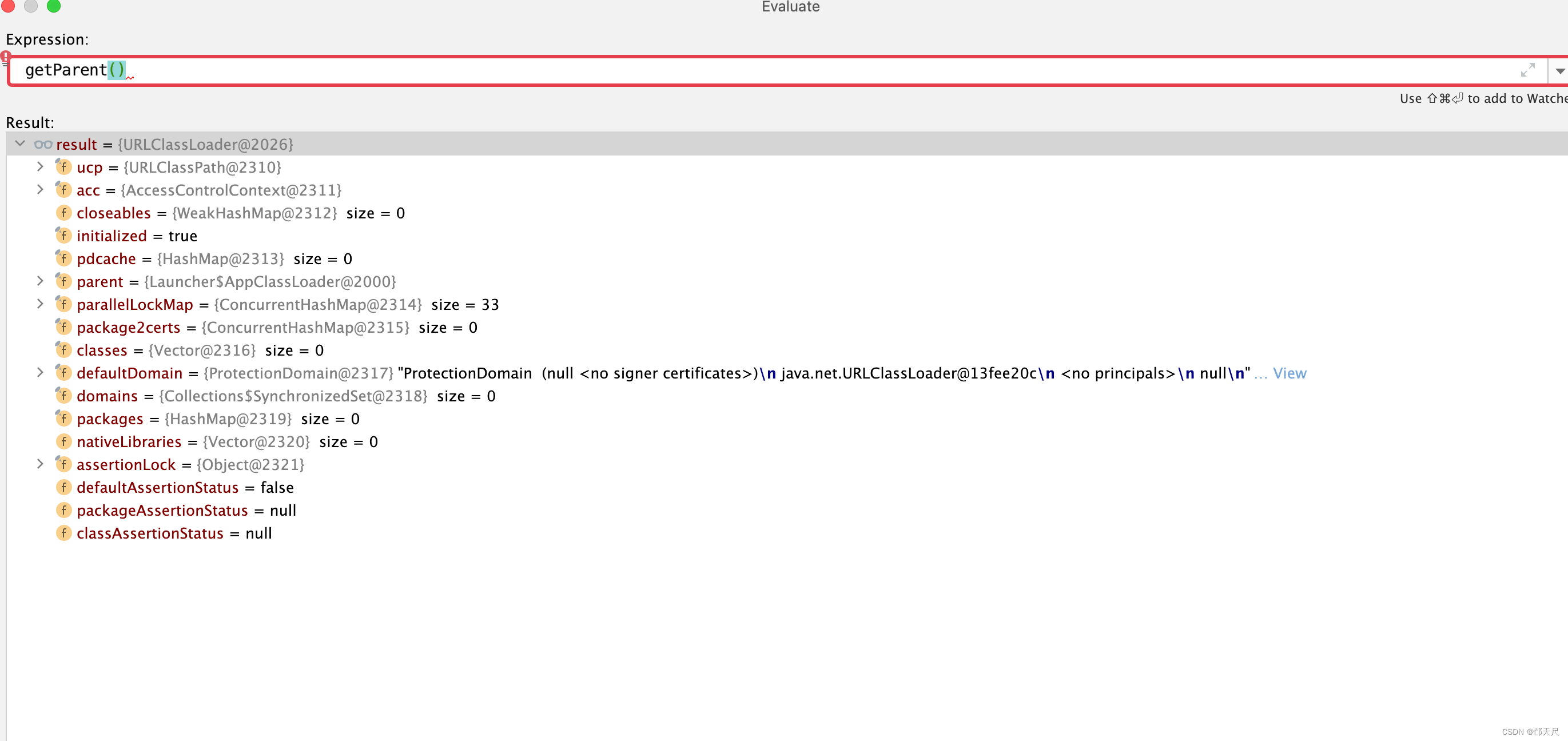
public Enumeration<URL> getResources(String name) throws IOException { @SuppressWarnings("unchecked") Enumeration<URL>[] tmp = (Enumeration<URL>[]) new Enumeration<?>[2]; // 如果父类加载器存在,则从父类加载器中查找Resource if (parent != null) { tmp[0] = parent.getResources(name); } else { // 如果父类加载器为空,则从启动类加载器中查找 tmp[0] = getBootstrapResources(name); } // 从自身中查找 tmp[1] = findResources(name); return new CompoundEnumeration<>(tmp); }
大家看到这里,发现这不就是双亲委派模型不,先从父类加载器中查找类或资源,如果父类加载器为空,则从启动类加载器中查找,如果还查找不到,再从自身类加载器中查找,这段代码用到了递归查找,需要大家注意 。 结合之前的类加载图更加清晰。
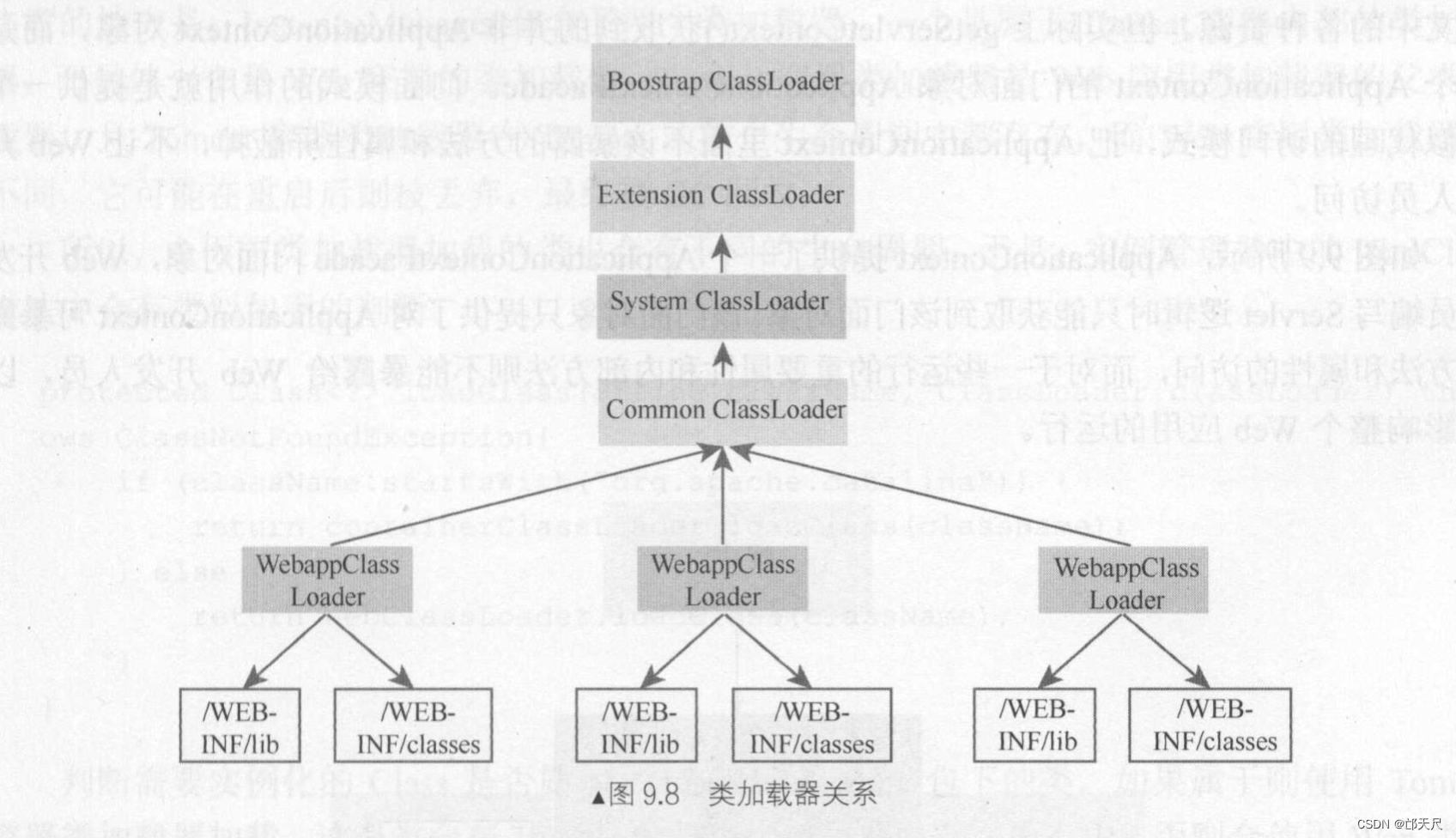
再回头来看getResources()方法,之前在类加载时提到过的。
-
当委托标识delegate为false时, WebappClassLoader类加载器首先尝试从本地缓存中查找该类,然后用System类加载器尝试加载类,接着由自己尝试加载类,最后才由父类加载器(Common)尝试加载,所以它的搜索目录顺序是<JAVA_HOME>/jre/lib-><JAVA_HOME>/jre/lib/ext->CLASSPATH->/WEB-INF/classes->/WEB-INF/lib->$CATALINA_BASE/lib和 $CATALINA_HOME/lib 。
当委托标识delegate为false, new CombinedEnumeration(localResources, parentResources); ,localResources在前, parentResources在后。 -
当委托标识delegate为true时,WebappClassLoader类加载器首先尝试从本地缓存中查找加载该类, 然后用System类加载器尝试加载类,接着由父类加载器(Common)尝试加载类,最后才由自己尝试加载,所以此时它的搜索的目录顺序是<JAVA_HOME>/jre/lib-><JAVA_HOME/jre/lib/ext->CLASSPATH->$CATALINA_BASE/lib 和$ CATALINA_HOME ->WEB-INF/classes ->WEB-INF/lib。
当委托标识delegate为true时, new CombinedEnumeration(parentResources, localResources);
parentResources在前, localResources在后。
现在对resources的查找顺序应该有了新的认识了, 接下来分析,在StandardContext中又是如何查找resource的呢?
public Enumeration<URL> findResources(String name) throws IOException { if (log.isDebugEnabled()) log.debug(" findResources(" + name + ")"); //we use a LinkedHashSet instead of a Vector to avoid duplicates with virtualmappings LinkedHashSet<URL> result = new LinkedHashSet<URL>(); int jarFilesLength = jarFiles.length; int repositoriesLength = repositories.length; int i; // Adding the results of a call to the superclass if (hasExternalRepositories && searchExternalFirst) { Enumeration<URL> otherResourcePaths = super.findResources(name); while (otherResourcePaths.hasMoreElements()) { result.add(otherResourcePaths.nextElement()); } } // Looking at the repositories for (i = 0; i < repositoriesLength; i++) { try { String fullPath = repositories[i] + name; // resources的默认值为ProxyDirContext // 可以去看 Tomcat 源码解析一JNDI这篇博客 resources.lookup(fullPath); // Note : Not getting an exception here means the resource was // found try { result.add(getURI(new File(files[i], name))); } catch (MalformedURLException e) { // Ignore } } catch (NamingException e) { // Ignore } } // Looking at the JAR files synchronized (jarFiles) { if (openJARs()) { for (i = 0; i < jarFilesLength; i++) { JarEntry jarEntry = jarFiles[i].getJarEntry(name); if (jarEntry != null) { try { String jarFakeUrl = getURI(jarRealFiles[i]).toString(); result.add(UriUtil.buildJarUrl(jarFakeUrl, name)); } catch (MalformedURLException e) { // Ignore } } } } } // Adding the results of a call to the superclass if (hasExternalRepositories && !searchExternalFirst) { Enumeration<URL> otherResourcePaths = super.findResources(name); while (otherResourcePaths.hasMoreElements()) { result.add(otherResourcePaths.nextElement()); } } return Collections.enumeration(result); }
上面代码写了那么多,只要弄明白两个变量jarFiles和repositories两个变量,所有的问题将迎刃而解。
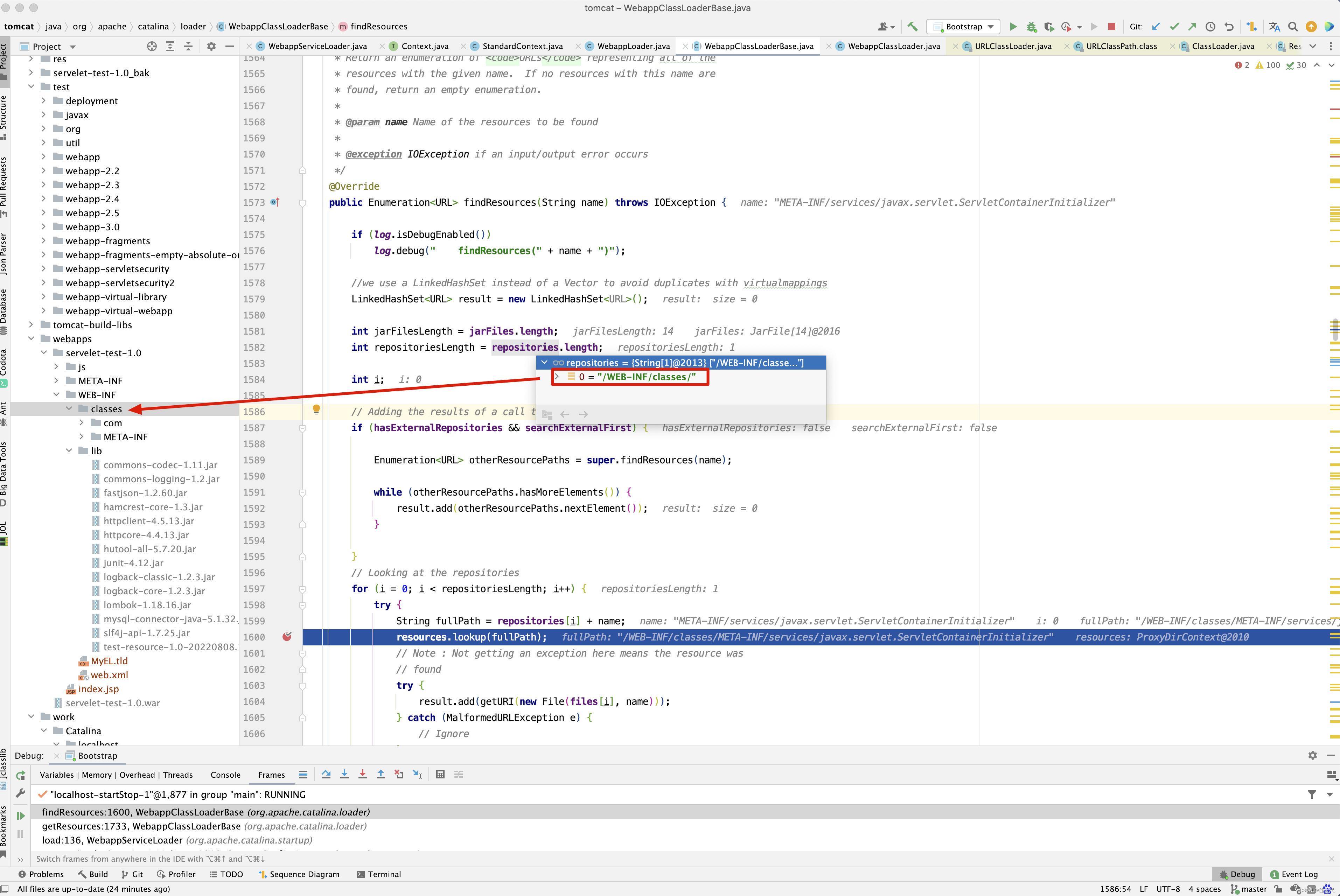
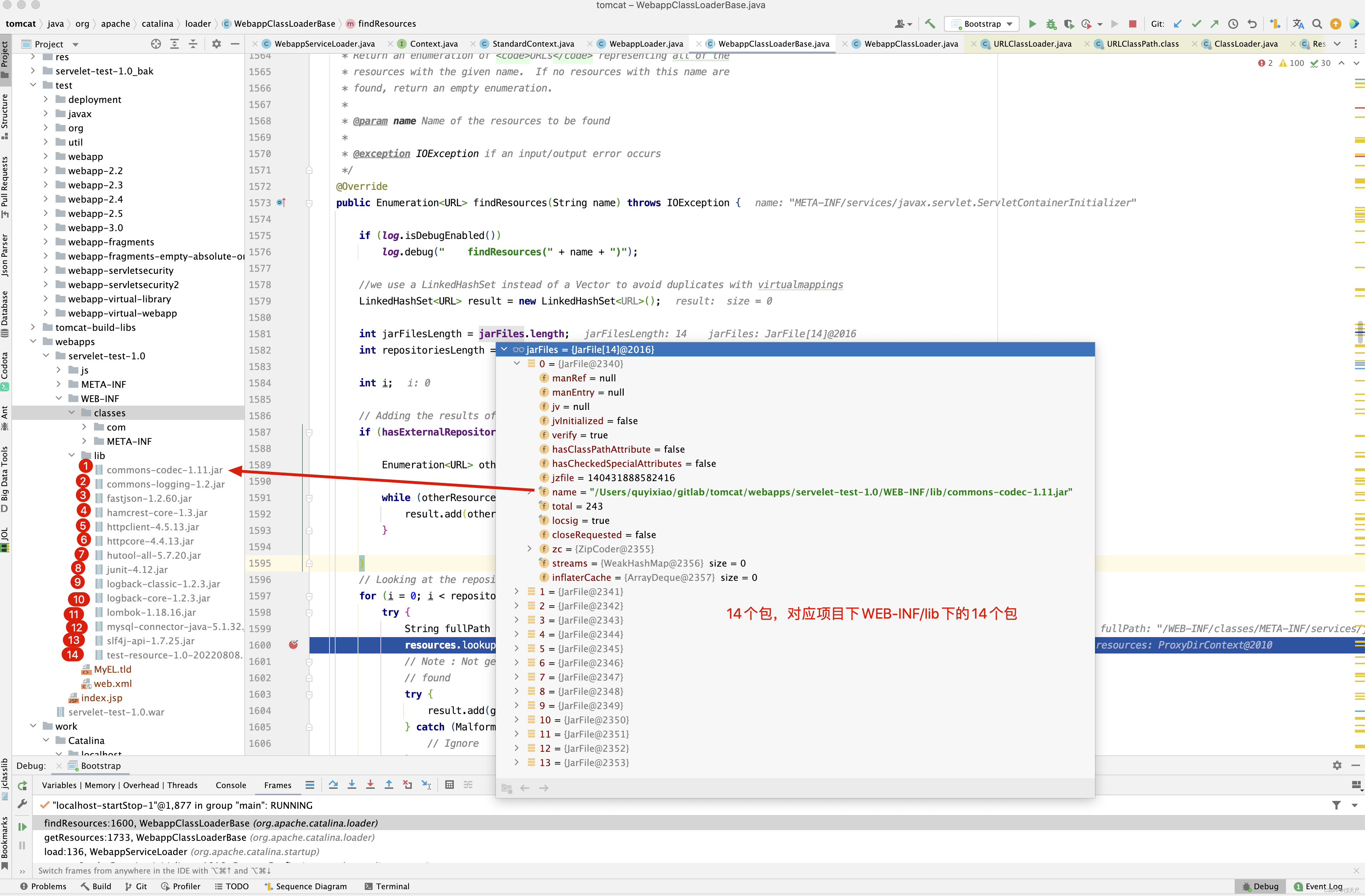
findResources()方法的源码就很简单了,到WEB-INF/classes下和WEB-INF/lib下所有jar包中查找META-INF/services/javax.servlet.ServletContainerInitializer文件是否存在,如果存在,将文件转变为URI存储于集合中并返回,当然接下来就是读取文件中的内容 。
private void parseConfigFile(LinkedHashSet<String> servicesFound, URL url) throws IOException { InputStream is = null; BufferedReader reader = null; try { is = url.openStream(); InputStreamReader in = new InputStreamReader(is, UTF8); reader = new BufferedReader(in); String line; while ((line = reader.readLine()) != null) { // 当然文件的读取就很简单了,就是一行一行的读取,如果行中有# ,则只截取#前的内容 int i = line.indexOf('#'); if (i >= 0) { line = line.substring(0, i); } line = line.trim(); if (line.length() == 0) { continue; } servicesFound.add(line); } } finally { if (reader != null) { reader.close(); } if (is != null) { is.close(); } } }
parseConfigFile()方法的读取过程就很简单了, 通过InputStreamReader流读取,过滤掉以#开头的行,也就是说如果以#开头,表示是注释行。 当然如果一行的内容为
com.luban.MyServletContainerInitializer # bbbbbbbbbbb
则#之前的内容依然有用。而#之后的内容当作注释。最后再来看一下loadServices()方法 。
private List<T> loadServices(Class<T> serviceType, LinkedHashSet<String> servicesFound) throws IOException { ClassLoader loader = servletContext.getClassLoader(); List<T> services = new ArrayList<T>(servicesFound.size()); for (String serviceClass : servicesFound) { try { Class<?> clazz = Class.forName(serviceClass, true, loader); services.add(serviceType.cast(clazz.newInstance())); } catch (ClassNotFoundException e) { throw new IOException(e); } catch (InstantiationException e) { throw new IOException(e); } catch (IllegalAccessException e) { throw new IOException(e); } catch (ClassCastException e) { throw new IOException(e); } } return Collections.unmodifiableList(services); }
当然loadServices()方法的源码就更加简单了,直接用反射创建对象返回即可。 但值得注意的是,用的是servletContext的类加载器来加载ServletContainerInitializer。
Class类处理
接下来看Class类处理
protected void processClasses(WebXml webXml, Set<WebXml> orderedFragments) { // Step 4. Process /WEB-INF/classes for annotations if (ok) { // Hack required by Eclipse's "serve modules without // publishing" feature since this backs WEB-INF/classes by // multiple locations rather than one. NamingEnumeration<Binding> listBindings = null; try { try { listBindings = context.getResources().listBindings( "/WEB-INF/classes"); } catch (NameNotFoundException ignore) { // Safe to ignore } while (listBindings != null && listBindings.hasMoreElements()) { Binding binding = listBindings.nextElement(); if (binding.getObject() instanceof FileDirContext) { File webInfClassDir = new File( ((FileDirContext) binding.getObject()).getDocBase()); processAnnotationsFile(webInfClassDir, webXml, webXml.isMetadataComplete()); } else if ("META-INF".equals(binding.getName())) { // Skip the META-INF directory from any JARs that have been // expanded in to WEB-INF/classes (sometimes IDEs do this). } else { String resource = "/WEB-INF/classes/" + binding.getName(); try { URL url = context.getServletContext().getResource(resource); processAnnotationsUrl(url, webXml, webXml.isMetadataComplete()); } catch (MalformedURLException e) { log.error(sm.getString( "contextConfig.webinfClassesUrl", resource), e); } } } } catch (NamingException e) { log.error(sm.getString( "contextConfig.webinfClassesUrl", "/WEB-INF/classes"), e); } } // Step 5. Process JARs for annotations - only need to process // those fragments we are going to use if (ok) { // 处理web-fragment.xml文件及其所在包的.class文中配置的@WebServlet, @WebFilter 和 @WebListener 注解的合并 processAnnotations( orderedFragments, webXml.isMetadataComplete()); } // Cache, if used, is no longer required so clear it javaClassCache.clear(); }
processClasses()首先对StandardContext下/WEB-INF/classes目录下的资源进行绑定。
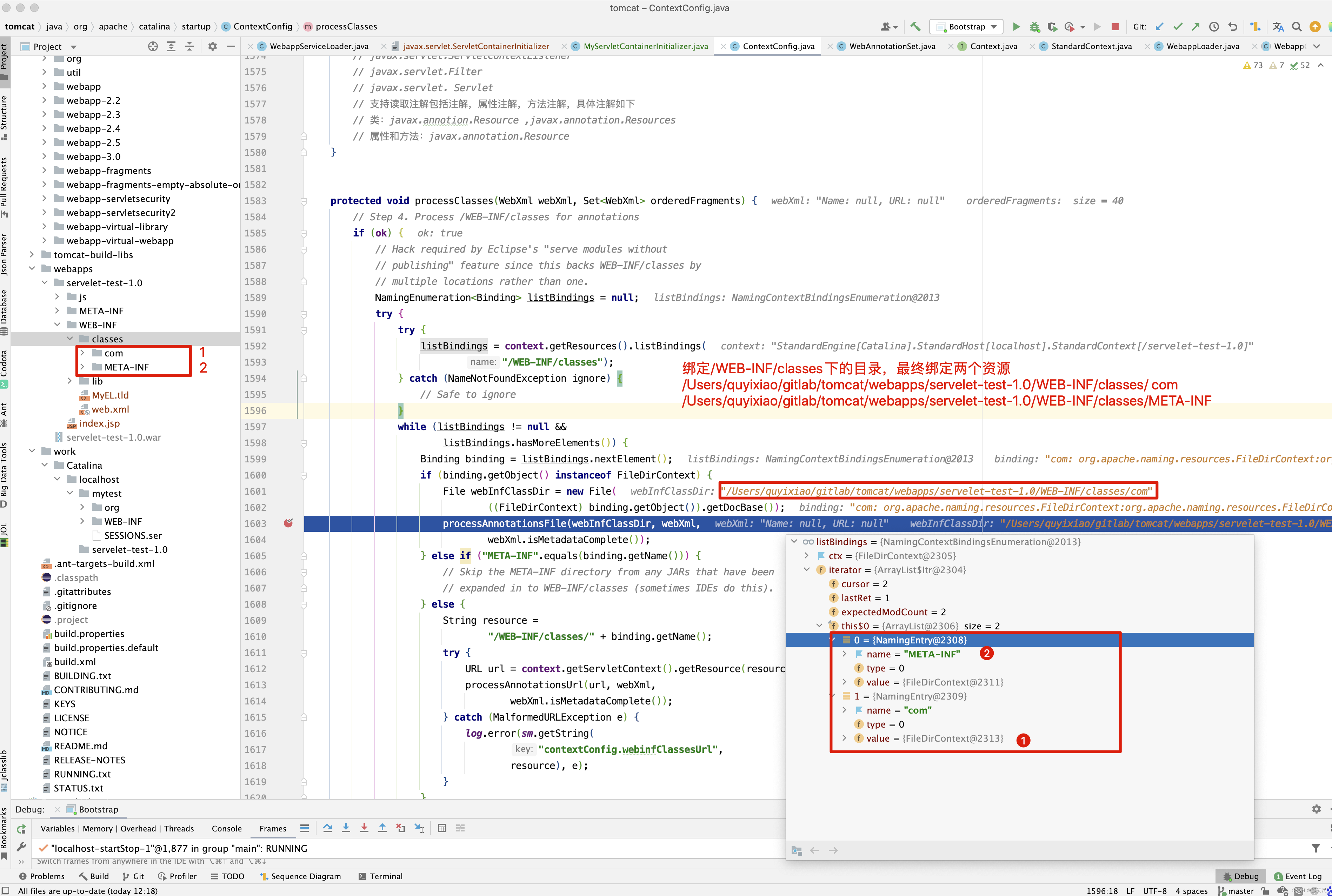
如果资源不是FileDirContext,而是单纯的名字META-INF,则忽略掉,否则到ServletContext下查找/WEB-INF/classes/binding.getName()的资源。再调用processAnnotationsUrl()方法进行处理。因此processClasses()方法对资源的处理分两种情况,如果是FileDirContext,则调用processAnnotationsFile()进行处理,否则使用JNDI从Resource中获取,调用processAnnotationsUrl()进行处理,先来看processAnnotationsFile()方法 。
protected void processAnnotationsFile(File file, WebXml fragment, boolean handlesTypesOnly) { if (file.isDirectory()) { // Returns null if directory is not readable String[] dirs = file.list(); if (dirs != null) { if (log.isDebugEnabled()) { log.debug(sm.getString( "contextConfig.processAnnotationsDir.debug", file)); } for (String dir : dirs) { processAnnotationsFile( new File(file,dir), fragment, handlesTypesOnly); } } } else if (file.getName().endsWith(".class") && file.canRead()) { FileInputStream fis = null; try { fis = new FileInputStream(file); processAnnotationsStream(fis, fragment, handlesTypesOnly); } catch (IOException e) { log.error(sm.getString("contextConfig.inputStreamFile", file.getAbsolutePath()),e); } catch (ClassFormatException e) { log.error(sm.getString("contextConfig.inputStreamFile", file.getAbsolutePath()),e); } finally { if (fis != null) { try { fis.close(); } catch (Throwable t) { ExceptionUtils.handleThrowable(t); } } } } }
processAnnotationsFile()方法的逻辑就是递归查找目录下所有以.class结尾的文件,最终调用processAnnotationsStream()进行处理,先不急着进入processAnnotationsStream()方法,先看看
protected void processAnnotationsUrl(URL url, WebXml fragment, boolean handlesTypesOnly) { if (url == null) { // Nothing to do. return; } else if ("jar".equals(url.getProtocol())) { processAnnotationsJar(url, fragment, handlesTypesOnly); } else if ("jndi".equals(url.getProtocol())) { processAnnotationsJndi(url, fragment, handlesTypesOnly); } else if ("file".equals(url.getProtocol())) { try { processAnnotationsFile( new File(url.toURI()), fragment, handlesTypesOnly); } catch (URISyntaxException e) { log.error(sm.getString("contextConfig.fileUrl", url), e); } } else { log.error(sm.getString("contextConfig.unknownUrlProtocol", url.getProtocol(), url)); } }
如果url的协议是jar包,则调用processAnnotationsJar()方法处理,如果url的协议是jndi,则调用processAnnotationsJndi()处理,如果是文件,则调用之前的processAnnotationsFile()方法处理。先来看jar包的处理。
protected void processAnnotationsJar(URL url, WebXml fragment, boolean handlesTypesOnly) { Jar jar = null; InputStream is; try { jar = JarFactory.newInstance(url); if (log.isDebugEnabled()) { log.debug(sm.getString( "contextConfig.processAnnotationsJar.debug", url)); } jar.nextEntry(); String entryName = jar.getEntryName(); while (entryName != null) { // 遍历jar包下所有.class文件 if (entryName.endsWith(".class")) { is = null; try { is = jar.getEntryInputStream(); processAnnotationsStream( is, fragment, handlesTypesOnly); } catch (IOException e) { log.error(sm.getString("contextConfig.inputStreamJar", entryName, url),e); } catch (ClassFormatException e) { log.error(sm.getString("contextConfig.inputStreamJar", entryName, url),e); } finally { if (is != null) { try { is.close(); } catch (IOException ioe) { // Ignore } } } } jar.nextEntry(); entryName = jar.getEntryName(); } } catch (IOException e) { log.error(sm.getString("contextConfig.jarFile", url), e); } finally { if (jar != null) { jar.close(); } } }
接下来看processAnnotationsJndi()方法处理。
protected void processAnnotationsJndi(URL url, WebXml fragment, boolean handlesTypesOnly) { try { URLConnection urlConn = url.openConnection(); DirContextURLConnection dcUrlConn; if (!(urlConn instanceof DirContextURLConnection)) { // This should never happen sm.getString("contextConfig.jndiUrlNotDirContextConn", url); return; } dcUrlConn = (DirContextURLConnection) urlConn; dcUrlConn.setUseCaches(false); String type = dcUrlConn.getHeaderField(ResourceAttributes.TYPE); if (ResourceAttributes.COLLECTION_TYPE.equals(type)) { // Collection Enumeration<String> dirs = dcUrlConn.list(); if (log.isDebugEnabled() && dirs.hasMoreElements()) { log.debug(sm.getString( "contextConfig.processAnnotationsWebDir.debug", url)); } while (dirs.hasMoreElements()) { String dir = dirs.nextElement(); URL dirUrl = new URL(url.toString() + '/' + dir); processAnnotationsJndi(dirUrl, fragment, handlesTypesOnly); } } else { // Single file if (url.getPath().endsWith(".class")) { InputStream is = null; try { is = dcUrlConn.getInputStream(); processAnnotationsStream( is, fragment, handlesTypesOnly); } catch (IOException e) { log.error(sm.getString("contextConfig.inputStreamJndi", url),e); } catch (ClassFormatException e) { log.error(sm.getString("contextConfig.inputStreamJndi", url),e); } finally { if (is != null) { try { is.close(); } catch (Throwable t) { ExceptionUtils.handleThrowable(t); } } } } } } catch (IOException e) { log.error(sm.getString("contextConfig.jndiUrl", url), e); } }
processAnnotationsJndi()的处理和processAnnotationsFile()处理类似,都是递归查找目录下的所有.class文件,如果文件存在,则调用 processAnnotationsStream()处理,大家发现规率没有,先查找文件目录下的所有.class文件,如果是url,则根据不同的协议,如果是jar包,以读取jar包的方式遍历所有的.class文件,如果是jndi协议,则以jndi的方式遍历所有的.class文件,无论.class文件从哪里来的,最终都是调用了 processAnnotationsStream()方法处理。
protected void processAnnotationsStream(InputStream is, WebXml fragment, boolean handlesTypesOnly) throws ClassFormatException, IOException { ClassParser parser = new ClassParser(is); JavaClass clazz = parser.parse(); checkHandlesTypes(clazz); // <web-app xmlns:xsi="http://www.w3.org/2001/XMLSchema-instance" // xmlns="http://java.sun.com/xml/ns/javaee" // xsi:schemaLocation="http://java.sun.com/xml/ns/javaee // http://java.sun.com/xml/ns/javaee/web-app_3_0.xsd" id="WebApp_ID" // version="3.0" metadata-complete="true"> // metadata-complete="true",会在启动时不扫描注解(annotation)。 // 如果不扫描注解的话,用注解进行的配置就无法生效,例如:@WebServlet,@WebServlet,@WebListener if (handlesTypesOnly) { return; } // @WebServlet,@WebServlet,@WebListener 注解处理 processClass(fragment, clazz); }
如果要理解上面两行加粗代码,至少需要掌握Class字节码结构,才看得懂加粗代码 。 粗略看一下parse()方法 。
public JavaClass parse() throws IOException, ClassFormatException {
/****************** Read headers ********************************/
// Check magic tag of class file
readID();
// Get compiler version
readVersion();
/****************** Read constant pool and related **************/
// Read constant pool entries
readConstantPool();
// Get class information
readClassInfo();
// Get interface information, i.e., implemented interfaces
readInterfaces();
/****************** Read class fields and methods ***************/
// Read class fields, i.e., the variables of the class
readFields();
// Read class methods, i.e., the functions in the class
readMethods();
// Read class attributes
readAttributes();
// Return the information we have gathered in a new object
return new JavaClass(class_name, superclass_name,
access_flags, constant_pool, interface_names,
runtimeVisibleAnnotations);
}
// class 文件结构
ClassFile {
u4 magic;
u2 minor_version;
u2 major_version;
u2 constant_pool_count;
cp_info constant_pool[constant_pool_count-1];
u2 access_flags;
u2 this_class;
u2 super_class;
u2 interfaces_count;
u2 interfaces[interfaces_count];
u2 fields_count;
field_info fields[fields_count];
u2 methods_count;
method_info methods[methods_count];
u2 attributes_count;
attribute_info attributes[attributes_count];
}
class文件结构,先魔数,次版本号,主版本号,常量池个数,常量池, 类访问标识,当前类名,父类名,接口个数,接口,属性个数,属性,方法个数,方法信息,其他属性等 ,关于字节码结构这里不做过多分析,感兴趣可以看 Java字节码文件结构剖析(一) ,和 自己动手写Java虚拟机 (Java核心技术系列)_java版 这两篇博客,虽然不分析,我觉得tomcat解析Class结构的源码还是写得很好的,因此我给抽取出来,github地址 https://github.com/quyixiao/tomcat-class-parser.git, 举个例子来理解这部分代码 。
- 创建一个类, 加上WebFilter注解。并配置上属性
@WebFilter(value = {"a","b"},description="我的测试" )
public class TestAnnotation {
}
- 读取TestAnnotation字节码,获取注解的属性
public static void main(String[] args) throws Exception{
FileInputStream fis = new FileInputStream(new File("/Users/quyixiao/github/tomcat-class-parser/target/test-classes/com/test/TestAnnotation.class"));;
ClassParser parser = new ClassParser(fis);
JavaClass clazz = parser.parse();
AnnotationEntry[] annotationsEntries = clazz.getAnnotationEntries();
if (annotationsEntries != null) {
String className = clazz.getClassName();
for (AnnotationEntry ae : annotationsEntries) {
String type = ae.getAnnotationType();
System.out.println("annotaionType = " + type);
List<ElementValuePair> elementValuePairs = ae.getElementValuePairs();
for(ElementValuePair elementValuePair : elementValuePairs){
System.out.println("====================");
System.out.println(elementValuePair.getNameString());
ElementValue elementValue = elementValuePair.getValue();
System.out.println(elementValue.stringifyValue());
}
}
}
}
- 结果输出
annotaionType = Ljavax/servlet/annotation/WebFilter;
====================
value
[a,b]
====================
description
我的测试
字节码读取这一块之前也分析过,就不做过多深入了,接下来进入checkHandlesTypes()方法分析。
protected void checkHandlesTypes(JavaClass javaClass) { // Skip this if we can // 如果没有任何XXXServletContainerInitializer配置@ HandlesTypes注解 // 则直接返回,之前分析过typeInitializerMap中存储的是key是HandlesTypes注解的属性值, // value为HashSet,并且HashSet存储的为 XXXServletContainerInitializer对象 if (typeInitializerMap.size() == 0) return; // 如果class是注解类型,则直接忽略 if ((javaClass.getAccessFlags() & org.apache.tomcat.util.bcel.Const.ACC_ANNOTATION) != 0) { // Skip annotations. return; } String className = javaClass.getClassName(); Class<?> clazz = null; // 如果有XXXServletContainerInitializer的@ HandlesTypes注解 // 的属性值为非注解类型 if (handlesTypesNonAnnotations) { // This *might* be match for a HandlesType. populateJavaClassCache(className, javaClass); JavaClassCacheEntry entry = javaClassCache.get(className); if (entry.getSciSet() == null) { try { populateSCIsForCacheEntry(entry); } catch (StackOverflowError soe) { throw new IllegalStateException(sm.getString( "contextConfig.annotationsStackOverflow", context.getName(), classHierarchyToString(className, entry))); } } if (!entry.getSciSet().isEmpty()) { // Need to try and load the class clazz = Introspection.loadClass(context, className); if (clazz == null) { // Can't load the class so no point continuing return; } for (ServletContainerInitializer sci : entry.getSciSet()) { Set<Class<?>> classes = initializerClassMap.get(sci); if (classes == null) { classes = new HashSet<Class<?>>(); // 之前的initializerClassMap属性并没有设置值 // 此时在这里设置值 ,key 为ServletContainerInitializer对象,值为 // HashSet,并且值的内容为在 ServletContainerInitializer的@HandlesTypes // 注解中配置的class值,保证Class被context的类加载器加载 initializerClassMap.put(sci, classes); } classes.add(clazz); } } } // 如果有XXXServletContainerInitializer的@ HandlesTypes注解 // 的属性值为注解类型 if (handlesTypesAnnotations) { for (Map.Entry<Class<?>, Set<ServletContainerInitializer>> entry : typeInitializerMap.entrySet()) { if (entry.getKey().isAnnotation()) { AnnotationEntry[] annotationEntries = javaClass.getAnnotationEntries(); if (annotationEntries != null) { for (AnnotationEntry annotationEntry : annotationEntries) { if (entry.getKey().getName().equals( getClassName(annotationEntry.getAnnotationType()))) { if (clazz == null) { clazz = Introspection.loadClass( context, className); if (clazz == null) { // Can't load the class so no point // continuing return; } } // 如果当前类有注解,并且注解类型和ServletContainerInitializer的 // @HandlesTypes注解属性值一样,则将当前类加initializerClassMap中 for (ServletContainerInitializer sci : entry.getValue()) { initializerClassMap.get(sci).add(clazz); } break; } } } } } } }
对于checkHandlesTypes()方法注解这一块的理解,我们再来看一个例子。
- 在servelet-test/src/main/resources/META-INF/services目录创建javax.servlet.ServletContainerInitializer,文件内容为com.example.servelettest.MyServletContainerInitializer

2. 创建注解AnnoContainerInitializer,被注解修饰的类AnnoContainerInitializerImpl 以及MyServletContainerInitializer。
AnnoContainerInitializer
@Target({ElementType.TYPE, ElementType.METHOD})
@Retention(RetentionPolicy.RUNTIME)
@Documented
public @interface AnnoContainerInitializer {
String[] value() default {};
}
AnnoContainerInitializerImpl
@AnnoContainerInitializer("test哈哈")
public class AnnoContainerInitializerImpl {
}
MyServletContainerInitializer
@HandlesTypes(value = {AnnoContainerInitializer.class,Filter.class})
public class MyServletContainerInitializer implements ServletContainerInitializer {
@Override
public void onStartup(Set<Class<?>> set, ServletContext servletContext) throws ServletException {
for (Class clazz : set) {
System.out.println("获取的class..." + clazz);
}
}
}
- 将servelet-test放到tomcat目录下
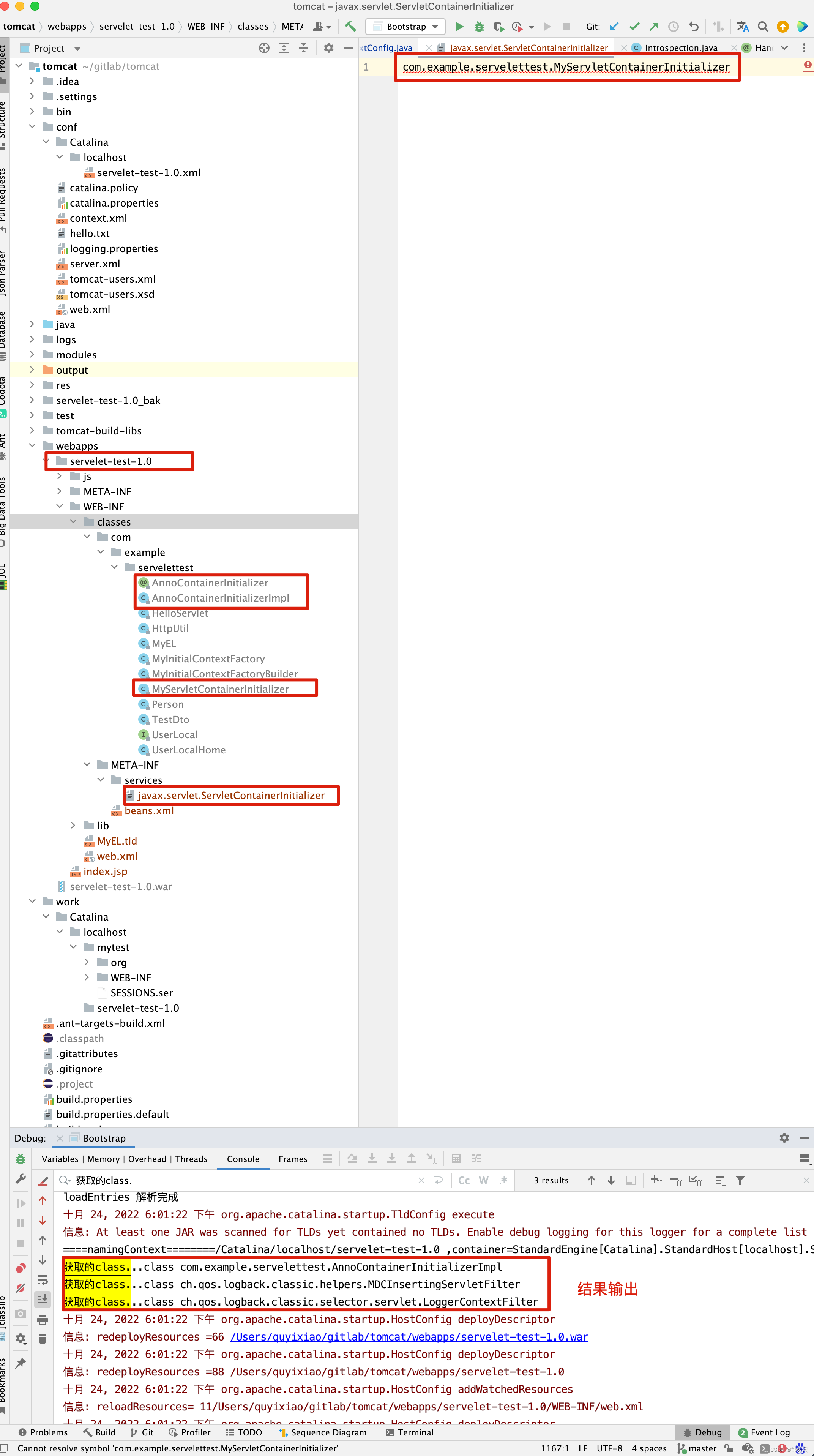
- 打断点调试

所以读源码读到这里就需要注意一点了,@HandlesTypes(value = {AnnoContainerInitializer.class,Filter.class}) 注解的value值,只能是父类,接口,或注解,而不能写AnnoContainerInitializerImpl类本身,写了也没用,经过测试,将AnnoContainerInitializer注解值改成具体的类AnnoContainerInitializerImpl,执行结果如下 。
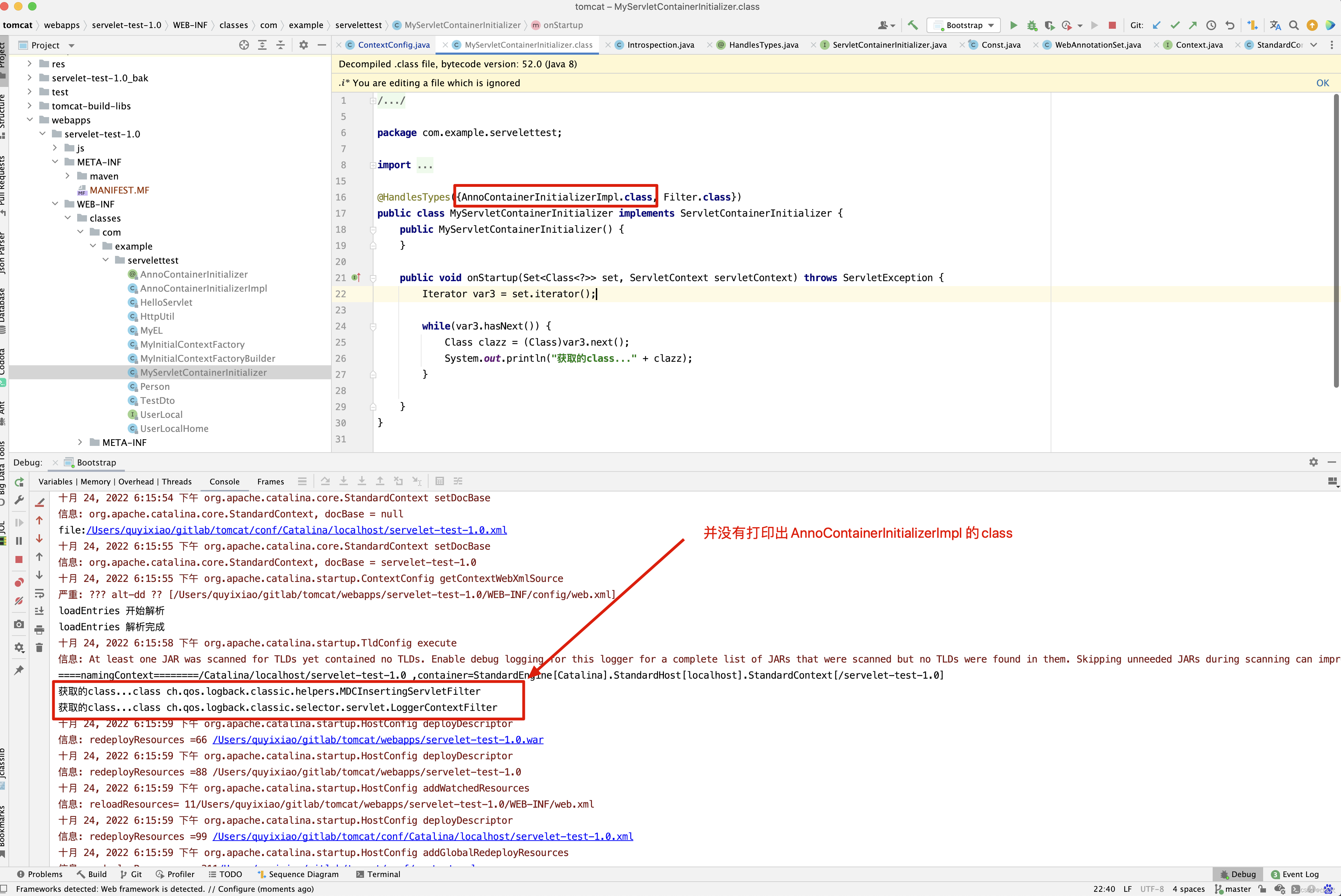
这个例子的用意应该明显了, 创建注解AnnoContainerInitializer,在AnnoContainerInitializerImpl类上配置AnnoContainerInitializer注解,自定义MyServletContainerInitializer类, 在tomcat启动时,打印了获取的class…AnnoContainerInitializerImpl,也就是说,只要在MyServletContainerInitializer的HandlesTypes中配置了注解AnnoContainerInitializer,其他类只要加了AnnoContainerInitializer注解,在tomcat启动时,在调用onStartup()方法时,会将AnnoContainerInitializerImpl的Class信息作为onStartup()方法的参数传入。有了这个例子,你对ServletContainerInitializer的源码也理解了,tomcat会扫描当前classLoader中所有的类,只要其父类或接口或注解配置在MyServletContainerInitializer的HandlesTypes中,则在启动时,会将该类作为MyServletContainerInitializer的onStartup()方法的参数传入。
接下来看解析父类及接口存储到javaClassCache中如何实现。
private void populateJavaClassCache(String className, JavaClass javaClass) { if (javaClassCache.containsKey(className)) { return; } // Add this class to the cache javaClassCache.put(className, new JavaClassCacheEntry(javaClass)); populateJavaClassCache(javaClass.getSuperclassName()); for (String interfaceName : javaClass.getInterfaceNames()) { populateJavaClassCache(interfaceName); } } private void populateJavaClassCache(String className) { if (!javaClassCache.containsKey(className)) { String name = className.replace('.', '/') + ".class"; InputStream is = context.getLoader().getClassLoader().getResourceAsStream(name); if (is == null) { return; } ClassParser parser = new ClassParser(is); try { JavaClass clazz = parser.parse(); populateJavaClassCache(clazz.getClassName(), clazz); } catch (ClassFormatException e) { log.debug(sm.getString("contextConfig.invalidSciHandlesTypes", className), e); } catch (IOException e) { log.debug(sm.getString("contextConfig.invalidSciHandlesTypes", className), e); } finally { try { is.close(); } catch (IOException e) { // ignore } } } }
populateJavaClassCache()方法也是递归解析当前类的父类及接口,并将解析的javaClass对象封装成JavaClassCacheEntry存储到javaClassCache中 ,当然JavaClassCacheEntry结构如下 。
private static class JavaClassCacheEntry {
public final String superclassName;
public final String[] interfaceNames;
private Set<ServletContainerInitializer> sciSet = null;
public JavaClassCacheEntry(JavaClass javaClass) {
superclassName = javaClass.getSuperclassName();
interfaceNames = javaClass.getInterfaceNames();
}
public String getSuperclassName() {
return superclassName;
}
public String[] getInterfaceNames() {
return interfaceNames;
}
public Set<ServletContainerInitializer> getSciSet() {
return sciSet;
}
public void setSciSet(Set<ServletContainerInitializer> sciSet) {
this.sciSet = sciSet;
}
}
从JavaClassCacheEntry的结构得知,sciSet的值来源于sciSet()方法,而setSciSet()方法在populateSCIsForCacheEntry()方法内部调用。 进入populateSCIsForCacheEntry()方法 。
private void populateSCIsForCacheEntry(JavaClassCacheEntry cacheEntry) { Set<ServletContainerInitializer> result = new HashSet<ServletContainerInitializer>(); // Super class String superClassName = cacheEntry.getSuperclassName(); JavaClassCacheEntry superClassCacheEntry = javaClassCache.get(superClassName); // Avoid an infinite loop with java.lang.Object // 当java.lang.Object的父类JavaClassCacheEntry 等于自身 // 因此设置其sciSet为空Set集合 if (cacheEntry.equals(superClassCacheEntry)) { cacheEntry.setSciSet(EMPTY_SCI_SET); return; } // May be null of the class is not present or could not be loaded. if (superClassCacheEntry != null) { if (superClassCacheEntry.getSciSet() == null) { populateSCIsForCacheEntry(superClassCacheEntry); } result.addAll(superClassCacheEntry.getSciSet()); } result.addAll(getSCIsForClass(superClassName)); // Interfaces for (String interfaceName : cacheEntry.getInterfaceNames()) { JavaClassCacheEntry interfaceEntry = javaClassCache.get(interfaceName); // A null could mean that the class not present in application or // that there is nothing of interest. Either way, nothing to do here // so move along if (interfaceEntry != null) { if (interfaceEntry.getSciSet() == null) { populateSCIsForCacheEntry(interfaceEntry); } result.addAll(interfaceEntry.getSciSet()); } result.addAll(getSCIsForClass(interfaceName)); } cacheEntry.setSciSet(result.isEmpty() ? EMPTY_SCI_SET : result); } private Set<ServletContainerInitializer> getSCIsForClass(String className) { for (Map.Entry<Class<?>, Set<ServletContainerInitializer>> entry : typeInitializerMap.entrySet()) { Class<?> clazz = entry.getKey(); if (!clazz.isAnnotation()) { if (clazz.getName().equals(className)) { return entry.getValue(); } } } return EMPTY_SCI_SET; }
populateSCIsForCacheEntry()方法看上去很复杂,原理还是很简单,只要当前类的父类或接口(【注意】不包含当前类自己)被XXXServletContainerInitializer的@HandlesTypes(value = {YYY.class}) 注解的value值配置,如YYYY.class, 因为扫描当前类会生成一个JavaClassCacheEntry对象,并存储于cacheEntry缓存中, 如果当前类的父类或接口或祖先类或祖先接口是YYYY, 则将XXXServletContainerInitializer对象设置到当前类的JavaClassCacheEntry的sciSet中。
接着看checkHandlesTypes()方法中的loadClass()方法 。
public static Class<?> loadClass(Container container, String className) { ClassLoader cl = container.getLoader().getClassLoader(); Log log = container.getLogger(); Class<?> clazz = null; try { clazz = cl.loadClass(className); } catch (ClassNotFoundException e) { log.debug(sm.getString("introspection.classLoadFailed", className), e); } catch (NoClassDefFoundError e) { log.debug(sm.getString("introspection.classLoadFailed", className), e); } catch (ClassFormatError e) { log.debug(sm.getString("introspection.classLoadFailed", className), e); } catch (Throwable t) { ExceptionUtils.handleThrowable(t); log.debug(sm.getString("introspection.classLoadFailed", className), t); } return clazz; }
这里用到的类加载器是container的类加载器。
代码分析到这里,我相信你对ServletContainerInitializer的原理已经理解了。自定义MyServletContainerInitializer配置了@HandlesTypes({AnnoContainerInitializerImpl.class, Filter.class})注解,实际上tomcat会从类加载器中扫描所有的class文件,如果其父类或接口,或祖先类或祖先接口,只要其祖先类或接口配置在HandlesTypes注解中, 则将当前类的Class添加到key为MyServletContainerInitializer对象,值为当前类的Class(其实是HashSet集合)的initializerClassMap中,如果HandlesTypes中配置了注解,则将配置了注解的类的Class 添加到initializerClassMap的集合中。 如MyServletContainerInitializer, @HandlesTypes({AnnoContainerInitializerImpl.class, Filter.class}),会将被注解修饰的类AnnoContainerInitializerImpl,以及实现了Filter接口的ch.qos.logback.classic.helpers.MDCInsertingServletFilter和ch.qos.logback.classic.selector.servlet.LoggerContextFilter添加到initializerClassMap中。
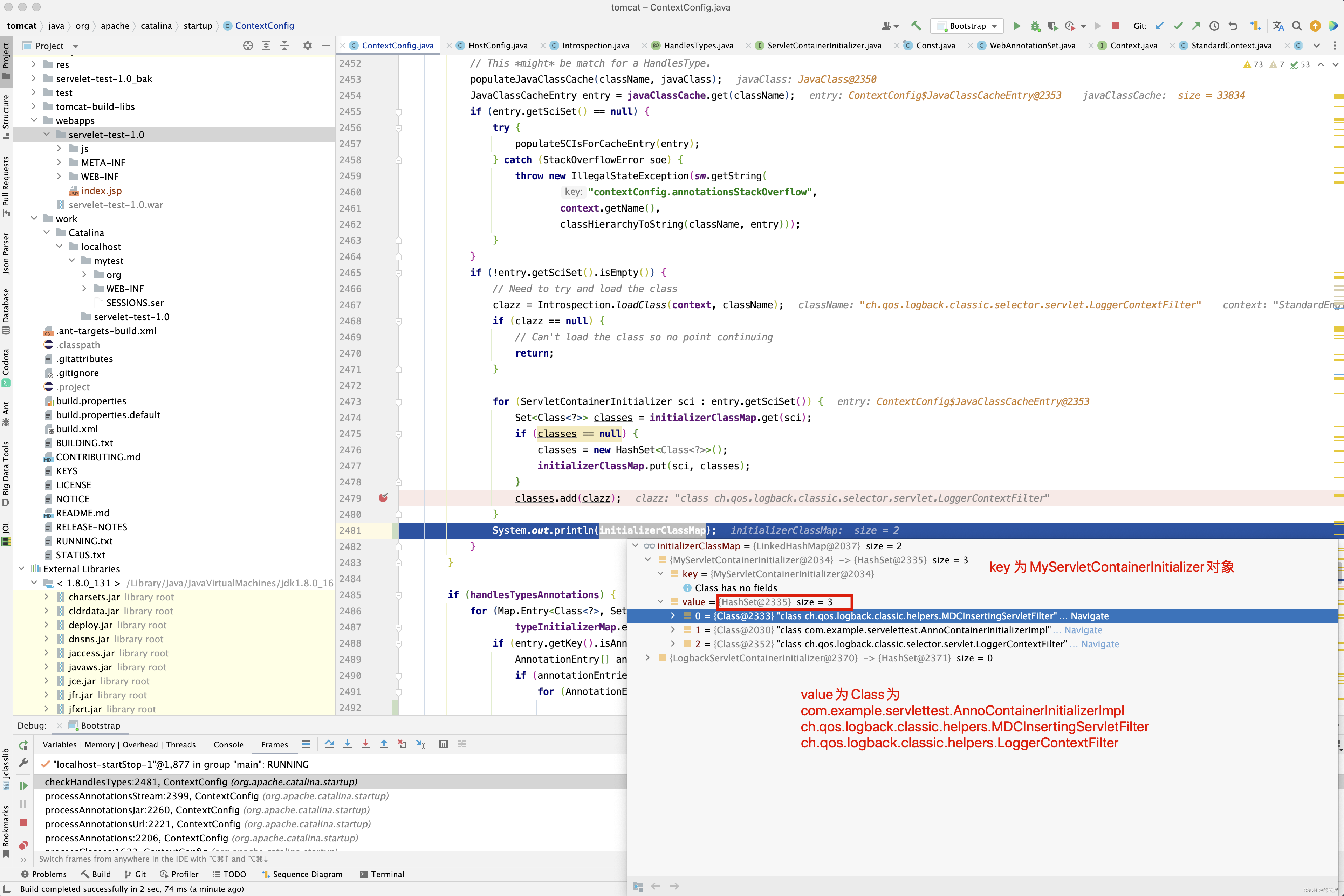
再以实战项目为例,如SpringServletContainerInitializer配置了@HandlesTypes(WebApplicationInitializer.class)

因此所有实现了WebApplicationInitializer接口的类在启动时onStartup()方法都被调用。并且将servletContext作为参数传入。
接下来看@WebServlet 和 @WebFilter 以及@WebListener 注解的处理。
// 处理注解 protected void processClass(WebXml fragment, JavaClass clazz) { AnnotationEntry[] annotationsEntries = clazz.getAnnotationEntries(); if (annotationsEntries != null) { String className = clazz.getClassName(); for (AnnotationEntry ae : annotationsEntries) { String type = ae.getAnnotationType(); if ("Ljavax/servlet/annotation/WebServlet;".equals(type)) { processAnnotationWebServlet(className, ae, fragment); }else if ("Ljavax/servlet/annotation/WebFilter;".equals(type)) { processAnnotationWebFilter(className, ae, fragment); }else if ("Ljavax/servlet/annotation/WebListener;".equals(type)) { fragment.addListener(className); } else { // Unknown annotation - ignore } } } }
上面对注解分三种情况处理,第一种情况WebServlet注解,则调用processAnnotationWebServlet()方法,WebFilter注解则调用processAnnotationWebFilter()方法,而WebListener注解,则直接将类名添加到fragment即可, 先来看WebFilter注解的解析。
/** * * @param className 被@WebServlet注解的类名 * @param ae @WebServlet注解对象 * @param fragment */ protected void processAnnotationWebServlet(String className, AnnotationEntry ae, WebXml fragment) { String servletName = null; // must search for name s. Spec Servlet API 3.0 - 8.2.3.3.n.ii page 81 List<ElementValuePair> evps = ae.getElementValuePairs(); // 遍历注解上配置的name:value对 for (ElementValuePair evp : evps) { String name = evp.getNameString(); // @WebServlet中的name为servletName if ("name".equals(name)) { servletName = evp.getValue().stringifyValue(); break; } } // 如果没有配置name,那么servletName为类名 if (servletName == null) { // classname is default servletName as annotation has no name! servletName = className; } // 查看该servletName是否在webxml中存在 ServletDef servletDef = fragment.getServlets().get(servletName); boolean isWebXMLservletDef; // 如果没有在webxml中定义,那么就定义一个Servlet if (servletDef == null) { servletDef = new ServletDef(); servletDef.setServletName(servletName); servletDef.setServletClass(className); isWebXMLservletDef = false; } else { isWebXMLservletDef = true; } boolean urlPatternsSet = false; String[] urlPatterns = null; // 可以配置多个urlPatterns // List<ElementValuePair> evps = ae.getElementValuePairs(); for (ElementValuePair evp : evps) { String name = evp.getNameString(); if ("value".equals(name) || "urlPatterns".equals(name)) { if (urlPatternsSet) { throw new IllegalArgumentException(sm.getString( "contextConfig.urlPatternValue", "WebServlet", className)); } urlPatternsSet = true; urlPatterns = processAnnotationsStringArray(evp.getValue()); } else if ("description".equals(name)) { if (servletDef.getDescription() == null) { servletDef.setDescription(evp.getValue().stringifyValue()); } } else if ("displayName".equals(name)) { if (servletDef.getDisplayName() == null) { servletDef.setDisplayName(evp.getValue().stringifyValue()); } } else if ("largeIcon".equals(name)) { if (servletDef.getLargeIcon() == null) { servletDef.setLargeIcon(evp.getValue().stringifyValue()); } } else if ("smallIcon".equals(name)) { if (servletDef.getSmallIcon() == null) { servletDef.setSmallIcon(evp.getValue().stringifyValue()); } } else if ("asyncSupported".equals(name)) { if (servletDef.getAsyncSupported() == null) { servletDef.setAsyncSupported(evp.getValue() .stringifyValue()); } } else if ("loadOnStartup".equals(name)) { if (servletDef.getLoadOnStartup() == null) { servletDef .setLoadOnStartup(evp.getValue().stringifyValue()); } } else if ("initParams".equals(name)) { // 初始化参数键值对 Map<String, String> initParams = processAnnotationWebInitParams(evp .getValue()); if (isWebXMLservletDef) { // 如果该servlet在webxml中也定义了,将注解上定义的initparams和webxml中定义的initparams合并 Map<String, String> webXMLInitParams = servletDef .getParameterMap(); for (Map.Entry<String, String> entry : initParams .entrySet()) { if (webXMLInitParams.get(entry.getKey()) == null) { servletDef.addInitParameter(entry.getKey(), entry .getValue()); } } } else { for (Map.Entry<String, String> entry : initParams .entrySet()) { servletDef.addInitParameter(entry.getKey(), entry .getValue()); } } } } if (!isWebXMLservletDef && urlPatterns != null) { // 将Servlet定义添加到fragment中 fragment.addServlet(servletDef); } if (urlPatterns != null) { // 如果webxml中对当前servletname没有配置mapping关系 if (!fragment.getServletMappings().containsValue(servletName)) { for (String urlPattern : urlPatterns) { fragment.addServletMapping(urlPattern, servletName); } } } } protected String[] processAnnotationsStringArray(ElementValue ev) { ArrayList<String> values = new ArrayList<String>(); if (ev instanceof ArrayElementValue) { ElementValue[] arrayValues = ((ArrayElementValue) ev).getElementValuesArray(); for (ElementValue value : arrayValues) { values.add(value.stringifyValue()); } } else { values.add(ev.stringifyValue()); } String[] result = new String[values.size()]; return values.toArray(result); } protected Map<String,String> processAnnotationWebInitParams( ElementValue ev) { Map<String, String> result = new HashMap<String,String>(); if (ev instanceof ArrayElementValue) { ElementValue[] arrayValues = ((ArrayElementValue) ev).getElementValuesArray(); for (ElementValue value : arrayValues) { if (value instanceof AnnotationElementValue) { List<ElementValuePair> evps = ((AnnotationElementValue) value) .getAnnotationEntry().getElementValuePairs(); String initParamName = null; String initParamValue = null; for (ElementValuePair evp : evps) { if ("name".equals(evp.getNameString())) { initParamName = evp.getValue().stringifyValue(); } else if ("value".equals(evp.getNameString())) { initParamValue = evp.getValue().stringifyValue(); } else { // Ignore } } result.put(initParamName, initParamValue); } } } return result; }
processAnnotationWebServlet()方法就是解析WebServlet注解中的属性并添加到servletDef中,接下来看WebFilter注解解析。
protected void processAnnotationWebFilter(String className, AnnotationEntry ae, WebXml fragment) { String filterName = null; // must search for name s. Spec Servlet API 3.0 - 8.2.3.3.n.ii page 81 List<ElementValuePair> evps = ae.getElementValuePairs(); for (ElementValuePair evp : evps) { String name = evp.getNameString(); if ("filterName".equals(name)) { filterName = evp.getValue().stringifyValue(); break; } } if (filterName == null) { // classname is default filterName as annotation has no name! filterName = className; } FilterDef filterDef = fragment.getFilters().get(filterName); FilterMap filterMap = new FilterMap(); boolean isWebXMLfilterDef; if (filterDef == null) { filterDef = new FilterDef(); filterDef.setFilterName(filterName); filterDef.setFilterClass(className); isWebXMLfilterDef = false; } else { isWebXMLfilterDef = true; } boolean urlPatternsSet = false; boolean servletNamesSet = false; boolean dispatchTypesSet = false; String[] urlPatterns = null; for (ElementValuePair evp : evps) { String name = evp.getNameString(); if ("value".equals(name) || "urlPatterns".equals(name)) { if (urlPatternsSet) { throw new IllegalArgumentException(sm.getString( "contextConfig.urlPatternValue", "WebFilter", className)); } urlPatterns = processAnnotationsStringArray(evp.getValue()); urlPatternsSet = urlPatterns.length > 0; for (String urlPattern : urlPatterns) { filterMap.addURLPattern(urlPattern); } } else if ("servletNames".equals(name)) { String[] servletNames = processAnnotationsStringArray(evp .getValue()); servletNamesSet = servletNames.length > 0; for (String servletName : servletNames) { filterMap.addServletName(servletName); } } else if ("dispatcherTypes".equals(name)) { String[] dispatcherTypes = processAnnotationsStringArray(evp .getValue()); dispatchTypesSet = dispatcherTypes.length > 0; for (String dispatcherType : dispatcherTypes) { filterMap.setDispatcher(dispatcherType); } } else if ("description".equals(name)) { if (filterDef.getDescription() == null) { filterDef.setDescription(evp.getValue().stringifyValue()); } } else if ("displayName".equals(name)) { if (filterDef.getDisplayName() == null) { filterDef.setDisplayName(evp.getValue().stringifyValue()); } } else if ("largeIcon".equals(name)) { if (filterDef.getLargeIcon() == null) { filterDef.setLargeIcon(evp.getValue().stringifyValue()); } } else if ("smallIcon".equals(name)) { if (filterDef.getSmallIcon() == null) { filterDef.setSmallIcon(evp.getValue().stringifyValue()); } } else if ("asyncSupported".equals(name)) { if (filterDef.getAsyncSupported() == null) { filterDef .setAsyncSupported(evp.getValue().stringifyValue()); } } else if ("initParams".equals(name)) { Map<String, String> initParams = processAnnotationWebInitParams(evp .getValue()); if (isWebXMLfilterDef) { Map<String, String> webXMLInitParams = filterDef .getParameterMap(); for (Map.Entry<String, String> entry : initParams .entrySet()) { if (webXMLInitParams.get(entry.getKey()) == null) { filterDef.addInitParameter(entry.getKey(), entry .getValue()); } } } else { for (Map.Entry<String, String> entry : initParams .entrySet()) { filterDef.addInitParameter(entry.getKey(), entry .getValue()); } } } } if (!isWebXMLfilterDef) { fragment.addFilter(filterDef); if (urlPatternsSet || servletNamesSet) { filterMap.setFilterName(filterName); fragment.addFilterMapping(filterMap); } } if (urlPatternsSet || dispatchTypesSet) { Set<FilterMap> fmap = fragment.getFilterMappings(); FilterMap descMap = null; for (FilterMap map : fmap) { if (filterName.equals(map.getFilterName())) { descMap = map; break; } } if (descMap != null) { String[] urlsPatterns = descMap.getURLPatterns(); if (urlPatternsSet && (urlsPatterns == null || urlsPatterns.length == 0)) { for (String urlPattern : filterMap.getURLPatterns()) { descMap.addURLPattern(urlPattern); } } String[] dispatcherNames = descMap.getDispatcherNames(); if (dispatchTypesSet && (dispatcherNames == null || dispatcherNames.length == 0)) { for (String dis : filterMap.getDispatcherNames()) { descMap.setDispatcher(dis); } } } } }
WebFilter注解的解析也很简单,就是将注解中的属性保存到FilterDef中,但大家解析到这里,千万不要被代码搞晕了,一定要明白此时的WebXml是谁的WebXml,如果此时扫描的是/Users/quyixiao/gitlab/tomcat/webapps/servelet-test-1.0/WEB-INF/classes下的类的注解时,此时WebXml一定是解析了/Users/quyixiao/gitlab/tomcat/webapps/servelet-test-1.0/WEB-INF/web.xml生成的WebXm,也就是主WebXml,如果WebXml是解析的是jar包下的web-fragment.xml生成的WebXml, 则都存储在Set<WebXml> fragments中,如processAnnotations()方法。
protected void processAnnotations(Set<WebXml> fragments, boolean handlesTypesOnly) { for(WebXml fragment : fragments) { WebXml annotations = new WebXml(); // no impact on distributable // 如果支持@WebServlet , @WebFilter , @WebListener注解 // 则将扫描.class得到的ServletDef , FilterDef和Listener添加到 // annotations中 annotations.setDistributable(true); URL url = fragment.getURL(); // 只要servelet-test-1.0/WEB-INF/web.xml 的metadata-complete为true // 或 jar包下的web-fragment.xml的metadata-complete属性为true processAnnotationsUrl(url, annotations, (handlesTypesOnly || fragment.isMetadataComplete())); Set<WebXml> set = new HashSet<WebXml>(); set.add(annotations); // Merge annotations into fragment - fragment takes priority fragment.merge(set); } }
最终将解析web.xml或web-fragment.xml的内容与扫描.class文件的@WebServlet和@WebFilter及@WebListener得到的ServletDef和FilterDef和Listener合并在一起。 这里需要注意。 fragment.merge(set); 合并。

如URL为jar:file:/Users/quyixiao/gitlab/tomcat/webapps/servelet-test-1.0/WEB-INF/lib/logback-classic-1.2.3.jar!/的WebXml只会与
logback-classic-1.2.3.jar包内部的扫描到.class的注解合并,先自己包的web-fragment.xml与自己包扫描class得到的ServletDef, FilterDef 及Listener合并。在processAnnotations()方法中不会发生包与包之间的web-fragment之间合并。
再回头来看webConfig()方法, 有一段代码很是诡异,请看如下
protected void webConfig() {
...
if (!webXml.isMetadataComplete()) {
// Step 6. Merge web-fragment.xml files into the main web.xml
// file.
if (ok) {
ok = webXml.merge(orderedFragments);
}
webXml.merge(defaults);
// Step 8. Convert explicitly mentioned jsps to servlets
if (ok) {
convertJsps(webXml);
}
// Step 9. Apply merged web.xml to Context
if (ok) {
webXml.configureContext(context);
}
} else {
webXml.merge(defaults); // 默认情况下, defaults就是conf/web.xml文件对应的WebXml对象
convertJsps(webXml); // 将jsp转化为Servlet
webXml.configureContext(context); // 根据webxml配置context,比如把定义的servlet转化为wrapper,然后添加到StandardContext中,还包括很多其他的
}
String mergedWebXml = webXml.toXml();
sContext.setAttribute(
org.apache.tomcat.util.scan.Constants.MERGED_WEB_XML,
mergedWebXml);
// 打印合并好的WebXml
if (true || context.getLogEffectiveWebXml()) {
log.info("web.xml:\n" + mergedWebXml);
}
...
}
如果/Users/quyixiao/gitlab/tomcat/webapps/servelet-test-1.0/WEB-INF/web.xml文件中配置了metadata-complete=“true”,则不会合并orderedFragments。这什么意思呢?如下
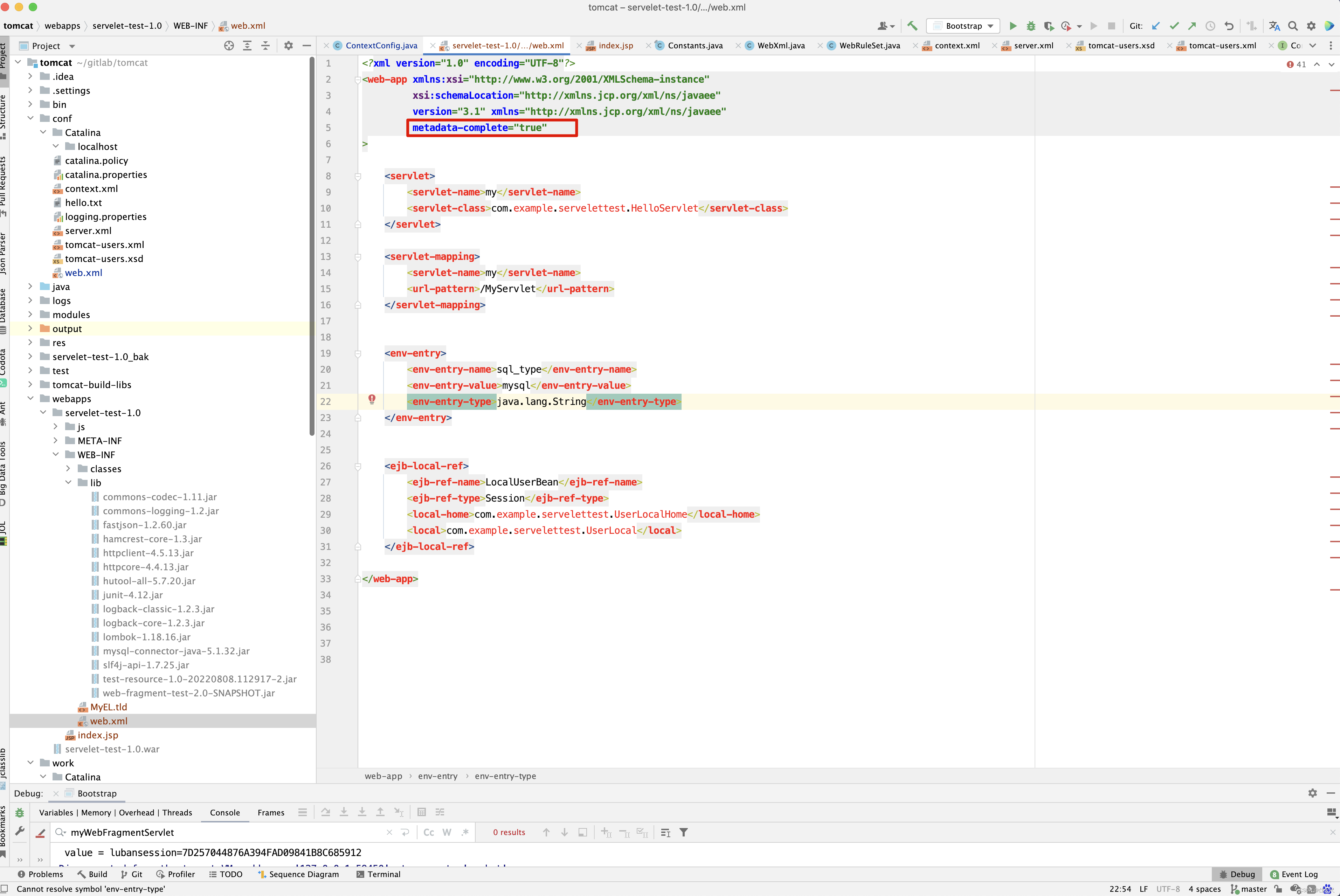
也就是说,只要web.xml中配置了metadata-complete=“true”,则丢弃扫描到jar包的web-fragment.xml及jar包的@WebServlet , @WebFilter 以及@WebListener注解。说这么多,还是来看个例子。
-
创建 web-fragment-test 项目 ,目录结构如下
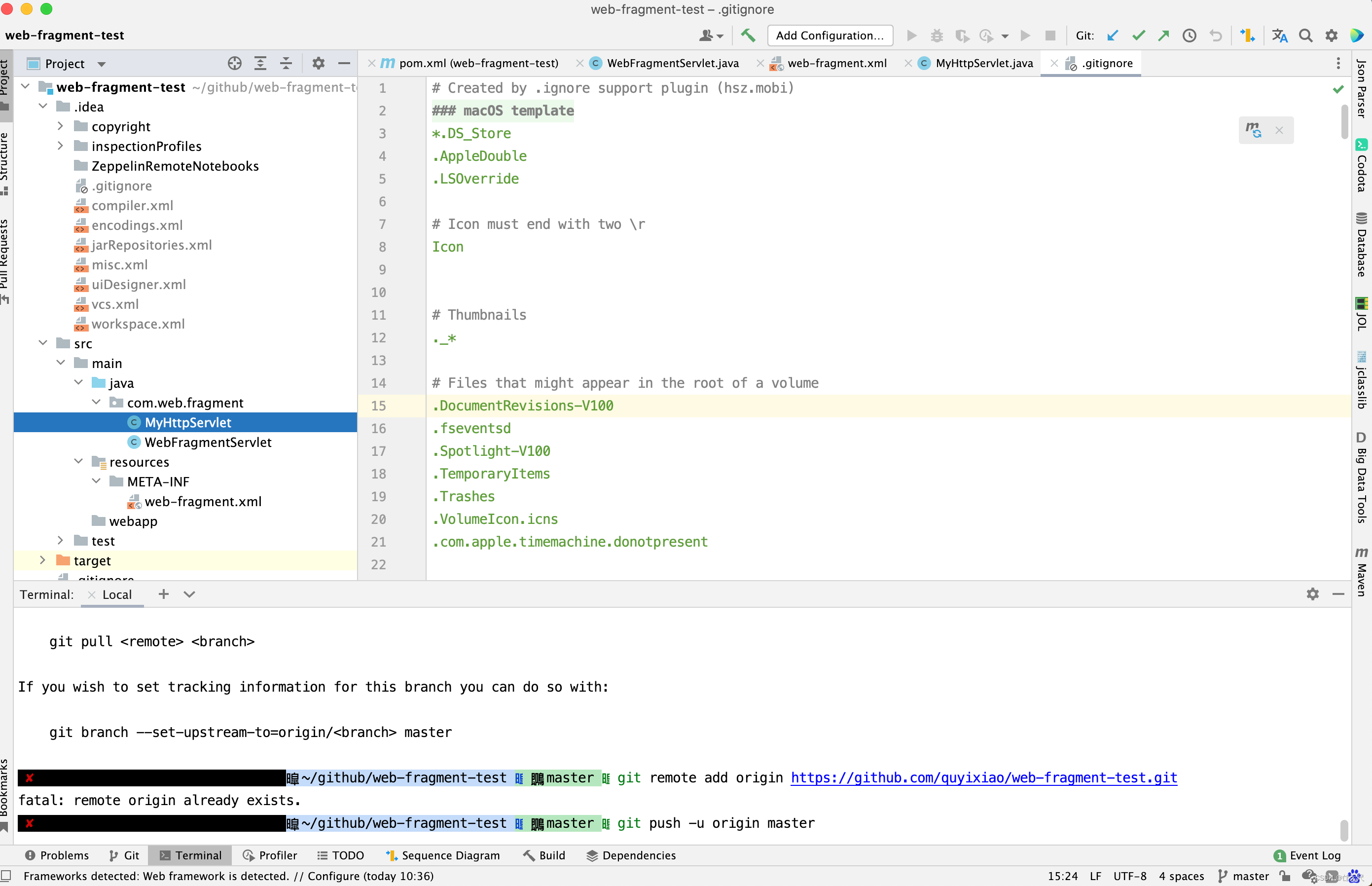
-
创建 MyHttpServlet , WebFragmentServlet 以及web-fragment.xml
@WebServlet(asyncSupported = true, name = "MyHttpServlet", description = "name描述", loadOnStartup = 1, urlPatterns = {
"/myHttpServlet"}, initParams = {
@WebInitParam(name = "Hello", value = "MyHttpServlet!", description = "init参数1"),
@WebInitParam(name = "Hi", value = "World!", description = "init参数2")})
public class MyHttpServlet extends HttpServlet {
public void doGet(HttpServletRequest req, HttpServletResponse resp) throws ServletException, IOException {
//获取Servlet初始化参数
ServletConfig config = this.getServletConfig();
String hello = config.getInitParameter("Hello");
String Hi = config.getInitParameter("Hi");
resp.setContentType("text/html;charset=UTF-8");
PrintWriter writer = resp.getWriter();
writer.write("Hello:" + hello + " Hi:" + Hi);
writer.close();
}
public void doPost(HttpServletRequest req, HttpServletResponse resp) throws ServletException, IOException {
}
}
public class WebFragmentServlet extends HttpServlet {
protected void doGet(HttpServletRequest request, HttpServletResponse response) throws ServletException, IOException {
try {
System.out.println("WebFragmentServlet ......");
} catch (Exception e) {
e.printStackTrace();
} finally {
}
}
protected void doPost(HttpServletRequest req, HttpServletResponse resp) throws ServletException, IOException {
System.out.println("doGet方法执行");
this.doGet(req, resp);
}
}
web-fragment.xml
<?xml version="1.0" encoding="UTF-8"?>
<web-fragment xmlns:xsi="http://www.w3.org/2001/XMLSchema-instance"
xsi:schemaLocation="http://xmlns.jcp.org/xml/ns/javaee"
version="3.1" xmlns="http://xmlns.jcp.org/xml/ns/javaee"
metadata-complete="false"
>
<servlet>
<servlet-name>webFragmentServlet</servlet-name>
<servlet-class>com.web.fragment.WebFragmentServlet</servlet-class>
</servlet>
<servlet-mapping>
<servlet-name>webFragmentServlet</servlet-name>
<url-pattern>/myWebFragmentServlet</url-pattern>
</servlet-mapping>
</web-fragment>
-
运行mvn clean deploy 命令,打包项目 ,并将web-fragment-test包导入到servelet-test项目中。
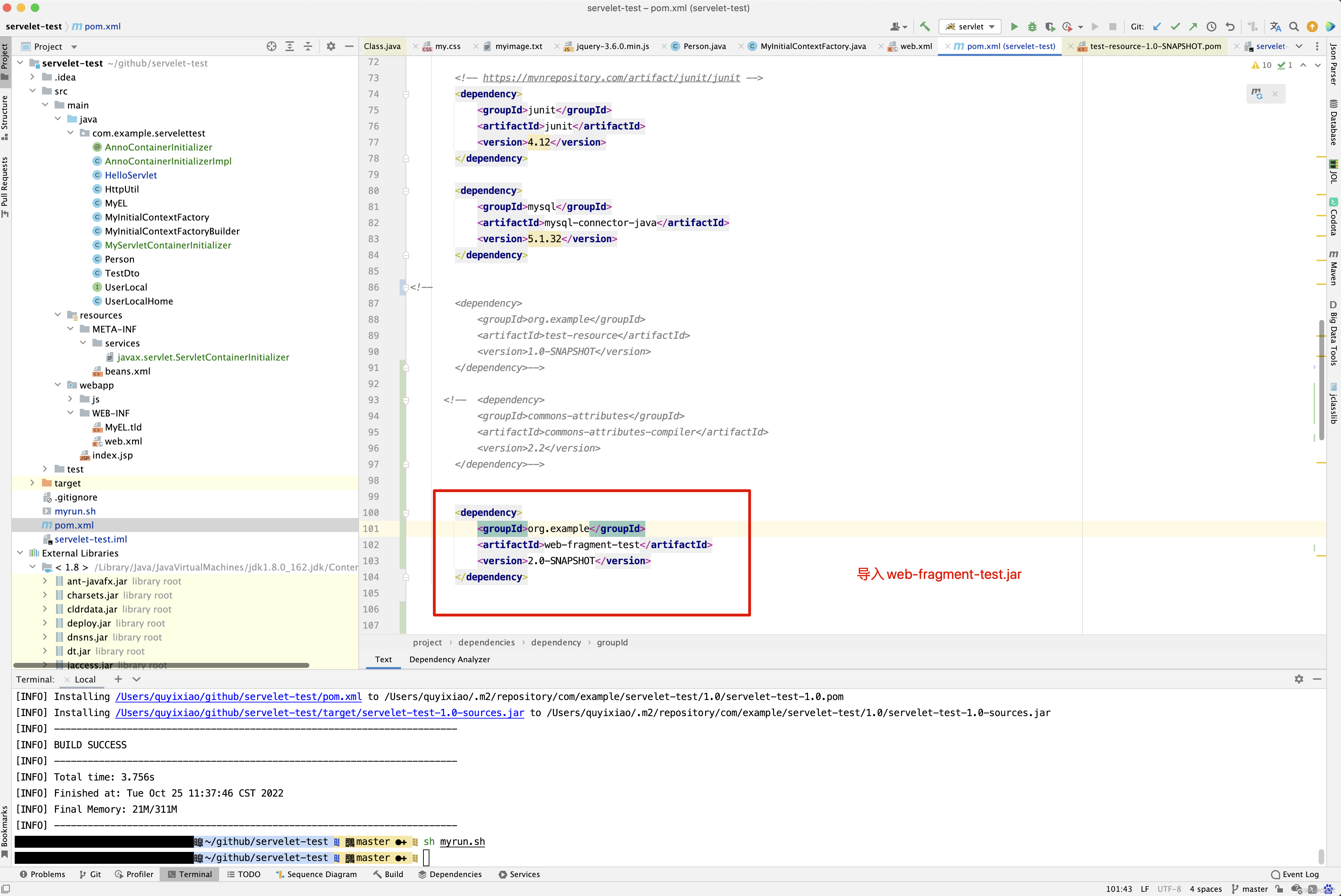
servlet-test-1.0的WEB-INF/web.xml文件中配置metadata-complete=“false”
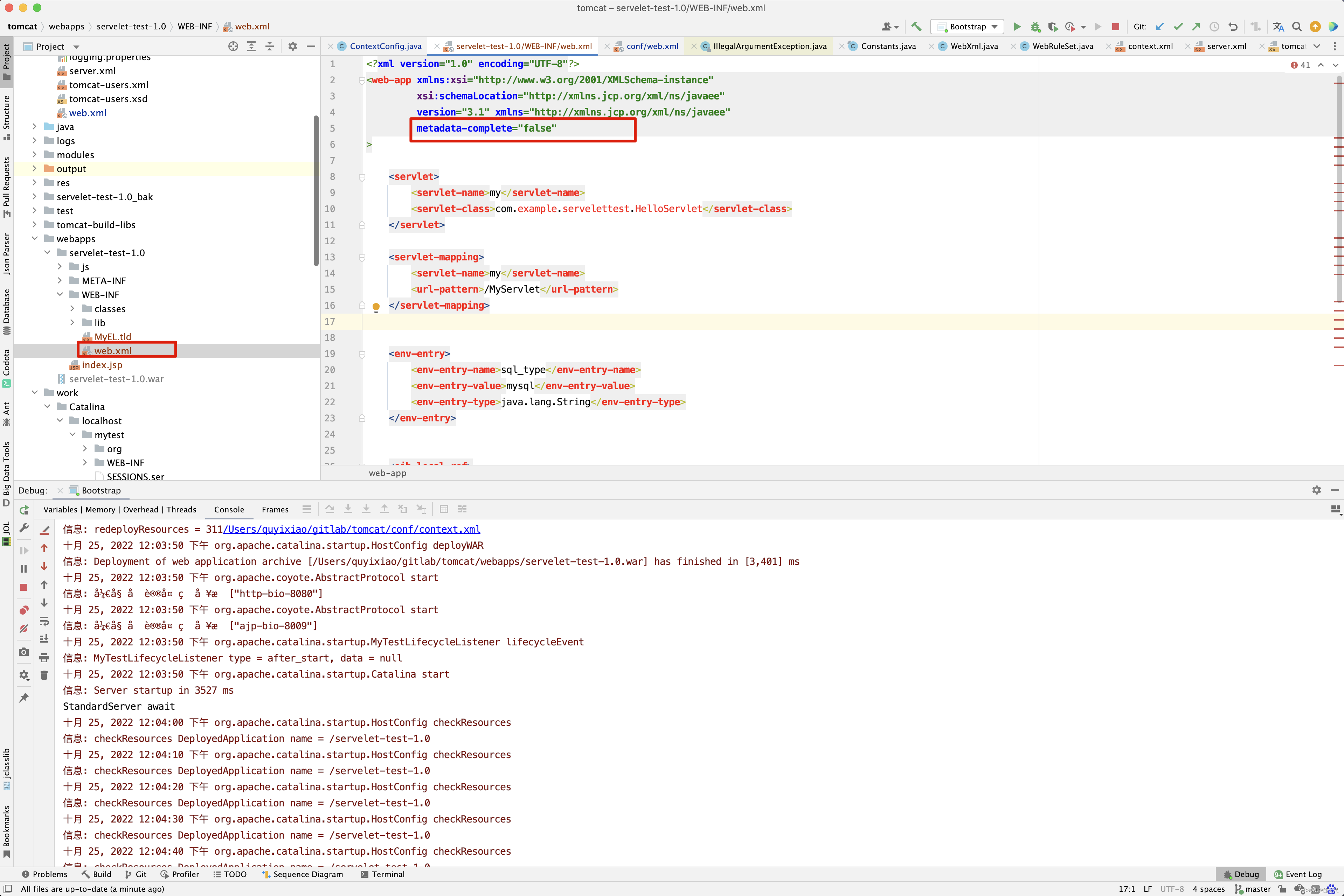
-
打印合并后的WebXml

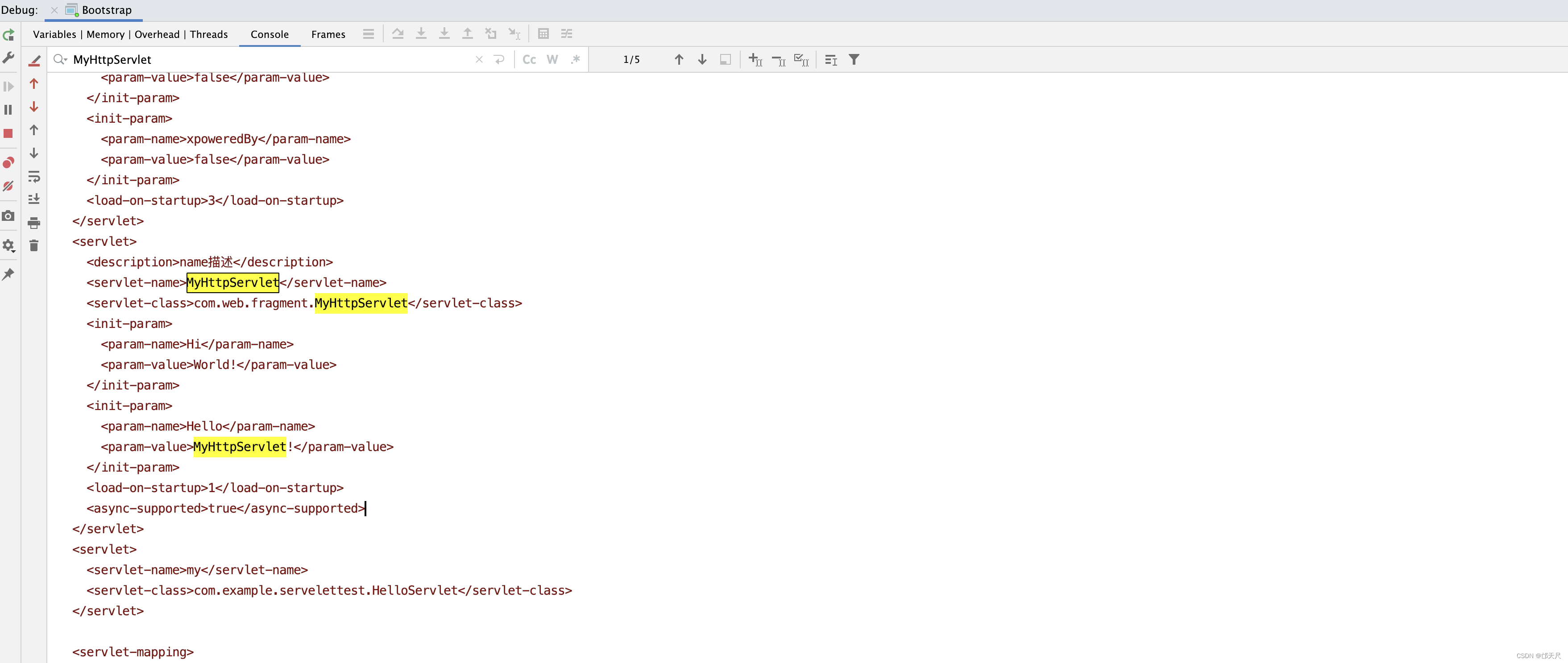
-
测试myHttpServlet的servlet, myHttpServlet提供服务 。

6.将servelet-test-1.0/WEB-INF/web.xml中 metadata-complete=“true”,重启项目 ,启动日志中打印合并后的WebXml,无myWebFragmentServlet和myHttpServlet


-
测试http://localhost:8080/servelet-test-1.0/myHttpServlet ,无法访问 。
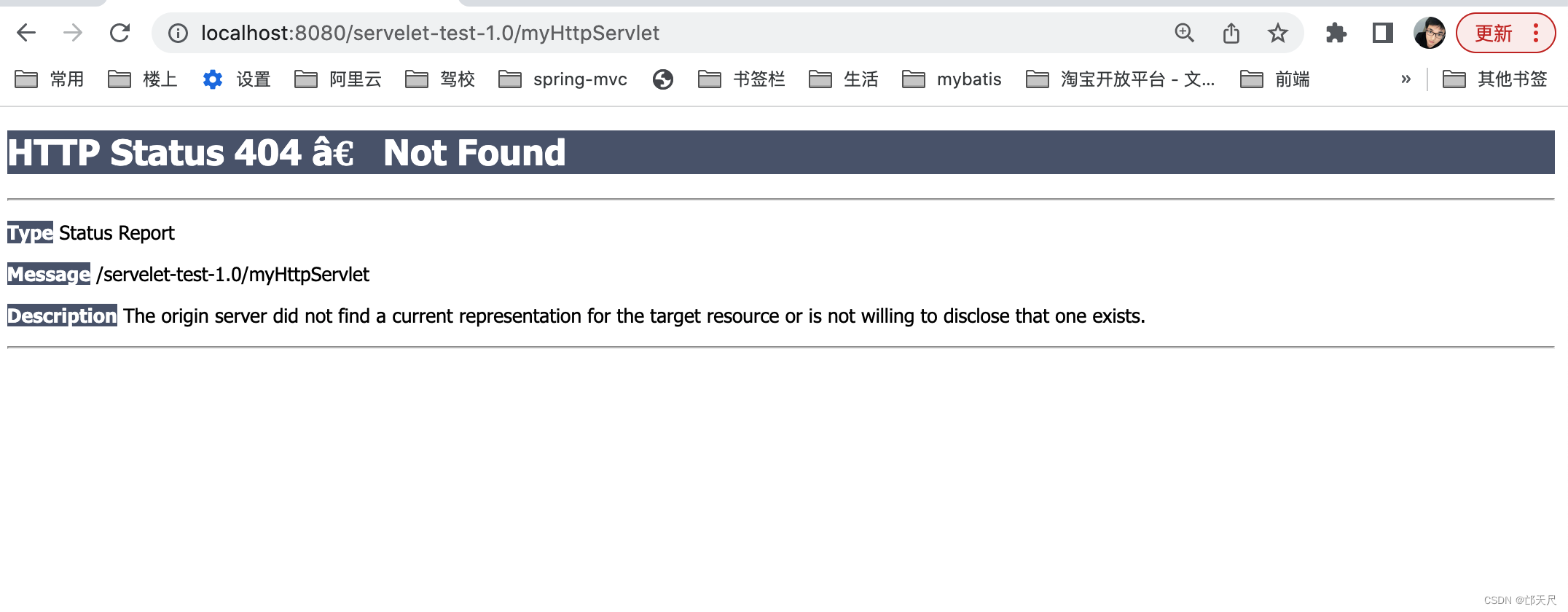
现在来总结一下metadata-complete="true|false"的用途了, 但这里要区分一下主web.xml下配置的metadata-complete和jar包下web-fragment.xml配置的metadata-complete,再来回顾一下之前分析过的3个方法。
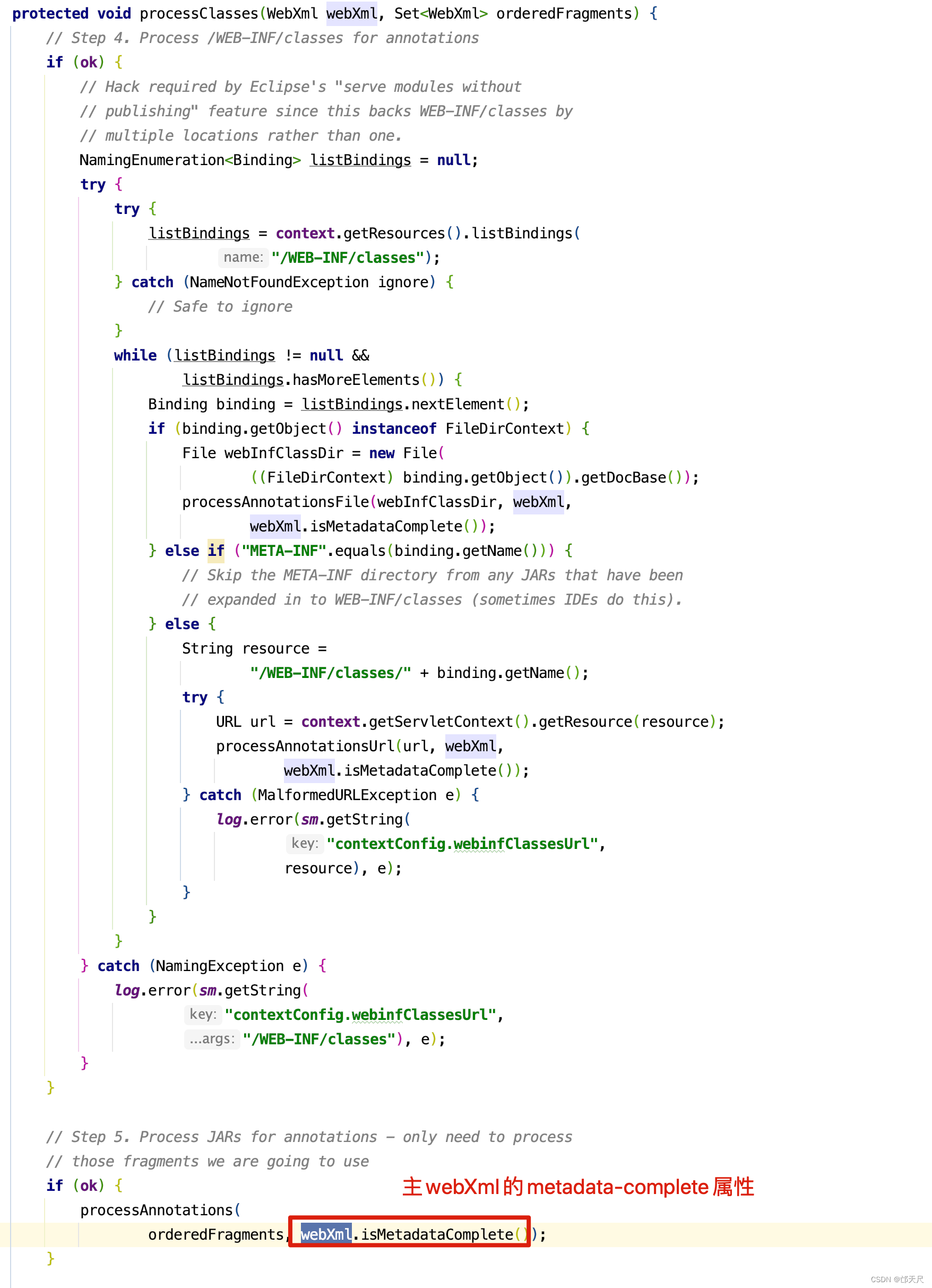


metadata-complete总结
以servelet-test-1.0项目为例,这里注解表示@WebServlet, @WebFilter , @Weblistener注解
- 如果主web.xml和jar中的web-fragment.xml都配置了metadata-complete=“true”,则不会扫描项目下的/Users/quyixiao/gitlab/tomcat/webapps/servelet-test-1.0/WEB-INF/classes的class文件中的注解,也不会扫描jar包中的class文件中的注解,而扫描到的web-fragment.xml文件中的内容也不会合并到主WebXml中
- 如果主web.xml的metadata-complete=“true”,但web-fragment.xml都配置了metadata-complete=“false”,jar包下的WebXml是不会扫描其.class文件的注解的,同时扫描web-fragment.xml文件生成的WebXml也不会合并到主WebXml中,同样也不会扫描项目下的/Users/quyixiao/gitlab/tomcat/webapps/servelet-test-1.0/WEB-INF/classes的class文件中的注解
- 如果主web.xml的metadata-complete="false"和jar中的web-fragment.xml都配置了metadata-complete=“true” , 会扫描/Users/quyixiao/gitlab/tomcat/webapps/servelet-test-1.0/WEB-INF/classes的class文件中的注解,但不会扫描jar包文件中.class文件中注解,但会将解析jar包下的web-fragment.xml文件生成的WebXml合并到主WebXml中。
- 如果主web.xml和jar中的web-fragment.xml都配置了metadata-complete=“false”,则会扫描/Users/quyixiao/gitlab/tomcat/webapps/servelet-test-1.0/WEB-INF/classes的class文件中的注解, 同时会扫描jar包内class文件的注解,合并到其jar包对应的web-fragment.xml生成的WebXml中,最后会将所有的jar包下的WebXml合并到主的WebXml中。
当然,默认情况下metadata-complete=“false”,我相信只有这样分析,才能真正的明白metadata-complete的作用,因此网上一般只会讲到主web.xml中配置metadata-complete的作用,并没有考虑其WEB-INF/lib下jar包的web-fragment.xml中配置的metadata-complete,同样网上也忽略了,【如果主web.xml中配置了metadata-complete="true"时,则不会将lib/jar包中的web-fragment.xml生成的WebXml合并到主WebXml中来。】
WebXml合并
public boolean merge(Set<WebXml> fragments) { // As far as possible, process in alphabetical order so it is easy to // check everything is present // Merge rules vary from element to element. See SRV.8.2.3 WebXml temp = new WebXml(); for (WebXml fragment : fragments) { // 如果主web.xml没有配置context-param标签,但 // lib/jar包中配置了context-param标签 。 // 如果a.jar和b.jar的WebXml都配置了context-param,但value值不相等,则返回false if (!mergeMap(fragment.getContextParams(), contextParams, temp.getContextParams(), fragment, "Context Parameter")) { return false; } } contextParams.putAll(temp.getContextParams()); // 如果主WebXml中已经有displayName不为空,则不会扫描jar包中的WebXml的displayName属性了 if (displayName == null) { for (WebXml fragment : fragments) { String value = fragment.getDisplayName(); if (value != null) { if (temp.getDisplayName() == null) { temp.setDisplayName(value); } else { // 如果a.jar和b.jar的WebXml中的displayName不相等 // 则打印错误并返回 log.error(sm.getString( "webXml.mergeConflictDisplayName", fragment.getName(), fragment.getURL())); return false; } } } displayName = temp.getDisplayName(); } // 无论是主WebXml还是jar包的WebXml中distributable,只要有一个WebXml为false,则distributable为false if (distributable) { for (WebXml fragment : fragments) { if (!fragment.isDistributable()) { distributable = false; break; } } } for (WebXml fragment : fragments) { // 如果主WebXml中存在,则将所有的jar包中的配置加到主WebXml中, // 如果主WebXml中不存在,jar包的WebXml冲突了,则打印错误日志并返回false if (!mergeResourceMap(fragment.getEjbLocalRefs(), ejbLocalRefs, temp.getEjbLocalRefs(), fragment)) { return false; } } ejbLocalRefs.putAll(temp.getEjbLocalRefs()); for (WebXml fragment : fragments) { if (!mergeResourceMap(fragment.getEjbRefs(), ejbRefs, temp.getEjbRefs(), fragment)) { return false; } } ejbRefs.putAll(temp.getEjbRefs()); for (WebXml fragment : fragments) { if (!mergeResourceMap(fragment.getEnvEntries(), envEntries, temp.getEnvEntries(), fragment)) { return false; } } envEntries.putAll(temp.getEnvEntries()); for (WebXml fragment : fragments) { if (!mergeMap(fragment.getErrorPages(), errorPages, temp.getErrorPages(), fragment, "Error Page")) { return false; } } errorPages.putAll(temp.getErrorPages()); ....
合并WebXml这一块的代码真多,但原理很简单,如果主WebXml没有,但jar包的WebXml有,则将WebXml添加到主的WebXml中,但如果jar包之间的WebXml属性冲突时,则打印错误日志,并返回,大部分都是这样的实现逻辑,代码不难,细心一点就能看明白,这里就不深入了。
再来看convertJsps()这段代码的实现。
private void convertJsps(WebXml webXml) { Map<String,String> jspInitParams; ServletDef jspServlet = webXml.getServlets().get("jsp"); if (jspServlet == null) { jspInitParams = new HashMap<String,String>(); Wrapper w = (Wrapper) context.findChild("jsp"); if (w != null) { String[] params = w.findInitParameters(); for (String param : params) { jspInitParams.put(param, w.findInitParameter(param)); } } } else { jspInitParams = jspServlet.getParameterMap(); } for (ServletDef servletDef: webXml.getServlets().values()) { if (servletDef.getJspFile() != null) { convertJsp(servletDef, jspInitParams); } } } private void convertJsp(ServletDef servletDef, Map<String,String> jspInitParams) { servletDef.setServletClass("org.apache.jasper.servlet.JspServlet"); String jspFile = servletDef.getJspFile(); if ((jspFile != null) && !jspFile.startsWith("/")) { if (context.isServlet22()) { if(log.isDebugEnabled()) log.debug(sm.getString("contextConfig.jspFile.warning", jspFile)); jspFile = "/" + jspFile; } else { throw new IllegalArgumentException (sm.getString("contextConfig.jspFile.error", jspFile)); } } servletDef.getParameterMap().put("jspFile", jspFile); servletDef.setJspFile(null); for (Map.Entry<String, String> initParam: jspInitParams.entrySet()) { servletDef.addInitParameter(initParam.getKey(), initParam.getValue()); } }
convertJsps()方法的用意是什么呢?来看个例子。
- 在在servlet-test项目的web.xml添加servlet配置,配置中有jsp-file标签
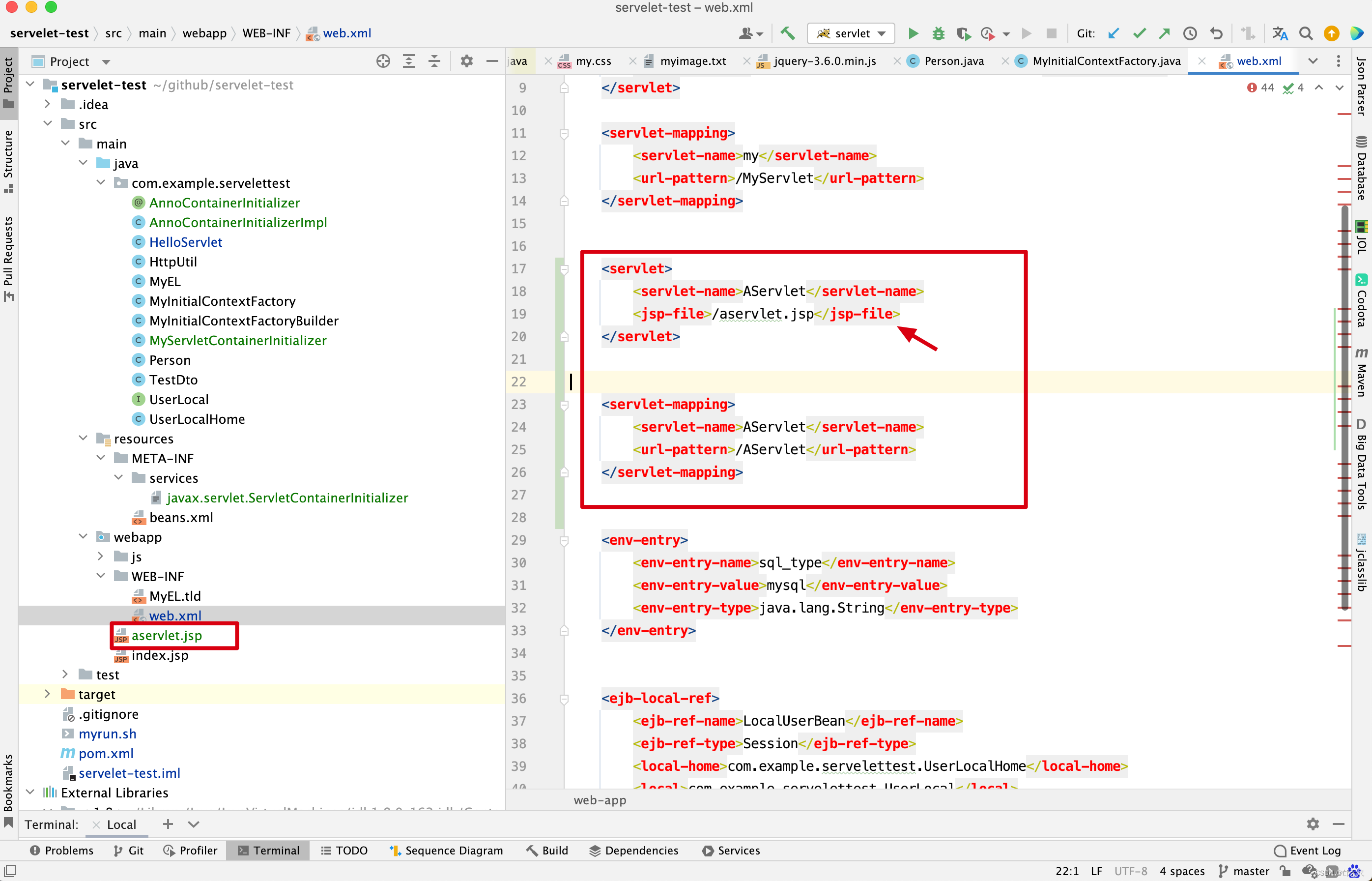
web.xml
<servlet>
<servlet-name>AServlet</servlet-name>
<jsp-file>/aservlet.jsp</jsp-file>
</servlet>
<servlet-mapping>
<servlet-name>AServlet</servlet-name>
<url-pattern>/AServlet</url-pattern>
</servlet-mapping>
aservlet.jsp
<%@ page language="java" contentType="text/html; charset=UTF-8"
pageEncoding="UTF-8"%>
<!DOCTYPE html PUBLIC "-//W3C//DTD HTML 4.01 Transitional//EN" "http://www.w3.org/TR/html4/loose.dtd">
<html>
<head>
<meta http-equiv="Content-Type" content="text/html; charset=UTF-8">
<title>Insert title here</title>
</head>
<body>
AServlet
</body>
</html>
-
在convertJsp()方法中打断点 。
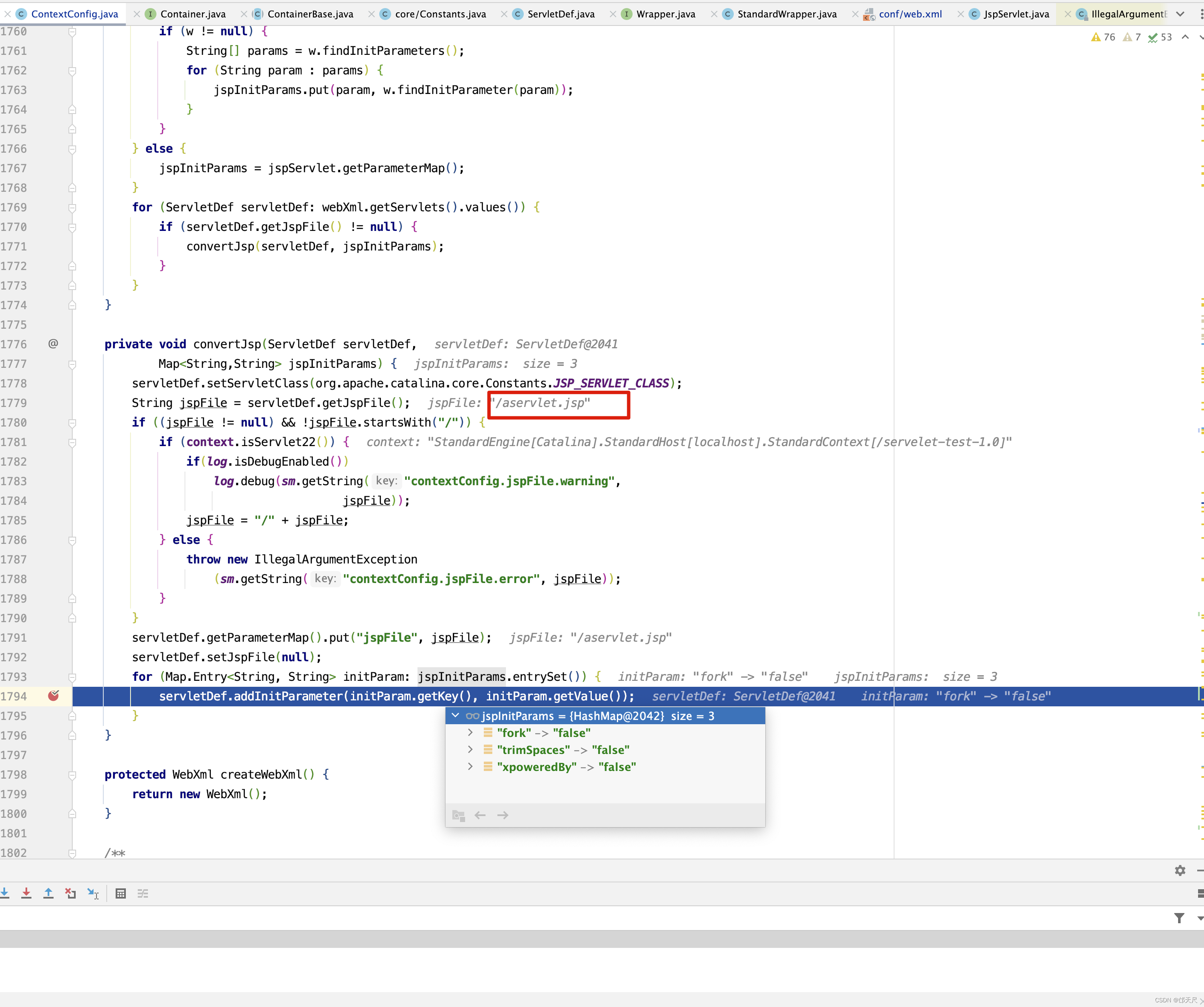
-
再看catalina.base/conf/web.xml中的jsp配置
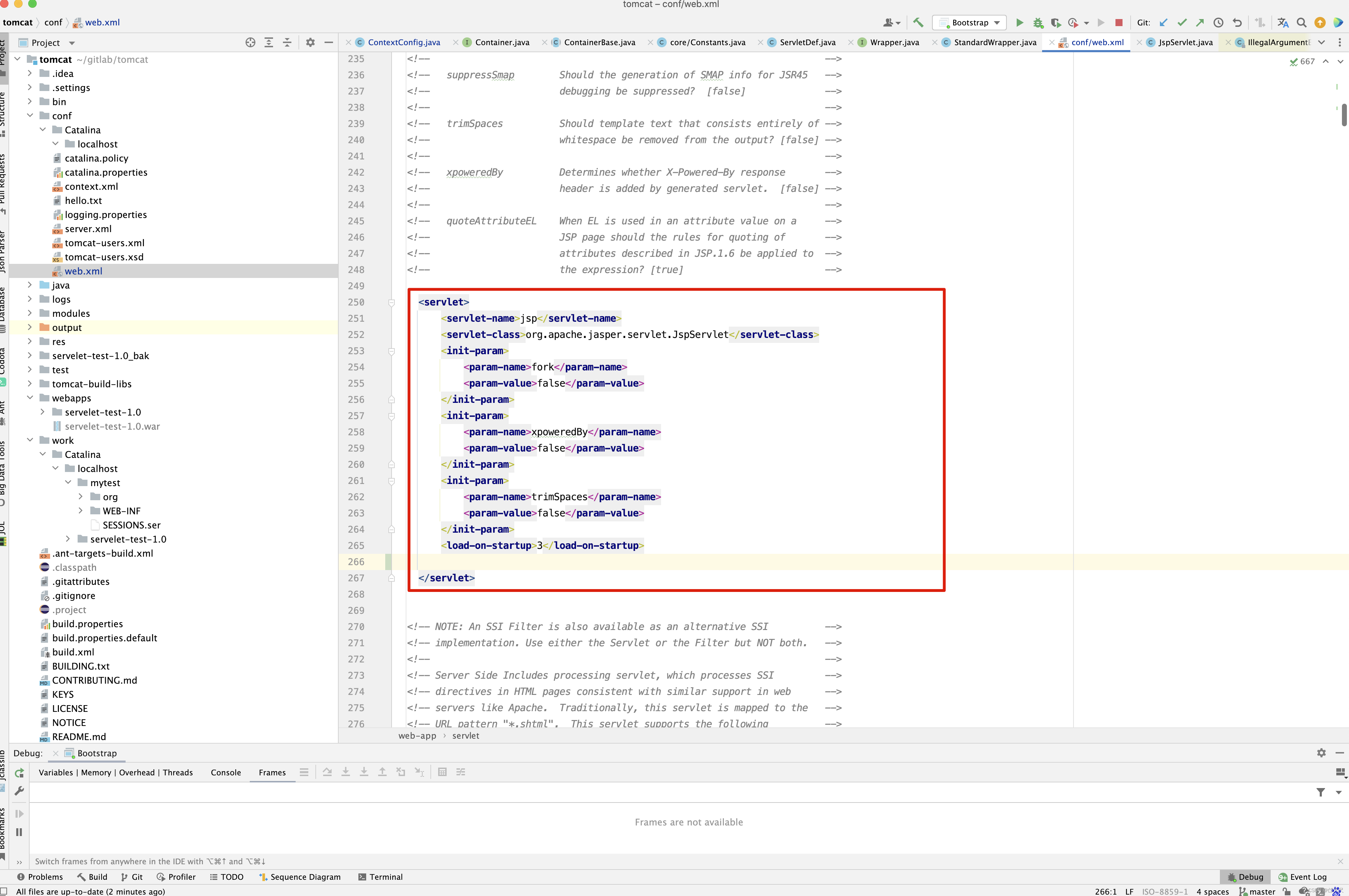
所以convertJsps()方法的主要目的就是将默认的jsp标签的初始化配置设置到项目中配置了jsp-file标签的Servlet中,当然如果项目中配置了jsp-file,<servlet-class />将无用,在项目的web.xml中添加<servlet-class>com.example.servelettest.AAAServlet</servlet-class>
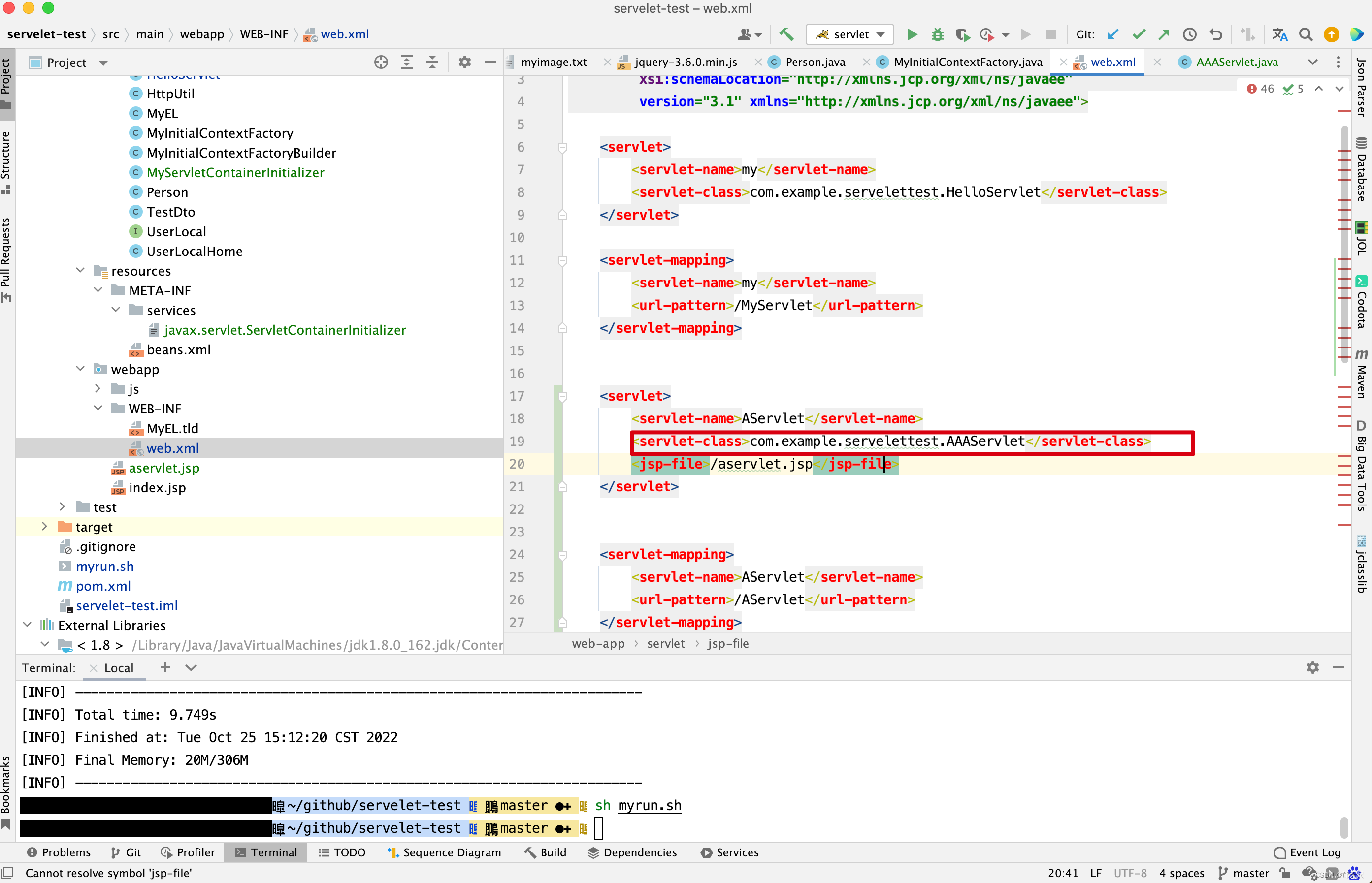
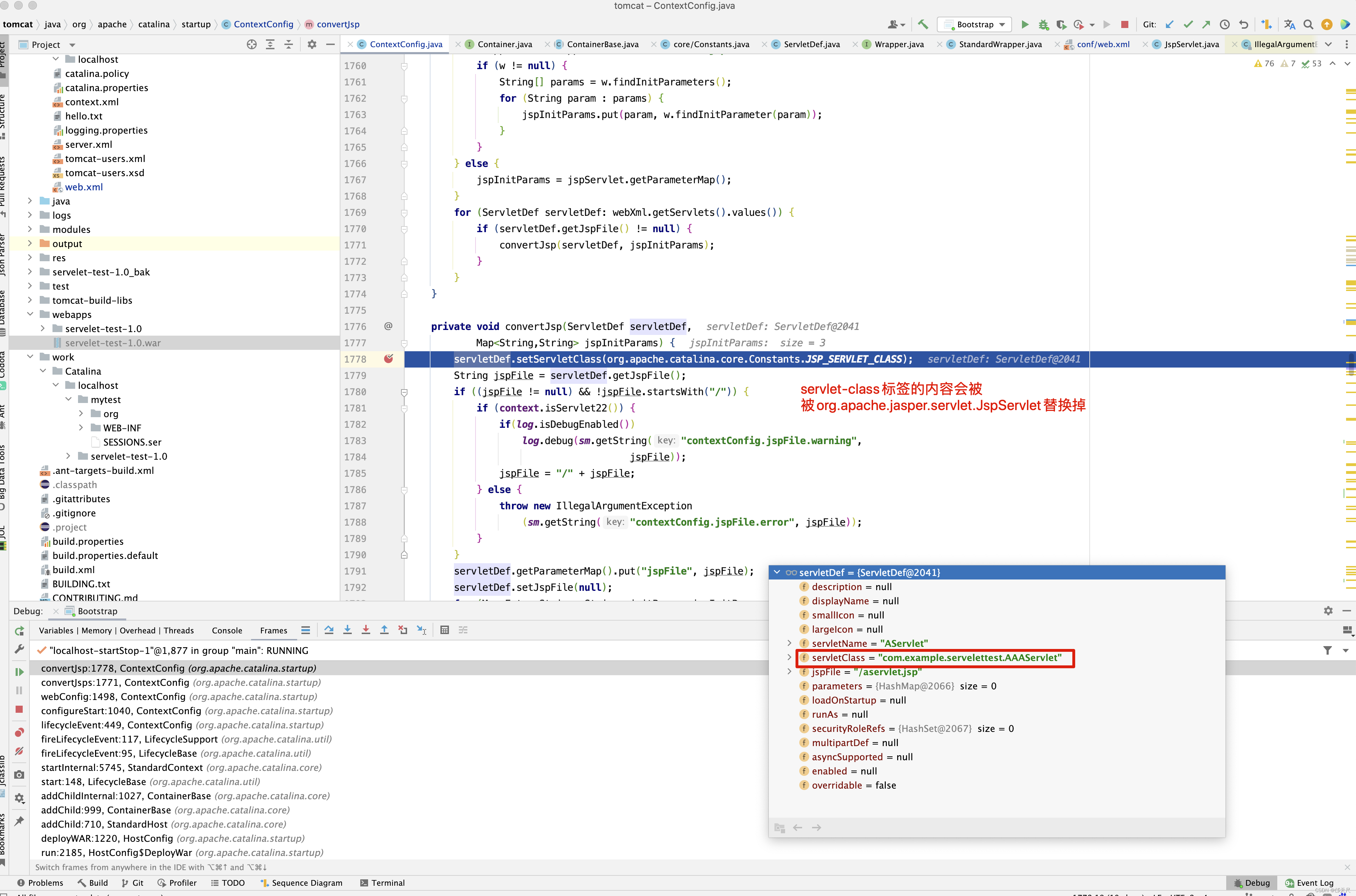
com.example.servelettest.AAAServlet会被默认的org.apache.jasper.servlet.JspServlet替换掉。
我相信你已经对convertJsp()方法有所理解了, 接下来看configureContext()方法
public void configureContext(Context context) { // As far as possible, process in alphabetical order so it is easy to // check everything is present // Some validation depends on correct public ID context.setPublicId(publicId); // Everything else in order context.setEffectiveMajorVersion(getMajorVersion()); context.setEffectiveMinorVersion(getMinorVersion()); for (Entry<String, String> entry : contextParams.entrySet()) { context.addParameter(entry.getKey(), entry.getValue()); } context.setDisplayName(displayName); context.setDistributable(distributable); for (ContextLocalEjb ejbLocalRef : ejbLocalRefs.values()) { context.getNamingResources().addLocalEjb(ejbLocalRef); } for (ContextEjb ejbRef : ejbRefs.values()) { context.getNamingResources().addEjb(ejbRef); } for (ContextEnvironment environment : envEntries.values()) { context.getNamingResources().addEnvironment(environment); } for (ErrorPage errorPage : errorPages.values()) { context.addErrorPage(errorPage); } for (FilterDef filter : filters.values()) { if (filter.getAsyncSupported() == null) { filter.setAsyncSupported("false"); } context.addFilterDef(filter); } for (FilterMap filterMap : filterMaps) { context.addFilterMap(filterMap); } for (JspPropertyGroup jspPropertyGroup : jspPropertyGroups) { JspPropertyGroupDescriptor descriptor = new ApplicationJspPropertyGroupDescriptor(jspPropertyGroup); context.getJspConfigDescriptor().getJspPropertyGroups().add( descriptor); } for (String listener : listeners) { context.addApplicationListener(listener); } for (Entry<String, String> entry : localeEncodingMappings.entrySet()) { context.addLocaleEncodingMappingParameter(entry.getKey(), entry.getValue()); } // Prevents IAE if (loginConfig != null) { context.setLoginConfig(loginConfig); } for (MessageDestinationRef mdr : messageDestinationRefs.values()) { context.getNamingResources().addMessageDestinationRef(mdr); } // messageDestinations were ignored in Tomcat 6, so ignore here context.setIgnoreAnnotations(metadataComplete); for (Entry<String, String> entry : mimeMappings.entrySet()) { context.addMimeMapping(entry.getKey(), entry.getValue()); } // Name is just used for ordering for (ContextResourceEnvRef resource : resourceEnvRefs.values()) { context.getNamingResources().addResourceEnvRef(resource); } for (ContextResource resource : resourceRefs.values()) { context.getNamingResources().addResource(resource); } for (SecurityConstraint constraint : securityConstraints) { context.addConstraint(constraint); } for (String role : securityRoles) { context.addSecurityRole(role); } for (ContextService service : serviceRefs.values()) { context.getNamingResources().addService(service); } // 遍历所有的servlet,创建wrapper for (ServletDef servlet : servlets.values()) { Wrapper wrapper = context.createWrapper(); // Description is ignored // Display name is ignored // Icons are ignored // jsp-file gets passed to the JSP Servlet as an init-param if (servlet.getLoadOnStartup() != null) { wrapper.setLoadOnStartup(servlet.getLoadOnStartup().intValue()); } if (servlet.getEnabled() != null) { wrapper.setEnabled(servlet.getEnabled().booleanValue()); } wrapper.setName(servlet.getServletName()); Map<String,String> params = servlet.getParameterMap(); for (Entry<String, String> entry : params.entrySet()) { wrapper.addInitParameter(entry.getKey(), entry.getValue()); } wrapper.setRunAs(servlet.getRunAs()); Set<SecurityRoleRef> roleRefs = servlet.getSecurityRoleRefs(); for (SecurityRoleRef roleRef : roleRefs) { wrapper.addSecurityReference( roleRef.getName(), roleRef.getLink()); } wrapper.setServletClass(servlet.getServletClass()); MultipartDef multipartdef = servlet.getMultipartDef(); if (multipartdef != null) { if (multipartdef.getMaxFileSize() != null && multipartdef.getMaxRequestSize()!= null && multipartdef.getFileSizeThreshold() != null) { wrapper.setMultipartConfigElement(new MultipartConfigElement( multipartdef.getLocation(), Long.parseLong(multipartdef.getMaxFileSize()), Long.parseLong(multipartdef.getMaxRequestSize()), Integer.parseInt( multipartdef.getFileSizeThreshold()))); } else { wrapper.setMultipartConfigElement(new MultipartConfigElement( multipartdef.getLocation())); } } if (servlet.getAsyncSupported() != null) { wrapper.setAsyncSupported( servlet.getAsyncSupported().booleanValue()); } wrapper.setOverridable(servlet.isOverridable()); // 把wrapper添加到context中去 context.addChild(wrapper); } // 把mapping关系添加到context中去 for (Entry<String, String> entry : servletMappings.entrySet()) { context.addServletMapping(entry.getKey(), entry.getValue()); } // 如果WebXML中配置了session-config if (sessionConfig != null) { if (sessionConfig.getSessionTimeout() != null) { context.setSessionTimeout( sessionConfig.getSessionTimeout().intValue()); } SessionCookieConfig scc = context.getServletContext().getSessionCookieConfig(); scc.setName(sessionConfig.getCookieName()); scc.setDomain(sessionConfig.getCookieDomain()); scc.setPath(sessionConfig.getCookiePath()); scc.setComment(sessionConfig.getCookieComment()); if (sessionConfig.getCookieHttpOnly() != null) { scc.setHttpOnly(sessionConfig.getCookieHttpOnly().booleanValue()); } if (sessionConfig.getCookieSecure() != null) { scc.setSecure(sessionConfig.getCookieSecure().booleanValue()); } if (sessionConfig.getCookieMaxAge() != null) { scc.setMaxAge(sessionConfig.getCookieMaxAge().intValue()); } if (sessionConfig.getSessionTrackingModes().size() > 0) { context.getServletContext().setSessionTrackingModes( sessionConfig.getSessionTrackingModes()); } } for (Entry<String, String> entry : taglibs.entrySet()) { TaglibDescriptor descriptor = new ApplicationTaglibDescriptor( entry.getValue(), entry.getKey()); context.getJspConfigDescriptor().getTaglibs().add(descriptor); } // Context doesn't use version directly for (String welcomeFile : welcomeFiles) { /* * The following will result in a welcome file of "" so don't add * that to the context * <welcome-file-list> * <welcome-file/> * </welcome-file-list> */ if (welcomeFile != null && welcomeFile.length() > 0) { context.addWelcomeFile(welcomeFile); } } // Do this last as it depends on servlets for (JspPropertyGroup jspPropertyGroup : jspPropertyGroups) { String jspServletName = context.findServletMapping("*.jsp"); if (jspServletName == null) { jspServletName = "jsp"; } if (context.findChild(jspServletName) != null) { for (String urlPattern : jspPropertyGroup.getUrlPatterns()) { context.addServletMapping(urlPattern, jspServletName, true); } } else { if(log.isDebugEnabled()) { for (String urlPattern : jspPropertyGroup.getUrlPatterns()) { log.debug("Skiping " + urlPattern + " , no servlet " + jspServletName); } } } } for (Entry<String, String> entry : postConstructMethods.entrySet()) { context.addPostConstructMethod(entry.getKey(), entry.getValue()); } for (Entry<String, String> entry : preDestroyMethods.entrySet()) { context.addPreDestroyMethod(entry.getKey(), entry.getValue()); } }
这个方法看是去很多,但原理还是很简单的,将得到的WebXml中的配置信息保存到StandardContext中,但有些还是需要注意,像ServletDef此时被翻译成StandardWrapper(默认情况下), 而一个uri请求,最终是通过Wrapper来处理,StandardWrapper和Servlet类似,但StandardWrapper是Servlet的一层包装,只有通过StandardWrapper各种参数较验后,最终请求才会到过servlet处理,因此这一块特别重要,在下一篇博客分析Tomcat请求时,再来分析各个参数的作用了,其他的也类似,相当于所有注解的配置,xml中的配置,此时全部设置到StandardContext的属性及子节点的属性中,过滤器中,等等,所以这个方法起到承上启下的作用,前面所有的努力只为将值设置到容器的属性中。
接下来看processResourceJARs()方法实现。
protected void processResourceJARs(Set<WebXml> fragments) { for (WebXml fragment : fragments) { URL url = fragment.getURL(); Jar jar = null; try { // Note: Ignore file URLs for now since only jar URLs will be accepted if ("jar".equals(url.getProtocol())) { jar = JarFactory.newInstance(url); jar.nextEntry(); String entryName = jar.getEntryName(); while (entryName != null) { if (entryName.startsWith("META-INF/resources/")) { context.addResourceJarUrl(url); break; } jar.nextEntry(); entryName = jar.getEntryName(); } } else if ("file".equals(url.getProtocol())) { FileDirContext fileDirContext = new FileDirContext(); fileDirContext.setDocBase(new File(url.toURI()).getAbsolutePath()); try { fileDirContext.lookup("META-INF/resources/"); //lookup succeeded if(context instanceof StandardContext){ ((StandardContext)context).addResourcesDirContext(fileDirContext); } } catch (NamingException e) { //not found, ignore } } } catch (IOException ioe) { log.error(sm.getString("contextConfig.resourceJarFail", url, context.getName())); } catch (URISyntaxException e) { log.error(sm.getString("contextConfig.resourceJarFail", url, context.getName())); } finally { if (jar != null) { jar.close(); } } } }
将jar包或file的META-INF/resources/目录下的内容添加到JNDI中,方便访问,当然啦,还是看一个例子。
- 创建一个项目 ,在其/Users/quyixiao/git/test-resource/src/main/resources/META-INF/resources目录下放一个my-test.js文件 。
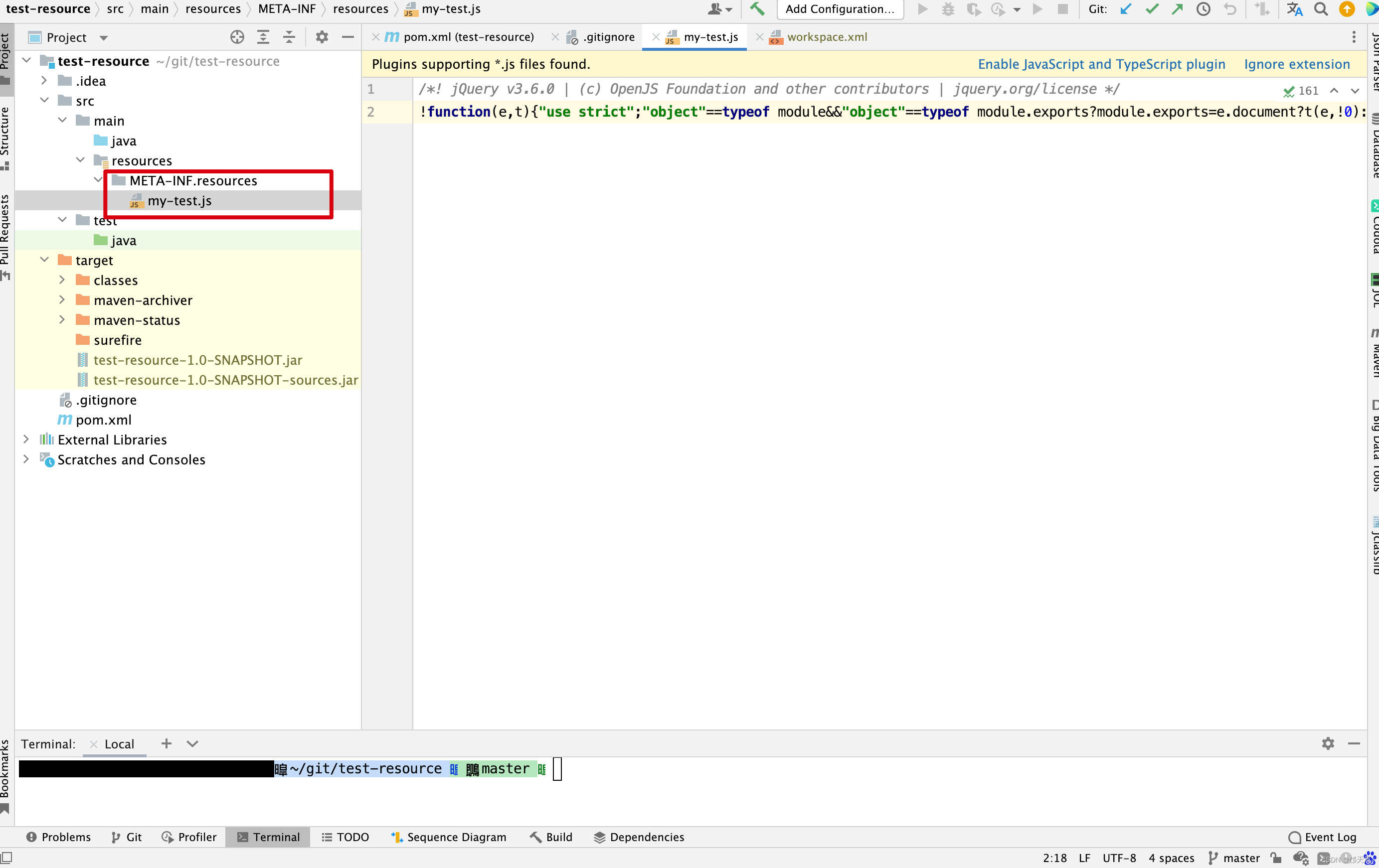
2. 引入servelet-test项目中,在这里注意,本文所有的例子中servlet-test就是servelet-test-1.0项目的。
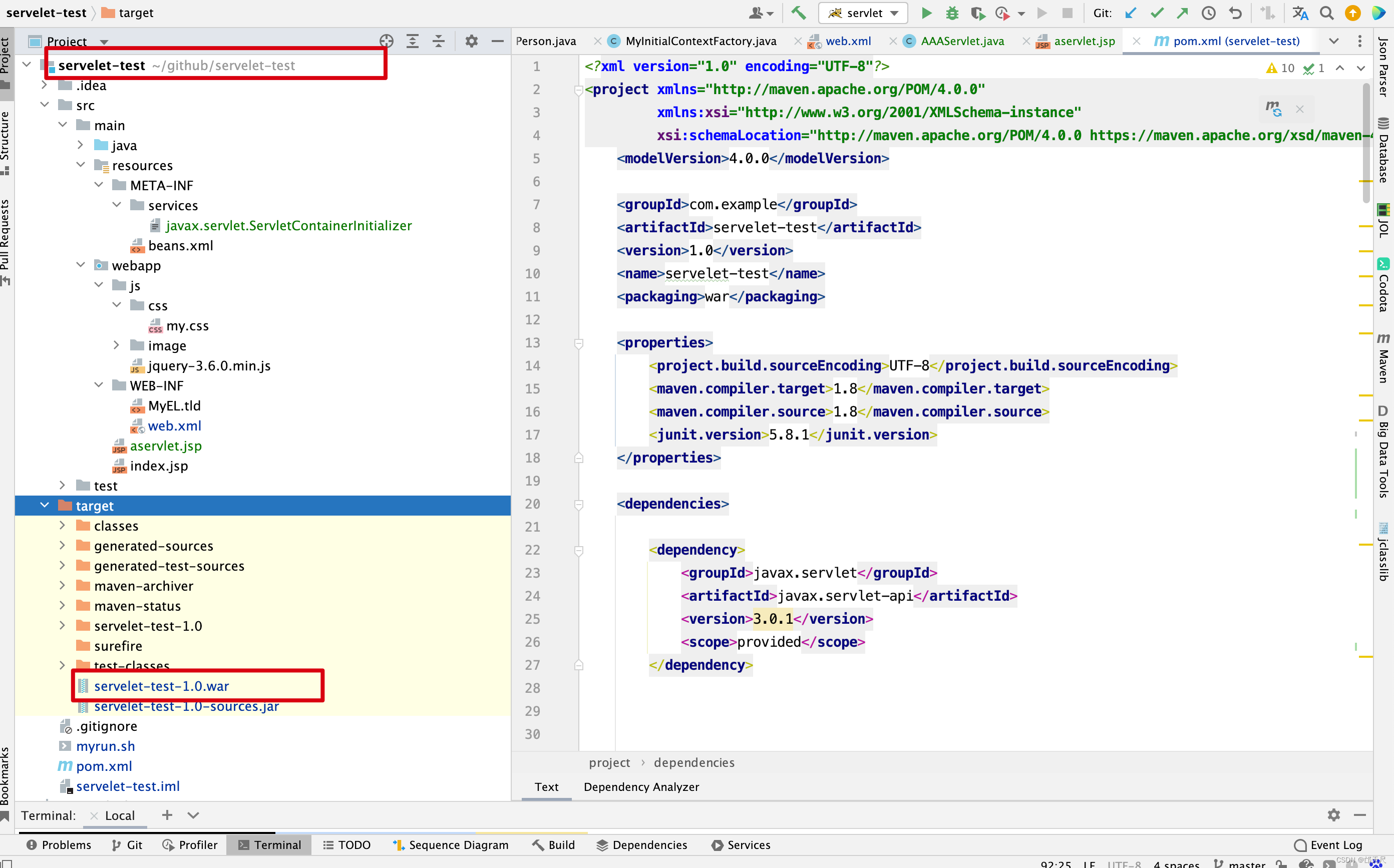
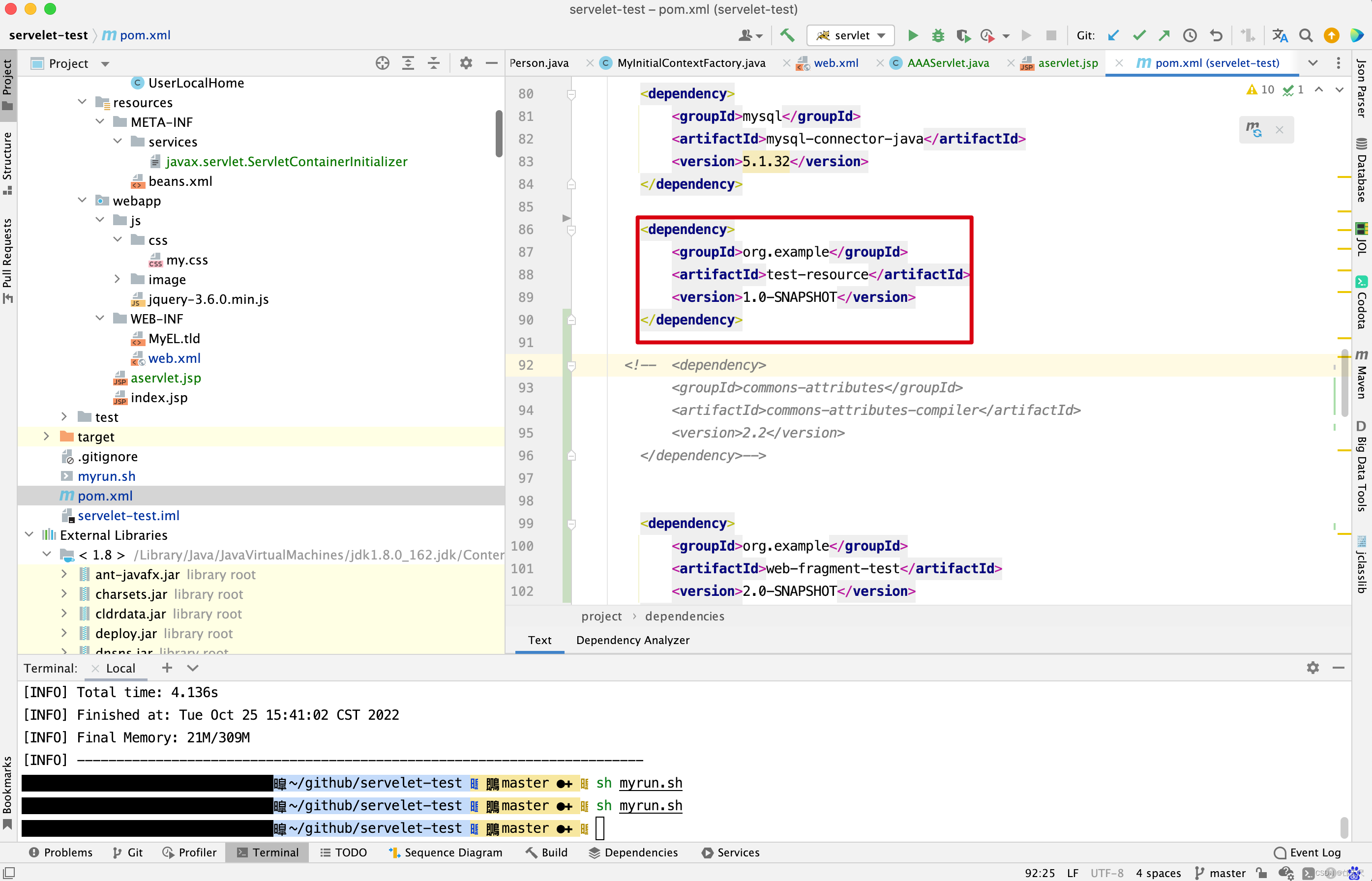
- 在processResourceJARs()方法中打断点
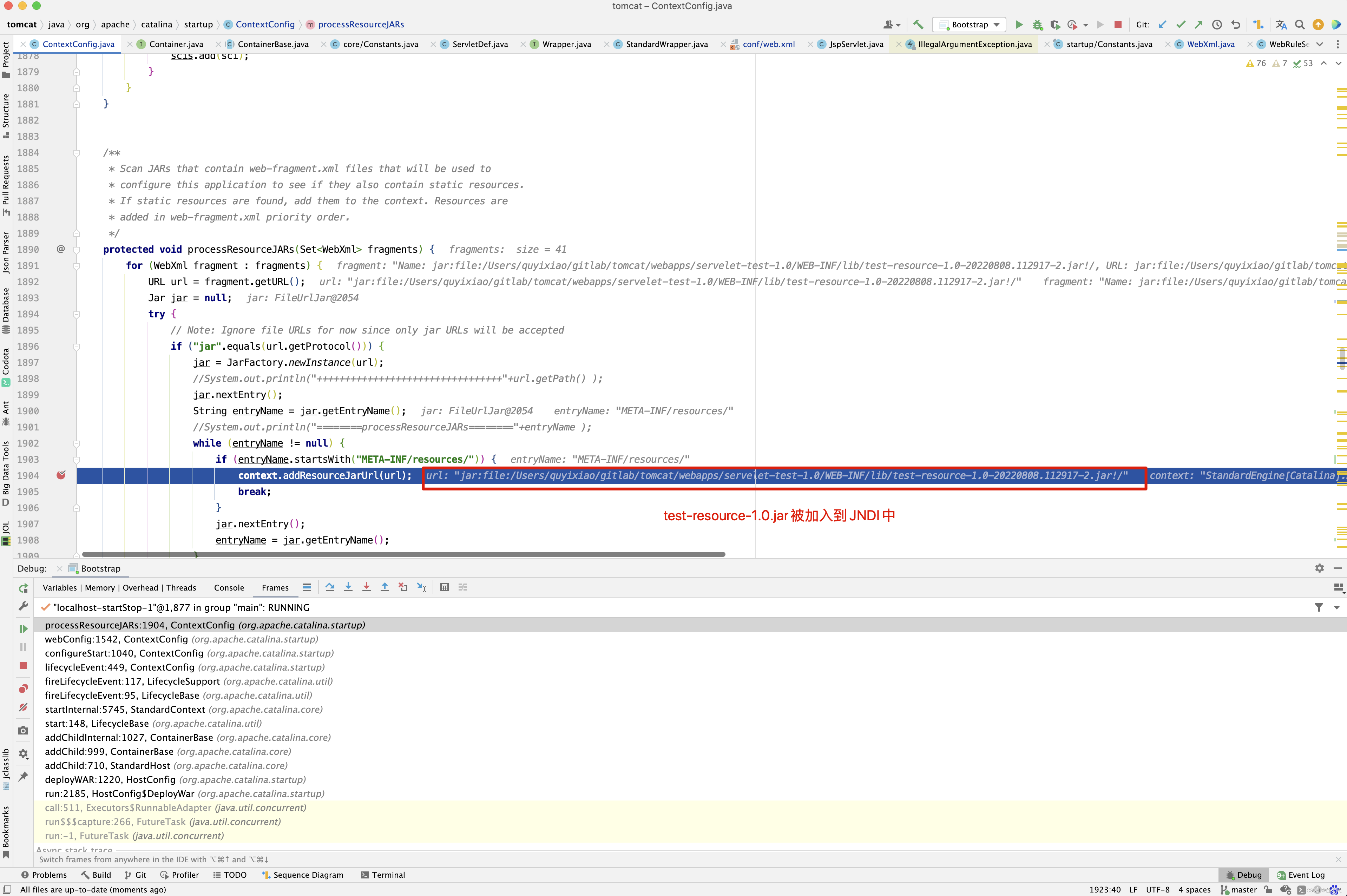
- 启动tomcat后,访问my-test.js资源
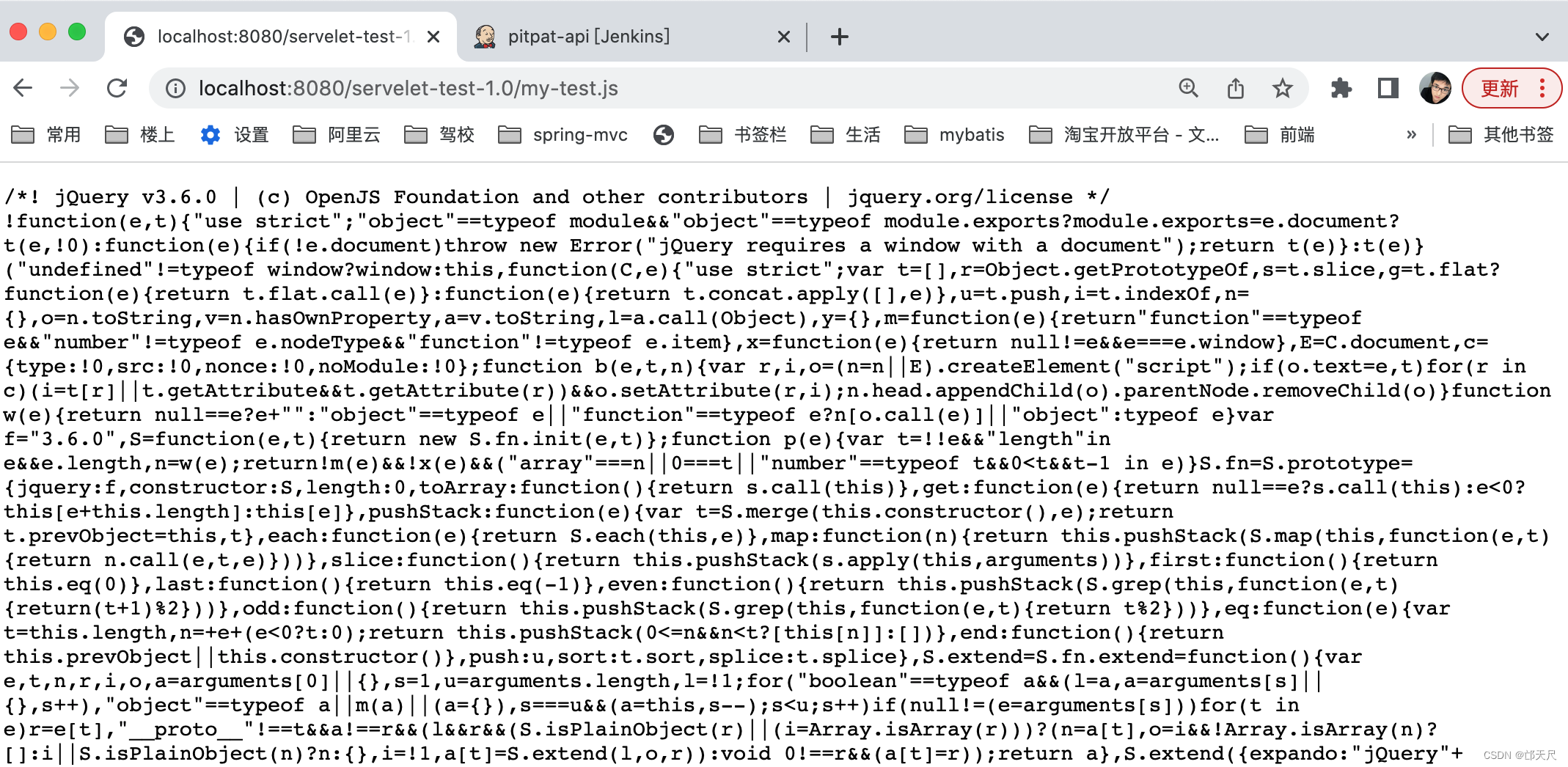
listener-listener-class
接下来分析configureStart()中的applicationAnnotationsConfig()方法。
protected void applicationAnnotationsConfig() { long t1=System.currentTimeMillis(); WebAnnotationSet.loadApplicationAnnotations(context); long t2=System.currentTimeMillis(); // 存储StandardContext的启动时间 if (context instanceof StandardContext) { ((StandardContext) context).setStartupTime(t2-t1+ ((StandardContext) context).getStartupTime()); } }
接着进入loadApplicationAnnotations()方法 。
public static void loadApplicationAnnotations(Context context) { loadApplicationListenerAnnotations(context); loadApplicationFilterAnnotations(context); loadApplicationServletAnnotations(context); }
因为loadApplicationListenerAnnotations(),loadApplicationFilterAnnotations() , loadApplicationServletAnnotations()三个方法的源码实现大同小异,因此只选 loadApplicationListenerAnnotations()方法进行分析 。
protected static void loadApplicationListenerAnnotations(Context context) { String[] applicationListeners = context.findApplicationListeners(); for (String className : applicationListeners) { Class<?> clazz = Introspection.loadClass(context, className); if (clazz == null) { continue; } loadClassAnnotation(context, clazz); loadFieldsAnnotation(context, clazz); loadMethodsAnnotation(context, clazz); } } public String[] findApplicationListeners() { ArrayList<String> list = new ArrayList<String>(applicationListeners.length); for (ApplicationListener applicationListener: applicationListeners) { list.add(applicationListener.getClassName()); } return list.toArray(new String[list.size()]); }
如果要分析loadClassAnnotation(),loadFieldsAnnotation(),loadMethodsAnnotation()三个方法之前,先要找到applicationListeners是从哪里赋值的。 当然又在代码中寻寻觅觅,最终找到了在addApplicationListener()方法中添加Listener。在addApplicationListener()方法中打断点 。
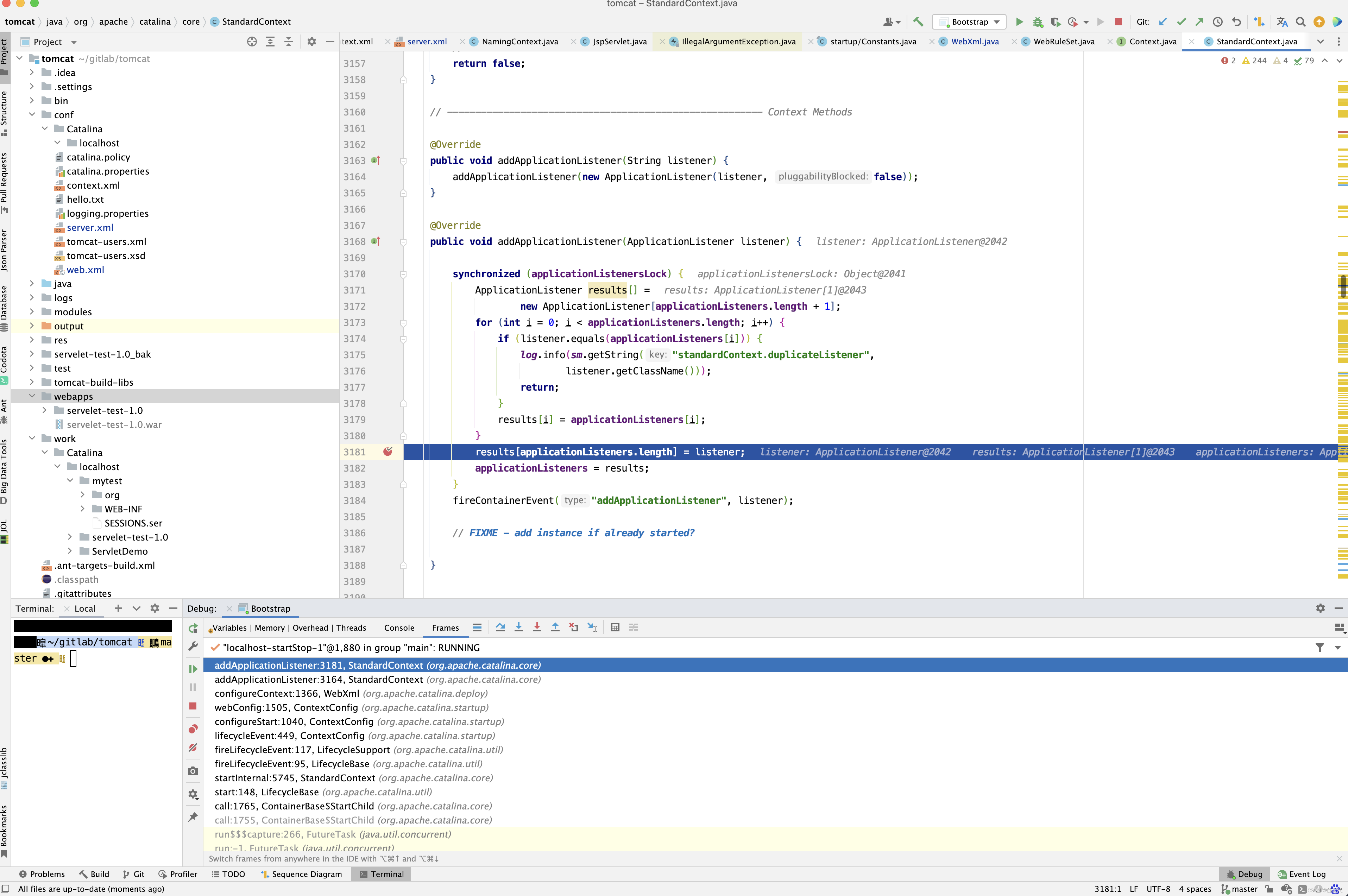
发现来源于WebXml的listeners的值,而WebXml又是从web.xml或web-fragment.xml中解析得到。
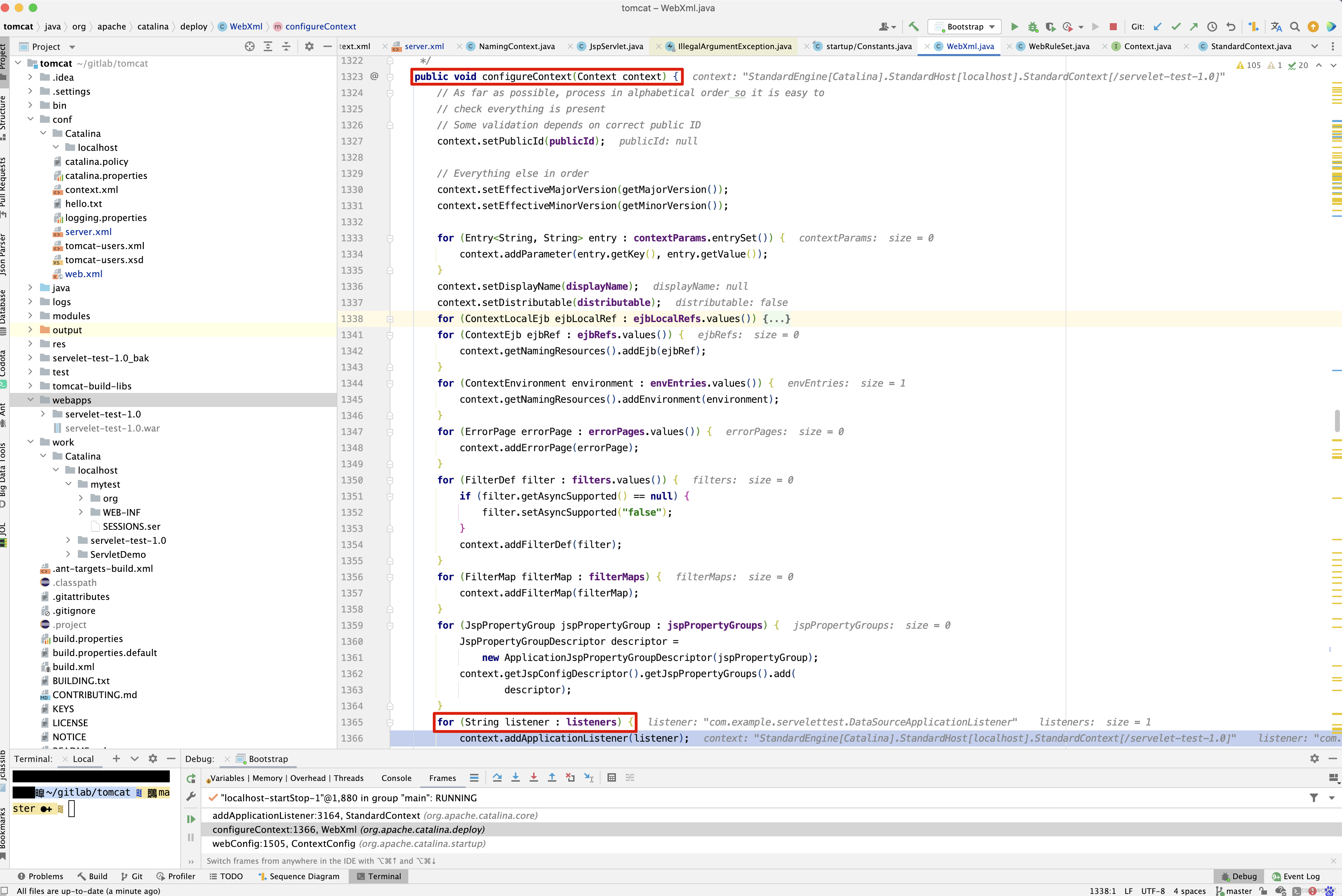
而listeners又是通过addListener()方法添加的。

全局搜索addListener"方法,最终从WebRuleSet中得知
listener/listener-class标签。
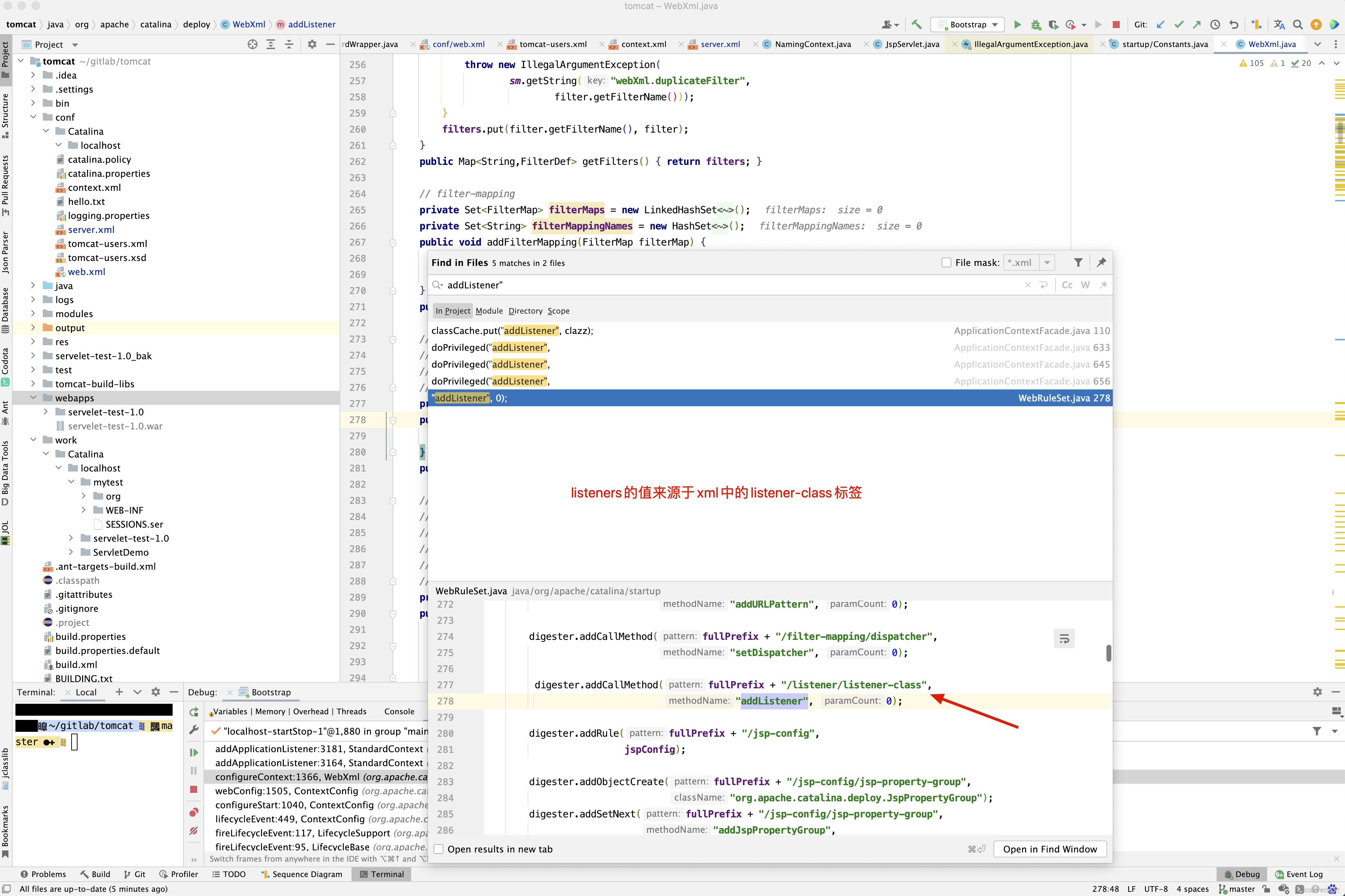
先来看loadClassAnnotation()方法。
protected static void loadClassAnnotation(Context context, Class<?> clazz) { /* Process Resource annotation. * Ref JSR 250 */ Resource resourceAnnotation = clazz.getAnnotation(Resource.class); if (resourceAnnotation != null) { addResource(context, resourceAnnotation); } /* Process Resources annotation. * Ref JSR 250 */ Resources resourcesAnnotation = clazz.getAnnotation(Resources.class); if (resourcesAnnotation != null && resourcesAnnotation.value() != null) { for (Resource resource : resourcesAnnotation.value()) { addResource(context, resource); } } DeclareRoles declareRolesAnnotation = clazz.getAnnotation(DeclareRoles.class); if (declareRolesAnnotation != null && declareRolesAnnotation.value() != null) { for (String role : declareRolesAnnotation.value()) { context.addSecurityRole(role); } } } protected static void addResource(Context context, Resource annotation) { addResource(context, annotation, null, null); }
对于类上可以配置Resource和Resources注解。如果配置的是Resources注解,则取出其中的Resource注解调用addResource()方法添加到 context.getNamingResources()中。 接下来看loadFieldsAnnotation()和loadMethodsAnnotation()方法的实现。
protected static void loadFieldsAnnotation(Context context, Class<?> clazz) { // Initialize the annotations Field[] fields = Introspection.getDeclaredFields(clazz); if (fields != null && fields.length > 0) { for (Field field : fields) { Resource annotation = field.getAnnotation(Resource.class); if (annotation != null) { String defaultName = clazz.getName() + SEPARATOR + field.getName(); // type 取属性的类型 Class<?> defaultType = field.getType(); addResource(context, annotation, defaultName, defaultType); } } } } protected static void loadMethodsAnnotation(Context context, Class<?> clazz) { // Initialize the annotations Method[] methods = Introspection.getDeclaredMethods(clazz); if (methods != null && methods.length > 0) { for (Method method : methods) { Resource annotation = method.getAnnotation(Resource.class); if (annotation != null) { if (!Introspection.isValidSetter(method)) { throw new IllegalArgumentException(sm.getString( "webAnnotationSet.invalidInjection")); } String defaultName = clazz.getName() + SEPARATOR + Introspection.getPropertyName(method); // type 取方法的第0个参数的类型 Class<?> defaultType = (method.getParameterTypes()[0]); addResource(context, annotation, defaultName, defaultType); } } } }
无论是类,方法,还是属性都指向了addResource()方法,进入addResource()方法 。
protected static void addResource(Context context, Resource annotation, String defaultName,
Class<?> defaultType) {
String name = getName(annotation, defaultName);
String type = getType(annotation, defaultType);
if (type.equals("java.lang.String") ||
type.equals("java.lang.Character") ||
type.equals("java.lang.Integer") ||
type.equals("java.lang.Boolean") ||
type.equals("java.lang.Double") ||
type.equals("java.lang.Byte") ||
type.equals("java.lang.Short") ||
type.equals("java.lang.Long") ||
type.equals("java.lang.Float")) {
// env-entry element
ContextEnvironment resource = new ContextEnvironment();
resource.setName(name);
resource.setType(type);
resource.setDescription(annotation.description());
resource.setProperty(MAPPED_NAME_PROPERTY, annotation.mappedName());
if (JreCompat.getInstance().isCommonsAnnotations1_1Available()) {
resource.setLookupName(annotation.lookup());
}
context.getNamingResources().addEnvironment(resource);
} else if (type.equals("javax.xml.rpc.Service")) {
// service-ref element
ContextService service = new ContextService();
service.setName(name);
service.setWsdlfile(annotation.mappedName());
service.setType(type);
service.setDescription(annotation.description());
if (JreCompat.getInstance().isCommonsAnnotations1_1Available()) {
service.setLookupName(annotation.lookup());
}
context.getNamingResources().addService(service);
} else if (type.equals("javax.sql.DataSource") ||
type.equals("javax.jms.ConnectionFactory") ||
type.equals("javax.jms.QueueConnectionFactory") ||
type.equals("javax.jms.TopicConnectionFactory") ||
type.equals("javax.mail.Session") ||
type.equals("java.net.URL") ||
type.equals("javax.resource.cci.ConnectionFactory") ||
type.equals("org.omg.CORBA_2_3.ORB") ||
type.endsWith("ConnectionFactory")) {
// resource-ref element
ContextResource resource = new ContextResource();
resource.setName(name);
resource.setType(type);
if (annotation.authenticationType() == Resource.AuthenticationType.CONTAINER) {
resource.setAuth("Container");
} else if (annotation.authenticationType() == Resource.AuthenticationType.APPLICATION) {
resource.setAuth("Application");
}
resource.setScope(annotation.shareable() ? "Shareable" : "Unshareable");
resource.setProperty(MAPPED_NAME_PROPERTY, annotation.mappedName());
resource.setDescription(annotation.description());
if (JreCompat.getInstance().isCommonsAnnotations1_1Available()) {
resource.setLookupName(annotation.lookup());
}
context.getNamingResources().addResource(resource);
} else if (type.equals("javax.jms.Queue") ||
type.equals("javax.jms.Topic")) {
// message-destination-ref
MessageDestinationRef resource = new MessageDestinationRef();
resource.setName(name);
resource.setType(type);
resource.setUsage(annotation.mappedName());
resource.setDescription(annotation.description());
if (JreCompat.getInstance().isCommonsAnnotations1_1Available()) {
resource.setLookupName(annotation.lookup());
}
context.getNamingResources().addMessageDestinationRef(resource);
} else {
/*
* General case. Also used for:
* - javax.resource.cci.InteractionSpec
* - javax.transaction.UserTransaction
*/
// resource-env-ref
ContextResourceEnvRef resource = new ContextResourceEnvRef();
resource.setName(name);
resource.setType(type);
resource.setProperty(MAPPED_NAME_PROPERTY, annotation.mappedName());
resource.setDescription(annotation.description());
if (JreCompat.getInstance().isCommonsAnnotations1_1Available()) {
resource.setLookupName(annotation.lookup());
}
context.getNamingResources().addResourceEnvRef(resource);
}
}
大家看到这里,肯定弄晕了,不知道这个方法用来做什么?那来看两个例子吧。
- 在catalina.base/conf/server.xml 中添加如下加粗代码
<?xml version='1.0' encoding='utf-8'?>
<Server port="8005" shutdown="SHUTDOWN">
<Resource
name="jdbc/mysql"
auth="Container"
type="javax.sql.DataSource"
driverClassName="com.mysql.jdbc.Driver"
url="jdbc:mysql://172.16.157.238:3306/lz_test"
username="ldd_biz"
password="Hello1234"
maxActive="5"
maxIdle="2"
maxWait="10000"/>
</GlobalNamingResources>
<Service name="Catalina">
<Connector port="8009" protocol="AJP/1.3" redirectPort="8443" />
<Engine name="Catalina" defaultHost="localhost" >
<Host name="localhost" appBase="webapps"
unpackWARs="true" autoDeploy="true" copyXML="true" deployIgnore="[1][3-9][0-9]{9}">
<Context path="/servelet-test-1.0" docBase="servelet-test-1.0" >
<ResourceLink global="jdbc/mysql" name="jdbc/mysql" type="javax.sql.DataSource" />
</Context>
<Valve className="org.apache.catalina.valves.ErrorReportValve" showServerInfo ="false" />
<Valve className="org.apache.catalina.valves.AccessLogValve" directory="logs"
prefix="localhost_access_log." suffix=".txt"
pattern="%h %l %u %t "%r" %s %b" />
</Host>
</Engine>
</Service>
</Server>
- 在servlet-test项目目录下web.xml中添加listener-class
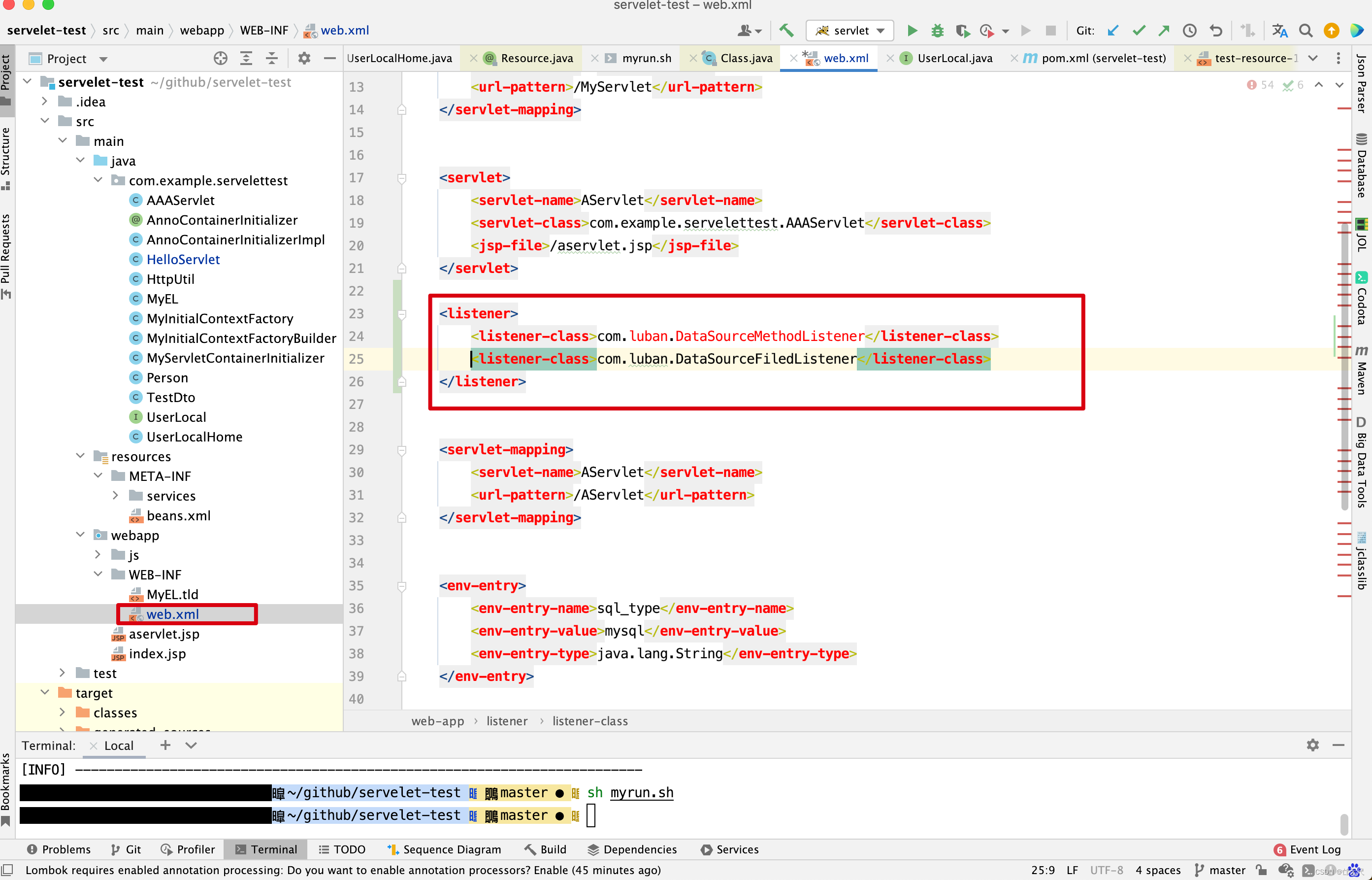
<?xml version="1.0" encoding="UTF-8"?>
<web-app xmlns:xsi="http://www.w3.org/2001/XMLSchema-instance"
xsi:schemaLocation="http://xmlns.jcp.org/xml/ns/javaee"
version="3.1" xmlns="http://xmlns.jcp.org/xml/ns/javaee">
<servlet>
<servlet-name>my</servlet-name>
<servlet-class>com.example.servelettest.HelloServlet</servlet-class>
</servlet>
<servlet-mapping>
<servlet-name>my</servlet-name>
<url-pattern>/MyServlet</url-pattern>
</servlet-mapping>
<servlet>
<servlet-name>AServlet</servlet-name>
<servlet-class>com.example.servelettest.AAAServlet</servlet-class>
<jsp-file>/aservlet.jsp</jsp-file>
</servlet>
<listener>
<listener-class>com.luban.DataSourceMethodListener</listener-class>
<listener-class>com.luban.DataSourceFiledListener</listener-class>
</listener>
<servlet-mapping>
<servlet-name>AServlet</servlet-name>
<url-pattern>/AServlet</url-pattern>
</servlet-mapping>
<env-entry>
<env-entry-name>sql_type</env-entry-name>
<env-entry-value>mysql</env-entry-value>
<env-entry-type>java.lang.String</env-entry-type>
</env-entry>
<ejb-local-ref>
<ejb-ref-name>LocalUserBean</ejb-ref-name>
<ejb-ref-type>Session</ejb-ref-type>
<local-home>com.example.servelettest.UserLocalHome</local-home>
<local>com.example.servelettest.UserLocal</local>
</ejb-local-ref>
</web-app>
- 创建DataSourceFiledListener和DataSourceMethodListener类,值得注意,将DataSourceFiledListener和DataSourceMethodListener两个类放到tomcat的代码中,而不放在项目servelet-test下,主要是方便打断点调试。而这两个类的目的就是从NamingContext中取出java:comp/env/jdbc/mysql,将值注入到dataSource属性中,有了dataSource,当然可以查询数据库了。
public class DataSourceFiledListener implements ServletContextListener {
@Resource(lookup = "java:comp/env/jdbc/mysql")
private DataSource dataSource;
@Override
public void contextInitialized(ServletContextEvent sce) {
System.out.println("……监听开始111……");
Context ctx = null;
Connection con = null;
Statement stmt = null;
ResultSet rs = null;
try {
System.out.println(dataSource);
System.out.println("bbb============================" + dataSource);
con = dataSource.getConnection();
System.out.println("==con=====" + con);
stmt = con.createStatement();
System.out.println("==stmt=====" + stmt);
rs = stmt.executeQuery("select * from lt_company ");
while(rs.next()) {
System.out.println( rs.getInt("id") + " " + rs.getInt("is_delete") + " " + rs.getString("company_name") + " ");
}
} catch (SQLException e) {
e.printStackTrace();
}
}
@Override
public void contextDestroyed(ServletContextEvent sce) {
}
}
public class DataSourceMethodListener implements ServletContextListener {
private DataSource dataSource;
@Resource(lookup = "java:comp/env/jdbc/mysql")
public void setDataSource( DataSource dataSource){
this.dataSource = dataSource;
}
@Override
public void contextInitialized(ServletContextEvent sce) {
System.out.println("……监听开始222222……");
Context ctx = null;
Connection con = null;
Statement stmt = null;
ResultSet rs = null;
try {
System.out.println(dataSource);
System.out.println("bbb============================" + dataSource);
con = dataSource.getConnection();
System.out.println("==con=====" + con);
stmt = con.createStatement();
System.out.println("==stmt=====" + stmt);
rs = stmt.executeQuery("select * from lt_company ");
while(rs.next()) {
System.out.println( rs.getInt("id") + " " + rs.getInt("is_delete") + " " + rs.getString("company_name") + " ");
}
} catch (SQLException e) {
e.printStackTrace();
}
}
@Override
public void contextDestroyed(ServletContextEvent sce) {
}
}
- 结果输出
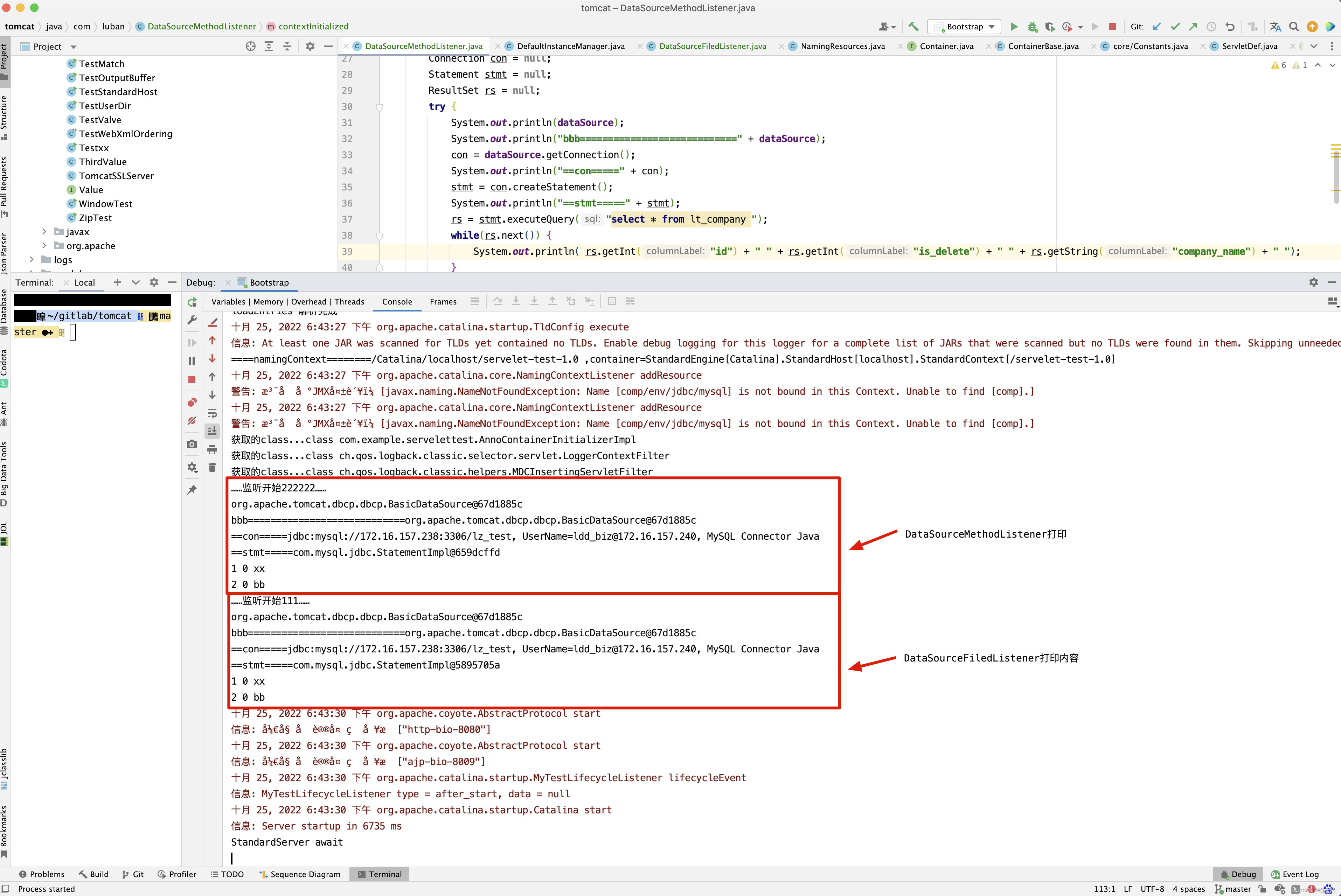
关于ServletContextListener的实现原理,在分析listenerStart()方法时再来分析了。 当然关于@Resource注解配置在类上的作用,目前我也还没有想明白,如果有知道的小伙伴给我留言哈。
关于configureStart()用户授权,验证这一块不做分析,如果以后有时间再来分析了吧。到这里configureStart()方法的分析也告一段落。
因为篇幅问题,请接着看 Tomcat 源码解析一容器加载-大寂灭指(下)





















 5092
5092











 被折叠的 条评论
为什么被折叠?
被折叠的 条评论
为什么被折叠?








